- Privacy-Policy

Race Mark Buoys for Triathlons, Sailing and other Competitive Water Races
- Custom Race Marks
- Tetrahedron & Tear Drop Race Marks
- Tomato and Cylinder Race Marks
- Triathlon Marks
- Accessories
- Inflation/Anchoring
- Maintenance
- Boat Race Committee Supplies
- Nautical Flags
- Race Committee Flags
- Alphabet Signal Flags
- International Signal Flags, Numerical Flags & Pennants
- Nautical Race Officer Flags
- Starter Flags

8 Foot Tetra Race Mark Buoy

Yachts going by a Race Mark Buoy

Swim Across America

Nautical Flags And Race Committee Supplies

Race Marks Buoys, Signal Flags, Racing Supplies
Race supplies to the long distance swim & boats race communities..
ETP Race Mark buoys have been used in races both domestically and internationally for over 40 years. The inflatable race mark buoys are used for nautical events, yachts, stand up paddle board, dragon boat races, triathlons, swimming competitions, and more. ETP Race Marks is a custom fabricator and offers an array of shapes, sizes, colors, and even custom printing.
All ETP Race Mark’s inflatable buoys are constructed using a heavy duty 18 oz coated polyester fabric. These are marks are easy to inflate (see video ), use, deflate, and store. Each inflatable buoy must pass our 24-hour inflation test before shipment. The inflatable race mark buoys carry a one-year warranty. ETP Race Mark’s larger marks are equipped with a pressure relief valve to prevent over inflation. A dump valve addition is available to any buoy (3 feet or larger) to create a quicker deflation.
Our standard marks, include Tetrahedron, Tear Drop , Cylinder and Tomato shapes. Custom shapes and sizes are also available.
Most of the ETP Race Mark’s inflatable race mark buoys are anchored with stainless steel 3-5 D-ring system on the bottom of the buoy. ETP Race Mark’s does not provide anchor lines or weights but generally suggests using a mushroom anchor in lakes and Danforth anchors in larger bodies of water. Weight depends on the size of the buoy, but ETP Race Mark’s suggests 5 – 25 lbs. depending on the body of water was well as the size of the buoys. Always make sure there is plenty of slack in the anchor line.
A storage bag is provided for all buoys 3 feet or larger. ETP Race Marks does not provide bags for smaller marks. Standard colors are orange and yellow, however, other colors are available through special order. Custom sizes, logos, names, clear pockets, or sponsors’ advertisements are all possible options.
ETP also carries Race Committee supplies, International Signal flags, Pennants, Race Committee member flags & more.

- YRA Description of Marks
Below are the descriptions of marks used in YRA races. Also included are the APPROXIMATE GPS coordinates for the permanent marks. These GPS coordinates are provided as a reference; the YRA makes no guarantee as to the accuracy of these GPS coordinates. We encourage you to sail by each mark and enter in your GPS to ensure accuracy.

Click here for ocean chartlet with marks.
Central & North Bay
Click here for Central Bay chartlet with marks, click here for North Bay chartlet with marks.
Click here for South Bay chartlet with marks.
- Become a YRA Member
- YRA Member Clubs
- Latest News
- The Great Vallejo Race
- Half Moon Bay Regatta
- Westpoint Regatta
- Encinal Regatta
- Shorthanded Sunday Series
- Doublehanded Midwinter Series
- Offshore Series
- The Bluewater Bash
- In The Bay Series
- YRA Master Calendar
- NCPHRF Rules & Guidelines
- Obtain an NCPHRF Certificate
- NCPHRF Ratings
- Certified NCPHRF Certificates
- PHRF Meetings
- YRA Buoy Status
- In The Bay Equipment Requirements
- Offshore Equipment Requirements
- US Sailing Protest Form
- Appeal’s Decisions
- Race Officers and Judges
- Race Committee Development
- USCG Permitting Process
- YRA MERCHANDISE

Dave Dellenbaugh Sailing
David Dellenbaugh is a champion helmsman, tactician, author, coach, rules expert and seminar leader who has spent his career helping sailors sail faster and smarter.Here are the learning resources that he has created to help you improve your racing skills.
- The SMART Course
Mark Roundings
Racing marks are turning points where all the boats in your fleet try to squeeze into one small spot. For this reason, mark roundings often produce large traffic jams, and the potential for gain or loss is great. With a bit of tactical knowledge, you can sail smarter than the others and, hopefully, turn most potential losses into gains.
Definition -- The rulebook defines a mark as any object that the sailing instructions say you must pass or round on a required side. This includes the ends of the starting and finishing lines, all the turning marks, government buoys that must be regarded, and so on. Whenever you are approaching a "mark," all the mark-rounding rules come into play, and these will have a large influence on your tactics.
When You're Ahead
At the weather mark, the biggest gains and losses are usually made just before you get there. So it pays to be very "smart" in your approach. A bit of tactical expertise will often improve your position relative to the competition and set yourself up well for the next leg
Unless you are converging with a boat on the opposite tack, the regular mark-room rules apply. This means that when two boats are approaching on the starboard layline, the leeward boat can get mark-room. The windward boat may be able to prevent this by reaching down and clamping on a tight cover. The idea is to give the leeward boat enough bad air so she falls astern before you get to the mark.
Frequently, a boat that's on the starboard layline (S) will converge with a port tacker (P) near the mark. P would usually like to tack on S's lee bow and beat her around the mark. To prevent this, S can often bear off a few degrees before she gets within two boatlengths of P. This effectively "closes the door" and forces P to take S's stern.
Starboard roundings -- A starboard rounding at the windward mark can get pretty messy, and that's why most race committees avoid this kind of course. If you find yourself on a starboard course, try to approach the windward mark on starboard tack. A port-tack boat is at a big disadvantage here, not only because starboard boats have the right of way, but because they can alter course as they round the mark.
To jibe or not to jibe -- When you come around the windward mark onto a run, the big question is whether you should do a bearaway set or a jibe set. This choice should be based on a combination of strategic and tactical factors. If port tack is favored on the run, or if you are in a right-hand shift as you come around the mark, a jibe set may be your best bet. This will also get you to the inside and is the best way to maintain clear air if there is a big group of boats behind.
A bearaway set, on the other hand, is the more conservative choice. It's much easier to maintain boatspeed during this set because you don't have to turn as sharply and the spinnaker set is not so complicated. You also stay on starboard tack, which gives you rights over half the boats still beating to windward. So unless you are sure that a jibe set is the right move, go with the tried-and-true bearaway.
Other considerations:
1) If possible, give yourself at least a few boatlengths on starboard tack before the mark so you will have time to get your spinnaker ready for the next leg.
2) Use your sails and crew weight to help the boat turn and bear off around the mark.
3) Remember that you have the right to turn onto a proper course to the next mark, even if this suddenly puts you on a collision course with non-right-of-way boats still on the beat.
The Jibe Mark
Rounding a jibe mark is usually a bit more straightforward than either a windward or leeward mark. However, there are a few tactical moves worth considering:
Getting or breaking an overlap -- When approaching a jibe mark, the leeward boat has an advantage because she will be inside at the mark. The key is maintaining that overlap until the two-boatlength circle. The windward boat can often break a small overlap by heading up just before the circle.
Jibe before the mark -- Like other roundings, the ideal course around a jibe mark is to swing wide and then cut close. The best way to do this is to complete your jibe (get the pole on the mast) before your bow gets to the mark. That way you can head up higher as soon as you get around. This will often let you sail over the top of other boats that have slipped low because of trouble with their spinnakers.
The "S" turn -- In heavy air, you have to modify your jibe slightly so that you steer a shallow "S" course. This keeps the boat from heeling too far to leeward just after the boom comes across.
The Leeward Mark
The primary goal for leeward mark roundings is to put yourself in a good position for starting the next beat. Obviously, your first choice is to round ahead of all the nearby boats, so you will have clear air. That's why it's worth fighting for an inside position as you approach the mark.
The ideal rounding -- Whenever possible, make a classic rounding where you swing wide on the near side and cut close on the far side. The object is to be on a closehauled course before your bow gets to the mark. This way you will not lose any distance to leeward as you start the beat.
If there is a boat close behind as you go around the mark, you may want to "stuff" slightly as you round. Pinch up above closehauled for about a boatlength to make sure your competitor cannot get clear air behind you. This will also keep open your option to tack. Be careful, however, of slowing too much and letting the other boat punch through to leeward.
If you are on the outside as you approach the leeward mark, swing wide to make an ideal (tactical) rounding. The object is to be slightly to windward of the other boat's transom as you go around the mark. One advantage you have is that the inside boat cannot make a tactical rounding -- she must take no more room than is required for a "seamanlike" rounding.
Planning Ahead -- One of the toughest situations in any race is when you come around the leeward mark right behind another boat. Your crew is usually scrambling around the boat, your boatspeed is minimal and you're in bad air. Now what should you do?
A good leeward mark rounding begins when you start thinking about your strategic plan for the upcoming beat. Has the wind been shifting? Where is the most velocity? Which side was favored on the first beat? You shuld answer all these questions and settle on a strategy well before you get to the leeward mark.
Once you have a strategy, you must execute your mark-rounding tactics in order to implement that strategy. You basically have three choices when there is a boat right ahead of you:
OPTION 1 -- Tack right around the mark: This is obviously a good tactic when you think the left side is favored. It's also a good way to get clear air quickly. However, there are two disadvantages. First, you must tack when you are going slowly and still recovering from the rounding. Second, you are tacking right into the bad air and/or water of the fleet behind. If possible, hold on for a few boatlengths before tacking to minimize interference from other boats.
OPTION 2 -- Continue on the hip of the boat ahead: If the boat ahead goes a little wide and you have a good rounding, you may be able to hold on in clear air. This is a good option because you don't give up any distance and you can continue right while maintaining the option to go left.
OPTION 3 -- Reach off for clear air to leeward: When the right side is heavily favored, the best way to get clear air may be to reach off below the boat ahead. This is much better than trying to pinch above his bad air. One of the times when this tactic works best is in light air when you are on the outside of a pack. Hold your spinnaker until the last moment and reach around with your air clear in front of the other boats. Of course, this tactic means you must sacrifice a good bit of distance to windward, so don't use it unless the strategic benefits will make up for this loss.
The Finish
As a famous old salt once said, "The race isn't over until it's over." One of the most demoralizing ways to end a race is to lose a close battle right at the finish line. When you work hard the whole race, you have to keep sailing smart all the way to the finish in order to assure your position. Here are some suggestions:
Upwind -- At an upwind finish, the favored end of the finish line is the end that's farther to leeward -- on the lower ladder rung. This is the opposite end that would be favored if this line were being used for starting. Note in this diagram that the white boat crosses ahead of the black boat, but the black boat gets to the finish line first because he goes for the favored pin end.
At almost every finish line, one end or the other is favored. Just as with the starting line, it's almost impossible to have a perfectly square line. That's why you should almost always finish right at one end. The farther you are from the favored end, the more distance and time you are giving up.
If you're not sure which end is favored, there are several things you can do:
1) Try to look at the finish line (if it is set) when you sail by it on other legs of the course.
2) Watch the boats ahead and see where they finish. Especially when two boats are close together, the chances are good that they will finish near the favored end.
3) Finish on the tack most nearly perpendicular to the finish line. If boats are finishing on port, the starboard end is favored, and vice versa.
4) Postpone your decision by staying inside the triangle that's between the laylines to each end. This way you will be able to get as close as possible to the line without overstanding either end. When you get to the intersection of the two laylines, simply head for the end that is closer.
Once you know which end is favored, think of that end as a weather mark with its two laylines. Ignore the other end of the line and its laylines to simplify matters. Of course, it's best to make your final approach on starboard tack, as that will give you right-of-way over nearby boats.
"Shooting" the line -- If you have a close finish with another boat(s), you should always shoot the line so you cross it perpendicularly. Begin shooting when you are one or two boatlengths to leeward of the line; this distance will vary depending on the ability of your particular boat to maintain its momentum in the existing wind and sea conditions.
Since you usually want to finish at one end of the line, you should shoot the line as close to this end as possible for close finishes. To do this, approach the line on a course that's one or two boatlengths to leeward of the layline to the favored end. This will allow you room to shoot the line and finish right at that end.
Downwind -- When you are finishing on a run, you follow most of the same principles for finishing on a beat. The favored end is now the one that's farther upwind -- on the higher ladder rung. Finish right at this end, and remember to "shoot," by bearing off perpendicular to the line, just before you get there.
- The Newsletter
- Current Issue
- See a Sample Issue
- Get a FREE Sample Issue
- Newsletter Index
- Renew Subscription
- Gift Subscriptions
- Order Back Issues
- Testimonials
- Contributors
- Get Promotional Issues
- Reprint Permission
- Free back Issues
- Speed & Smarts Gift Card
- Learn the Racing Rules
- Buy Racing Rules Course
- Contents List
- 8 Reasons to get ‘LTRR 2024’
- Sample Video
- Rule Quizzes
- Log in to your LTRR 2024
- Webinar Schedule
- Webinar Replays
- Webinar Description
- Instructors
- Seminar Testimonials
- Order Workbooks
- Host a Webinar
- Pay for Webinar
- Services Offered
- Coaching Resume
- Winning Tips
- Around the Buoys
- Smallboat Sailing
- The FAST Course
- Miscellaneous

Rule 18.2 – Giving Mark-Room: Racing Rules of Sailing 2021-2024
Our second installment on mark-room is Rule 18.2 – Giving Mark-Room. We covered Rule 18.1 separately and we’ll update Rules 18.3 and 18.4 in a future post.
In 2018, the Inland Lake Yachting Association (ILYA) and SailZing, LLC partnered on a Fair Sailing initiative. As part of this initiative, SailZing worked with the ILYA and UK Sailmakers to develop a series of articles on the rules. With the rules changes in 2021, SailZing is updating these articles and adding video summaries.
Our thanks to UK Sailmakers for generating the animated scenarios.
Rule 18.2 Video
Rule 18.2 – Giving Mark Room
“(a) When boats are overlapped the outside boat shall give the inside boat mark-room , unless rule 18.2(b) applies.
(b) If boats are overlapped when the first of them reaches the zone , the outside boat at that moment shall thereafter give the inside boat mark-room . If a boat is clear ahead when she reaches the zone , the boat clear astern at that moment shall thereafter give her mark-room .
(c) When a boat is required to give mark-room by rule 18.2(b),
(1) she shall continue to do so even if later an overlap is broken or a new overlap begins;
(2) if she becomes overlapped inside the boat entitled to mark-room , she shall also give that boat room to sail her proper course while they remain overlapped .
(d) Rules 18.2(b) and (c) cease to apply if the boat entitled to mark-room passes head to wind or leaves the zone .”
(e) If there is reasonable doubt that a boat obtained or broke an overlap in time, it shall be presumed that she did not.
(f) If a boat obtained an inside overlap from clear astern or by tacking to windward of the other boat and, from the time the overlap began, the outside boat has been unable to give mark-room , she is not required to give it.”
Definitions
Room for a boat to leave the mark on the required side. Also,
(a) room to sail to the mark when her proper course is to sail close to it, and
(b) room to round or pass the mark as necessary to sail the course without touching the mark .
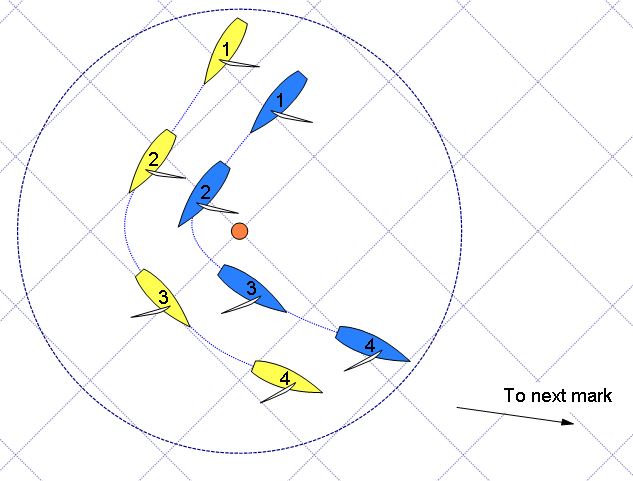
However, mark-room for a boat does not include room to tack unless she is overlapped inside and to windward of the boat required to give mark-room and she would be fetching the mark after her tack. (Example of a situation that requires giving room to tack is shown at right.)
Previously-defined terms (click to refresh your memory): overlap, clear ahead, clear astern , zone , room , proper course
Rule 18.2 Key Points
- This rule applies at both the windward and leeward marks. We’ll cover windward mark situations when we cover Rule 18.3.
- If Rule 18 applies, then either Rule 18.2(a) or Rule 18.2(b) will apply. The most common situations involve Rule 18.2(b).
- The key to understanding Rule 18.2(b) is to think of a “snapshot” when the first boat enters the zone. If the first boat enters the zone clear ahead, she need not give mark room to boats that are clear astern.
- When a boat claims she obtained or broke an overlap in time, the claim must be well-supported. If there is reasonable doubt, the claim will not be accepted.
- Rule 18 “turns off” when mark-room has been given. This means satisfying all the required portions of the mark-room definition.
Rule 18.2 Change
The 2021 changes modified Rules 18.1 and 18.2 slightly. Rule 18.1 now states that Rule 18 turns off when mark-room has been given. This applies to the entire rule. The corresponding statement in Rule 18.2 was removed. See the markup for Rule 18.2 to the right.
#1 – “Common Leeward Mark, Example 1”
Description: Yellow and Blue are sailing downwind on the same tack.
Should Yellow give mark-room to Blue? Answer
#2 – “Common Leeward Mark, Example 2”
Description: Yellow and Blue are sailing downwind on opposite tacks. When Blue enters the zone, she is clear ahead of Yellow. After entering the zone, Yellow becomes overlapped with Blue.
Should Blue give mark-room to Yellow? Answer
#3 – “Common Leeward Mark, Example 3”
Description: Yellow and Blue are sailing downwind on opposite tacks with spinnakers. Yellow reaches the mark first and does not give Blue mark-room. Blue heads up to avoid Yellow. There was no contact.
Should Yellow give mark-room to Blue? Answer
#4 – “Common Leeward Mark, Example 4”
Description: Yellow and Blue are sailing downwind on opposite tacks. Shortly after Yellow reaches the zone, Blue hails for room. Yellow does not respond verbally until reaching the mark, and then hails “no room.” Yellow does not give Blue mark room. Blue protests Yellow. Yellow alleges that she broke the overlap before she entered the zone. There was no contact.
Would a protest committee be likely to accept Yellow’s claim that she broke the overlap just before reaching the zone? Answer
#5 – “Common Leeward Mark, Example 5”
Description: Yellow and Blue are sailing downwind to the leeward gate on the same tack. After entering the zone, Blue turns up, sails faster, and breaks the overlap.
Should Blue give mark-room to Yellow? Answer
#6 – “Common Leeward Mark, Example 6”
Description: Yellow and Blue are sailing to the leeward mark. Blue is clear ahead when reaching the zone. Blue sails wide of the mark due to trouble with the spinnaker takedown. Yellow sails inside of Blue around the mark.
Is Yellow within her rights to round the mark inside Blue? Answer
#7 – “Common Leeward Mark, Example 7”
Description: Yellow, Blue, and Green are approaching the leeward mark. After entering the zone, Green slows down, but Blue speeds up and rounds inside of Yellow. Assume that Blue did not touch the mark. Yellow heads up and contacts Blue. There was no damage.
Which boat should promptly take a penalty? Answer
#8 – “Complex Leeward Mark”
Description: Multiple boats are approaching the leeward mark. Watch the scenario several times.
Is Yellow entitled to mark-room from Light Blue? Answer
Is Magenta entitled to mark-room from Green? Answer
When does Rule 18.2(a) Apply?
We’ve covered the most common rule 18.2 scenarios, which are usually related to Rule 18.2(b) and the three boat length zone. So when does Rule 18.2a apply? Here are two examples.
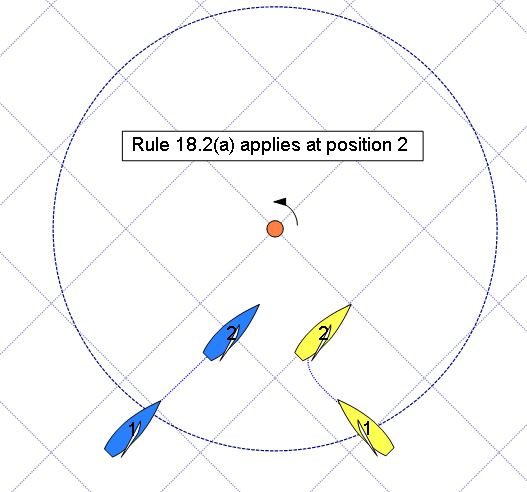
On a beat to windward, recall that, in accordance with Rule 18.1, Rule 18 does not apply between boats on opposite tacks. If two boats are already in the zone, on opposite tacks, and then one of them tacks, Rule 18 begins to apply, In this situation, Rule 18.2(a) kicks in. In the example shown, once Yellow tacks to port, Blue is the inside boat and is overlapped, so Blue is entitled to mark room from yellow.
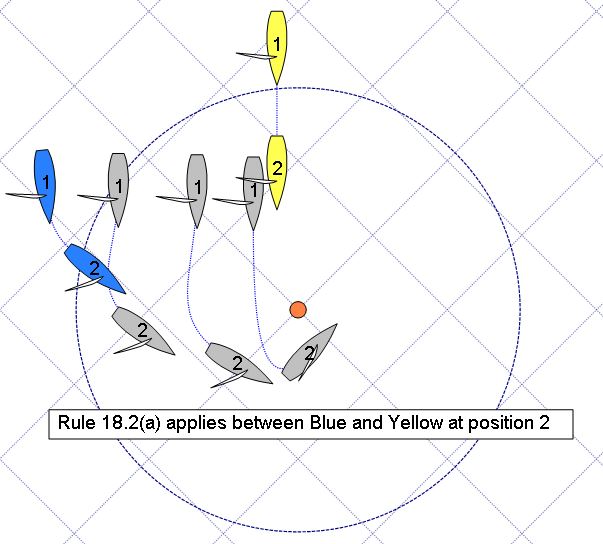
Here’s a leeward mark example, from Case 59 in the casebook. Blue is forced to sail outside the zone, due to the presence of the grey boats. Yellow is clear astern of Blue but enters the zone before Blue. Read Rule 18.2(b) carefully to see that it doesn’t apply here. Instead, Rule 18.2(a) begins to apply when Blue and Yellow are overlapped at position 2. Thus, Blue must give mark-room to Yellow.
World Sailing Cases of Interest
25 – When an inside overlapped windward boat that is entitled to mark-room takes more space than she is entitled to, she must keep clear of the outside leeward boat and the outside boat may luff provided she gives the inside boat room to keep clear.
59 – A boat abreast of a mark but outside the zone. Illustrates an application of Rule 18.2(a).
63 – At a mark, when space is available to a boat that is not entitled to it, she may, at her own risk, take advantage of the space.
70 – an inside overlapped windward boat that is entitled to mark-room from the outside boat must keep clear of thee outside boat and, if she is sailing outside of the mark-room to which she is entitled, she is not exonerated if she fails to keep clear.
75 – When an inside overlapped right-of-way boat must gybe at a mark, she is entitled to sail her proper course until she gybes.
Related Content:
SailZing – Racing Rules Category World Sailing Racing Rules of Sailing 2021-2024
Sailors Helping Sailors
Will you share your knowledge with your related Comments below?
Related Posts

ILYA #FairSailing – Rules Scenarios #1

ILYA #FairSailing – Rules Scenarios #2

ILYA #FairSailing – Rules Scenarios #3
Leave a comment cancel reply.
You must be logged in to post a comment.
This site uses Akismet to reduce spam. Learn how your comment data is processed .
Insert/edit link
Enter the destination URL
Or link to existing content
- AROUND THE SAILING WORLD
- BOAT OF THE YEAR
- Email Newsletters
- America’s Cup
- St. Petersburg
- Caribbean Championship
- Boating Safety

Sailboat Racing Tips: Rules at the Mark
- By Dave Reed
- April 26, 2022
Racing editor Mike Ingham delves into the intricacies of the Racing Rules of Sailing as they relate to rounding marks and how to get around clean.
- More: how to , rules , Sailboat Racing
- More How To

The Wisdom of Augie Diaz

Why S-Turns, Roll Jibes and Roll Tacks Are Fast

The Path to Consistent Boatspeed

Headsail Trim Tips For Floating Leads

Wanderers of the Wayfarer Dinghy

Alinghi Red Bull Racing First to Reveal Its AC75

On the Line With US SailGP

Terhune’s Take On A Winning Streak

- Digital Edition
- Customer Service
- Privacy Policy
- Cruising World
- Sailing World
- Salt Water Sportsman
- Sport Fishing
- Wakeboarding
The Ultimate Guide to Yacht Racing Rules and Regulations
- by yachtman
- September 6, 2023 August 26, 2023

Yacht racing is an exciting sport! It requires skill, accuracy, and knowledge of rules . These regulations guarantee fair play and safety. To really appreciate the activity, you must understand the regulations.
At first, navigating the rules may seem intimidating. But breaking them down into chunks makes it easier. One important point is the hierarchy between boats. It shows which boat should give way in different situations.
It’s also important to know the race signals. They communicate crucial info, such as race starts and course changes. Participants and spectators need to know these.
Stay updated on any rule changes or amendments issued by World Sailing . They refine existing regulations and add new ones to improve the sport. Knowing the latest rules will give you confidence.
Finally, read case studies of past incidents/disputes during yacht races. This way you can learn from mistakes and be ready for unexpected situations.
Understanding the Basic Rules of Yacht Racing
Understanding the Fundamental Regulations of Yacht Racing
Yacht racing involves a set of basic rules and regulations that govern the competition. These rules are essential for ensuring fair play and safety on the water. To help you understand the fundamental regulations of yacht racing, here is a concise 5-step guide:
- Start Line Procedure: Before the race begins, all yachts must line up at the designated starting line. This line is typically marked by buoys or flags, and competitors must position themselves according to the rules specified by the race committee.
- Right of Way: Yacht racing follows a set of right-of-way rules that determine which yacht has precedence in certain situations. For example, a yacht on a starboard tack (wind coming from the right side) usually has right of way over a yacht on a port tack (wind coming from the left side).
- Mark Roundings: Yacht courses often include marks, such as buoys or flags, that competitors must round during the race. The rules specify how yachts should approach and pass these marks to ensure fair competition and prevent collisions.
- Protests and Penalties: If a competitor believes that another yacht has violated the rules, they can file a protest with the race committee. The committee will then investigate the incident and may impose penalties on the offending yacht if the protest is upheld.
- Finishing Line: The race concludes at the finishing line, which is typically marked by buoys or flags. Yachts must pass this line in the correct direction and often have to radio or signal their finish time to the race committee.
These steps outline the key elements of understanding the fundamental regulations of yacht racing. It’s important to familiarize yourself with these rules to ensure a safe and fair competition.
Pro Tip: Before participating in a yacht race, take the time to thoroughly study and understand the specific rules and regulations for that event. This will help you navigate the race effectively and avoid unnecessary penalties.
Get ready to navigate through a sea of confusing jargon as we dive into the essential terminology of yacht racing – it’s like learning a new language, but with more wind in your sails.
Essential Terminology in Yacht Racing
Yacht racing requires a unique language to be mastered by all sailors. Knowing these terms is essential for successful communication and cooperation during races.
Check out some of the key vocab words used in yacht racing:
Plus, other crucial terms like “luffing” (sail fluttering due to lack of wind), “tiller” (lever for steering boat) and “hull speed” (maximum speed a boat can reach in water).
Pro Tip: Get to know these essential yacht racing terms to up your enjoyment of this exciting sport!
Key Rules and Regulations for Yacht Racing
Yacht Racing: A Comprehensive Guide to Rules and Regulations
The rules and regulations governing yacht racing are crucial for ensuring fair and competitive events. Understanding these guidelines is essential for both participants and organizers to guarantee a level playing field and maintain the integrity of the sport. Below, we have compiled a table highlighting key rules and regulations for yacht racing in an easily accessible format.
Key Rules and Regulations for Yacht Racing:
These rules and regulations provide a framework that allows for fair competition and keeps participants safe. However, it is important to note that each race may have additional guidelines specific to the event or location, and participants should familiarize themselves with these unique details.
One such incident in the world of yacht racing involved a team that, due to a technical malfunction, found themselves adrift just moments after the race had begun. With quick thinking and teamwork, they managed to rectify the issue, rejoin the race, and ultimately finished in an impressive third place. This story illustrates the resilience and determination required in yacht racing, where unforeseen challenges can arise at any moment.
Yacht racing rules and regulations are comprehensive and necessary for maintaining fairness and safety. By adhering to these guidelines and being prepared for unexpected circumstances, participants can fully engage in the thrilling and competitive world of yacht racing.
Navigating through the racing course is like playing chess, except the pieces are yachts and the stakes are higher – imagine the drama when someone accidentally knocks over the queen!
Racing Course and Markings
Ahoy, mateys! Hop on board for a wild race on the high seas! It’s time to learn about the racing course : a carefully crafted area for a thrilling competition . Keep your eyes peeled for the start line – it marks the beginning of the race. Then, look out for the turn marks ; these designated points show where sailors must change direction. Finally, the finish line indicates the end of the race.
If ye want to be the best sailor, ye must understand these course and marking details. It’s essential for a successful yacht racing experience, so don’t miss out! Time to set sail and make your mark in the world of yacht racing.
Right of Way and Collision Avoidance
In yacht racing, we must pay close attention to the right of way and collision avoidance. Following specific rules and regulations is key to ensuring a fair race and preventing accidents.
Let’s look at the key rules related to right of way and collision avoidance in yacht racing:
These rules are just the beginning of the comprehensive regulations. Now, let’s look at a unique detail. In some cases, when two yachts on different tacks approach a mark, they may have equal rights. It’s important for skippers to communicate and coordinate to avoid possible collisions.
To show the importance of following these rules, here’s a story. During a competitive race, two yachts were nearing a turning point. The skipper of one boat did not yield the right of way, which violated rule number 10. Both boats were damaged and their chances of winning were ruined. This serves as a reminder that even small errors can have big consequences in yacht racing.
Starting and Finishing Procedures
Before the yacht race, boats must gather in the starting area. Skippers must steer clear of any collisions or rule-breaking.
Next comes the starting sequence – with flags or sound signals showing the time until the race starts. Skippers must pay close attention to them.
Once the final signal is given, the yachts race across the start line. Skippers must judge their entry properly to get an advantage and stay within the racing rules.
At the end of the race, the finish line is reached. Skippers should navigate and strategize here to cross it fast while following regulations.
Each race may have different start and finish procedures. Participants must read instructions from race organizers to stick to all rules.
The America’s Cup is one of the oldest sailing competitions. It began in 1851 around the Isle of Wight. It’s a big international event now, with teams competing every few years for the trophy.
Safety Guidelines for Yacht Racing
Safety Measures for Yacht Racing
Yacht racing events prioritize the safety of participants to prevent accidents and mishaps. Here are essential safety guidelines for yacht racing:
- Adhere to proper safety equipment regulations, including life jackets and distress signaling devices.
- Ensure all crew members are familiar with emergency procedures and know the location of safety equipment on the yacht.
- Maintain clear communication channels, using appropriate radio frequencies or signals during the race.
- Regularly inspect and maintain all equipment on board to ensure it is in proper working condition.
- Monitor weather conditions and take necessary precautions, such as altering course or seeking shelter in case of inclement weather.
- Adhere to collision-avoidance rules, maintaining a safe distance from other yachts and objects in the water.
It is important to stay up to date with the latest safety guidelines and regulations in the yacht racing community to ensure the well-being of all participants.
Yacht Racing Safety History:
Throughout the history of yacht racing, safety measures have evolved to enhance participant protection. Collaborations with maritime organizations and advances in technology have led to the development of comprehensive safety regulations and equipment. The efforts have significantly reduced the number of accidents and increased the safety of yacht racing as a sport.
Yacht racing may be a high-stakes sport, but remember, not everyone can pull off the bold fashion statement that is a life jacket.
Personal Safety Equipment
To ensure success in yacht races, it’s important to prioritize safety! All sailors should wear a well-fitted life jacket at all times to provide buoyancy aid. Personal locator beacons transmit distress signals if someone falls overboard. A harness with a tether will keep sailors attached to the boat. Protective clothing, such as gloves, boots and waterproof gear, guards against hypothermia and injuries. Reliable communication devices are necessary for crew members to stay in touch. Also, inspect all safety equipment regularly.
To further enhance safety, organizers can do regular safety drills. Employing support vessels is key for immediate response. Establishing clear communication protocols allows for effective coordination. By following these suggestions, yacht racers can reduce risks and maximize safety levels. Safety equipment and measures are essential elements for successful yacht races!
Safety Precautions on the Water
Yacht racing can be thrilling – but don’t forget to stay safe! Here are some essential tips:
- Always wear a life jacket : No matter how experienced you are, you can never be too careful.
- Check weather conditions: Sudden storms or high winds can make racing conditions dangerous.
- Create a communication plan: Make sure everyone in your crew is informed of any hazards or changes in course.
Plus, don’t forget to research local rules and regulations. Safety should always come first! So, gear up and get ready for a thrilling experience on the water. Enjoy the fun and camaraderie of yacht racing – just remember to stay safe!
Common Penalties and Protest Procedures
Yacht racing penalties and protest procedures involve various rules and regulations that must be followed. To ensure fair competition and resolve any disputes, there are consequences for violations. Here is a breakdown of the common penalties and the procedures for lodging a protest:
It’s important to note that each yacht race may have its specific procedures and penalties, so it’s crucial for participants to familiarize themselves with the rules beforehand. This ensures a fair and competitive environment for all racers.
Understanding the common penalties and protest procedures is vital for yacht racers to navigate the intricacies of the sport. By abiding by the rules and properly addressing any issues through the protest process, participants can ensure a level playing field, maintaining the integrity and fairness of yacht racing.
Don’t miss out on the opportunity to compete fairly and enjoy the thrilling experience of yacht racing. Familiarize yourself with the penalties and procedures to avoid any confusion or missed chances. Stay informed and make the most of your yacht racing journey.
“Being disqualified in yacht racing is like being told you’ve won the lottery, but then realizing it’s April Fool’s Day.”
Types of Penalties in Yacht Racing
Penalties in yacht racing are necessary to ensure fairness and compliance with the rules. These penalties act as a deterrent against any wrongdoings or rule-breaking, keeping the sport’s integrity intact.
A descriptive table can help us understand the various types of penalties in yacht racing:
These penalties have serious consequences, which act as a warning to sailors not to take any unfair advantages or act dangerously. Knowing these penalties is essential for competing in yacht racing.
Penalties have been part of yacht racing since the beginning. They were put in place to maintain order in races and create a fair playing field. Over time, these penalties have been adapted to fit the changing dynamics of the sport.
A good grasp of the penalties in yacht racing helps competitors perform better on the water. It also promotes sportsmanship and upholds the spirit of fair play in this exciting discipline.
Initiating and Resolving Protests
- Pinpoint the issue .
- Be sure it follows the rules.
- Gather data, facts, and material.
- Create a clear and concise statement.
- Submit the complaint to the right body.
- Talk to the parties.
- Look for a fair outcome through negotiation or mediation.
- Pay attention to deadlines.
- Respect protocols.
- Take charge and protect your rights.
- Act now and make sure your voice is heard!
Strategies and Tactics in Yacht Racing
Strategies and tactics are vital in the world of yacht racing. Understanding the nuances of this sport can make a significant difference in performance. Here, we explore some essential strategies and tactics employed by skilled yacht racers.
In yacht racing, there are unique details to consider, such as utilizing current knowledge to select the best racing route. Additionally, understanding the impact of tidal flows and currents can help racers make more informed decisions during a race.
To become a successful yacht racer, it is crucial to study and practice these strategies and tactics diligently. By mastering these techniques, one can maximize their chances of success and stay ahead of the competition.
Don’t miss out on the opportunity to excel in yacht racing. Enhance your skills by incorporating these strategies and tactics into your training regimen. Start implementing them today and take a step closer to becoming a champion on the water.
Positioning and Sail Trim Techniques: Where you’re positioned on the yacht may determine if you’re the first to cross the finish line or the first to take an unexpected dip in the water.
Positioning and Sail Trim Techniques
Table of Positioning & Sail Trim Techniques:
Plus, spinnaker handling has methods like gybing – shifting the spinnaker from one side to the other when sailing downwind. Helm balance is critical to good steering during racing.
Sir Ben Ainslie , a great sailor, said mastering positioning and sail trim techniques is the difference between successful racers and those who have difficulty competing in yacht racing events.
Reading Wind and Weather Conditions
Wind and weather conditions are essential for yacht racing. They let sailors make wise decisions, plan well, and have an edge. Here’s what to know about understanding these conditions:
- Observation – Skilled sailors look closely at wind direction, strength, and patterns. They keep an eye on clouds, waves, and temperature changes. By doing this, they can predict future weather shifts.
- Analyzing – Racers check forecasts, barometric readings, and sea temps. They combine this with their observations to get a clear picture of present and future winds.
- Adaptability – Successful sailors change their strategies with the changing conditions. They often reassess their tactics during the race, to take advantage of good winds or limit bad weather.
Yacht racers also think about local geography, tidal currents, and nearby landforms. This helps them sail complex courses accurately.
Sarah, a seasoned sailor , showed her skill in reading wind and weather conditions. Though she started in a difficult spot due to unfavorable winds, she noticed slight changes in the breeze. She used this knowledge to take risks while maneuvering her boat. Making smart decisions based on changing conditions, Sarah won in speed and tactics.
Reading wind and weather conditions is essential for yacht racers. With keen observation, data analysis, and flexibility, sailors can do well on the water. So, if you’re joining a regatta or a sailing trip, mastering this art is important for success.
Resources and Additional Information
The following section provides additional resources and information related to yacht racing rules and regulations. These resources can be helpful for further understanding and clarifying the various aspects of the sport.
- Visit reputable online platforms such as yacht racing associations, federations, and governing bodies for comprehensive rules and regulations.
- Explore websites that provide educational materials, instructional videos, and interactive tools to enhance your knowledge.
- Delve into specialized publications authored by renowned sailors, coaches, and officials. These books cover a wide range of topics, including racing tactics, strategies, and the intricacies of specific rules.
- Engage with fellow enthusiasts, experienced sailors, and professionals on sailing forums and online communities. These platforms offer valuable insights, practical tips, and discussions on various rules and racing scenarios.
It is essential to stay updated with the latest developments and amendments in the rules to ensure compliance and maintain fair competition. Continuously seek new sources of information to enhance your understanding of yacht racing regulations and improve your performance on the water.
Yacht racing rules and regulations have evolved over time to ensure fairness and safety in the sport. The sport’s history is replete with instances of rule modifications and adaptations to address emerging challenges and technological advancements. A testament to the sailing community’s commitment to maintaining a level playing field and promoting the spirit of competition.
Get ready to navigate through a sea of paperwork and bureaucracy as we dive into the world of associations and governing bodies—where bold sailors become masters of red tape.
Associations and Governing Bodies
Associations and Governing Bodies are vital for managing various industries. We present an overview of some important associations and governing bodies relevant to distinct sectors. To make it easier to understand, let’s list out the information in a table:
This table shows some examples of associations and governing bodies from many areas. Each association has a major role in setting up standards, creating rules, and promoting collaboration within its industry.
It’s worth noting that there are other associations and governing bodies in other places, each doing their part to foster growth and uphold ethical practices. These organizations often provide materials such as industry-particular research, networking chances, and professional growth programs.
Pro Tip: To stay up to date with the most recent developments in your field, participate actively in related associations or governing bodies. This can help you stay ahead and build valuable connections within your sector.
Recommended Reading and Online Sources
Unlock helpful resources to boost your knowledge! Try these ideas:
- Read up on industry news with Harvard Business Review .
- Learn new skills with Coursera or Udemy courses.
- Check out free materials from universities like MIT OpenCourseWare .
- Listen to inspiring TED Talks .
- Get answers in online forums and communities like Stack Overflow .
Go deeper with niche topics. Try IEEE Xplore or JSTOR databases for in-depth research. Master tough concepts with interactive learning platforms like Khan Academy .
Pro Tip: Don’t just consume info, engage with it. Take notes, join discussions, and apply what you learn.
Frequently Asked Questions
What is yacht racing?
Yacht racing is a competitive sport where sailboats or yachts compete against each other in a designated course to determine the fastest or most skillful boat.
What are the basic rules of yacht racing?
The basic rules of yacht racing include giving way to other boats, avoiding collisions, understanding right of way, and following course boundaries. Each race may also have specific rules and regulations.
How are yacht racing courses determined?
Yacht racing courses are determined by race organizers and can vary depending on the type of race and the location. Courses typically include marks, buoys, or specific geographic points that boats must navigate around.
What is the role of a race committee in yacht racing?
The race committee is responsible for organizing and overseeing yacht races. They set the course, establish starting and finishing lines, enforce rules, and ensure fair competition.
Do yacht racing rules change for different types of boats?
Yes, yacht racing rules can vary slightly depending on the class or type of boat. Different classes may have specific regulations regarding sail dimensions, equipment, or crew size.
How can I learn more about yacht racing rules and regulations?
To learn more about yacht racing rules and regulations, you can refer to official rulebooks such as the Racing Rules of Sailing published by World Sailing. You can also seek guidance from experienced sailors or enroll in sailing courses.
Leave a Reply Cancel reply
Your email address will not be published. Required fields are marked *
Save my name, email, and website in this browser for the next time I comment.

- EU STORE, IRELAND BASED | WORLDWIDE SHIPPING | FREE DELIVERY TO IRL & NI FOR ORDERS OVER €80

Racing Marks & Buoys
- Buoys & Markers
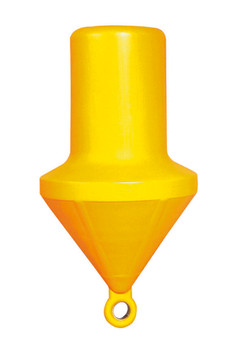
Plastimo 43404 Navigation Mark - Yellow

Plastimo Regatta Training Buoy

Optiparts Racing Mark - Ideal for Training and Clubs

Plastimo Rescue Buoy Yellow Horseshoe Buoy+Light

Plastimo Cylindrical Racing Mark - 1.5M x 0.9m 16448

Plastimo Replacement Cover Netting for Racing Mark - 1.5m Diameter 16445

Plastimo Spherical Racing Mark - 1.5M Diameter 16445
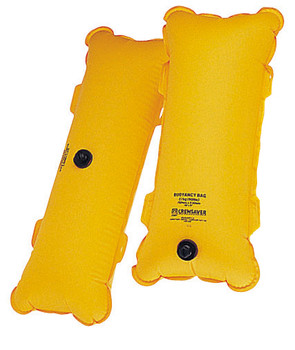
Crewsaver Pillow Buoyancy Bag 68L - 147 X 27cm
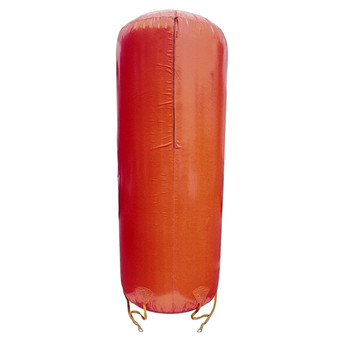
Crewsaver Racing Marks - Cylindrical Buoy 5ft x 2ft 6"

Crewsaver Racing Marks - Cylindrical Buoy 6ft x 2ft 6"

Crewsaver Racing Marks - Cylindrical Buoy - 4ft x 2ft

Plastimo Regatta Jumbo Marker Buoy - Height 3.2mx Base 2m

Polyform Fender Buoy A4 - White (75")

Polyform Fender Buoy A5 - White (100")

Polyform Marker Buoy A5 - Red (100")

Polyform Marker Buoy A6 - Red (110")

- Nautic House Marsh Rd Skibbereen Co. Cork Ireland P81 R230
- Call us on 021 4315700
About CH Marine
- Stores & Hours
Customer Service
- Brexit Notes
- Privacy Policy
- Returns Policy
- Terms & Conditions
- Shipping & Delivery Times
- Gift Certificates
- WEEE Recycling
Popular Brands
- International
- See all brands here
- Subscribe to our newsletter

Table of Contents

- because of foul weather,
- because of insufficient wind making it unlikely that any boat will Definition: Finish " data-url="/definitions/76?xformat=fleet" href="javascript:void(0)">finish within the race time limit,
- because a Definition: Mark " data-url="/definitions/70?xformat=fleet" href="javascript:void(0)">mark is missing or out of position, or
- for any other reason directly affecting the safety or fairness of the competition,
- a line the course requires boats to cross; or
- at a gate, between the gate Definition: Mark " data-url="/definitions/70?xformat=fleet" href="javascript:void(0)">marks .

- the new compass bearing or
- a green triangle for a change to starboard or a red rectangle for a change to port.
- Subsequent legs may be changed without further signalling to maintain the course shape.
- replace it in its correct position or substitute a new one of similar appearance, or

- prohibit a boat from competing unless she has broken rule Rule: 30.4 " data-url="/rules/1569?xformat=fleet" href="javascript:;">30.4 ; or
- cause a boat to be penalized except under rule Rule: 2 " data-url="/rules/1150?xformat=fleet" href="javascript:;">2 , Rule: 30.2 " data-url="/rules/1544?xformat=fleet" href="javascript:;">30.2 , Rule: 30.4 " data-url="/rules/1569?xformat=fleet" href="javascript:;">30.4 or Rule: 69 " data-url="/rules/1626?xformat=fleet" href="javascript:;">69 or under rule Rule: 14 " data-url="/rules/1320?xformat=fleet" href="javascript:;">14 when she has caused injury or serious damage.

Previous Versions
Last updated.

Race Mark Information
Poole harbour marks 2023, poole bay marks 2023, race mark sponsors.

ADVANCED SAILING RACE COURSE TECHNOLOGY
Simple, precise course setting with no anchors.
MarkSetBot is the world’s first and most advanced robotic sailing mark system
THE FUTURE OF SAILING RACE MANAGEMENT IS HERE
Set your course faster, more easily, and more accurately than ever before. the future of race management is here..
MarkSetBot offers robotic buoys and integrated course-setting technology for sailboat racing that makes race management simple, accurate and sustainable. Our patented robotic buoys are self-propelled and use GPS technology to hold position without anchors. With a user-friendly mobile app, easy assembly, and effortless routing and repositioning, they make precise race management simple.
Robotic Buoys
Add-on technology, why marksetbot, marksetbot helps clubs and organizations run races sustainably and efficiently with game-changing technology.

Fast course set-up with simple map design

Precise placement with quick repositioning

User friendly mobile app with off-grid remote
No anchor needed in deep water or high wind

Reduces environmental damage

Fully inflatable for easy transport and ASSEMBLY

Automated layout templates for 35+ courses

Comprehensive suite of supportive race management technology
Dedicated team supporting product delivery and innovation

ON-THE-WATER EXPERIENCE
MarkSetBot hardware and software have been honed since early 2014. Today, MarkSetBot is trusted by clubs worldwide and at all levels of events, from local weekday racing to world championship regattas. Our Bots have spent more than 32,000 days on the water and our app has been used in 39 countries.
GLOBAL REACH
MarkSetBot has an established network of dealers and distributors in Europe, Asia, Oceania and North America. From sales to Bot maintenance and event management, our dealers are here to support you and your Bot fleet.
THE EVENTS AND ORGANIZATIONS WE SERVE
Customers and partners.
MarkSetBot improves the quality and sustainability of racing, makes it possible to run more races in less time and results in happy racers and race committees.
"[MarkSetBot] has added a lot of quality to the racing. We don’t need to wait when we have a big wind shift as the marks can now be moved very efficiently, which ensures the competitors aren’t waiting a long time for the racing. Sometimes when the water is very deep, the mark layers need a lot of time to reset the course but with the robotic marks, it can be done very quickly. This makes it easier to get a higher degree of accuracy, and so the quality of the racing is much higher."
Maria Torrijo, Principal Race Officer, RC44 Cup
“The robotic racing marks from MarkSetBot proved their worth from the outset, not only protecting the seabed as part of ClubSwan Racing’s commitment to sustainability but also able to be easily repositioned to take account of windshifts.”
The Nations League Swan One Design
“I’m amazed at how accurate the MarkSetBots are. I noticed it when I was pinging the line. Every ping, they were in the same exact place. In shifty venues, you’re able to make course adjustments so easily by just pressing a button. It was very efficient and I think we were able to run races in conditions that otherwise would have been a lot more challenging and maybe not possible.”
Victor Diaz De Leon, Professional Sailor
“I recently did a Club-Swan 50 event and they used really cool self-propelled, no anchor GPS-controlled race marks – they were working in current and good breeze and waves and it made for simple racecourse adjustments and far fewer people needed to run the races. If you are a starting-line perfectionist PRO this gives you free reign to move the mark up to about five minutes before the start and still allow people to ping the pin.
Fewer people. Fewer anchor lines. Fewer boats needed. Less fuel.”
Ken Read, President, North Sails

LATEST FROM THE BLOG

Meet GolfShotBot, a dynamic floating golf target
Hitting biodegradable golf balls into the water is fun. Hitting them at a floating golf target...

Webinar: Unlocking the MarkSetBot Advantage
Whether you're a seasoned Bot Pro, considering bringing Bots to your course or just following...

M32s Bringing New Technology and New Blood to the Race Course
The M32 fleet has long been on the cutting-edge of sailing. First created in 2011, the M32 has...
LET’S TALK

Published on February 15th, 2021 | by Editor
Robotic Marks: Evaluating the issues
Published on February 15th, 2021 by Editor -->
Competition within sailing creates as much a community of racers as it does race volunteers. To host events, there is equipment to manage, courses to set, fleets to start and finish… it requires people with a passion for being on the water and working together.
Seeking to impact this paradigm and minimize the committee boats and people needed is the robotic mark industry. Using GPS tools and self-powered motors to accurately set the mark while eliminating anchoring… what’s not to like?
While our sport is good at seeking to improve itself, it is equally good at doing so at an ever increasing cost in time and money. A close evaluation of the current expense of running races, and how that would compare with robotic marks, is an important step in this process.
Three-time Olympian Chris Rast, who represents RoboMark , offers some of the additional issues to consider when looking at this evolution:

The robotic mark industry is now going into its 5th year since MarkSetBot introduced its first version. A quick google search will list the following companies that are now vying for your interest:
• MarkSetBot : The first robotic mark hit the racecourse in 2016, based in USA. • RoboMark : After successful, extensive trials, their first product, the RoboMark C1, is now being offered, based in Switzerland. • SMark : Watersportmarks, based in Switzerland, offers sMark, a smaller and handy mark. • SmartMark : Based on the original concept by Roboboj, based in Germany. • Roboboj : An early producer but seems like they aren’t really in the business anymore. They were in Switzerland. As with any other project, you need to do your homework first. Talk to your sailors, volunteers, race committee officials, the budget committee, and Racing Directors to develop an extensive list of Must-haves and Nice-to-haves. Here are some points you want to look at:
Venue: • What kind of wind and wave conditions will you use the marks? If it’s a windy place, you better ensure that the system has some substantial battery capacity. • Towing capability. If you need to tow your marks to the racecourse area and it is more than a mile away, you will want a design that is either small enough to bring on board or that allows you to easily tow it at faster speeds. • Pricing. What kind of business model suits you best? Would you just want to buy a complete set or have a yearly rental agreement? • Warranty and maintenance agreements. How are claims made, how long does the warranty last, how are the robotic marks serviced? What maintenance do they require? • Who at your club will oversee them and where/how will they be stored? • Launching and retrieving the marks. What are the possibilities at your club? How easy is it to handle the robotic mark onshore? • Regulations. Check with your local authorities and government agencies for what requirements you need to fulfill to use robotic marks in your area legally. This can include drone and/or simple remote-controlled water vehicle regulations. Be aware that you are responsible for using this remotely controlled vehicle and it always needs to be in sight of the user. • Networking capabilities. Most robotic marks use a mobile network for controlling. This sounds great until suddenly there are no more bars on your phone. If you have sketchy/weak reception, you might want to choose a system that works on a closed WIFI Network, so you aren’t dependent on mobile reception.
Event/ Regatta: • How many robotic marks do you need? Depending on the courses and how many classes you usually sail, you will need a certain number of marks. Just remember, you can quickly reposition robotic marks so that a starting line can easily become a leeward gate. • Branding. You might want the possibility of branding your marks with a sponsor or other signage. On some designs, this will mean added wind resistance, so make sure they have enough power and battery capacity to do their job for several hours in 20 knots.
Products: • What functionalities does the robotic mark application need to have? Pre-set courses, battery status, and time indication until all robotic marks are in their respective positions are useful functions. • Transport concept. If you are traveling a lot with the whole system, you will want to ensure that everything packs up nicely. • Batteries. Make sure the provided batteries can power the robotic mark without any problems. Most designs don’t allow for easy swapping on the water. How long do they take to fully charge? • Plan B. What are the options if the remote-control fails? Can you position the robotic mark by pressing a button on itself? Or can you at least attach some tackle and a weight? • What other special functions can the robotic mark offer? Wind sensors, joystick function, horn signals, etc.

Tags: Chris Rast , RoboMark , robot marks , robotic
Related Posts

Hold Fast: An Olympic Sailing Podcast →

Robots to invade Block Island Sound →

VIDEO: What To Do as Puffs Come and Go →

Robot Sailboats Scour the Oceans for Data →
© 2024 Scuttlebutt Sailing News. Inbox Communications, Inc. All Rights Reserved. made by VSSL Agency .
- Privacy Statement
- Advertise With Us
Get Your Sailing News Fix!
Your download by email.
- Your Name...
- Your Email... *
- Email This field is for validation purposes and should be left unchanged.

market research survey for new business
Business growth
Marketing tips
How to conduct your own market research survey (with example)

After watching a few of those sketches, you can imagine why real-life focus groups tend to be pretty small. Even without any over-the-top personalities involved, it's easy for these groups to go off the rails.
So what happens when you want to collect market research at a larger scale? That's where the market research survey comes in. Market surveys allow you to get just as much valuable information as an in-person interview, without the burden of herding hundreds of rowdy Eagles fans through a product test.
Table of contents:
- What is a market research survey?
Why conduct market research, primary vs. secondary market research.
6 types of market research surveys
How to write and conduct a market research survey
Tips for running a market research survey.
Market research survey campaign example questions
Market research survey template
Use automation to put survey results into action
A market research survey is a questionnaire designed to collect key information about a company's target market and audience that will help guide business decisions about products and services, branding angles, and advertising campaigns.
Market surveys are what's known as "primary research"—that is, information that the researching company gathers firsthand. Secondary research consists of data that another organization gathered and published, which other researchers can then use for their own reports. Primary research is more expensive and time-intensive than secondary research, which is why you should only use market research surveys to obtain information that you can't get anywhere else.
A market research survey can collect information on your target customers':
- Experiences
Preferences, desires, and needs
Values and motivations
The types of information that can usually be found in a secondary source, and therefore aren't good candidates for a market survey, include your target customers':
Demographic data
Consumer spending data
Household size
Lots of this secondary information can be found in a public database like those maintained by the Census Bureau and Bureau of Labor Statistics . There are also a few free market research tools that you can use to access more detailed data, like Think with Google , Data USA , and Statista . Or, if you're looking to learn about your existing customer base, you can also use a CRM to automatically record key information about your customers each time they make a purchase.
If you've exhausted your secondary research options and still have unanswered questions, it's time to start thinking about conducting a market research survey.
The first thing to figure out is what you're trying to learn, and from whom. Are you beta testing a new product or feature with existing users? Or are you looking to identify new customer personas for your marketers to target? There are a number of different ways to use a marketing research survey, and your choice will impact how you set up the questionnaire.
Here are some examples of how market research surveys can be used to fill a wide range of knowledge gaps for companies:
A B2B software company asks real users in its industry about Kanban board usage to help prioritize their project view change rollout.
A B2C software company asks its target demographic about their mobile browsing habits to help them find features to incorporate into their forthcoming mobile app.
A printing company asks its target demographic about fabric preferences to gauge interest in a premium material option for their apparel lines.
A wholesale food vendor surveys regional restaurant owners to find ideas for seasonal products to offer.
Market surveys are what's known as "primary research"—that is, information that the researching company gathers firsthand. Secondary research consists of data that another organization gathered and published, which other researchers can then use for their own reports.
Primary research is more expensive and time-intensive than secondary research, which is why you should only use market research surveys to obtain information that you can't get anywhere else.
Lots of this secondary information can be found in a public database like those maintained by the Census Bureau and Bureau of Labor Statistics . There are also a few free market research tools that you can use to access more detailed data, like Think with Google , Data USA , and Statista .
Or, if you're looking to learn about your existing customer base, you can also use a CRM to automatically record key information about your customers each time they make a purchase.
6 types of market research survey
Depending on your goal, you'll need different types of market research. Here are six types of market research surveys.
1. Buyer persona research
A buyer persona or customer profile is a simple sketch of the types of people that you should be targeting as potential customers.
A buyer persona research survey will help you learn more about things like demographics, household makeup, income and education levels, and lifestyle markers. The more you learn about your existing customers, the more specific you can get in targeting potential customers. You may find that there are more buyer personas within your user base than the ones that you've been targeting.
2. Sales funnel research
The sales funnel is the path that potential customers take to eventually become buyers. It starts with the target's awareness of your product, then moves through stages of increasing interest until they ultimately make a purchase.
With a sales funnel research survey, you can learn about potential customers' main drivers at different stages of the sales funnel. You can also get feedback on how effective different sales strategies are. Use this survey to find out:
How close potential buyers are to making a purchase
What tools and experiences have been most effective in moving prospective customers closer to conversion
What types of lead magnets are most attractive to your target audience
3. Customer loyalty research
Whenever you take a customer experience survey after you make a purchase, you'll usually see a few questions about whether you would recommend the company or a particular product to a friend. After you've identified your biggest brand advocates , you can look for persona patterns to determine what other customers are most likely to be similarly enthusiastic about your products. Use these surveys to learn:
The demographics of your most loyal customers
What tools are most effective in turning customers into advocates
What you can do to encourage more brand loyalty
4. Branding and marketing research
The Charmin focus group featured in that SNL sketch is an example of branding and marketing research, in which a company looks for feedback on a particular advertising angle to get a sense of whether it will be effective before the company spends money on running the ad at scale. Use this type of survey to find out:
Whether a new advertising angle will do well with existing customers
Whether a campaign will do well with a new customer segment you haven't targeted yet
What types of campaign angles do well with a particular demographic
5. New products or features research
Whereas the Charmin sketch features a marketing focus group, this one features new product research for a variety of new Hidden Valley Ranch flavors. Though you can't get hands-on feedback on new products when you're conducting a survey instead of an in-person meeting, you can survey your customers to find out:
What features they wish your product currently had
What other similar or related products they shop for
What they think of a particular product or feature idea
Running a survey before investing resources into developing a new offering will save you and the company a lot of time, money, and energy.
6. Competitor research
You can get a lot of information about your own customers and users via automatic data collection , but your competitors' customer base may not be made up of the same buyer personas that yours is. Survey your competitors' users to find out:
Your competitors ' customers' demographics, habits, and behaviors
Whether your competitors have found success with a buyer persona you're not targeting
Information about buyers for a product that's similar to one you're thinking about launching
Feedback on what features your competitors' customers wish their version of a product had
Once you've narrowed down your survey's objectives, you can move forward with designing and running your survey.
Step 1: Write your survey questions
A poorly worded survey, or a survey that uses the wrong question format, can render all of your data moot. If you write a question that results in most respondents answering "none of the above," you haven't learned much.
You'll find dozens of question types and even pre-written questions in most survey apps . Here are a few common question types that work well for market surveys.
Categorical questions
Also known as a nominal question, this question type provides numbers and percentages for easy visualization, like "35% said ABC." It works great for bar graphs and pie charts, but you can't take averages or test correlations with nominal-level data.
Yes/No: The most basic survey question used in polls is the Yes/No question, which can be easily created using your survey app or by adding Yes/No options to a multiple-choice question.
Multiple choice: Use this type of question if you need more nuance than a Yes/No answer gives. You can add as many answers as you want, and your respondents can pick only one answer to the question.
Checkbox: Checkbox questions add the flexibility to select all the answers that apply. Add as many answers as you want, and respondents aren't limited to just one.

Ordinal questions
This type of question requires survey-takers to pick from options presented in a specific order, like "income of $0-$25K, $26K-$40K, $41K+." Like nominal questions, ordinal questions elicit responses that allow you to analyze counts and percentages, though you can't calculate averages or assess correlations with ordinal-level data.
Dropdown: Responses to ordinal questions can be presented as a dropdown, from which survey-takers can only make one selection. You could use this question type to gather demographic data, like the respondent's country or state of residence.
Ranking: This is a unique question type that allows respondents to arrange a list of answers in their preferred order, providing feedback on each option in the process.
Interval/ratio questions
For precise data and advanced analysis, use interval or ratio questions. These can help you calculate more advanced analytics, like averages, test correlations, and run regression models. Interval questions commonly use scales of 1-5 or 1-7, like "Strongly disagree" to "Strongly agree." Ratio questions have a true zero and often ask for numerical inputs (like "How many cups of coffee do you drink per day? ____").
Ranking scale: A ranking scale presents answer choices along an ordered value-based sequence, either using numbers, a like/love scale, a never/always scale, or some other ratio interval. It gives more insight into people's thoughts than a Yes/No question.
Matrix: Have a lot of interval questions to ask? You can put a number of questions in a list and use the same scale for all of them. It simplifies gathering data about a lot of similar items at once.
Example : How much do you like the following: oranges, apples, grapes? Hate/Dislike/Ok/Like/Love
Textbox: A textbox question is needed for collecting direct feedback or personal data like names. There will be a blank space where the respondent can enter their answer to your question on their own.
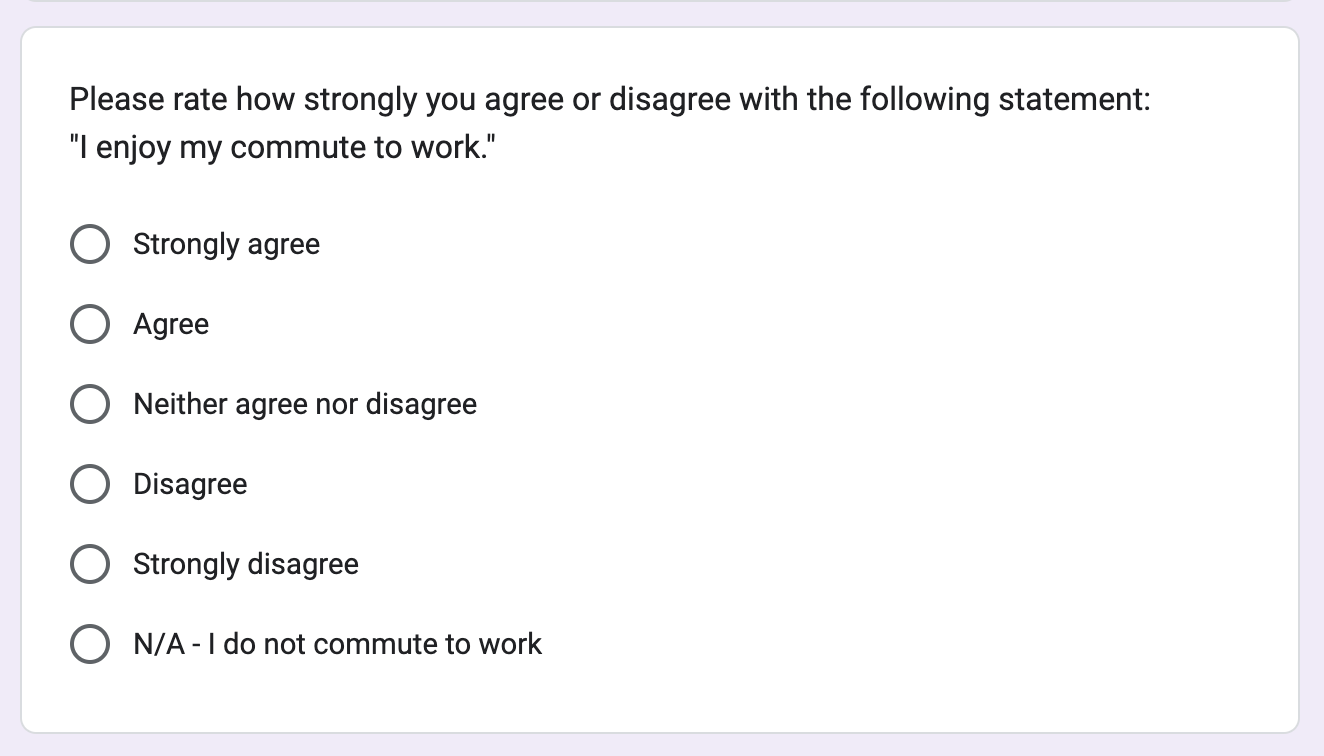
Step 2: Choose a survey platform
There are a lot of survey platforms to choose from, and they all offer different and unique features. Check out Zapier's list of the best online survey apps to help you decide.
Most survey apps today look great on mobile, but be sure to preview your survey on your phone and computer, at least, to make sure it'll look good for all of your users.
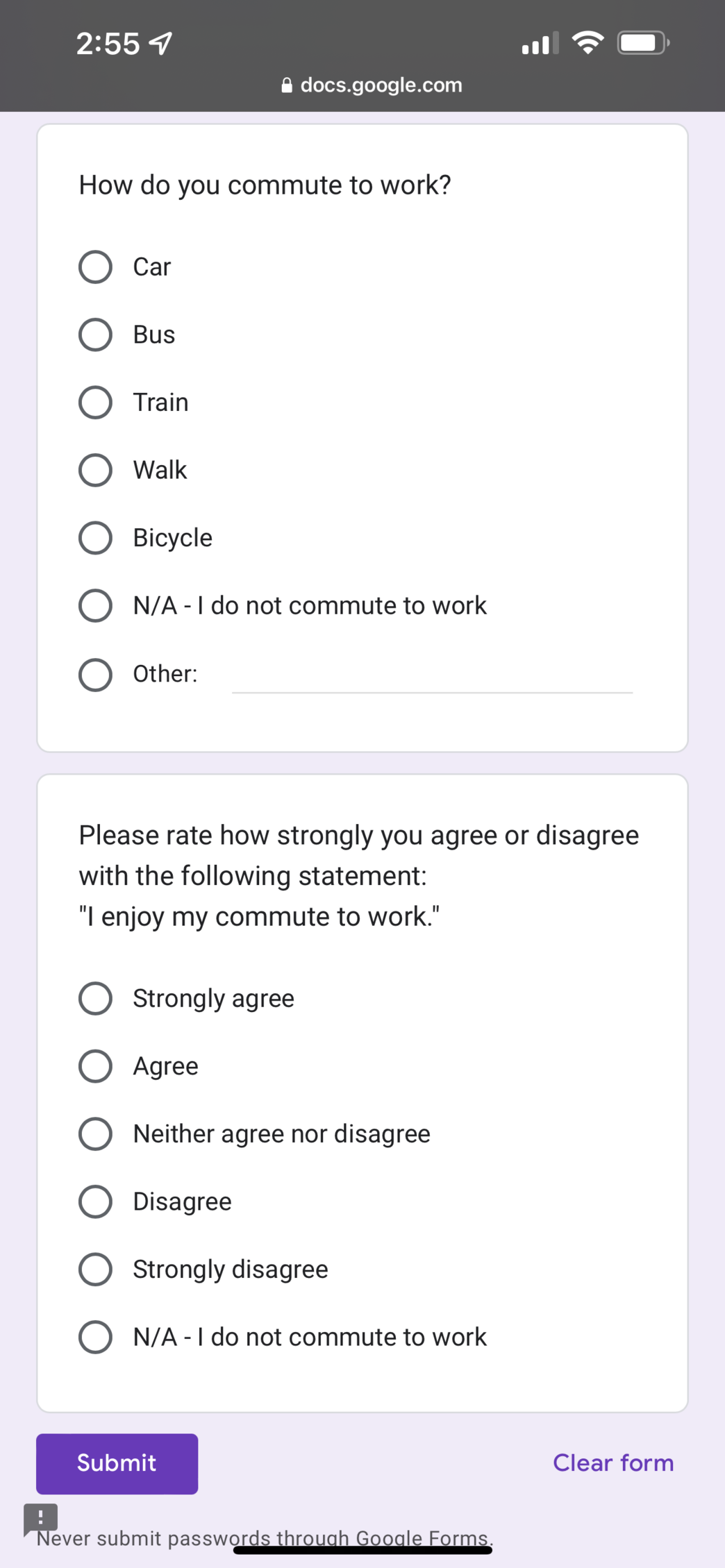
If you have the budget, you can also purchase survey services from a larger research agency.
Step 3: Run a test survey
Before you run your full survey, conduct a smaller test on 5%-10% of your target respondent pool size. This will allow you to work out any confusing wording or questions that result in unhelpful responses without spending the full cost of the survey. Look out for:
Survey rejection from the platform for prohibited topics
Joke or nonsense textbox answers that indicate the respondent didn't answer the survey in earnest
Multiple choice questions with an outsized percentage of "none of the above" or "N/A" responses
Step 4: Launch your survey
If your test survey comes back looking good, you're ready to launch the full thing! Make sure that you leave ample time for the survey to run—you'd be surprised at how long it takes to get a few thousand respondents.
Even if you've run similar surveys in the past, leave more time than you need. Some surveys take longer than others for no clear reason, and you also want to build in time to conduct a comprehensive data analysis.
Step 5: Organize and interpret the data
Unless you're a trained data analyst, you should avoid crunching all but the simplest survey data by hand. Most survey platforms include some form of reporting dashboard that will handle things like population weighting for you, but you can also connect your survey platform to other apps that make it easy to keep track of your results and turn them into actionable insights.
You know the basics of how to conduct a market research survey, but here are some tips to enhance the quality of your data and the reliability of your findings.
Find the right audience: You could have meticulously crafted survey questions, but if you don't target the appropriate demographic or customer segment, it doesn't really matter. You need to collect responses from the people you're trying to understand. Targeted audiences you can send surveys to include your existing customers, current social media followers, newsletter subscribers, attendees at relevant industry events, and community members from online forums, discussion boards, or other online communities that cater to your target audience.
Take advantage of existing resources: No need to reinvent the wheel. You may be able to use common templates and online survey platforms like SurveyMonkey for both survey creation and distribution. You can also use AI tools to create better surveys. For example, generative AI tools like ChatGPT can help you generate questions, while analytical AI tools can scan survey responses to help sort, tag, and report on them. Some survey apps have AI built into them already too.
Focus questions on a desired data type: As you conceptualize your survey, consider whether a qualitative or quantitative approach will better suit your research goals. Qualitative methods are best for exploring in-depth insights and underlying motivations, while quantitative methods are better for obtaining statistical data and measurable trends. For an outcome like "optimize our ice cream shop's menu offerings," you may want to find out which flavors of ice cream are most popular with teens. This would require a quantitative approach, for which you would use categorical questions that can help you rank potential flavors numerically.
Establish a timeline: Set a realistic timeline for your survey, from creation to distribution to data collection and analysis. You'll want to balance having your survey out long enough to generate a significant amount of responses but not so long that it loses relevance. That length can vary widely based on factors like type of survey, number of questions, audience size, time sensitivity, question format, and question length.
Define a margin of error: Your margin of error shows how much the survey results might differ from the real opinions of the entire group being studied. Since you can't possibly survey every single person in your desired population, you'll have to settle on an acceptable percentage of error upfront, a percentage figure that varies by sample size, sample proportion, and confidence interval. According to University of Wisconsin-Madison's Pamela Hunter , 95% is the industry standard confidence level (though small sample sizes may get by with 90%). At the 95% level, for example, an acceptable margin of error for a survey of 500 respondents would be 3%. That means that if 80% of respondents give a positive response to a question, the data shows that between 77-83% respond positively 95 out of 100 times.
Market research survey campaign example
Let's say you own a market research company, and you want to use a survey to gain critical insights into your market. You prompt users to fill out your survey before they can access gated premium content.
Survey questions:
1. What size is your business?
<10 employees
11-50 employees
51-100 employees
101-200 employees
>200 employees
2. What industry type best describes your role?
3. On a scale of 1-4, how important would you say access to market data is?
1 - Not important
2 - Somewhat important
3 - Very important
4 - Critically important
4. On a scale of 1 (least important) to 5 (most important), rank how important these market data access factors are.
Accuracy of data
Attractive presentation of data
Cost of data access
Range of data presentation formats
Timeliness of data
5. True or false: your job relies on access to accurate, up-to-date market data.
Survey findings:
63% of respondents represent businesses with over 100 employees, while only 8% represent businesses with under 10.
71% of respondents work in sales, marketing, or operations.
80% of respondents consider access to market data to be either very important or critically important.
"Timeliness of data" (38%) and "Accuracy of data" (32%) were most commonly ranked as the most important market data access factor.
86% of respondents claimed that their jobs rely on accessing accurate, up-to-date market data.
Insights and recommendations: Independent analysis of the survey indicates that a large percentage of users work in the sales, marketing, or operations fields of large companies, and these customers value timeliness and accuracy most. These findings can help you position future report offerings more effectively by highlighting key benefits that are important to customers that fit into related customer profiles.
Market research survey example questions
Your individual questions will vary by your industry, market, and research goals, so don't expect a cut-and-paste survey to suit your needs. To help you get started, here are market research survey example questions to give you a sense of the format.
Yes/No: Have you purchased our product before?
Multiple choice: How many employees work at your company?
<10 / 10-20 / 21-50 / 51-100 / 101-250 / 250+
Checkbox: Which of the following features do you use in our app?
Push notifications / Dashboard / Profile customization / In-app chat
Dropdown: What's your household income?
$0-$10K / $11-$35K / $36-$60K / $61K+
Ranking: Which social media platforms do you use the most? Rank in order, from most to least.
Facebook / Instagram / Twitter / LinkedIn / Reddit
Ranking scale: On a scale of 1-5, how would you rate our customer service?
1 / 2 / 3 / 4 / 5
Textbox: How many apps are installed on your phone? Enter a number:
Market research survey question types
Good survey apps typically offer pre-designed templates as a starting point. But to give you a more visual sense of what these questions might look like, we've put together a document showcasing common market research survey question types.
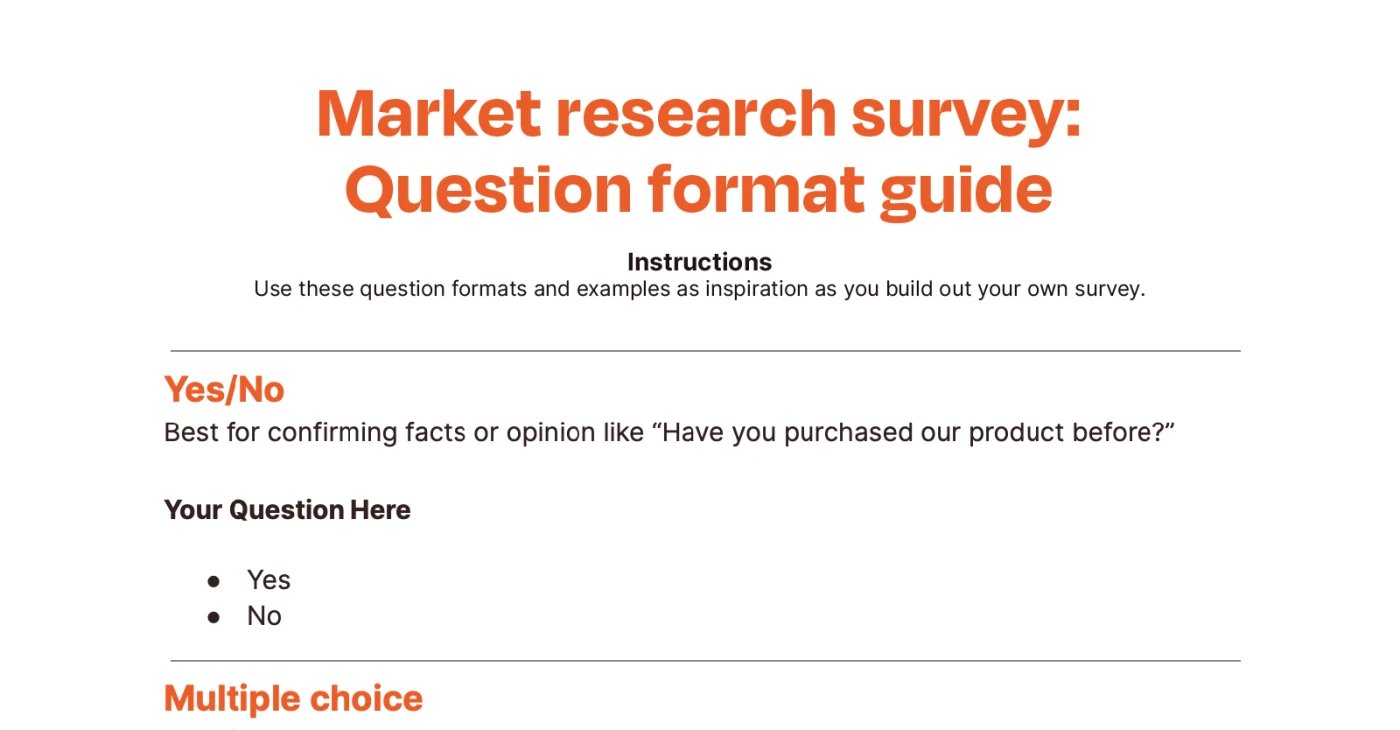
You're going to get a lot of responses back from your survey—why dig through them all manually if you don't have to? Automate your survey to aggregate information for you, so it's that much easier to uncover findings.
Related reading:
Poll vs. survey: What is a survey and what are polls?
The best online survey apps
The best free form builders and survey tools
How to get people to take a survey
This article was originally published in June 2015 by Stephanie Briggs. The most recent update, with contributions from Cecilia Gillen, was in September 2023.
Get productivity tips delivered straight to your inbox
We’ll email you 1-3 times per week—and never share your information.

Amanda Pell
Amanda is a writer and content strategist who built her career writing on campaigns for brands like Nature Valley, Disney, and the NFL. When she's not knee-deep in research, you'll likely find her hiking with her dog or with her nose in a good book.
- Forms & surveys
Related articles

How will AI change SEO content production?

12 stunning and time-saving newsletter templates for Word
12 stunning and time-saving newsletter...

How Hunter built 174 backlinks from DR70+ domains through guest blogging
How Hunter built 174 backlinks from DR70+...
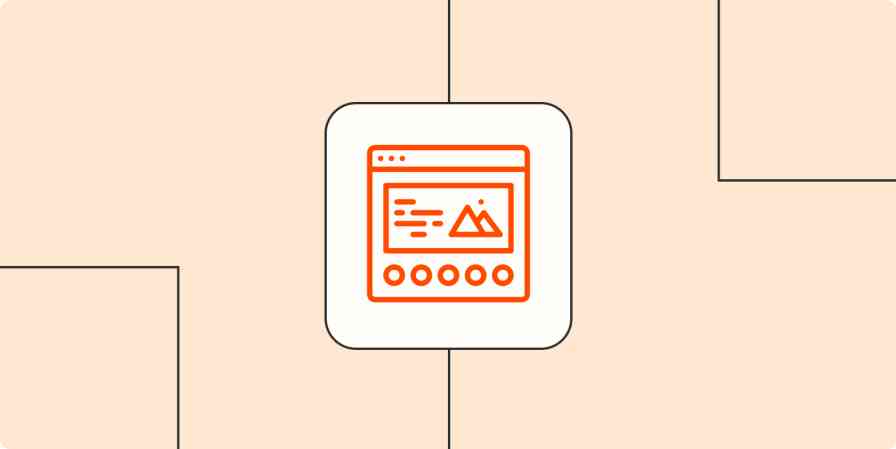
9 landing page ideas to help inspire your campaigns in 2024
9 landing page ideas to help inspire your...
Improve your productivity automatically. Use Zapier to get your apps working together.

Market Research: A How-To Guide and Template
Discover the different types of market research, how to conduct your own market research, and use a free template to help you along the way.

MARKET RESEARCH KIT
5 Research and Planning Templates + a Free Guide on How to Use Them in Your Market Research

Updated: 02/21/24
Published: 02/21/24
Today's consumers have a lot of power. As a business, you must have a deep understanding of who your buyers are and what influences their purchase decisions.
Enter: Market Research.
![market research survey for new business → Download Now: Market Research Templates [Free Kit]](https://no-cache.hubspot.com/cta/default/53/6ba52ce7-bb69-4b63-965b-4ea21ba905da.png)
Whether you're new to market research or not, I created this guide to help you conduct a thorough study of your market, target audience, competition, and more. Let’s dive in.
Table of Contents
What is market research.
Primary vs. secondary research, types of market research, how to do market research, market research report template, market research examples.
Market research is the process of gathering information about your target market and customers to verify the success of a new product, help your team iterate on an existing product, or understand brand perception to ensure your team is effectively communicating your company's value effectively.
Market research can answer various questions about the state of an industry. But if you ask me, it's hardly a crystal ball that marketers can rely on for insights on their customers.
Market researchers investigate several areas of the market, and it can take weeks or even months to paint an accurate picture of the business landscape.
However, researching just one of those areas can make you more intuitive to who your buyers are and how to deliver value that no other business is offering them right now.
How? Consider these two things:
- Your competitors also have experienced individuals in the industry and a customer base. It‘s very possible that your immediate resources are, in many ways, equal to those of your competition’s immediate resources. Seeking a larger sample size for answers can provide a better edge.
- Your customers don't represent the attitudes of an entire market. They represent the attitudes of the part of the market that is already drawn to your brand.
The market research services market is growing rapidly, which signifies a strong interest in market research as we enter 2024. The market is expected to grow from roughly $75 billion in 2021 to $90.79 billion in 2025 .
.png)
Free Market Research Kit
- SWOT Analysis Template
- Survey Template
- Focus Group Template
You're all set!
Click this link to access this resource at any time.
Why do market research?
Market research allows you to meet your buyer where they are.
As our world becomes louder and demands more of our attention, this proves invaluable.
By understanding your buyer's problems, pain points, and desired solutions, you can aptly craft your product or service to naturally appeal to them.
Market research also provides insight into the following:
- Where your target audience and current customers conduct their product or service research
- Which of your competitors your target audience looks to for information, options, or purchases
- What's trending in your industry and in the eyes of your buyer
- Who makes up your market and what their challenges are
- What influences purchases and conversions among your target audience
- Consumer attitudes about a particular topic, pain, product, or brand
- Whether there‘s demand for the business initiatives you’re investing in
- Unaddressed or underserved customer needs that can be flipped into selling opportunity
- Attitudes about pricing for a particular product or service
Ultimately, market research allows you to get information from a larger sample size of your target audience, eliminating bias and assumptions so that you can get to the heart of consumer attitudes.
As a result, you can make better business decisions.
To give you an idea of how extensive market research can get , consider that it can either be qualitative or quantitative in nature — depending on the studies you conduct and what you're trying to learn about your industry.
Qualitative research is concerned with public opinion, and explores how the market feels about the products currently available in that market.
Quantitative research is concerned with data, and looks for relevant trends in the information that's gathered from public records.
That said, there are two main types of market research that your business can conduct to collect actionable information on your products: primary research and secondary research.
Primary Research
Primary research is the pursuit of first-hand information about your market and the customers within your market.
It's useful when segmenting your market and establishing your buyer personas.
Primary market research tends to fall into one of two buckets:
- Exploratory Primary Research: This kind of primary market research normally takes place as a first step — before any specific research has been performed — and may involve open-ended interviews or surveys with small numbers of people.
- Specific Primary Research: This type of research often follows exploratory research. In specific research, you take a smaller or more precise segment of your audience and ask questions aimed at solving a suspected problem.
Secondary Research
Secondary research is all the data and public records you have at your disposal to draw conclusions from (e.g. trend reports, market statistics, industry content, and sales data you already have on your business).
Secondary research is particularly useful for analyzing your competitors . The main buckets your secondary market research will fall into include:
- Public Sources: These sources are your first and most-accessible layer of material when conducting secondary market research. They're often free to find and review — like government statistics (e.g., from the U.S. Census Bureau ).
- Commercial Sources: These sources often come in the form of pay-to-access market reports, consisting of industry insight compiled by a research agency like Pew , Gartner , or Forrester .
- Internal Sources: This is the market data your organization already has like average revenue per sale, customer retention rates, and other historical data that can help you draw conclusions on buyer needs.
- Focus Groups
- Product/ Service Use Research
- Observation-Based Research
- Buyer Persona Research
- Market Segmentation Research
- Pricing Research
- Competitive Analysis Research
- Customer Satisfaction and Loyalty Research
- Brand Awareness Research
- Campaign Research
1. Interviews
Interviews allow for face-to-face discussions so you can allow for a natural flow of conversation. Your interviewees can answer questions about themselves to help you design your buyer personas and shape your entire marketing strategy.
2. Focus Groups
Focus groups provide you with a handful of carefully-selected people that can test out your product and provide feedback. This type of market research can give you ideas for product differentiation.
3. Product/Service Use Research
Product or service use research offers insight into how and why your audience uses your product or service. This type of market research also gives you an idea of the product or service's usability for your target audience.
4. Observation-Based Research
Observation-based research allows you to sit back and watch the ways in which your target audience members go about using your product or service, what works well in terms of UX , and which aspects of it could be improved.
5. Buyer Persona Research
Buyer persona research gives you a realistic look at who makes up your target audience, what their challenges are, why they want your product or service, and what they need from your business or brand.
6. Market Segmentation Research
Market segmentation research allows you to categorize your target audience into different groups (or segments) based on specific and defining characteristics. This way, you can determine effective ways to meet their needs.
7. Pricing Research
Pricing research helps you define your pricing strategy . It gives you an idea of what similar products or services in your market sell for and what your target audience is willing to pay.
8. Competitive Analysis
Competitive analyses give you a deep understanding of the competition in your market and industry. You can learn about what's doing well in your industry and how you can separate yourself from the competition .
9. Customer Satisfaction and Loyalty Research
Customer satisfaction and loyalty research gives you a look into how you can get current customers to return for more business and what will motivate them to do so (e.g., loyalty programs , rewards, remarkable customer service).
10. Brand Awareness Research
Brand awareness research tells you what your target audience knows about and recognizes from your brand. It tells you about the associations people make when they think about your business.
11. Campaign Research
Campaign research entails looking into your past campaigns and analyzing their success among your target audience and current customers. The goal is to use these learnings to inform future campaigns.
- Define your buyer persona.
- Identify a persona group to engage.
- Prepare research questions for your market research participants.
- List your primary competitors.
- Summarize your findings.
1. Define your buyer persona.
You have to understand who your customers are and how customers in your industry make buying decisions.
This is where your buyer personas come in handy. Buyer personas — sometimes referred to as marketing personas — are fictional, generalized representations of your ideal customers.
Use a free tool to create a buyer persona that your entire company can use to market, sell, and serve better.

Some key characteristics you should be keen on including in your buyer persona are:
- Job title(s)
- Family size
- Major challenges
The idea is to use your persona(s) as a guideline for how to effectively reach and learn about the real audience members in your industry.
To get started with creating your personas, check out these free templates , as well as this helpful tool.
2. Identify a persona group to engage.
Now that you know who your buyer personas are, use that information to help you identify a group to engage to conduct your market research with.
This should be a representative sample of your target customers so you can better understand their actual characteristics, challenges, and buying habits.
How to Identify the Right People to Engage for Market Research
When choosing who to engage for your market research, you should:
- Aim for 10 participants per buyer persona. I recommend focusing on one persona at a time.
- Select people who have recently interacted with you. Focus on behaviors within the past six months (or up to a year).
- Gather a mix of participants. Recruit people who have purchased your product, purchased a competitor's product, and decided not to purchase anything at all.
- Provide an incentive. Motivate someone to spend 30-45 minutes on you and your study. On a tight budget? You can reward participants for free by giving them exclusive access to content.
Free Focus Group Kit
3. prepare research questions for your market research participants..
The best way to make sure you get the most out of your conversations is to be prepared.
You should always create a discussion guide to make sure you use your time wisely. Your discussion guide should be in an outline format, with a time allotment and open-ended questions for each section.
Wait, all open-ended questions?
Yes — this is a golden rule of market research. You never want to “lead the witness” by asking yes and no questions, as that puts you at risk of unintentionally swaying their thoughts by leading with your own hypothesis.
Asking open-ended questions also helps you avoid one-word answers (which aren't very helpful for you).
Example Outline of a 30-Minute Survey
Here's a general outline for a 30-minute survey for one B2B buyer.
Want to make it a digital survey? Use HubSpot's free online form builder .
Background Information (5 minutes)
Ask the buyer to give you a little background information (their title, how long they've been with the company, and so on). Then, ask a fun/easy question to warm things up (first concert attended, favorite restaurant in town, etc.).
Here are some key background questions to ask your target audience:
- Describe how your team is structured.
- Tell me about your personal job responsibilities.
- What are the team's goals and how do you measure them?
- What has been your biggest challenge in the past year?
Now, make a transition to acknowledge the specific purchase or interaction they made that led to you including them in the study. The next three stages of the buyer's journey will focus specifically on that purchase.
Awareness (5 minutes)
Here, you want to understand how they first realized they had a problem that needed to be solved without getting into whether or not they knew about your brand yet.
- Think back to when you first realized you needed a [name the product/service category, but not yours specifically]. What challenges were you facing at the time?
- How did you know that something in this category could help you?
- How familiar were you with different options on the market?
Consideration (10 minutes)
Now you want to get very specific about how and where the buyer researched potential solutions. Plan to interject to ask for more details.
- What was the first thing you did to research potential solutions? How helpful was this source?
- Where did you go to find more information?
If they don't come up organically, ask about search engines, websites visited, people consulted, and so on. Probe, as appropriate, with some of the following questions:
- How did you find that source?
- How did you use vendor websites?
- What words specifically did you search on Google?
- How helpful was it? How could it be better?
- Who provided the most (and least) helpful information? What did that look like?
- Tell me about your experiences with the sales people from each vendor.
Decision (10 minutes)
- Which of the sources you described above was the most influential in driving your decision?
- What, if any, criteria did you establish to compare the alternatives?
- What vendors made it to the short list and what were the pros/cons of each?
- Who else was involved in the final decision? What role did each of these people play?
- What factors ultimately influenced your final purchasing decision?
Here, you want to wrap up and understand what could have been better for the buyer.
- Ask them what their ideal buying process would look like. How would it differ from what they experienced?
- Allow time for further questions on their end.
- Don't forget to thank them for their time and confirm their address to send a thank-you note or incentive.
4. List your primary competitors.
List your primary competitors — keep in mind listing the competition isn't always as simple as Company X versus Company Y.
Sometimes, a division of a company might compete with your main product or service, even though that company's brand might put more effort in another area.
For example, Apple is known for its laptops and mobile devices but Apple Music competes with Spotify over its music streaming service.
From a content standpoint, you might compete with a blog, YouTube channel, or similar publication for inbound website visitors — even though their products don't overlap with yours at all.
For example, a toothpaste company might compete with magazines like Health.com or Prevention on certain blog topics related to health and hygiene even though the magazines don't actually sell oral care products.
Identifying Industry Competitors
To identify competitors whose products or services overlap with yours, determine which industry or industries you're pursuing.
Start high-level, using terms like education, construction, media & entertainment, food service, healthcare, retail, financial services, telecommunications, and agriculture.
You can build your list the following ways:
- Review your industry quadrant on G2 Crowd. G2 Crowd aggregates user ratings and social data to create “quadrants,” where you can see companies plotted as contenders, leaders, niche, and high performers in their respective industries.
- Download a market report. Companies like Forrester and Gartner offer both free and gated market forecasts every year on the vendors who are leading their industry.
- Search using social media. Social networks make great company directories. On LinkedIn, for example, select the search bar and enter the name of the industry you're pursuing. Then, under “More,” select “Companies” to narrow your results.
Identifying Content Competitors
Search engines are your best friends in this area of secondary market research.
To find the online publications with which you compete, take the overarching industry term you identified in the section above, and come up with a handful of more specific industry terms your company identifies with.
A catering business, for example, might generally be a “food service” company, but also consider itself a vendor in “event catering,” “cake catering,” or “baked goods.” Once you have this list, do the following:
- Google it. Don't underestimate the value in seeing which websites come up when you run a search on Google for the industry terms that describe your company. You might find a mix of product developers, blogs, magazines, and more.
- Compare your search results against your buyer persona. If the content the website publishes seems like the stuff your buyer persona would want to see, it's a potential competitor, and should be added to your list of competitors.
5. Summarize your findings.
Feeling overwhelmed by the notes you took? We suggest looking for common themes that will help you tell a story and create a list of action items.
To make the process easier, try using your favorite presentation software to make a report, as it will make it easy to add in quotes, diagrams, or call clips.
Feel free to add your own flair, but the following outline should help you craft a clear summary:
- Background: Your goals and why you conducted this study.
- Participants: Who you talked to. A table works well so you can break groups down by persona and customer/prospect.
- Executive Summary : What were the most interesting things you learned? What do you plan to do about it?
- Awareness: Describe the common triggers that lead someone to enter into an evaluation. (Quotes can be very powerful.)
- Consideration: Provide the main themes you uncovered, as well as the detailed sources buyers use when conducting their evaluation.
- Decision: Paint the picture of how a decision is really made by including the people at the center of influence and any product features or information that can make or break a deal.
- Action Plan: Your analysis probably uncovered a few campaigns you can run to get your brand in front of buyers earlier and/or more effectively. Provide your list of priorities, a timeline, and the impact it will have on your business.
Within a market research kit, there are a number of critical pieces of information for your business‘s success. Let’s take a look at these elements.
Pro Tip: Upon downloading HubSpot's free Market Research Kit , you'll receive editable templates for each of the given parts of the kit, instructions on how to use the kit, and a mock presentation that you can edit and customize.

Download HubSpot's free, editable market research report template here.
1. Five Forces Analysis Template
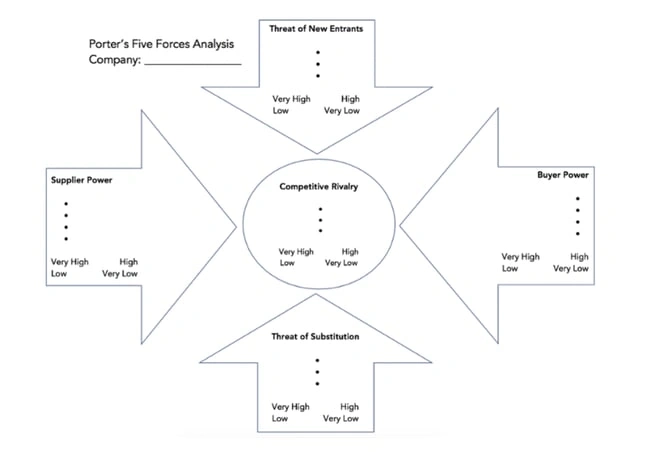
Use Porter's Five Forces Model to understand an industry by analyzing five different criteria and how high the power, threat, or rivalry in each area is — here are the five criteria:
- Competitive rivalry
- Threat of new entrants
- Threat of substitution
- Buyer power
- Supplier power
Download a free, editable Five Forces Analysis template here.
2. SWOT Analysis Template
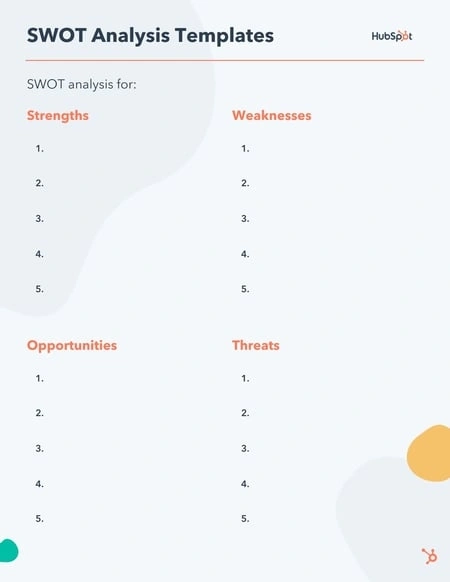
A SWOT (Strengths, Weaknesses, Opportunities, Threats) analysis looks at your internal strengths and weaknesses, and your external opportunities and threats within the market.
A SWOT analysis highlights direct areas of opportunity your company can continue, build, focus on, and work to overcome.
Download a free, editable SWOT Analysis template here.
3. Market Survey Template
Market surveys help you uncover important information about your buyer personas , target audience, current customers, market, and competition.
Surveys should contain a variety of question types, like multiple choice, rankings, and open-ended responses.
Here are some categories of questions you should ask via survey:
- Demographic questions
- Business questions
- Competitor questions
- Industry questions
- Brand questions
- Product questions
Download a free, editable Market Survey template here.
4. Focus Group Template
Focus groups are an opportunity to collect in-depth, qualitative data from your real customers or members of your target audience.
You should ask your focus group participants open-ended questions. While doing so, keep these tips top of mind:
- Set a limit for the number of questions you‘re asking (after all, they’re open-ended).
- Provide participants with a prototype or demonstration.
- Ask participants how they feel about your price.
- Ask participants about your competition.
- Offer participants time at the end of the session for final comments, questions, or concerns.
Download a free, editable Focus Group template here.
1. TikTok uses in-app research surveys to better understand consumer viewing preferences and ad experiences.
If you’re a TikTok enthusiast (like me), then you’ve probably been served a survey or two while you scroll through your For You feed.
TikTok has strategically started using in-app market research surveys to help improve the viewer experiences.
I’ve received two different types of surveys so far.
The first type typically follows a video or an ad and asks how I felt about the video I just viewed. There are options like “I don’t like this ad,” “I enjoyed watching this video,” or “This content is appropriate.”
The other type of survey I’ve gotten asks if I’ve recently seen a sponsored video or ad from a particular brand. For example, “Did you see any promotional content from the Dove Self Esteem Project in the past two days on TikTok?
TikTok can then use this information to tweak my algorithm to match my preferences or to serve ads that are more in line with my buying behaviors.
2. Taco Bell tests new products in select markets before launching nationwide.
Taco Bell is known for their innovative, consumer-driven menu items. In fact, just last year, they gave Taco Bell rewards members exclusive access to vote on the newest round of hot sauce sayings .
This popular fast-food chain puts a lot of menu decisions in the hands of their target market. Taco Bell lovers ultimately determine which new menu items stay on the menu through voting and, ultimately, their purchase behaviors.
(Let’s all collectively agree that the Cheez-It Crunchwrap deserves a permanent spot.)
Often, this process of releasing a new item is done regionally before a nationwide launch. This is a form of market research — soft launching products in smaller markets to determine how well it sells before dedicating too many resources to it.
The way Taco Bell uses this information is pretty straightforward. If the product is not successful, it’s unlikely to be released on a national scale.
3. The Body Shop used social listening to determine how they should reposition brand campaigns to respond to what their customers cared most about.
The Body Shop has long been known for offering ethically sourced and natural products, and proudly touts “sustainability” as a core value.
To dive deeper into the sustainability subtopics that meant the most to their audiences, the team at The Body Shop tracked conversations and ultimately found their audiences cared a lot about refills.
Using this information helped the Body Shop team feel confident when relaunching their Refill Program across 400 stores globally in 2022 .
Market research proved they were on the right track with their refill concept, and demonstrated increased efforts were needed to show Body Shop customers that the Body Shop cared about their customers' values.
Conduct Market Research to Grow Better
Conducting market research can be a very eye-opening experience. Even if you think you know your buyers pretty well, completing the study will likely uncover new channels and messaging tips to help improve your interactions.
Editor's note: This post was originally published in March 2016 and has been updated for comprehensiveness.

Don't forget to share this post!
![market research survey for new business SWOT Analysis: How To Do One [With Template & Examples]](https://blog.hubspot.com/hubfs/marketingplan_20.webp)
SWOT Analysis: How To Do One [With Template & Examples]

20+ Tools & Resources for Conducting Market Research

What's a Competitive Analysis & How Do You Conduct One?

TAM SAM SOM: What Do They Mean & How Do You Calculate Them?
![market research survey for new business How to Run a Competitor Analysis [Free Guide]](https://blog.hubspot.com/hubfs/Google%20Drive%20Integration/how%20to%20do%20a%20competitor%20analysis_122022.jpeg)
How to Run a Competitor Analysis [Free Guide]
![market research survey for new business 5 Challenges Marketers Face in Understanding Audiences [New Data + Market Researcher Tips]](https://blog.hubspot.com/hubfs/challenges%20marketers%20face%20in%20understanding%20the%20customer%20.png)
5 Challenges Marketers Face in Understanding Audiences [New Data + Market Researcher Tips]

Causal Research: The Complete Guide

Total Addressable Market (TAM): What It Is & How You Can Calculate It

What Is Market Share & How Do You Calculate It?
![market research survey for new business 3 Ways Data Privacy Changes Benefit Marketers [New Data]](https://blog.hubspot.com/hubfs/how-data-privacy-benefits-marketers_1.webp)
3 Ways Data Privacy Changes Benefit Marketers [New Data]
Free Guide & Templates to Help Your Market Research
Marketing software that helps you drive revenue, save time and resources, and measure and optimize your investments — all on one easy-to-use platform

- Pollfish School
- Market Research
- Survey Guides
- Get started
Market Research Survey: The Complete Guide

This process involves gathering primary (self-conducted) and secondary (information already researched and made available) sources, to fully assess how a business will fare within a particular market and audience.
A market research survey is typically a source of primary information that businesses can use as part of their market research campaigns. It can also exist as a secondary source, in which case, its studies and results are published online or in a print publication.
This article will take a close look at the market research survey, so that you can use it to the optimum benefit for your business.
What Can you Achieve with Market Research?
A market research survey, as its name entails, is used for research purposes. Before we dive into all the aspects of this survey, it is apt to learn how you can use market research to your full advantage.
Market research is critical for a variety of purposes, including marketing , advertising , and branding campaigns.
Aside from providing data-based support for these macro purposes, market research gains you invaluable insight into particular markets. For example, you may consider running a research campaign for the retail market . Market research will help you gather all the relevant information pertaining to this specific market.
Aside from retail, you can conduct market research in a number of verticals, including ecommerce , technology, real estate and many others.
There are plenty of other applications for market research. Here are some of the ways to use market research to your advantage:
- Observe data to prepare for challenges in advance
- Gauge the demand for your product or service
- Learn key market trends and staples
- Discover how your competitors are winning or losing
- Uncover your target market’s desires, preferences, aversions and thoughts
The final point is remarkably crucial for market research and for generally keeping your business afloat. And so, we’ll now dig deep into the market research survey, as this tool is especially useful for this purpose.
Defining a Market Research Survey
This tool is the most commonly used market research method — and for good reason. A market research survey allows you to gather data on your target market. Moreover, it allows businesses to do so by accessing any insights they need, as long as they form corresponding questions to their investigation.
Surveys have a far-reaching history, as they date back to ancient civilizations such as Greece and Rome. There was a surge in survey use in 1930s America, in which the government sought to understand the economic and social state of the nation.
Surveys have taken up a variety of forms, including analog forms, such as paper and mail-in formats .
Telephone surveys were the medium of choice for survey research during the 1960s-90s. But, as technological advancements would have it, those have declined in usefulness as well.
In the present day, surveys are conducted online, particularly through the use of designated software platforms. This type of software has paved the way for easy access to primary research.
Businesses can use online survey software and tools and to carry out all their survey research (save for creating the screener and questions). Many such tools available both allow you to build surveys along with deploying them.
To reiterate, market research surveys are powerful tools, in that they empower businesses to ask any question they choose to better understand their market and consumer base. They also can offer key insights into competitors.
The Components of a Market Research Survey

This tool contains two major components: the screener and the questionnaire . These form the bulk of the insights your primary research will gather.
There are also two auxiliary components to incorporate to make your survey research successful. These include the call-out (introduction) and the thank you message (conclusion).
Unlike the essential components, the need to use these will vary based on your survey deployment method and campaign. For example, an emailed survey won’t require a call-out, as the email itself serves this purpose.
A web or mobile survey, on the other hand, will need a call-out to get the attention of your respondents.
Here is a break-down of each component, beginning with the essential elements:
- These conditions often deal with demographics, which is incredibly important, as you would need to first and foremost, survey your target market. The screener will ensure it is only your target market that takes part in the survey.
- The screener is often comprised of 2-3 questions.
- The questionnaire should ask all the necessary questions you need for a particular campaign or sub-campaign. Or, if used in a preliminary stage of your market research, they can deal with questions particularly designed to segment your target market.
- If respondents are contacted via email, the call-out is in the email’s body, inviting participants to take it, listing why it’s important, its length and what it’s used for.
- If the survey exists within a website (either as a banner, or button), the call-out is the clickable element itself (the button/banner to the survey). It too should explain the survey to respondents.
- If the survey is on a website/app, the call-out has to be visible and attractive enough for users to notice it and click on it.
- The survey often routes users to another page with a thank you message.
- It’s important, as it lets participants know that their survey has in fact been submitted.
How to Create a Market Research Survey
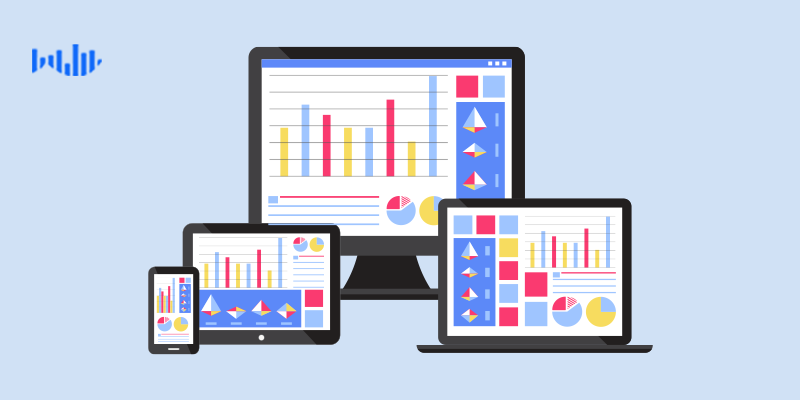
Here are a few steps to take into consideration when starting on a market research survey project.
Step 1: Find a topic your business needs to learn more about.
This is particularly important if it is a topic that has little to no secondary sources. In this case, opting for a survey is the best way to learn more about it firsthand, from the people who matter most: your target market. Pay attention to any problems your business may experience, as surveys should help resolve them.
Step 2: Consider the topic in regards to your target market
When you’ve narrowed down a problem or two, think about your target market. Do you know who constitutes it? If yes, tailor your survey topic into a subtopic that they’ll be most likely to respond to. For example, if your target market is middle-aged men who watch sports, consider whether your problem/topic will be relevant to them.
If you don’t know your target market, you should conduct some secondary research about it first, then perform market segmentation (surveys can help on this front too).
Step 3: Find the larger application of the survey campaign
Now that you’ve settled on a topic/problem and decided on whether it’s fitting for your target market, consider what the parent campaign of the survey would be. Let’s hypothetically say your topic is related to a product. Would a survey on that topic benefit a branding campaign like finding your next slogan? Would it be better suited to settle on a theme for an advertising campaign?
Once you find the most appropriate application or macro campaign to house the survey, your market research will be organized and your survey will be better set up for success.
Step 4: Calculate your margin of error
A margin of error , in simple terms, is a measurement of how effective your survey will be. Expressed as a percentage, it measures the difference between survey results and the population value.
You need to measure this unit, as surveys represent a large group of people, but are made up of a much smaller group. Therefore, the larger the margin of error, the less accurate the opinions of the survey represent an entire population.
Step 5: Create your survey(s)
Now that you’ve calculated the margin of error, start creating your campaign. Decide on how many surveys you would need, in regard to your margin of error and your market research needs.
Start with a broader topic and get more specific in each question. Or, create multiple surveys focused on different but closely related subtopics to your main topic.
Send out your surveys through a trusted survey platform.
Questions to Ask for Various Campaigns
The steps laid out above are part of a simple procedure in developing a market research survey. However, there is much more to these steps, especially that of creating the survey.
Namely, you would need the correct set of questions, as they are the lifeblood of a survey. With so many different survey research campaigns and purposes, brainstorming questions can seem almost counterintuitive.
To avoid information overload and any confusion that creating a survey may incite, review the below question examples. They are organized per campaign type, so you can discern which questions are most suitable for which corresponding research purpose.
Questions for Branding
Branding campaigns include efforts that build the identity of your business; this includes gathering data-backed ideas on logos, imagery, messaging and core themes surrounding your brand. You can use these when embarking on a new campaign, revamping an existing one or when you’re looking to change your brand’s reputation and style.
- Which of these brands do you know?
- What do you like most/least about this brand?
- Which idea is more important? (Use an idea behind setting up your brand’s image/style)
- Which images do you find the most inspiring? (To compare images you’ll use in your marketing/ definitive to your brand)
- What do you like about [brand]? (Can be open-ended)
Questions for Advertising
Using market research for advertising will help you obtain ideas for new advertising campaigns, testing already established campaign ideas and predicting the success of new ones.
- How would you rate the motivating power of this ad?
- Which of the following ads resonate the most with you?
- Do you remember this ad? (Name and image/video of a popular ad within your industry)
- How do you feel after watching this ad?
- What kind of use do you think this product/service produces?
Questions for Comparing Yourself with Competitors
Studying your competitors is often associated with secondary research, but you can gain intelligence on this topic through your own survey research. The great thing about surveys is that you don’t have to focus on one competitor when managing these surveys.
- How often do you use this product/service?
- Which brand do you use for this product/service? (Include one open-ended answer).
- Which of the following products (same kind, different brand) do you find the most useful?
- What about [competitor product] would you like to see change?
- Which brand has improved your life? (Include one open-ended question).
Questions for Market Segmentation

This application is possibly the most challenging, as it involves understanding who your target market already is, then further segmenting it. We understand coming to terms with your target market first, before narrowing it any further down.
Here is how to segment your target market; you’ll notice that the questions are much more granular than the typical questions associated with each topic. (Ex: demographics typically ask for race, age, gender, income, etc).
- Demographic segmentation: Which of the following groups do you identify with most closely? (It can involve anything from music, to shopping habits, to lifestyle choices)
- Geographic segmentation: Which of the following areas do you typically spend time in to make physical purchases?
- Psychographic segmentation: How do you feel about retailers who test their products on animals?
- Behavioral segmentation: How often do you buy this kind of product?
- Sentimental segmentation: How do the following [practices, images, actions] make you feel?
Securing the Most Benefits Out of Your Market Research Survey
As we can deduce from this guide, the market research survey is a critical tool for market research . There is so much to discover about your industry, competitors and chiefly, your customers. But before making any hasty decisions, it is vital to peruse all your research documents, not just the primary research ones, such as surveys.
When you combine primary and secondary research sources, you’re setting up any business move for greater success.
That’s because market research involves studying more than one source. It may appear daunting, but with the right tools, you can design better products, innovate on existing products, appeal to a wider audience and gain more revenue from your marketing efforts.
Thus, pair your market research survey with other research means for a lucrative market research campaign. Knowledge truly is power.
Frequently asked questions
What is a market research survey.
A market research survey is a survey used for conducting primary market research and is the most commonly used market research method. Market research surveys help you understand your target market, gathering data necessary to make informed decisions on content creation, product development, and more.
What are the components of a market research survey?
There are 4 major components in a market research survey. First, we have the callout to get digital visitors to participate in a survey. Next is the screener which determines who is eligible to take the survey based on their demographics information and answers to screening questions. Then, there is the questionnaire—-- this is the heart of the survey, containing a set of open-ended or closed-ended questions. Lastly, there’s the callout. This introduces the survey to respondents. Next, there’s the thank you message. This acts as the conclusion to the survey.
How can you create a market research survey?
Creating a market research survey starts with identifying the topics your business needs to learn more about. Next, you consider topics within the context of your target market and find the larger application of the survey campaign. Calculate your margin of error and then create your survey using online software.
What types of questions should you ask on your market research survey?
You can ask branding related questions to gather information on how your identity of your business is perceived. You can also ask questions that spark ideas for new advertising campaigns. To supplement your secondary research on competitors, ask questions about your business’s place in the industry. Questions can also be used for market segmentation. These are questions on demographic, geographic, psychographic, behavioral and sentimental topics.
How can you get the most benefits out of your market research survey?
You can get the most out of your market research survey by using the correct online survey platform-- one with specific audience targeting for real consumers, radius targeting and quality screening questions-- you’ll get relevant answers from the right audience.
Do you want to distribute your survey? Pollfish offers you access to millions of targeted consumers to get survey responses from $0.95 per complete. Launch your survey today.
Privacy Preference Center
Privacy preferences.
- Business Essentials
- Leadership & Management
- Credential of Leadership, Impact, and Management in Business (CLIMB)
- Entrepreneurship & Innovation
- *New* Digital Transformation
- Finance & Accounting
- Business in Society
- For Organizations
- Support Portal
- Media Coverage
- Founding Donors
- Leadership Team

- Harvard Business School →
- HBS Online →
- Business Insights →
Business Insights
Harvard Business School Online's Business Insights Blog provides the career insights you need to achieve your goals and gain confidence in your business skills.
- Career Development
- Communication
- Decision-Making
- Earning Your MBA
- Negotiation
- News & Events
- Productivity
- Staff Spotlight
- Student Profiles
- Work-Life Balance
- Alternative Investments
- Business Analytics
- Business Strategy
- Business and Climate Change
- Design Thinking and Innovation
- Digital Marketing Strategy
- Disruptive Strategy
- Economics for Managers
- Entrepreneurship Essentials
- Financial Accounting
- Global Business
- Launching Tech Ventures
- Leadership Principles
- Leadership, Ethics, and Corporate Accountability
- Leading with Finance
- Management Essentials
- Negotiation Mastery
- Organizational Leadership
- Power and Influence for Positive Impact
- Strategy Execution
- Sustainable Business Strategy
- Sustainable Investing
- Winning with Digital Platforms
How to Conduct Market Research for a Startup

- 17 Mar 2022
With every innovative product idea comes the pressing question: “Will people want to buy it?”
As an entrepreneur with a big idea, what’s the best way to determine how potential customers will react to your product? Conducting market research can provide the data needed to decide whether your product fits your target market.
Before launching a new venture, you should understand market research. Here’s how to conduct market research for a startup and why it’s important.
Access your free e-book today.
What Is Market Research?
Market research is the process of gathering information about customers and the market as a whole to determine a product or service’s viability. Market research includes interviews, surveys, focus groups, and industry data analyses.
The goal of market research is to better understand potential customers, how well your product or service fits their needs, and how it compares to competitors’ offerings.
There are two types of research you can conduct: primary and secondary.
- Primary research requires collecting data to learn about your specific customers or target market segment. It’s useful for creating buyer personas, segmenting your market, and improving your product to cater to customers’ needs .
- Secondary research is conducted using data you didn’t collect yourself. Industry reports, public databases, and other companies’ proprietary data can be used to gain insights into your target market segment and industry.
Why Is Market Research Important for Entrepreneurs?
Before launching your venture, it’s wise to conduct market research to ensure your product or service will be well received. Feedback from people who fall into your target demographics can be invaluable as you iterate on and improve your product.
Performing market research can also help you determine a pricing strategy by gauging customers’ willingness to pay for your product. Additionally, it can improve the user experience by revealing what features matter most to potential customers.
When assessing which startups to fund, investors place heavy importance on thorough market research that indicates promising potential. Providing tangible proof that your product fulfills a market need and demonstrating you’ve taken the time to iterate on and improve it signal that your startup could be a worthwhile investment.
Related: How to Talk to Potential Investors: 5 Tips
How to Do Market Research for a Startup
1. form hypotheses.
What questions do you aim to answer through market research? Using those questions, you can make predictions called hypotheses . Defining your hypotheses upfront can help guide your approach to selecting subjects, researching questions, and testing designs.
An example question you may ask is: “How much are people in my target demographic willing to pay for the current version of my product?” Your hypothesis could be: “If my product contains all its current features, customers will be willing to pay $500 for it.”
Another example question you may ask is: “What’s the user’s biggest pain point, and is my product meeting their needs?” Your hypothesis could be: “I believe the user’s biggest pain point is needing an easy, unintimidating way to learn basic car maintenance, and I predict that my product meets that need.”
You can and should test multiple hypotheses, but try to select no more than a few per test, so the research stays focused.
Related: A Beginner’s Guide to Hypothesis Testing in Business
2. Select the Type of Research Needed to Test Hypotheses
Once you’ve formed your hypotheses, determine which type of research to conduct.
If your hypotheses focus on determining your startup’s place in the broader market, start with secondary research. This can include using existing data to determine market size, how much of that market your startup could reasonably own, who your biggest competitors are, and how your brand and product compare to theirs.
If your hypotheses require primary research, decide which data collection method best fits your needs. These can include one-on-one interviews, surveys, focus groups, and polls. Primary research allows you to gather insights into customer satisfaction and loyalty, brand awareness and perception, and real-time product usability.
3. Identify Target Demographics and Recruit Subjects
To gather meaningful insights, you need to understand your target demographic. Do you aim to cater to working parents, young athletes, or pet owners? Determine the type of person who can benefit from your product.
If you conduct primary research, you need to recruit subjects. This can be done in several ways, including:
- Word of mouth: The simplest but least reliable way to recruit participants is by word of mouth. Ask people you know to refer others to be research subjects, then screen them to confirm they fit your target demographic.
- Promoting the study on social media: Many social media platforms enable you to show an ad to people who fall into specific demographic categories or have certain interests. This allows you to get the word out to a large number of people who qualify.
- Hiring a third-party market research company: Some companies provide full market research services and recruit participants and conduct research on your behalf.
However you recruit subjects, ensure they take a screener survey beforehand, which allows you to determine whether they fit the specific demographic you want to study or have a trait that eliminates them from the research pool. It also provides demographic data—such as age and race—that enables you to select a diverse subset of your target demographic.
In addition, you can offer compensation to boost participation, such as money, meal vouchers, gift cards, or early access to your product. Make it clear that compensation is in appreciation for subjects’ time and honest feedback.
4. Conduct the Research
Once you’ve determined the type of research and target demographic necessary to test your hypotheses, conduct your research. To reduce bias, enlist someone unfamiliar with your hypotheses to perform interviews or lead focus groups.
Ask questions based on your audience and hypotheses. For instance, if you’re aiming to test existing customers’ purchase motivations, you may ask: “What challenge were you trying to solve when you first bought the product?”
If examining brand perception, your audience should consist of potential customers who don’t yet know your brand. Present them with a list of competitor logos—with yours in the mix—and ask them to rank the brands by perceived reliability.
While the questions you ask are vehicles to prove or disprove hypotheses, ensure they don’t lead subjects in one direction. To craft unbiased research questions , use neutral language and vary the order of options in multiple-choice questions. This can keep subjects from selecting the same option each time if they sense the third option is always mapped to a certain outcome. It also helps account for primacy bias (the tendency to select the first option in a list) and recency bias (the tendency to select the final option in a list).
Once you’ve collected data, ensure it’s organized efficiently and securely so you can protect subjects’ identities .
Related: 3 Examples of Bad Survey Questions and How to Fix Them
5. Gather Insights and Determine Action Items
After you’ve organized your data, analyze it to extract actionable insights. While some of the data will be qualitative rather than quantitative, you can detect patterns in responses to make it quantifiable. For instance, noting that 15 of 20 subjects mentioned feeling overwhelmed when attempting to assemble your product.
Once you’ve analyzed the data and communicated emerging trends using data visualizations , outline action items.
If the majority of users in your target demographic reported feeling overwhelmed while assembling your product, action items might include:
- Creating different versions of assembly instructions to test with other groups, varying diagrams and instructional language
- Researching instruction manual best practices
Each round of market research can offer more information about how your product is perceived and experienced by potential users.

Market Research as an Ongoing Endeavor
While it’s useful to conduct market research before launching your product, you should revisit your hypotheses and form new ones over the course of building your venture.
By conducting market research with each version of your product, you can gradually improve it and ensure it continues to fit target customers’ needs.
Are you interested in bolstering your entrepreneurship skills? Explore our four-week online course Entrepreneurship Essentials and our other entrepreneurship and innovation courses to learn to speak the language of the startup world.

About the Author

How to conduct a market survey that works

- Share on Facebook
- Share on Twitter
- Share on LinkedIn

Knowing your audience is the backbone of success whether you’re a small business or a household name. And to know your audience, you need to do some all-important market research. But what’s the best way to go about doing that? Well, the easy answer is to use our market research platform to get on-demand insights into your existing audience and your potential customers.
But, if you want to take the long route, you could conduct a good old fashioned market research survey yourself.
We’re glad you asked. A market research survey is a way of gaining information, insights, and attributes about your target consumers, so you can better understand them and what makes them tick. These surveys are typically conducted by market research companies . More information means more knowledge, which leads to more understanding – helping drive more successful campaigns.
But market research surveys don’t just help you improve your targeting and create campaigns that have impact. They provide valuable insight into the feelings, attitudes, and preferences of your audience – guiding everything from concept testing and launching new products, to brand positioning and customer satisfaction.
But what does it really take to conduct a market survey that works? Let’s get into it.
1. Set a clear goal 2. Know who to survey 3. Get help from survey-savvy people 4. Figure out the best way to get answers 5. Focus on the execution 6. Understand analysis is the answer 7. Uncover the bigger picture
1. Set a clear goal
Start by setting a clear objective of what you want from your market research. This will be determined by your marketing goals. If you’re launching a new product, for example, you’ll want to know what the demand is, how aware people are of your existing products/brand, if they currently use a competitor, and how frequently they buy.
Be precise about the outcome you’re looking for so you can get the answers you need to nail your future marketing campaigns .
- Why are you doing the survey?
- What do you want to find out from your research?
- Is it for product improvements with an existing audience?
- Are you looking to launch a new product into the marketplace and therefore need to know if there’s sufficient demand?
- Are you looking to improve your customer experience?
Knowing what you want to find out will help you identify what information you need. And it’ll help you determine whether a qualitative or quantitative approach works best.
The aim is to find out what your customers are looking for and improve satisfaction with your brand.
Uncovering consumer attitudes could reveal some invaluable insights that will guide your strategy with the customer at the heart.
2. Know who to survey
Market research starts with identifying which market you’re targeting. Who’s your audience? Are you looking at existing customers? Or are you looking to find out more about potential customers?
Think back to your goal here. Keeping in mind what you’re looking to achieve from your market research can help guide who you survey. For example, if you want to build on your customer offering by introducing a priority service, you may just want to gather information from people living in a certain area or earning over a certain amount.
Use regional data to attain precise information about the target customer whose data you need, and narrow it down to support your ultimate goal.
Determine key demographics of your target audience like where they live, their age, gender, or income bracket. You’ll also need to establish the market size of your target market in order to calculate your sample size.
3. Get help from some survey-savvy people
Who knows about surveys? We do.
We teased this at the start, but turning to an existing, ongoing survey (or multiple) could save you a helluva lot of time – and money. So if you need a faster way to understand digital consumers, we give you an on-demand window into their worlds. All in a few quick clicks, in one reliable audience insights platform.
GWI data spans 53 markets and represents over 2 billion internet users, making it the world’s leading market survey on digital consumers.
We provide a level of detail you can’t find elsewhere. Survey research is tricky. So why not leave it to the market research experts? And if you want something super bespoke for your business needs, our Custom research offering might be just the thing.
4. Figure out the best way to get answers
Cast your mind back to steps 1 and 2. Thinking about who you’re looking to survey and what you’re looking to gain will help determine how you get those answers from the right target market.
Knowing the difference between primary research and secondary research, as well as qualitative and quantitative, can go a long way to helping you figure out the best approach.
For example, primary market research is where you gather data that hasn’t been collected before – it’s new, essentially. You can gather primary research via surveys or observations. On the other hand, secondary market research is where you gather data that’s already been collected or conducted before by other people. You can find secondary research in published reports or studies.
Surveys can be carried out in a number of ways, no longer exclusive to telephone surveys and focus groups. The online survey is another option that allows you to take a step away from the time-consuming paper survey. You can also conduct market research in groups or on an individual basis.
Once again, the optimum approach for your brand will depend on your goals and the information you’re trying to capture, as well as your target audience, market share potential, and overall preferences.
If you want to gather in-depth information from Gen Z , for example, you might want to head over to Instagram. With 28% of Gen Zs saying that Instagram is their favorite social media platform, you’re most likely to find them scrolling here where you can try out polls to get answers, and ask follow-up questions that dig a little deeper.
Using quantitative panel data to back this up, market researchers can come away with powerful insights and market analysis they can trust.
5. Focus on the execution
Once you’re clear about your goals, the data you want, the people you need to talk to, and the best way to gather your survey data, it’s important to maximize the sample size.
This means reaching people at the right time, checking out where they’re likely to be, and setting a realistic timeframe for them to share their thoughts.
You’ve got to really keep your target audience in mind here. If you’re physically interacting with people, think about the places they’re likely to visit, and at what times they’ll be there. There’s no use setting up camp at the mall on a weekday if you’re looking to talk to corporate big fish.
If it’s an online survey, understanding which social media platforms or websites they are likely to hang out on, and at what times they tend to be online is vital to getting those survey form completion numbers to hit the high notes.
Conducting some data analysis ahead of the survey can go a long way in helping make the survey easier to reach the right audiences. Take the guesswork out of your marketing research.
6. Analysis is the answer
Once you’ve gathered your market survey responses, they need to be analyzed thoroughly to pull out key trends and findings to allow you to gain some tasty, actionable insights from the data. So, what do you need to be looking at?
- Examine qualitative answers for stand-out quotes and detailed feedback about attitudes and behaviors
- Calculate averages from your quantitative answers
- Compare your results against global and local secondary market research
There are plenty of ways to cross-examine and analyze your market research data based on the type of data you’ve collected and what you’re looking for.
7. Uncover the bigger picture
Conducting a single market research survey is invaluable to brands, but when carried out in isolation, market research can lack real-world relevance.
To get more from your analysis, large-scale market survey data allows you to compare your findings across multiple data points. You can cross-reference it with local subgroups and compare against global averages to clearly see where the value truly lies.
Use case: Identifying affluent consumer behaviors on social media
Here’s a hypothetical example. Let’s say you sell a luxury product. You’ve identified from your own survey results and analytics that social media is prominent in your customers’ lives.
But you need more detail to target high-earners on the channels where they’re most active.
By using a deep data set to dig down into their activity on social media, you can uncover exactly where they spend their time:

Combining this with questions designed to reveal their motivations for using social media takes your understanding to the next level:

Here, 30% of affluent consumers follow/subscribe to companies and brands they purchase from, so we’re more inclined to say they can be targeted with a good social media strategy from brands to be enticed into buying from them.
Uncovering insights like this is key to delivering a well-positioned message that sticks.
Now, you can create a campaign specifically targeted to hit your ideal target market, where they hang out and in a way that speaks to their interests.
Market research surveys are pivotal to success
Market surveys can be used in a variety of ways to help a brand focus more on its target audience and take a more people-based approach.
You can use it to get a better understanding of the perceptions around your brand, test the appetite for a new product, and find customer demographics to accurately pitch an ad campaign. A marketing research survey enables you to gather information about your audience and help to build a buyer persona for each sector of your target audience for more personalized, effective marketing strategies.
Data holds the answers you need to achieve almost every business goal.
But data is powerless without effective analysis. And without effective analysis, no insights can be drawn. So it pays to have third-party survey data sets at your disposal to contextualize your findings. A skillfully-planned market survey that catches customer feedback and experience will deliver findings that could spell the difference between success and failure in a marketing strategy. Leveraging GWI’s data platform means getting clued up on your audience fast, and making decisions you can stand behind.
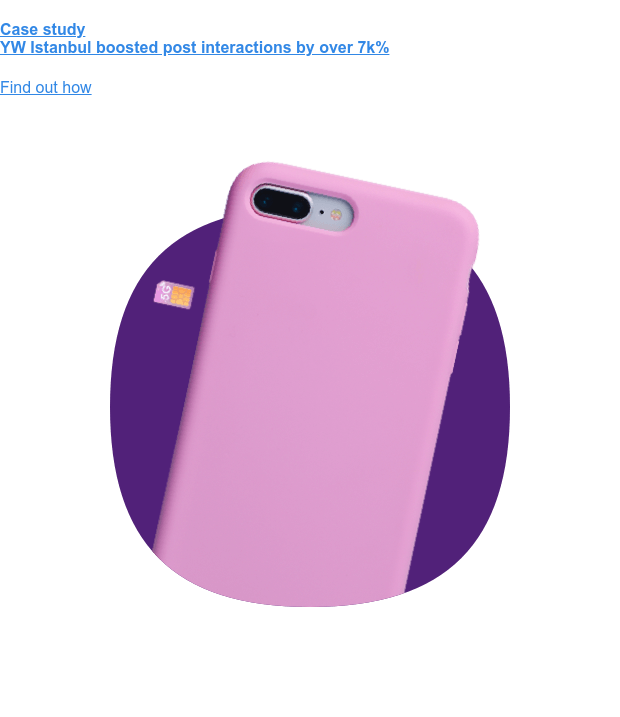
Never miss a post
By subscribing you confirm you’re happy for us to send you our latest articles.
You’ve read our blog, now see our platform
Every business has questions about its audiences, GWI has answers. Powered by consistent, global research, our platform is an on-demand window into their world.

Market Research Surveys: Sample Questions + Template

Sample Questions
- Creation Tips
- Types of Data
- Employee Feedback
- Creating the Survey
- Identity Protection
- Research Tools
Create your own survey using a MaxDiff question and more!
Definition: Market research surveys are a tool used to collect information about a target market. These surveys allow businesses to understand market needs and preferences.
Your company can offer better products or services by understanding your target market. Often, market research surveys will also include questions about competitors. Competitor data help paint the complete picture of your target market.
Depending on your goal, you want to include different question types in your survey. Here are three general categories of question types to include:
- Customer demographic questions
- Product/service questions
- Company/brand questions
Customer Demographic Questions
These questions will help you to understand your audience better. In addition, this data can be used to create market segments.
- What is your age range?
- What is your marital status?
- What is the highest level of education?
- What is your monthly income?
- Which of the following online retailers do you use most often?
- How many hours a week do you spend doing [task]?
- How did you find our company?
Product or Service Questions
When researching a product or service, you want to find out what attributes customers find most valuable in addition to a proper price point. MaxDiff will help you determine what is least and most important for this type of research, while Gabor Granger and Van Westendorp will help you find the optimal price points.
Important note: Don’t ask customers what they would pay for a product or service using an input box. The data will be unreliable. Instead, we recommend using a Gabor Granger question to determine optimal price; this question mimics real-world buying decisions where random price points are evaluated.
Asking about competitors is also essential when drafting product or service questions. Understanding the competition will help your own company build better offerings.
- Of the following features, which are LEAST and MOST important to you?
- Does this product help solve your problems?
- Is there any feature you wish a competitor offered?
- Was our product easy to use?
- How would you evaluate the following price points when purchasing this product?
Company/Brand Questions
When asking questions about your company or brand, the key focus should be on asking the Net Promoter Score question. This question asks, “How likely is it that you would recommend this company to a friend or colleague?” with options from 0 to 10. The overall score will range from -100 to 100 and can be benchmarked against other companies.
Some additional questions in this area could include the following
- Do you understand what our brand stands for?
- Of the following terms, which do you associate with our brand?
- When thinking of a new [product] to buy, which of the following brands first comes to mind?
Tips to Create a Great Market Research Survey
Create an objective:.
Once you get the data, what actions will you take with it? For example, do you want to research features or pricing? Whatever the objective is, make sure it is clear. This will ensure the right questions are asked to gather valuable data.
Determine How to Collect Responses:
Do you have a customer list or want general consumers’ opinions? We recommend using your own customers as a starting point for market research surveys. Then you can add in a targeted survey panel to grab more general consumer opinions.
Here is a sample size calculator to determine your needed sample size. This data will enable you to know how many responses you need to collect based on the overall population you are studying.
Use Crosstabulation:
To spot hidden trends and relationships, use cross-tabulation . For example, you could create a cross-tabulation report for a MaxDiff question with gender. Then you can see what product each prefers features. This can be used for marketing or to decide what target market would be more profitable.
Keep Your Survey Short:
No one wants to be overwhelmed. A study by Survicate found that surveys with 1-3 questions had an 83% response rate. Use skip logic to hide irrelevant questions from users that do not meet specific criteria.
Offer Incentives:
Offer incentives! Offer respondents a discount if they take your survey. This will help drum up new business and ensure you can collect the data you need.
Why Use Market Research Surveys?
Research a target market:.
Your target market is the consumers who would find your product or service most helpful. So first, create a survey to discover opinions on a product or service and respondent demographics such as age, income level, or education level. You can segment your results from here and find out what characteristics make up your target market.
Market Segmentation:
Now that you know your general target market, a more specific group of those people is known as a segment. With the dealership example, maybe you realize consumers in your area and target market love Audi but hate BMW. Luxury cars and people of the same income level drive them, but this difference in product preference is a segment. Knowing this is key to offering the correct brands or prices.
Competitor Analysis:
Often called SWOT analysis (strengths, weaknesses, opportunities, threats), analyzing your competition is key to gaining market share. Go directly to consumers and ask about their opinions on competitors. Ask questions about what they do well or what you do well. Your survey results will help you identify opportunities for growth or ways your company needs to change to stay competitive.
Product Launches:
Does your product meet your customers’ needs? Sending an online product survey to customers will help you gain insights that drive improvements, consumer satisfaction, and ultimately, sales. When measuring the importance of product features, remember always to include a MaxDiff question.
Types of Market Research Data
Of course, surveys are only part of market research. You might be able to shorten your survey if you can collect data from other places first.
Primary Information (aka Field Research):
Primary market research is information YOU collect specific to your objective. This type of information is most often collected via surveys! For example, you might want to open up an arcade in a small town in the United States. You can send out a survey to a sample of the town’s residents to get demographic information and if they are willing to visit your arcade.
Secondary Information (aka Desk Research):
Secondary market research is information YOU DO NOT collect specific to your objective. This type of data is already available to you in public government databases, journals, publications, or even Google! For example, let’s say you were interested in starting your luxury car dealership. You could look at government census data for income levels for your target market before conducting your detailed research. Secondary information should help narrow down what preliminary information you need to collect.
ABOUT THE AUTOR
Allen is the founder of SurveyKing. A former CPA and government auditor, he understands how important quality data is in decision making. He continues to help SurveyKing accomplish their main goal: providing organizations around the world with low-cost high-quality feedback tools.
Ready To Start?
Create your own survey now. Get started for free and collect actionable data.

Business Process Improvement Consulting: Expert Solutions
Definition: A business process improvement consultant will help design and implement strategies to increase the efficiency of workflows across your o...

8 Excel Consulting Services to Use in 2024 + VBA Support
These 6 Excel consulting firms offer support, training, and VBA development to help you automate tasks and increase efficiency when using Microsoft Ex...
9 Great SurveyMonkey Alternatives to Use in 2024
Discover alternatives to the most popular online survey tool, SurveyMonkey. Gain an understanding of where SurveyMonkey lacks in features and get intr...
9 Survey Tools for Academic Research in 2024
These nine survey tools are perfect for academic research because they offer unique question types, solid reporting options, and support staff to help...

7 Great Qualtrics Alternatives to Use in 2024
These seven alternatives to Qualtrics offer either more features, a lower cost, or a cleaner user interface. These alternative platforms also include ...

Union Negotiation Consulting: Planning Labor Agreements
A labor union negotiation consulting engagement involves quantifying member needs, proposing contract language, and developing communication strategie...

Creating a Transactional Survey: Examples + Template
Definition: A transactional survey captures customer feedback after a specific interaction, referred to as a touchpoint. This survey type provides dir...
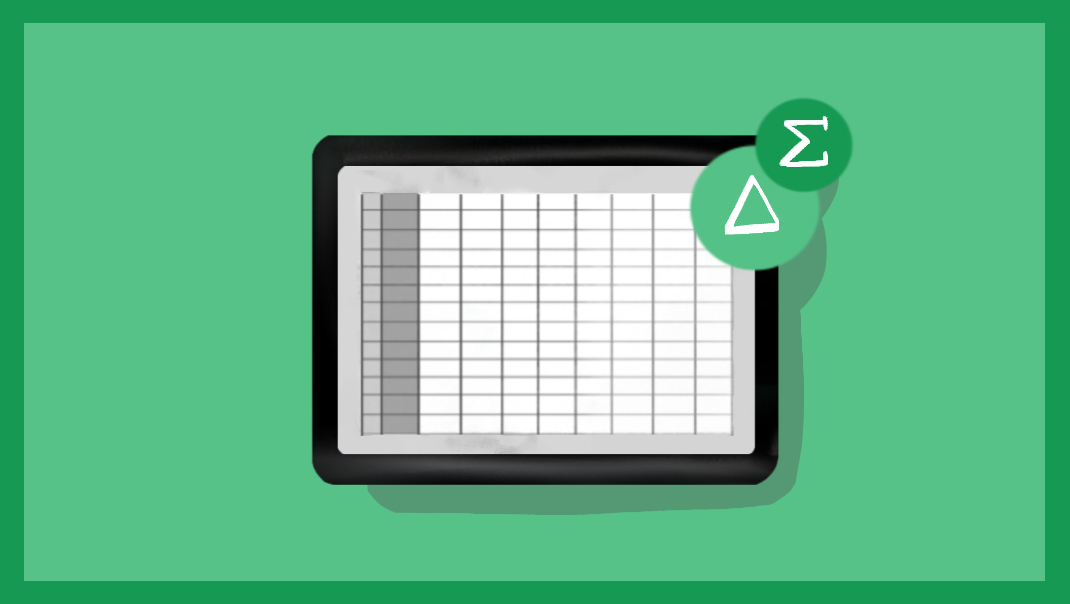
Hire an Excel Expert: Automation + VBA Development
An Excel expert will help you to complete your projects within Microsoft Excel. A good Excel expert should be proficient in advanced formulas such as ...

Creating an Anonymous Employee Survey + Template, Sample Questions
Definition: An anonymous employee survey is a convenient way to collect honest feedback in the workplace. The survey can either measure employee satis...
Improving Fleet Performance Through Driver Feedback Surveys
In the US, the trucking industry generated $875.5 billion in gross freight revenues, accounting for 80.8% of the country’s freight invoice in 20...
13 College Study Tips to Use in 2023
These 15 college study tips will help you succeed in your academic career.
Maximizing the Value of Skills Assessment Tools Using Surveys
When you apply for a job, it’s only natural that you’ll aim to present the best possible version of yourself. You’ll focus on your best skills a...
Creating UX Surveys: 6 Tips and Examples
UX surveys are used to help create a great user experience. A good UX survey will incorporate a variety of question types to help understand what user...
5 Web Consultants to Use in 2023: Design + Development
Definition: A web consultant can update an existing website design, create a custom website, help increase traffic, recommend layout changes, and even...
Creating a Targeted Survey: Panels to Reach Your Audience
Definition: A targeted survey is used to research a specific audience, frequently utilizing a survey panel provider. A paneling service generally has ...
8 Typeform Alternatives to Use in 2023
These seven alternatives to Typeform offer a lower cost or additional features. In addition, these alternative platforms include question types that T...

6 Ecommerce Skills For Professionals + Students
Ecommerce has occupied its leading niche in the world, allowing us to draw certain conclusions. For example, it is not surprising that more specialize...
Ecommerce Analytics Explained + Tools to Use
Definition: Ecommerce analytics is the practice of continuously monitoring your business performance by gathering and examining data that affects your...
Planning a Survey: 6 Step Guide + Best Practices
Planning a survey involves six steps: Set objectives, define the target audience, select the distribution method, organize external data, draft the su...
4 Survey Consulting Services to Use in 2023
Definition: These 4 survey consulting services offer planning, design, development, and support to help complete your survey project. Whether it’s f...
Excel Automation Explained: VBA Code + Sample Workbooks
Definition: Excel automation will streamline repetitive tasks such as updating data, formatting cells, sending emails, and even uploading files to Sha...
Hire a Financial Modeling Consultant: Forecasts + Valuations
Definition: A financial modeling consultant will provide expertise in planning budgets, generating forecasts, creating valuations, and providing equit...
Excel Programming Services: Development, Macros, VBA
Definition: An excel programmer can be hired to organize workbooks, create custom formulas, automate repetitive tasks using VBA, and can consult on h...

What do Americans Value Most in the Coming Election? A Comprehensive and Interactive 2020 Voter Poll
SurveyKing set out on a mission in the fall of 2020, to poll American's and help identify, with quantifiable data, what issues american are most focus...
Get Started Now
We have you covered on anything from customer surveys, employee surveys, to market research. Get started and create your first survey for free.

18 Ways to Use Market Research Surveys

A market research survey is a tried and tested tool to help you uncover vital intel about consumer sentiment, something any business can benefit from. In a perfect world, we’d know exactly what people want, think, and feel about our products and company all the time. Sadly, it’s neither feasible nor realistic. And that’s ok.
With the best products, messaging, and delivery, there’s always room for improvement. And even when you get it just right, market and consumer behaviors can shift at a moment’s notice.
Enter market research surveys – the most favored and widely used qualitative research tool there is right now.
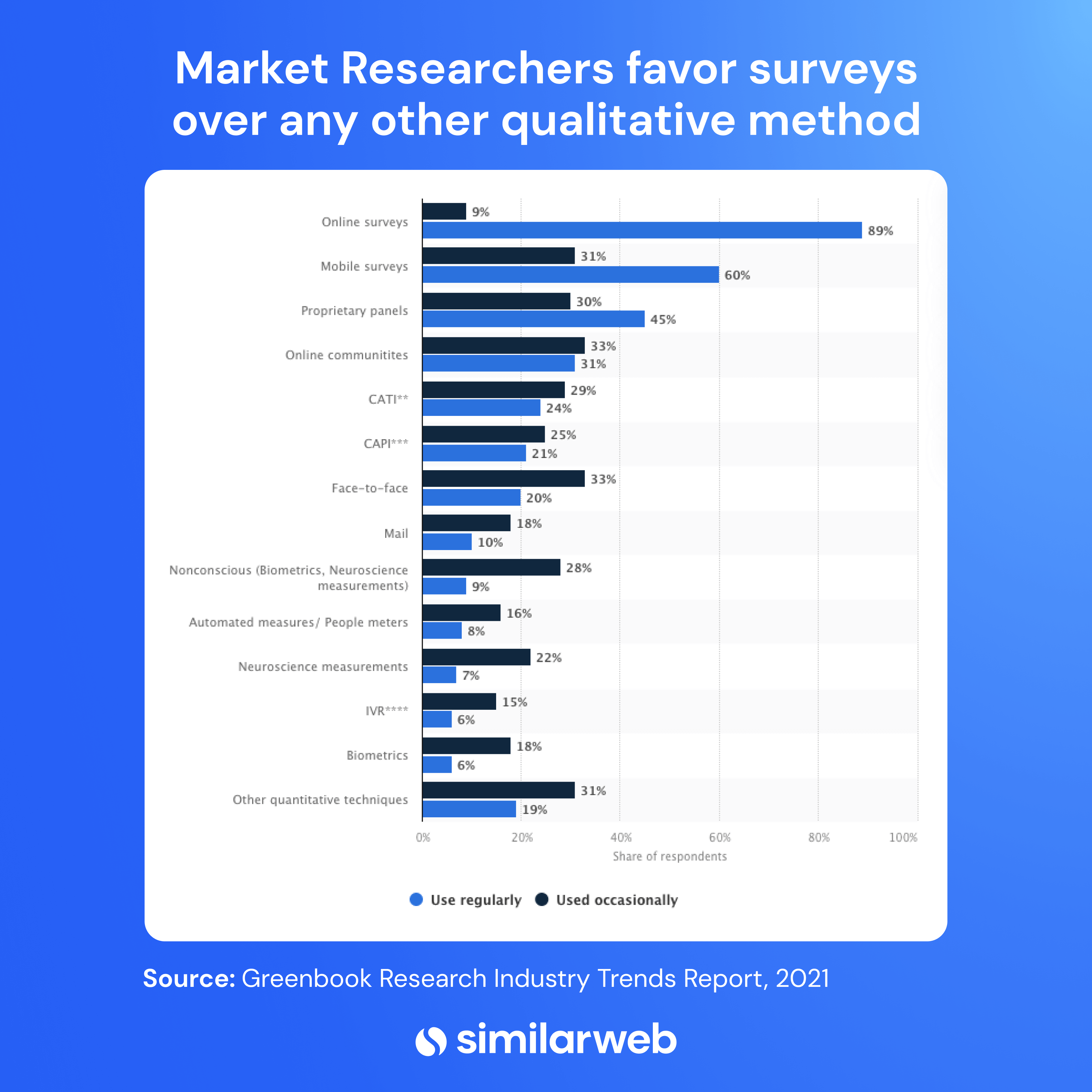
A market research survey is a qualitative research method used to gather feedback from a person or group. It provides vital insights that support strategic decisions , allowing organizations to analyze and understand consumer behavior or motivations in more detail. Responses are collected in various forms, such as paper, in-person, mailings, or online.
What information can a market research survey tell you?
Market research surveys collect feedback from individuals by using a range of questions to find out about things like:
- Characteristics
- Preferences
- Motivations
- Needs & Demands
What are the benefits of market research surveys?
Here’s the top five advantages of using online market research surveys:
- Quick to set-up
- Easy to create
- Immediate feedback
- Extensive reach
“As a business that provides market research survey tools, our mission is to help companies collect crucial information so they can understand the people’s opinions, behaviors, and knowledge of specific industries, products, and services. Data collected through market research surveys are essential for making decisions about product development, marketing strategies, and business operations.”

Market research survey uses and types in action
Market research surveys are both valuable and versatile . But many organizations fail to realize their true potential; and don’t always extract the maximum ROI. Here, I’m sharing 18 different ways to use online surveys.

1. Measure customer satisfaction
Market research surveys are an ideal way to measure and obtain feedback about customer satisfaction ; they’re often referred of CSAT (Customer Satisfaction) surveys, indicating what consumers like and dislike. They also allow organizations to keep track of their Net Promotor Score (NPS). Typically, these surveys ask questions to uncover insights about a service, product, or experience. Sending timely feedback surveys to help resolve issues before they become a problem , giving you the chance to transform a poor experience into a good one.
Here’s three examples of typical questions asked in customer service surveys:
- Please rate the service you received when you visited our store today – Availability of staff (1-5) – Staff knowledge (1-5) – Friendly and helpful attitude (1-5)
- Were you recommended any additional products or services? (yes/no)
- If we could improve one thing about your experience at our store today, what would it be? (open text)

2. Do opinion polling
A great way to gather mass consensus from a large group of people. Typically, they’re short and sweet, asking just 2-3 questions. It’s one of the fastest ways to establish public opinion on a chosen topic. There are three types of opinion poll surveys you can use. They are:
- Rating – Usually a sliding scale between 0-10.
- Multiple choice – This offers three to five- options to choose from (always include ‘other’ as one of these with a free text field to uncover insights you might not have considered).
- Free text – Useful, but a little prohibitive if used too much. It’s important to balance the use of this option with quick and easy ratings and checkbox formats.
Here are three examples of opinion polling survey questions:
- What is the main reason you are attending the event?
- Do you like the changes to the lunch menu?
- What would be your ideal work setup? Office, WFH, or Hybrid?
3. Conduct audience research
Also known as buyer persona surveys, use them to better understand who your customers are, their motivations, and demographics . The results allow you to develop better value propositions and create more informed marketing campaigns that convert better and drive revenue.
Here are a few examples of audience research survey questions:
- Which social sites do you look at most?
- How often do you check your emails?
- How much research would you do before making a buying decision?
- Which search engine do you use most?
- What information formats do you most engage with?
- What tools do you use most in your daily work?
4. Automate testimonials & reviews
Testimonials can build a boatload of authority and buyer confidence. 85% of people trust reviews from strangers as much as peers, making them one of the most valuable forms of content. Automate the process, sit back, and watch the feedback roll in. During set-up, use a mix of rating-based questions and open-text fields. Once collected, they’ll support brand awareness , boost credibility, and assist with other marketing-related activities.
5. Measure employee satisfaction
It’s no secret that happy employees are more engaged and productive . According to research, happiness makes us about 12% more productive . On the flip side, low morale or job dissatisfaction can harm an organization’s reputation, culture, and bottom line. Surveys are a low-cost, effective, and easy way to measure employee satisfaction . You can also use them as exit interview surveys, a must for any business of any size.
Pro Tip: To surface any drivers of employee dissatisfaction, people need to know they can be brutally honest and open with their responses; anonymity in the survey is the only way to achieve this.
6. Validate product development ideas
Online surveys are a great way to validate whether or not a new product idea is worthy of investment. It can help you quantify demand by asking direct questions about specific features or concepts you are considering. Within our own business, we review new products or feature ideas internally and then validate their impact and potential with customers in the same way. Simply put, a quick research survey can uncover vital intel that shapes the what, how, and when to enhance your offering.
7. Measure lead generation effectiveness
Research surveys can help determine the efficiency of your lead qualification process . In short, they can measure and track how well a sales team is doing and assess things like timeliness, follow-up activities, and more. The information helps organizations find new ways to improve the management of lead generation activities and take actions that directly impact conversions in the future.
8. Improve market segmentation
Market surveys for better understand customers can help you better understand customers and prospects. With this, you can separate customers into smaller groups based on interest, demographics , geography , usage, or brand preferences. This gives you the ability to do more targeted marketing and a clearer view of why people in a specific group have or haven’t done business with you.
Segmentation survey example: A spa owner could use segmentation to group clients based on their treatment type or specific brands or products they prefer. They’re then able to offer specific promotions that involve the cross-pollination of products and services. This is just a single example; the possibilities are endless.
9. Qualification of pricing models
Surveys help you qualify any initial work on pricing new products or services. They can provide a clear indication of price ranges to consider and in some cases, give insights that shape pricing models and strategies that better serve the needs of different groups in a market. For demand analysis, these surveys are designed to determine if prices are set too high or too low.
10. Choose the right create assets
Establishing what types of creative assets most appeal to a target audience saves time and money while increasing the potential for success . For example, suppose you’re considering a few different titles for a major email campaign or trying to decide between a physical billboard campaign vs. digital marketing. In that case, a targeted survey can give you a general inclination of what will or won’t work.
Even with a sample network to target, you can get valuable insights to help you prioritize resources.
11. User experience
User experience (UX) surveys are one of the most important things you can do when designing or improving a product or service. The key to success is crafting an unbiased UX survey that enables people to freely open up about their preferences and attitudes. The questions you ask will be largely determined by what you want to achieve. User experience surveys can take place live from within an app or on a website, but can be confused with usability testing; a method that evaluates how easy a product is to use by testing it with actual users.
Here’s a few tips to get you started:
- Ask the right questions:
- Avoid using closed questions (yes/no) as they’ll often not provide usable intel about a customer’s mindset
- Use task-driven questions like ‘can you tell me more about your experience using our mobile app to make your booking?’
- Ranking questions, like ‘how would you rate the ease of booking via our app?’
- Avoid leading questions to avoid bias, like ‘if you enjoyed this product, should we create more like it?’
- Keep your survey short, clear, and simple – no more than eight questions is ideal.

12. Conduct a competitive analysis
You can use market surveys to get a quick taste of consumer appetites for a rival’s product, marketing efforts, and pricing. Here, I’ve highlighted three areas, along with specific questions to gather telling feedback about your competitors.
Where a market survey delivers value is by asking focused questions about sentiment and perception. Questions like:
- Do you perceive company x’s products to be high-quality or low-cost vs. our own?
- Do you find x feature valuable or not?
- Would you be prepared to pay more for a new feature that does x, y, or z?
Here’s a few questions you can ask:
- Which channels do you prefer to interact through, phone, app, live chat, etc.?
- What made you decide to purchase with us vs. a competitor?
- Do competitors offer promotions that would compel you to buy from them over us?
- What would deter you from buying x product from a competitor?
Enables you to clearly see which assets people respond to most positively. Aside from using a rival’s website to see their latest marketing campaigns, look at social media too. Do your competitors have a mobile app?
- If so, then you need to download it and experience things from your customer’s perspective.
- If not, do a survey to find out whether there’s an appetite for this or not?
Pro Tip: Use market research surveys to show your target demographic a selection of marketing materials from different competitors; ask them which they prefer and why, but make sure you remove their branding to avoid bias.
Here’s a few good questions to ask:
- How does this ad make you feel?
- Would you be more or less likely to buy if you saw this?
- What perception of the company or product do you have after seeing this ad?
Using surveys for competitive market research is just one of the many methods of gaining market intelligence to stay informed and gain market share . Surveys take time, and you need to consider how you tap into audiences that are aware of your rival’s offering and your own. Here’s a link to an article with some competitive analysis examples to help you find other ways to do this.
13. Monitor and track brand perception
Good brand perception can do wonders for your business. If people believe in your brand, it can open doors to new partnerships, boost buyer confidence, and make launching products easier. Brand tracking surveys give you a low-cost, effective way to monitor and benchmark brand perception regularly. Run them quarterly to get trackable results, and use a sliding scale, allowing people to indicate whether they’re more or less interested in specific products, features, or services.
Pro Tip: Brand tracking surveys aren’t just for customers and prospects, but employees, partners, and other stakeholders. Make sure your distribution accounts for this.
14. Analyze purchase or intent analysis
The consumer decision-making process typically consists of five stages, sometimes more.

Taking time to understand purchase intent allows you to capitalize upon and generate future demand for products, uncovering key drivers behind consumer intent. As a result, you can build more effective campaigns based on genuine consumer patterns; and discover what drives consumers to move from interest to purchase.
Different types of questions can be used to measure purchase intent. Always consider the objectives of your survey first before selecting the questions you’re going to ask; the format of the question will directly determine the type of information you yield.
Scale survey questions
These are used to determine feelings and opinions. For instance, to determine the likelihood of a future purchase from a specific set of customers, you can present respondents with a statement like this.
Q. I will probably purchase a new walk-in shower in the next 12 months
- Strongly agree
- Neither agree, nor disagree
- Strongly disagree
Ranking questions
Enable you to understand a service or product’s popularity. These are used more so in the early stages of a purchasing journey and can tell you how you compare with competitors, and which products most appeal to certain groups of people.
Q. Rank the following walk-in shower brands in order of preference
Rating scale questions
Use a numerical scale (usually 0-10) that allows respondents to rate the likelihood they’ll choose your offering over a rival.
Multiple-choice questions
These are the most widely used survey question type because they’re quick and easy for people to answer. They can help you establish purchase timeframes, which ties into demand and sales projections. An example of this could be:
Q. When do you expect to buy a new walk-in shower?
- Within 3 months
- Within 6 months
- Within 12 months
- I have no plans to buy a walk-in shower in the near future
Feedback from a survey question like this means your sales division can turn its attention to prospects who indicate they’re likely to purchase in the near future.
15. Discover factors that impact customer loyalty
Customer loyalty surveys tell you ‘why’ people love you or leave you, providing a valued measurement for your NPS. Using surveys for loyalty purposes lets you translate raw data into actionable insights that shape future strategies, campaigns, and messaging.
Here are a few examples of questions to ask in a customer loyalty survey:
- How likely are you to continue using our services?
- On a scale of 0-5, how satisfied are you with our company?
- Do you deal with any other companies for a similar product or service?
- How do you rate the value we offer for the money you pay?
16. Do B2B market research
The global B2B eCommerce market is growing , so much so that it’s expected to reach over 25 trillion by 2028. Needless to say, having effective tools to help with B2B market research is key. Market research surveys are a quick and easy way to target a large group of people at a low cost.
Here are a few ways to use B2B market research surveys, with sample questions included:
- Demographical information – Who are your target customers? – What is your line of business? – How many employees does your company employ? – What is your position at the company?
- Need vs. demand data – Does your business ever buy x products? – Do you use any apps or tools to boost productivity? – Who is the person responsible for buying x products? – Where do you go if you’re looking to buy x?
- Buying pattern insights – What’s the most important feature when buying promo products for your customers? – What motivates you to spend more money buying from a new vendor? – What business issues motivate you to invest in new products or marketing campaigns?
17. Measure advertising effectiveness
Conversion and click-through rates are widely regarded as the best way to measure advertising effectiveness. The often-forgotten about survey tool is another way to test how strong or relevant your ads or messaging is. The results can give you deeper insights that help you shape future marketing efforts for better results.
Here, you’re looking to find out:
- How much an advert motivates people to purchase?
- Are they memorable?
- Did customers understand them?
- What do customers think or feel about a specific slogan or tagline?
Pro Tip: You can also use this type of survey to uncover how people think about your ads vs. those of your rivals.
18. Improve content marketing strategy
Online surveys are a lesser-known but highly valuable tool to enhance your content marketing strategy . Instead of simply crunching the regular performance metrics, develop a quick online survey to gauge feedback from your content VIPs (your audience). It gives you the chance to connect with your readers, show them you care , and ensure your content efforts exceed expectations.
The questions asked should address experiences, likes, dislikes, and preferences. Ask about their preferred content formats, and find out if they’d like to hear more or less about a theme or topic. Another easy way to do this is by adding a rating score at the bottom of an article that asked people if they found it useful, or not.
Read more: this article outlines 99 market research questions you should be asking, some are for you, others for your customers.
Best Online Market Research Survey Tools for 2022
We’ve all likely heard of names like SurveyMonkey, Typeform, and Qualaroo, either from personal experience or through marketing. One thing that surprised me was the sheer volume of tools for online surveys; far too many to list here (48 and still counting).
For now, here are nine of the best.
- SurveyMonkey
- Branded surveys
- Google forms
Wrapping Up
There’s no doubt that a well-constructed market research survey can be golden for your business. But, there are now more efficient ways to gain insights into most of the same things I’ve covered in this post. Similarweb Digital Research Intelligence is a great example of this in action.
Features like website demographics , search keyword analysis , market analysis , audience interests , industry analysis , segment analysis , and competitive analysis are just a few relevant places where you can uncover instant insights to help you shape strategic decisions around marketing, growth, and product development.
Enjoy 360 Visibility 24/7
Get the data you need to adapt to market changes and industry trends in an instant.
Further Reading:
- Market Research Tips Straight From the Experts
- Get Growing with Small Business Market Research
- 7 Highly Successful Market Research Examples
- The Complete Guide to Desk Research
- Market Research Trends to Conquer 2022
- 64 Market Research Questions You Should Be Asking
How do you choose which type of market research survey to use? Answer these questions to determine the best type of survey to use:
- Size of the survey base – how many people are you likely to survey? (monthly/yearly)
- How many times will you conduct surveys? (monthly/yearly)
- What format will you use? (Online, telephone, in-person, paper)
What are the things to consider before doing a market research survey? Note down what you want to achieve, and consider the type of structure you will use to collect responses. For instance, surveys can be based on ratings, rankings, open text, or a mixture of all three. Another consideration is anonymity and whether you will offer an incentive to participants who take the survey.
Should you incentivize market research survey participants? If you’re surveying a niche market or audience, and their input is of high value, or you have a survey that’s more than 5-minutes to complete, you might want to offer an incentive to encourage a response. It’s now considered common practice to offer incentives via promotional codes, PayPal credits, or charitable donations to entice participation.
Can you automate market research surveys? Automating market research surveys is the best way to ensure relevant questions are asked at the right time. Specifically for surveys about customer satisfaction, testimonials, and reviews, these are very easy to automate and quick to set up.
Is a market research survey the same as market research? Market research surveys are a type of qualitative research, which is one type of market research method.
Related Posts

From AI to Buy: The Role of Artificial Intelligence in Retail

How to Conduct a Social Media Competitor Analysis: 5 Quick Steps

Industry Research: The Data-Backed Approach
Wondering what similarweb can do for you.
Here are two ways you can get started with Similarweb today!

Just one more step to your free trial.
.surveysparrow.com
Already using SurveySparrow? Login
By clicking on "Get Started", I agree to the Privacy Policy and Terms of Service .
This site is protected by reCAPTCHA and the Google Privacy Policy and Terms of Service apply.
Enterprise Survey Software
Enterprise Survey Software to thrive in your business ecosystem
NPS Software
Turn customers into promoters
Offline Survey
Real-time data collection, on the move. Go internet-independent.
360 Assessment
Conduct omnidirectional employee assessments. Increase productivity, grow together.
Reputation Management
Turn your existing customers into raving promoters by monitoring online reviews.
Ticket Management
Build loyalty and advocacy by delivering personalized support experiences that matter.
Chatbot for Website
Collect feedback smartly from your website visitors with the engaging Chatbot for website.
Swift, easy, secure. Scalable for your organization.
Executive Dashboard
Customer journey map, craft beautiful surveys, share surveys, gain rich insights, recurring surveys, white label surveys, embedded surveys, conversational forms, mobile-first surveys, audience management, smart surveys, video surveys, secure surveys, api, webhooks, integrations, survey themes, accept payments, custom workflows, all features, customer experience, employee experience, product experience, marketing experience, sales experience, hospitality & travel, market research, saas startup programs, wall of love, success stories, sparrowcast, nps benchmarks, learning centre, apps & integrations.
Our surveys come with superpowers ⚡
Blog Customer Experience

The Beginner’s Guide to Market Research Surveys
Kate william.
7 September 2023
Table Of Contents
- A Guide to Market Research Surveys
- An Overview
Types of Market Research Surveys
- Tips and Tricks For You
Launching a product or service without conducting market research surveys can be an expensive mistake.
It’s not just about having the right product; it must also launch at the right time in the right location to reach its target audience. Just imagine Mark Zuckerberg writing an iconic book, “How to Become a Tech Billionaire” – targeting entry-level engineers.
Despite plenty of real-life cautionary tales , global spending on market research still topped 82.62 billion USD in 2022. These numbers show how important these surveys are for businesses worldwide.
In this blog, we will:
- Define a market research survey
- Explore 12 types of market surveys
- Understand the objectives of market research
- List 8 tips on how to do market research surveys
What is a Market Research Survey?
Market research surveys are an important tool used to gain insight into a product, service, or concept. Companies use market research surveys to get a better understanding of what their customers want and need.
Through marketing survey questions, they can assess the current demand in the market, and measure customer satisfaction with existing products and services.
Moreover, market surveys are also used to understand customer buying behavior and analyze the effectiveness of advertisements.
12 Types of Market Research
1. primary market research.
Primary market research is data collected directly from interviews and surveys with customers, stakeholders, and other relevant parties. This type of research helps companies make informed decisions about their products/ services.
2. Secondary Market Research
Secondary market research is a type of research that collects data from existing sources – such as government agencies, trade associations, or other organizations. This can be used to gain insights into an industry or customer base, and help businesses make informed decisions about their strategies and operations.
3. Qualitative Market Research
Qualitative market research uses non-quantifiable data such as feelings and opinions to gain insights into consumer attitudes, beliefs and motivations. This type of research is often used to identify unmet needs or new areas of opportunity for products and services.
4. Quantitative Market Research
Quantitative market research collects numerical data through surveys. It measures customer opinion to gain insights into customer behavior. This type of market research helps companies make informed decisions based on statistical analysis.
5. Target Market Research
Target market research aims to identify and understand specific customer segments. It helps companies develop marketing strategies that are tailored to the needs and preferences of their target audience.
6. Consumer Market Research
Consumer market research is a type of research that focuses on understanding the wants and needs of consumers. It helps companies make informed decisions regarding product design, pricing, positioning, and promotion strategies.
7. Medical Market Research
Medical market research is a type of market research that focuses on understanding the needs and preferences of healthcare professionals and patients. This helps healthcare professionals learn how to improve their services, and reach and retain more patients.
8. Product Market Research
Product market research is a type of market research that focuses on understanding the wants and needs of potential customers for a new product or service. It helps companies make decisions about product design, positioning, pricing, and promotion strategies to maximize its success.
9. Value Market Research
Value market research is a type of market research that focuses on understanding the perceived value of a product or service. It helps companies understand how much customers are willing to pay for a particular product or service, and also how their competitors’ offerings compare.
10. B2B Market Research
B2B market research is specifically focused on understanding the behaviors and preferences of businesses that purchase other businesses’ products or services. It gives insights on the customers, competitors, opportunities, and risks in a given industry.
11. Free Market Research
Free market research is a type of market research that does not require any form of payment. It uses free market research tools and can be conducted by businesses or individuals.
12. Paid Market Research
Paid market research is a type of market research that requires some form of payment, usually in the form of compensation or recognition. Participants are paid to take part in the study – which can include filling our surveys, research studies, online panel, etc.
To simplify your market research and gather valuable insights seamlessly, consider using a user-friendly platform such as SurveySparrow. You can engage your target audience, collect data and make informed decisions with ease. Try it out for free!
Please enter a valid Email ID.
14-Day Free Trial • No Credit Card Required • No Strings Attached
What Are The Main Objectives of Market Research Surveys?
Business market research is a powerful tool – no matter what type of business you are in. Here’s what it aims to help you with:
- Learn about your customers, their expectations from you, and what your competitors do to keep ahead of you – or what they lack when compared with you.
- Discover new opportunities for your company.
- Survive if you are going through a bad phase. This because market research data can help you with strategic direction-setting.
- Identify potential risks when you’re preparing to launch a product or service.
- Understand your customer’s opinion, and take actionable steps toward a more positive perception.
- Project sales and plan ahead to help maximize profits.
- Predict trends in your niche and stay ahead of competitors.
- Track the performance of your new product or service – straight from the customer.
- Get unbiased, unfiltered feedback to establish an effective positioning strategy.
For a powerful edge in your product’s launch, consider arming yourself with the power of online marketing research . Here’s how to access valuable insights for success using an easy-to-follow framework.
8 Tips for Effective Market Research Surveys
Here are some best practices that are essential for gathering essential and valuable insights:
1. Have a clear survey objective
When launching your market research survey, it’s crucial that you have a strong idea of what success looks like. What is the desired outcome?
As an example, here is an outcome: “Know how much customers are willing to pay for my product.” Also, are customers more likely to opt for one-time purchases or subscriptions?
Knowing your end goal is essential in helping determine which market research tools and techniques will provide insight most efficiently. So collaborate with colleagues to zero in on 2-3 key objectives!
2. Decide who you are going to survey
Targeting your ideal customer is essential for success. To ensure you make the best use of resources, be specific about who it is that you are trying to reach – by collecting demographic data such as age, location and occupation. This will involve different types of initial market surveys, from primary to secondary market research.
This will help eliminate irrelevant respondents from different regions. If selling a product in North America, then those living in MENA need not apply!
Having an email list or having previously conducted surveys also means there’s already valuable data on-hand. This might just provide insight into what potential customers may look like.
3. Design your survey
When you know who to target, the next step is to design your survey in a way that is appealing and will elicit responses.
Carefully consider which kind of market research questions to ask, as well as the structure they should follow. Keeping the size of surveys to a minimum is also essential; less can often mean more in this context, inspiring better survey response rates .
If necessary, enlisting the help of market research software with ready-to-use templates can provide both structure and guidance. Make sure all relevant stakeholders review your questions before finalizing the survey and sending it out into the universe!
4. Make it conversational
It’s important to remember that successful businesses are built upon relationships, and this applies to customer interactions as well.
As you reach out to your customers, avoid being too transactional in your communications. Or else they may perceive you as only interested in taking from them, rather than forging a meaningful connection.
Using the right tone is key when engaging with customers. When writing emails and other communications with them, make sure it is conversational and natural – like how they would speak to family and friends.
Also include their names throughout any communication – this offers a sense of personalization that people appreciate. Is there something else you can do to show extra appreciation? If so, don’t hesitate to go the extra mile!
5. Use a mix of question types
Choosing the right scale to measure customer response requires careful consideration.
There are over 20 kinds of scales available, but they can be generally divided into two categories: comparative and non-comparative. Several popular scales include the Likert Scale, Graphic Rating Scale, Semantic Differential Scale and Side-by-Side Matrix.
It’s important to use multiple scales in surveys to get a wider range of feedback from respondents – rather than arbitrary choices made using just one scale. More perspectives help you conduct better analysis and make informed decisions based on collected data.
6. Provide incentives for responding to the survey
Ensuring you get the right responses to your surveys doesn’t have to be a daunting task.
Former customers may already be familiar with your product, so they can provide valuable insights. To encourage participation in your survey, provide incentives such as e-books, gift cards and expert advice.
Incentives give people an additional motivation to complete surveys, increasing the chance of meaningful feedback.
If crafted skilfully, a concise message can prompt even a novice to take your survey. Utilize an easy-to-click CTA button to guide your customer through.
Additionally, the subject line should be attention-grabbing and pique their interest. Applying these strategies will improve the rate of responses from potential customers.
Read more: 7 Tips To Enhance Your Survey Response Rate
7. Evaluate the research
Upon collecting data, it should be analyzed and organized in different formats such as charts, graphs, and tables. Doing so allows one to better interpret the information.
Various visual analytics tools like Tableau can help with this process. Additionally, analyzing the most common words used in text is another helpful technique.
To further strengthen your results, consider calling those who have filled out the survey. This approach will expose invaluable insight on what changes need to be made to optimize product usage.
Upon completing these steps, spreadsheets should be printed out for further studying. Furthermore, online market research surveys allow users to view preliminary results while the survey is still ongoing; this helps refine survey processes tremendously.
8. Create an action plan to work on the survey results
The survey results serve as a guide for structuring corporate actions and decision-making. Refer to your initial objectives, then develop actionable statements based on the survey data.
Increase user onboarding optimization, email sign-ups, and discovery call bookings incrementally – avoid making major alterations quickly or abruptly.
With proper implementation, these changes can lead to positive results in multiple areas of your business.
Conducting market research surveys does not have to be an expensive process. There are a variety of tools like SurveySparrow that can help with the entirety of the market research survey; from data collection and analysis to result compilation.
The reward for this process is getting a direct, first-hand account from customers about their expectations from your business.
Content Marketer at SurveySparrow
You Might Also Like
Choose the market research platform that’ll fit you like a glove, a definitive guide to market research analysis & why it is important, 10 best qualtrics alternatives and competitors in 2024, everything about delighting customers. you’ll find them here..
Leave us your email, we wont spam. Promise!
Start your free trial today
No Credit Card Required. 14-Day Free Trial
Request a Demo
Want to learn more about SurveySparrow? We'll be in touch soon!
How Can Market Research Surveys Transform Your Business?
Discover the power of actionable insights with surveysparrow. try it out today.
14-Day Free Trial • No Credit card required • 40% more completion rate
Hi there, we use cookies to offer you a better browsing experience and to analyze site traffic. By continuing to use our website, you consent to the use of these cookies. Learn More
- (855) 776-7763
Training Maker
All Products
Qualaroo Insights
ProProfs.com
- Sign Up Free
Do you want a free Survey Software?
We have the #1 Online Survey Maker Software to get actionable user insights.
Market Research Surveys – Types, Steps, Tips, & 20+ Questions

Are you tired of feeling like your business is constantly falling behind the competition? No matter what you do, you just can’t seem to catch up! As a business owner, it can be frustrating to watch your sales decline and not know what you’re doing wrong. The answer to this lies in a powerful tool that has helped many business owners stay ahead of the game — market research surveys. By conducting these surveys, you can make data-driven decisions to improve your products, services, and marketing strategies. In this guide, we’ll provide you with a quick overview of market research surveys, including what they are, why they’re important, how to conduct them, their purpose, types, benefits, actionable tips, and more. So, let’s dive in and explore how market analysis surveys can help you grow your business in 2023.
What Is a Market Research Survey?
A market research survey is a questionnaire designed to gather data from a specific group of people about their opinions and preferences related to a particular product, service, or industry. According to a Statista report, among all the quantitative methods used for market research, online surveys account for a major share of 89%.

Market research surveys differ from other types of surveys because they are specifically designed for a particular market or industry. They are typically more focused and targeted than general surveys. These surveys can provide valuable insights into customer preferences, behavior, and opinions. This information can then be used to improve products and services, develop more effective marketing strategies, and stay ahead of the competition.
Purpose of Market Research Surveys
Just like it takes extensive skills to be a winner in the playing field, similarly, you need deep insights to steer any new concept or product deftly enough to win the market.

Let’s explore a few reasons why businesses employ market research surveys:
1. Gather Actionable Insights
Conducting market research surveys can help businesses make data-driven decisions, improve their products and services, and develop more effective marketing strategies. These surveys provide businesses with objective data that can be used to make informed decisions. By gathering data directly from customers, businesses can better understand their needs and preferences.
2. Improve Product Quality
Imagine this: You are a software provider and find it challenging to understand the specific features, functionalities, and integrations that would best cater to your target customers’ needs. To ensure that you develop a product that truly meets their requirements, who better to provide valuable insights than your customers themselves? In a situation like this, a market research survey can get you the right data on customer preferences that you can use further to develop new products that better meet their needs.

3. Validate The Demand
The probability of your product failing amplifies when you are planning to launch a product and then trying to find potential buyers. Well, to keep such a situation at bay, validate the demand and profitability of your product before diving into the production/development process. Market research surveys could help you attain the desired customer, market, and competitor’s data to save both the cost and efforts that could end up wasted otherwise.
Read More: Product Market Fit: An Ultimate Guide
4. Make Products Cost-Effective
Budget often remains a potential concern for businesses while planning to launch a new product in the market. Hence, incorporating the survey for market research helps you avoid huge losses. Depending on other sources, such as focus group discussions, can limit the responses to a certain number of participants and usually requires massive budgets. On the other hand, the availability of Market Survey tools makes it more effective to garner advanced market insights while saving a lot of time and money.

5. Understand Competitor Products Better
What can you do to keep your customers from switching to your competitors? Well, the foremost is to offer a better deal after analyzing your competitors’ data. For example, if you are unaware of the competitive prices of a similar product, you might end up charging way more than the prevailing prices. In doing that, you will lose a large chunk of your potential market and eventually take your product toward failure.
Read More: What is the Purpose of Surveys & What Are Its Benefits ?
How Market Research Surveys Can Help Your Business

The scope for market research services is expanding rapidly, showing a significant interest in market research as we enter 2023. The global revenue of the market research industry exceeded 81 billion U.S. dollars in 2022 and has grown more than twofold since 2008.
If you want to stay ahead of the competition, it’s time to start investing in market research surveys. Here are some benefits of conducting these surveys:
- Understand your customers Market research surveys can help you understand your customers’ needs, preferences, and behaviors. This information can help you improve your products and services and tailor your marketing strategies to better meet your customers’ needs.
- Identify market trends Market research surveys can help you identify market trends and steer ahead of your peers. By understanding what’s popular and what’s not, you can adjust your products and services to cater to the changing needs of your target audience.
- Improve customer satisfaction Market research surveys can help you identify areas where your customers are dissatisfied and make improvements to increase customer satisfaction. This can lead to increased customer loyalty and retention.

- Optimize pricing strategies Market research surveys can help you determine the optimal price points for your products and services. By understanding what your customers are willing to pay, you can set prices that are competitive and profitable.
- Make informed business decisions By gathering data and insights through market research surveys, you can make informed business decisions. This can help you minimize risks and maximize opportunities for growth and success.
Here is a quick video on how to access recent activity reports for your surveys:
How to Conduct a Market Research Survey?
While jotting down all the factors to create market research surveys, it’s best to keep your business objectives in mind. This will help you craft relevant questions that can fetch detailed and accurate insights.
It is also important to remember that there’s no such thing as the ‘best market research survey questions’ because it is a widely subjective industry with different demands and requirements.
Market research surveys could cover a wide range of topics to effectively gauge deep market insights, and because of the nature of your queries and business goals, the types of questions included in a survey will also differ.
Follow through this section to discover some of the best ways to nail your market research efforts via effective surveys:
1. Determine the target audience & sample size:
Before creating a survey, determine who your target audience is and how many people you need to survey to get accurate insights.
For example, if you’re conducting a survey about a new product, your target audience would be potential customers. Also, ensure that your sample size is large enough because a small survey pool is prone to doling out skewed results.
Read More: How to Find Survey Participants & Respondents
Here are some examples of market research goals stated as examples:
- What other products are similar to our brand?
- Who are our top competitors?
- What do customers like most about a competitor’s new product/service?
- What made people choose another company over ours?
2. Develop a set of survey questions that are clear, concise, and unbiased
The survey questions should be designed to collect the information that is relevant to your research objectives. It’s important to use clear and concise language to avoid confusion or misinterpretation. Avoid using leading questions or questions that are biased towards a certain answer. For example, asking a double-barreled question like “How important is it for the product to be fast and user-friendly?” will not get you separate insights on how users prefer user-friendliness or fast products. Here, asking the questions separately could get you more precise data than otherwise.
Read More: Survey Question: 250+Examples, Types & Best Practice
3. Distribute the surveys & collect responses

Once the survey is created, it’s time to distribute it to the target audience. There are several ways to distribute a survey, such as via email, social media, direct links, or embedding it on your website. It’s important to choose the appropriate distribution method that is most convenient for the target audience. As the survey is distributed, responses will start to come in. Keep track of the responses and ensure that all responses are recorded accurately. You can use ProProfs Survey Maker to automate this process, as the app has a feature to collect and analyze the responses in its built-in dashboard without requiring manual handling.
4. Incentivize participation to increase response rates
Offering an incentive, such as a discount or a chance to win a prize, can increase survey participation rates. However, it should also be noted that perks such as monetary incentives could skew the results by making them speak only positively about your brand – resulting in erroneous data. Go for an incentive that offers a free initial subscription to a premium product or service, urging the respondents to be glued to your brand for long periods rather than walking away after collecting discount coupons.
5. Ask relevant questions & follow up regularly
Ensure the survey questions are focused on gathering data that is relevant to the business’s goals. This helps increase the probability that the insights gained are actionable. As the next step, test the survey with a small group of people to help to identify any issues with the survey questions or the survey platform. Amidst all this, don’t forget to follow up with your targets regularly. Following up is the gesture to gently remind people who might have missed completing your survey in their busy lives. Once you are in the middle of your first phase, consider sending follow-ups to the participants who haven’t completed their surveys yet. Also, if you aren’t already offering incentives, include them with follow-ups to ensure better response rates.
Read More: Proven Tips to Avoid Leading and Loaded Questions in Your Survey
Considering the plausible benefits associated with market research surveys, professionals across the globe leverage several ways to garner market insights for their upcoming products. Let’s discuss some common ways:
1. Brand Awareness Survey

Have you ever wondered how well-known your brand is among your target audience? Conduct a brand awareness survey to find it out! This type of survey is designed to measure how familiar your target audience is with your brand and how well they recognize it.
Brand awareness surveys can be helpful in several ways. Firstly, it can help you identify any gaps in your brand awareness strategy. For example, if your target audience is not familiar with your brand, you may need to focus on increasing visibility through marketing campaigns or social media. Secondly, it can help benchmark your performance against your competitors. This lets you understand how your brand is perceived in the market and scope out areas for improvement. When designing a brand awareness survey, it’s important to ask questions that measure both aided and unaided brand awareness.
- Aided awareness refers to how well your target audience recognizes your brand when they are given a prompt, such as a logo or a tagline.
- Unaided awareness refers to how well your target audience recognizes your brand without any prompts. It’s important to ask both types of questions to get a complete picture of your brand awareness.
In addition, you can ask questions about your brand’s reputation and attributes. This can help you understand how your brand is perceived by your target audience and identify areas for improvement. The business insights gleaned from such surveys are used to gauge and improve purchase decisions among both existing and potential customers. For example, you can use these questions to make the most out of your brand awareness surveys:
- What is the first brand you think of to purchase an XYZ product? (Characters remaining 100)
- What aspects can we improve on our existing product? (Characters remaining 500)
- What words come to mind when you think of our brand? (Characters remaining 100)
- How would you describe our brand to a friend? (Characters remaining 100)
2. Customer Satisfaction Surveys

A Customer Satisfaction Survey measures how satisfied customers are with their experience of a particular product or service. It’s a great way to get feedback from customers and understand how well your business is meeting their needs and expectations.
The main goal of a Customer Satisfaction Survey is to identify areas where your business is doing well and areas where it can improve. By measuring satisfaction and gathering feedback, businesses can identify areas for improvement and develop effective strategies to enhance the customer experience. This can lead to increased customer loyalty, better word-of-mouth marketing, and, ultimately, more business.
But what makes a good Customer Satisfaction Survey?
Well, it’s important to ask questions that are clear, concise, and unbiased. You want to get honest feedback from your customers, so it’s important to avoid leading questions or questions that are too general. Also, make sure that the survey is easy to complete and not too time-consuming.
Read More: 15 Best Online Survey Tools & Software in 2022
3. Product Feedback Surveys
Needless to say, a lot of products exist that offer exactly the same features and cater to the similar needs of the people just as your own products. If you want to know how you are faring against your competitors, a Product Feedback survey is your best bet.

Product Feedback surveys aim to understand how customers use your products or services, what they like about them, and what they don’t like. This can help businesses make informed decisions about product development, marketing, and customer service. By listening to customer feedback, businesses can improve their products or services and create a better customer experience. Product feedback surveys also provide you with a data-centric understanding of your existing products. This will not only help you with your new product launch but also let your customers test out your existing products to understand what’s best about them and what could be improved.
Read More: Product Feedback Surveys: Questions, Examples & Types
4. Market Segmentation Surveys

Market Segmentation Surveys are a type of survey that helps businesses divide their target market into smaller groups based on specific characteristics, such as demographics, interests, or behaviors.
It’s a great way to understand the different segments of your target audience and tailor your marketing campaigns to each group based on their unique needs and preferences. This can help your brand develop effective marketing strategies that resonate with each group and drive more sales.
To make your survey stand out, you should:
- Clearly define the specific characteristics you want to measure. This will help you tailor your questions to gather the most relevant information.
- Avoid using complex language or industry jargon that may confuse respondents. Use concise and easy-to-understand questions instead to get the data that you can actually use.
- Take the time to analyze your survey results and identify the different segments within your target audience. Use this information to tailor your marketing campaigns to each group and improve your overall business strategy.
5. Concept Testing Surveys

If you are a business owner considering launching a new product or service, you might want to consider using concept testing surveys to evaluate your ideas before launching them! Concept testing surveys allow you to gather feedback from potential customers on your product or service concept. Using these, you can identify potential issues or areas for improvement before investing in the development and launch of a new product or service. This feedback considerably reduces the risk of a new launch failing simply because it doesn’t resonate with your target audience. Additionally, these surveys can help you figure out the shortcomings in your existing products. By gathering feedback on specific features or benefits, you can make changes to better meet the needs of your target audience.
They are usually conducted online or through phone interviews, where the respondents are asked to provide feedback on the features, benefits, and overall appeal of your product or service.
6. Advertising Effectiveness Surveys

As important as launching business campaigns are, it is equally important to gauge how effective they are in achieving their goals, lest your budget is squandered for nothing.
- That’s where advertising effectiveness surveys come in. These surveys are designed to measure how well your advertising is working and how it’s impacting your target audience.
- They typically gather feedback on your advertising, such as-
- How memorable it is
- How persuasive it is
- Whether it’s driving them to take action, etc.
These surveys get you in-depth feedback on how well your ad strategies are resonating with your target audience, which, in turn, can help you make informed decisions about how to improve your advertising campaigns and make them more effective.
Additionally, you can identify which advertising channels are working best for your business. For example, you might find that your social media advertising is more effective than print advertising. This will help you allocate your advertising budget more effectively and get the most out of your campaigns.
7. Pricing Research Surveys

As one of the most important types of market research surveys out there, these surveys are all about determining the right price for your product or service. Pricing Research surveys might ask questions like, “How much would you be willing to pay for this product?” or “Do you think this product is too expensive?” to gain valuable insights into how your target audience perceives the value of your product or service.
This feedback can help you make informed decisions about how to maximize sales and profitability. Additionally, Pricing Research surveys can help you identify which pricing strategies are most effective for your business. For example, you might find that offering a discount or bundling your product with another product is more effective than simply lowering the price.
7 Tips for Creating Effective Market Research Surveys
With so many factors to consider, it’s easy to get overwhelmed and end up with a survey that doesn’t provide the insights you need. But fear not! With these tips and tricks, you can create a market research survey that not only provides valuable insights but also engages your target audience.
1. Define your research objectives:
Before creating a survey, it’s important to define your research objectives. What do you want to learn from the survey? What decisions will you make based on the results? Having clear research objectives will help you create a focused and effective survey.
2. Keep it short and simple:
People are more likely to complete a survey if it’s short and easy to understand. Keep your survey concise, and avoid using technical jargon or complex language.
3. Eliminate survey bias:
Make sure your survey is free of various forms of bias, such as-
- Sampling bias
- Acceptance and dissent bias
- Question order bias
- Personal bias
4. Use clear and specific questions:
Your survey questions should be clear and specific to avoid confusion or misinterpretation. Avoid asking leading questions or questions that are too general.
5. Use a mix of question types:

Using a mix of question types, such as multiple-choice, open-ended, and rating scales, can provide more comprehensive insights into your target audience.
Read More: Different Question Types for Surveys and What They Mean
6. Test your survey:
Before distributing your survey to your target audience, test it with a small group of people to ensure it’s effective and easy to understand.
7. Consider the timing and distribution method:

Timing and distribution methods can impact response rates. Consider the best time to distribute the survey and the most effective distribution method for your target audience.
Read More: How to Fix Survey Problems: Your Ultimate Guide
20+ Market Research Questions for Your Survey Campaigns
Given are some sample market research questions for your survey campaigns, categorized by survey type. Concept Testing Surveys:
- How appealing is the concept of our new product/service?
- Which features of our product/service are most appealing to you?
- How likely are you to purchase our product/service?
- What do you think is the main benefit of our product/service?
- How does our product/service compare to our competitors’ offerings?
Brand Awareness Surveys:
- Have you heard of our brand before?
- What do you know about our brand?
- How likely are you to recommend our brand to a friend?
- What comes to mind when you think of our brand?
- How likely are you to purchase from our brand in the future?
Customer Satisfaction Surveys:
- How satisfied are you with our product/service?
- How likely are you to purchase from us again?
- How responsive is our customer service team?
- How easy is it to use our product/service?
- How well does our product/service meet your needs?
Market Segmentation Surveys:
- What is your age?
- What is your gender?
- What is your income level?
- What is your occupation?
- What is your educational background?
Pricing Research Surveys:
- How much would you be willing to pay for our product/service?
- How does the price of our product/service compare to our competitors’ offerings?
- What pricing strategy would be most appealing to you?
- How does the price of our product/service impact your purchase decision?
- What is the maximum amount you would be willing to pay for our product/service?
Remember, these are just sample questions. You should tailor your survey questions to your specific business needs and target audience. By asking the right questions, you will be able to uncover precious data that will drive well-informed decisions for your business!
Create a Strong Market Research Survey Regime to Dominate Your Field
Have you ever wondered what your customers really want? What sets you apart from your competitors? What are the latest trends in your industry? These are the questions that market research surveys can answer for you. But, designing a survey that yields accurate and reliable data can be challenging. That’s why it’s essential to ensure that your survey is well-structured, relevant, and easy to understand. Once you’ve collected the data, it’s equally important to analyze it thoroughly and use the insights gained to make informed decisions. As Peter Drucker famously said, “What gets measured, gets managed.” market research surveys are a powerful tool for businesses of all sizes to achieve their goals and stay ahead of the competition. So, don’t wait any longer. Start your survey today with a modern market research solution such as ProProfs Survey Maker and take your business to new heights!
About the author
Jared cornell.
Jared is a customer support expert. He has been published in CrazyEgg , Foundr , and CXL . As a customer support executive at ProProfs, he has been instrumental in developing a complete customer support system that more than doubled customer satisfaction. You can connect and engage with Jared on Twitter , Facebook , and LinkedIn .
Popular Posts in This Category
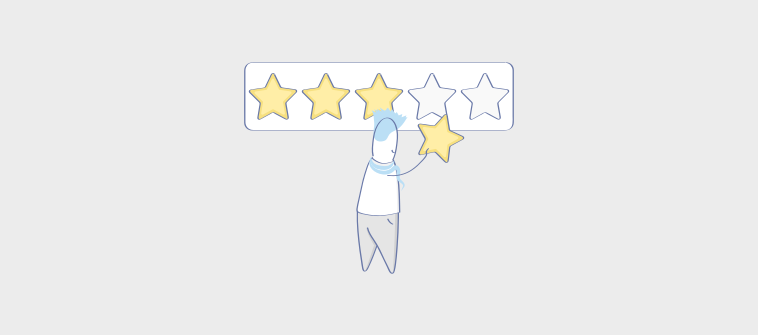
What is Survey Fatigue & How to Avoid It

Proven Tips to Avoid Leading and Loaded Questions in Your Survey

How to Calculate Customer Effort Score to Grow Your Business

Employee Feedback: 20 Great Examples & It’s Importance

20 Website Survey Questions to Ask Your Customers in 2024

Customer Service Recovery Guide: Steps to Make It Right
- 11 Market Survey Template + [Question Examples]

One of the many ways to gather information about customers is through a market research survey. A market research survey, thus, is an affordable and reliable way for organizations to collect useful information from prospective consumers and target markets.
Apart from leveraging online data collection platforms like Formplus for your market research survey, it is also important for you to ask the right questions in your survey in order to gather the most relevant information. In this article, we’ll share some market research survey templates and question examples for your business.
What are Market Surveys?
A market survey is a data collection tool used to gather information from target markets with regard to a particular product/service. It involves gathering feedback on the needs and preferences of customers by asking a series of questions that reveal the inclinations of your target market.
Typically, organizations depend on the results of market research surveys to create effective marketing strategies. Through a marketing survey, you can understand the expectations of prospective customers as well as gain insights into your competition.
Why Administer Market Surveys?
Market surveys are essential to the success of every business; whether new or existing. Understanding the needs of your target market means that you would be able to create and improve products to suit their specific demands, and therefore, record more sales and revenue.
Here are some other reasons why you should conduct a market research survey for your business:
With a market survey, you will gain direct feedback from your customers on their expectations for your product. Such critical information plays a key role in product marketing and feature enhancement.
- A market research survey provides key insights into consumers’ purchasing behaviors. You would know what customers are most likely to purchase, the product features that appeal to them, and what they think about your competitor’s product or service.
- Effective Marketing Strategy
This is one of the most important reasons for conducting a market research survey. Findings from this research activity reveal customer inclinations and this information can help you to create an effective marketing strategy.
- Better Decision-Making
Findings from a marketing research survey often translate to better decision-making for your business. Instead of investing in trial-and-error processes, you would make decisions with a high level of predictability.
- It helps you to optimize your business operations by investing in product features that appeal to your customers.
- It maps out a clear path of demand and supply in the target market (s).
Tips for Conducting the Best Market Research Surveys
- Define a clear goal for your survey. You should be specific about the aim and expected outcomes of your market research survey.
- Identify your target market for the survey. Make your data more relevant by focusing on the right target market. Avoid generic data by ensuring that your target market aligns with your product or service.
- Use the right market survey tool like Formplus.
- Employ a thorough analysis method to process the data gathered via the survey into actionable findings. In the Formplus analytics dashboard, you can access important survey metrics and even generate a custom visual report.
- Engage the services of a market research survey expert to help you get the best results from the process.
11 Market Research Survey Templates
- Market Survey Form
Use this market survey form to gather actionable insights into consumers’ preferences and behaviors. In the drag-and-drop form builder, you can edit this template by adding different form fields to help you collect a variety of information from your target audience.
- Product Pricing Survey
Do you want to know whether you’re charging too much or too little for your product? Then use administer this product pricing survey to gather information about your client’s preferred pricing range. With the Formplus product pricing survey, you will gather first-hand data on the customers’ perception of your pricing.
- Product Evaluation Form
Use this product evaluation form to collect feedback from consumers about your product and improve your product features. The Formplus product evaluation form will help you gather information on the strengths and weaknesses of your product from your customers’ points of view.
- Customer Satisfaction Survey
Find out how well your product meets up with the expectations of your customers using the Formplus customer satisfaction survey . In the drag-and-drop form builder, you can tweak this form to suit your organization’s needs by adding different form fields and changing the appearance of the form.
- Demographic Survey
This demographic survey will help you to better understand your customers. You can collect information about the age, marital status, gender, educational level, religion, and income of your customers to help you create objective buyer personas.
- Interview Consent Form
Use this interview consent form to collect authorized permissions from participants during qualitative and quantitative research. This form would help you prevent any breach of data privacy, and you can also collect digital signatures from participants in your form.
- Opinion Poll Template
This opinion poll template is an easy way for you to sample the public’s opinion on a range of issues. You can edit this template and share the poll’s link with participants in order to understand how they feel about the issue at hand.
- Patient Satisfaction Survey
After providing medical services for a patient, you can administer this patient satisfaction survey to get feedback on how he or she feels about your service delivery. This survey form is a great way for hospitals and other healthcare practitioners to gather feedback from patients and improve their overall service delivery.
- Restaurant Satisfaction Survey
Use this restaurant satisfaction survey to gather feedback from your clients on the quality of your service delivery. Find out what clients think about your brand and how you can improve the overall service experience and perception of your business.
- Strawpoll Template
This straw poll template can be easily modified in the form builder to suit your organization’s needs. With this form, you can collect useful data from respondents about their interests, thoughts, and other important consumer demographics.
- Website Evaluation Survey
Gather first-hand feedback from website visitors about their experience on your website with the Formplus website evaluation survey . You can embed this survey form on your website to make it easily accessible to visitors.
How to Create Market Surveys with Formplus
Seamlessly create and administer your market research survey in little or no time with Formplus. After creating your survey, you can use any of the multiple form-sharing options to get your market research survey across to your customers and target markets.
Formplus also has a form analytics dashboard that displays important metrics like the total number of form submissions and the total number of form views. With the teams and collaboration feature, you and your team members can work on the market research survey and organize responses and folders, together.
Here is a step-by-step guide on how to create a market research survey with Formplus:
- Sign in to your Formplus account to access the form builder. If you do not have a Formplus account, create one here .
- In your dashboard, click on the Create new form button to get started.
- Start by adding a title to your form, e.g. Market Research Survey.
- Next, drag preferred fields into your form from the builder’s inputs section. You can edit form fields by clicking on the pencil icon beside them.
- After dragging and dropping preferred fields into your form, click on “save” to move to the form customization section. You can add background images, insert your organization’s logo, and change your form layout with custom CSS.
- Copy the form’s URL and share it with the respondents. You can send out email invitations to form respondents and also embed your market research survey on your organization’s website.
Market Research Question Examples
Question samples for target markets .
To better understand your target market and customer demographics, here are a few questions you can ask:
- How would you rate your spending habits?
- How much do you spend on groceries every month?
- How do you like to make purchases?
- Would you be willing to pay a premium subscription fee for this service?
- What is your preferred service payment plan?
Market Research Questions for Your Customers
Gathering feedback from your existing customers can provide great insights into your product’s market performance and help you to meet up with the expectations of your clients. Here are 5 questions you can ask here:
- How well does our product meet your needs?
- What do you like best about our product?
- What product feature would you like to see?
- How would you rate our service delivery?
- Has our product improved your daily output?
Market Research Questions for Competitive Analysis
These questions would provide a clearer picture of industry competitors and how they are perceived by your target market:
- What is your favorite toothpaste brand?
- Why did you choose this brand?
- What benefits do you get from this product?
- What milk brands are you familiar with?
Other market research questions are;
- How would you rate your last experience with our product?
- How likely are you to buy this product?
- How often do you make use of this product or service?
- Why did you choose our services?
- How would you rate our pricing for this product?
- How likely are you to subscribe to our services?
Best Types of Questions for Market Research Surveys
Open-ended question.
An open-ended question is a fluid question type that does not restrict respondents to a set of premeditated responses. In other words, it is a type of question that allows respondents to freely communicate their thoughts, feelings, and perceptions as they provide answers to it.
In market research surveys, open-ended questions provide an opportunity for you to get extensive and descriptive information from respondents. Since there is no limit to the responses that can be provided, open-ended questions help you to gain better insights into the behaviors and preferences of your customers.
Examples of open-ended questions are:
- How would you describe your experience with our product?
- How do you think we can improve our product for you?
- What factors influence your spending habits?
Close-ended Questions
A close-ended question is a rigid survey question type that limits respondents to a set of predetermined responses; typically in the form of options. Close-ended questions restrict respondents to already-provided responses (options) and these types of questions are mostly employed in quantitative research.
In market research surveys, close-ended questions are typically used for evaluation; that is when you want to assign statistical values to your customers’ perceptions. Close-ended questions target specifics rather than long-form responses, and they make your data collection process faster and cost-effective.
Examples of closed-ended questions are:
1. Did you enjoy using our product?
2. Would you recommend our services to other people?
3. How would you rate our service delivery?
Multiple Choice Questions
A multiple-choice question is a common type of closed-ended question that allows respondents to select one or more answers from the options provided. Multiple choice questions can restrict respondents to only one option or allow them to choose multiple options that are applicable to them.
Examples of multiple-choice questions include:
1. How long have you been using our product?
- 6-12 months
- More than 1 year
2. How often do you use our product?
- Somewhat often
Rating Scale Questions
A rating scale question is a type of survey question that requires a respondent to choose a rating option that best represents his or her perception of the subject matter. It usually displays a scale of answer options set within a specific range (like some sort of gauge).
Net promoter score questions in customer experience surveys are good examples of rating questions.
Conclusion
A market survey is an important data collection tool for new and existing businesses that intend to create customer-centric products while recording increased sales and revenue. In your market research survey, ensure that you list questions that will prompt respondents to provide relevant answers.
Also, outline specific aims and objectives for your market research survey and tailor your questions to reflect these. Finally, use Formplus to achieve a seamless data collection process from start to finish – you can create your survey, share it with respondents, and analyze the resulting data with little or no hassle.

Connect to Formplus, Get Started Now - It's Free!
- market research survey
- market survey
- market survey template
- markey survey examples
- busayo.longe

You may also like:
Community Survey: Types, Importance + [Questionnaire Examples]
In this article, we’ll look at what a community survey is, the types, why it is so important and some community survey templates you can...

Target Market: Definitions, Examples + [Audience Identification]
Without knowledge of your target market, your entire product conception and marketing process is flawed. This article covers practical...
8 WordPress Plugins for Creating Website User Polls
Use this guide to learn more about different Wordpress polling plugins, their features and pricing.
Highest-Paying Survey Sites on the Web
In this post, we will highlight how the paid survey companies operate and we will also list out sites with legit paid surveys.
Formplus - For Seamless Data Collection
Collect data the right way with a versatile data collection tool. try formplus and transform your work productivity today..
Root out friction in every digital experience, super-charge conversion rates, and optimize digital self-service
Uncover insights from any interaction, deliver AI-powered agent coaching, and reduce cost to serve
Increase revenue and loyalty with real-time insights and recommendations delivered to teams on the ground
Know how your people feel and empower managers to improve employee engagement, productivity, and retention
Take action in the moments that matter most along the employee journey and drive bottom line growth
Whatever they’re are saying, wherever they’re saying it, know exactly what’s going on with your people
Get faster, richer insights with qual and quant tools that make powerful market research available to everyone
Run concept tests, pricing studies, prototyping + more with fast, powerful studies designed by UX research experts
Track your brand performance 24/7 and act quickly to respond to opportunities and challenges in your market
Explore the platform powering Experience Management
- Free Account
- For Digital
- For Customer Care
- For Human Resources
- For Researchers
- Financial Services
- All Industries
Popular Use Cases
- Customer Experience
- Employee Experience
- Employee Exit Interviews
- Net Promoter Score
- Voice of Customer
- Customer Success Hub
- Product Documentation
- Training & Certification
- XM Institute
- Popular Resources
- Customer Stories
- Artificial Intelligence
- Partnerships
- Marketplace
The annual gathering of the experience leaders at the world’s iconic brands building breakthrough business results, live in Salt Lake City.
- English/AU & NZ
- Español/Europa
- Español/América Latina
- Português Brasileiro
- REQUEST DEMO
- Experience Management
- Market Research Templates
Try Qualtrics for free
Market research templates: what they are and how to use them.
18 min read Interested in market research but need some templates to start with? In this guide, we unpack market research, survey planning best practice and share some of our best templates for brand, customer, product and employee research.
What is a market research template?
While you’re no doubt familiar with the concept of market research and how it can help you to reach your target audiences and improve your product or service , the real challenge is designing a market research plan that is conducive to excellent results.
All of this starts with the right market research template(s) to help you analyze specific target audiences, collect the right data and uncover insights that can drive actionable change.
In this article, we’re going to:
- talk about market research and its use cases,
- provide you with a standard template that allows you to plan your research,
- and share several other templates to help you with specific types of market research
You can also check out our free template library.
But first, let’s revisit market research.
Market research is the process of determining the viability of a new service or product through surveys and questionnaires with prospects and/or customers. It involves gathering information about market needs and prospect/customer preferences .
Through market research, you can discover and/or refine your target market, get opinions and feedback on what you provide to them and uncover further prospect/customer pain points and expectations of your service or product .
Market research can be conducted in-house, either by you and your research team, or through a third-party company that specializes in it (they will typically have their own research panels or be capable of creating a research panel to suit your requirements).
The four common types of market research
There are lots of different ways to conduct market research to collect customer data and feedback , test product concepts , and do brand research, but the four most common are:
The most commonly used form of market research, surveys are a form of qualitative research that asks respondents a series of open or closed-ended questions , delivered either as an on-screen questionnaire or email.
Surveys are incredibly popular because they’re cheap, easy to produce, and can capture data very quickly, leading to faster insights.
2) Focus groups
Why not bring together a carefully selected group of people in your target market using focus groups? Though more expensive and complex than surveys and interviews, focus groups can offer deeper insight into prospect and customer behavior – from how users experience your products and services to what marketing messages really resonate with them.
Of course, as a market research method that’s reliant on a moderator to steer conversation, it can be subject to bias (as different moderators might have preferred questions or be more forceful) and if you cut corners (not asking all the necessary questions or making assumptions based on responses), the data could get skewed.
3) Observation
As if you were a fly-on-the-wall, the observation market research method can be incredibly powerful. Rather than interviewing or surveying users, you simply take notes while someone from your target market/target audience engages with your product . How are they using it? What are they struggling with? Do they look as though they have concerns?
Observing your target audience/target market in this fashion is a great alternative to the other more traditional methods on this list. It’s less expensive and far more natural as it isn’t guided by a moderator or a predefined set of questions. The only issue is that you can’t get feedback directly from the mouth of the user, so it’s worth combining this type of research with interviews, surveys, and/or focus groups.
4) Interviews
Interviews allow for face-to-face discussions (both in-person and virtually), allowing for more natural conversations with participants.
For gleaning deeper insights (especially with non-verbal cues giving greater weight to opinions), there’s nothing better than face-to-face interviews. Any kind of interview will provide excellent information, helping you to better understand your prospects and target audience/target market.
Use cases for market research
When you want to understand your prospects and/or customers, but have no existing data to set a benchmark – or want to improve your products and services quickly – market research is often the go-to.
Market research (as mentioned above), helps you to discover how prospects and customers feel about your products and services, as well as what they would like to see .
But there are more use cases and benefits to market research than the above.
Reduce risk of product and business failure
With any new venture, there’s no guarantee that the new idea will be successful. As such, it’s up to you to establish the market’s appetite for your product or service. The easiest way to do this is through market research – you can understand the challenges prospects face and quickly identify where you can help. With the data from your market survey, you can then create a solution that addresses the needs and expectations of would-be customers.
Forecast future trends
Market research doesn’t just help you to understand the current market – it also helps you to forecast future needs. As you conduct your research and analyze the findings, you can identify trends – for example, how brands and businesses are adopting new technology to improve customer experiences or how sustainability is becoming a core focus for packaging. Whatever it is you’re looking to understand about the future of business in your market, comprehensive market research can help you to identify it.
Stay ahead of the competition
Understanding your market and what prospects and customers want from you will help to keep you ahead of the competition . The fact is that the top businesses frequently invest in market research to get an edge, and those that don’t tap into the insights of their audience are missing low-hanging fruit.
As well as helping you to stay in front, you can also use market research to identify gaps in the market, e.g. your competitors’ strengths and weaknesses . Just have participants answer questions about competitor products/services – or even use the products/services – and work out how you can refine your offerings to address these issues.
Plan more strategically
What’s the foundation of your business strategy? If it’s based on evidence, e.g. what people expect of your products and services, it’ll be much easier to deliver something that works. Rather than making assumptions about what you should do, market research gives you a clear, concrete understanding of what people want to see.
Check out our guide to market research for a more comprehensive breakdown.
How do you write a market research plan/template?
A market research plan is very similar to a brief in that it documents the most vital information and steps about your project. Consider it a blueprint that outlines your main objective (summary), key questions and outcomes, target audience and size, your timeline, budget, and other key variables.
Let’s talk about them in more detail.
Elements of a great market research plan
1) overview or summary.
Use the first section of your market research plan to outline the background to the problem that you are attempting to solve (this is usually your problem statement or problem question). Include background information on the study’s purpose and the business to provide context to those who would read the report, as well as the need for the research. Keep the overview simple and concise; focus on the most salient elements.
2) Objectives
What is it that you hope to achieve with this survey? Your objectives are the most important part of the survey. Make sure to list 3-5 of the decisions or initiatives that the research will influence.
For example:
Understand the most-used channels for customer engagement and purchasing to decide where to prioritize marketing and sales budget in Q1 2022. Determine what’s causing customer churn at the later stages of the buyer journey and implement a new retention and sales strategy to address it.
Your objectives should be smart, that is: Specific, Measurable, Attainable, Relevant, and Timely.
3) Deliverables (or outcomes)
This section should focus on what you expect to have at the end of the project. How many responses are you looking for? How will the data be presented? Who will the data be shared with? (Stakeholders, executives) What are your next steps? Make sure you state how you will collect and analyze the data once it’s available.
Products such as Qualtrics CoreXM make this process fast and incredibly easy to do, drastically reducing the time to insights so you can make more meaningful changes, faster.
4) Target audience
Not to be confused with your market research sample, your target audience represents who you want to research. Of course, your sample may include ideal buyers from your target audience. Here you want to define the main variables or factors of your audience: demographic , age, location , product interaction, experience, and so on. It’s worth building out your buyer personas (if you haven’t already) and including a quick breakdown of them here.
5) Sample plan
How many participants do you want to research and what kind of groups do you want to reach? Depending on these two variables, you may have to use qualitative, quantitative , or multi-method approaches.
6) Research methods
What methods will you use in your market research project? The insights (and the granularity of those insights) will depend on the methods and tools you choose. For example, and as mentioned earlier, surveys are often the go-to for many organizations as they’re affordable and straightforward, but if you want to get more personal views from your respondents, one-to-one interviews might be more applicable. You might even want to take a hands-off approach and simply observe participants as they use your products, or try a combination of research methods. Make sure to outline what methods you will use as part of your research plan.
7) Timeline
How long will your research project run? It’s worth putting together a Gantt chart to highlight key milestones in the project, along with dependencies, and to break down tasks as much as possible. Schedule in contingency time in case some tasks or research runs over – or you need more responses.
Set a budget for the overall program and list it in your plan. Though this might be the most difficult aspect of any research plan, it helps you to be more strategic about tasks and hold people accountable at each stage of the process. If costs go over, that’s good to know for future market research. If costs are lower than anticipated, you then have the opportunity to do further research or prop up other areas of the study.
9) Ethical concerns or conflicts of interest
One of the most important parts of your market research plan, you should highlight any ethical concerns. To begin with, it’s your duty to state whether or not responses will be kept confidential and anonymous as part of the study. It’s also important to allow participants to remain anonymous and ensure you protect their privacy at all times.
Another issue to consider is stereotyping. Any analysis of real populations needs to make approximations and place individuals into groups, but if conducted irresponsibly, stereotyping can lead to undesirable results.
Lastly, conflicts of interest – it may be that researchers have interests in the outcome of the project that lead to a personal advantage that might compromise the integrity of your market research project. You should clearly state in your market research report that any potential conflicts of interest are highlighted and addressed before continuing.
But I want a faster solution!
Well, there’s a quicker and far easier way to do all of the above and get the data you need – just use a market research survey template. In our next section, we’re going to share a whole list of templates that you can use.
Free market research survey templates
No matter what kind of research you want to conduct, we have templates that will remove the complexity of the task and empower you to get more from your data. Below we’ve compiled a list of templates for four key experience areas: Brand , Customer , Employee , and Product .
All of our research templates are free. All you need to do is sign up for a free Qualtrics account to access them.
Brand experience market research templates:
- Logo testing : Collect feedback to help you evaluate and iterate on your logo designs and concepts
- Brand awareness : Track the level of brand awareness in your target market, including current and potential future customers
- Ad testing : Evaluate your consumers’ reaction to an advertisement so you know which campaigns to deploy before you invest
- A/B testing : Quickly and easily compare to versions or options in a study, whether it’s a design, headline, color palette or a mock-up of your latest ad campaign
Customer experience market research templates
- Student satisfaction : Gather feedback on how your institution is delivering on the student experience
- Net promoter score (NPS) : Measure customer loyalty and understand how they feel about your product or service using one of the world’s best-recognized metrics
- Customer satisfaction : Evaluate how satisfied your customers are with your company, including the products and services you provide, and how they are treated when they buy from you
- Customer service : Gain insights into the contact center experience, so you can achieve and maintain optimum levels of customer experience (CX) performance
- Event feedback : Measure the effectiveness of your events and how well they meet attendee expectations so that you can continuously improve your offering
- IT help desk : Understand how satisfied your employees and customers are with your IT help desk experience
- Website suggestion box : Collect visitor feedback on how your website can be improved
- Website satisfaction : Find out how satisfied visitors are with your website’s design, usability, and performance
- Store purchase feedback : Capture customer experience data at the point of purchase to help you improve the in-store experience
- Online purchase feedback : Find out how well your online shopping experience performs against customer needs and expectations
Employee experience market research templates
- Employee satisfaction : Get an overview of your current employee experience
- Manager feedback : Improve your skills as a leader with valuable feedback from your team
- Employee engagement : Find out how employees find the current experience at your workplace with this entry-level engagement survey
- Employee exit interview : Understand why your employees are leaving and how they’ll speak about your company once they’re gone with this survey template
- Employee onboarding : Improve your onboarding program by understanding what’s working and what’s not
- Team event planning : Collect inputs from employees to plan a team event that works for everyone
- Meeting feedback : Check-in with team members after a meeting to see how well your company is running and what improvements can be made
- Interview feedback : Improve your candidate experience by gathering actionable insights about the interview process
- Employee suggestion box : Gather anonymous data to help address concerns and improve the employee experience in your organization
- Candidate experience : Improve your candidate experience to increase brand perception, offer acceptance rates, and hiring process efficiency with this single-touchpoint survey template
- Employee suggestion action : Take employee feedback a step further by working with your staff to quantify solutions based on their experience data
Product experience market research templates
- Product research : Evaluate your consumers’ reaction to a new product or product feature across every stage of the product development journey
- Pricing : Understand how to set the exact price point for your product or service, according to your target consumers
- Feature prioritization : Compare and contrast product features using conjoint analysis to find the optimal mix for your customers
- Product package testing : Collect feedback on your product packaging to see how well it meets the needs and expectations of your customers
Armed with the right market research templates, getting the information you need across brand, product, customer and employee disciplines — as well as beyond — is significantly easier.
But if you want help putting together complex market research and scaling your in-house research team to get agile insights, check out our guide to building an agile research function.
Insights are more important than ever, especially during times of change, but building a great team takes a lot of time and money.
In our eBook, we’ll explain how you can:
- Scale your research team
- Build a smart partner strategy
- Ensure you have the right technology for market research and data analysis
Tackle your market research with our agile market research eBook
Related resources
Market intelligence 10 min read, marketing insights 11 min read, ethnographic research 11 min read, qualitative vs quantitative research 13 min read, qualitative research questions 11 min read, qualitative research design 12 min read, primary vs secondary research 14 min read, request demo.
Ready to learn more about Qualtrics?
Blog / Small business tips / How to conduct market research for your business idea

How to conduct market research for your business idea
If you don’t know who you’re selling to, you may miss important acquisition opportunities. Market research helps you to uncover key information about your target market so that you can reach, engage and ultimately convert your ideal customers into buyers.
The internet has made it easy for customers to find out information about brands online. The same is true for small business owners looking to figure out how to do market research for a business idea .
Market research will help you to discover who your ideal customers are, where they hang out online or in-person and how and why they make purchasing decisions. Armed with this information, you can get in front of your ideal audience in the right place at the right time, thus grabbing their attention and motivating buying behaviour.
In this article, we’ll explain what market research is and why it’s important, outline several types of market research and detail how to do your own market research to boost reach, drive conversions and increase revenue.
Top Tip: Conducting market research is a key part of ensuring that your start-up idea is something that people actually want and/or need. Once you’ve finished your research, you’ll need to get into the nitty gritty of creating a brand for your business, choosing your company formation structure, educating yourself on business laws and regulation, sourcing funding (if necessary), and marketing your business. You can learn how to do all of this and more in our guide to 10 effective steps to start your business in the UK 📌.
What is market research.
- Why is market research valuable?
Types of market research
- How to conduct market research in 5 steps
5 common market research questions
Wrapping up.
Market research is the process of identifying information about your target industry as well as your target customers.
When starting a new business, it will help you to answer the following questions:
- Demand: Is there a desire or need for your product or service? If so, what problem or pain points does your offering solve and how can you better align it to suit this demand?
- Market saturation: How many similar options are already available to consumers? Further, what are those businesses who are already in the space doing well and where are they missing opportunities? What can you do differently to fill in these gaps?
- Market size: How many people would be interested in your value proposition? This will help you to forecast your startup budget or, for businesses that are post-launch, this new product or service budget. From there, you can also predict revenue and profitability.
- Economic indicators: What’s the income range and employment rate of your target audience? This is the first step in customer research and it will help you to create detailed customer personas (more on these later on).
- Location: Where do your customers live and hang out, both geographically and online, and where and how can your business reach them?
- Pricing: What do potential customers pay to your competitors? This will help you to figure out exactly how to price your products or services so that you can stay competitive and achieve profitable markups.
The results from this research will help you tailor your marketing efforts and brand messaging to better engage your audience. And, it will help you to design and package your product or services in a way that aligns with your audience’s needs. All of this leads to better conversion rates, sales and revenue.

Why is market research valuable?
Understanding your customers is the most effective way to drive engagement and increase loyalty. Knowing their desires, needs and pain points helps you create a better user experience and cater to audience demand.
Market research is invaluable because it gives you compelling insights into user behaviour. While data and analytics give you a high-level overview of behaviours, market research goes a step deeper and uncovers what drives user intent. If you can unearth user intent, you can speak directly to your consumer with personalised messaging that motivates them to take action.
Market research also helps you uncover industry trends, ensuring you’re staying in line with what customers want and need out of similar products or services within the same industry.
Competitor research like this helps you figure out what your competitors are doing well and where there are gaps in their strategy that you can fill. Plus, getting a sense of small business trends in your target market will help you to understand how they will impact your revenue and profits.
There are two main types of market research methods: primary and secondary. Primary research entails speaking directly to the source, or direct-to-consumer, and secondary research is the act of gathering data from existing third-party sources.
Both main types of research utilise qualitative and quantitative research methodologies.
Qualitative research focuses on data from first-hand observations, such as interviews, focus groups and questionnaires.
Quantitative market research , on the other hand, focuses on collecting and analysing big data from larger sample sizes, such as demographics, spending behaviour and opt-in rates.
To conduct the most well-rounded market research, you should incorporate both types of research and methodologies. It’s easier to start with secondary research and move into primary research once you have an idea of general industry and consumer trends. As secondary research has already been compiled and published by others, it’s less time-consuming and often cheaper than primary research.
If you’re starting a new business, whether a full-time endeavour or a side business for extra income, this market research will be critical when creating a market analysis section in your business plan . Showcasing exactly what your competitors are doing, how your business will fill industry voids and your plan to attract your target audience will help to generate interest in your business idea.
Let’s dive into the two types of market research in more detail.
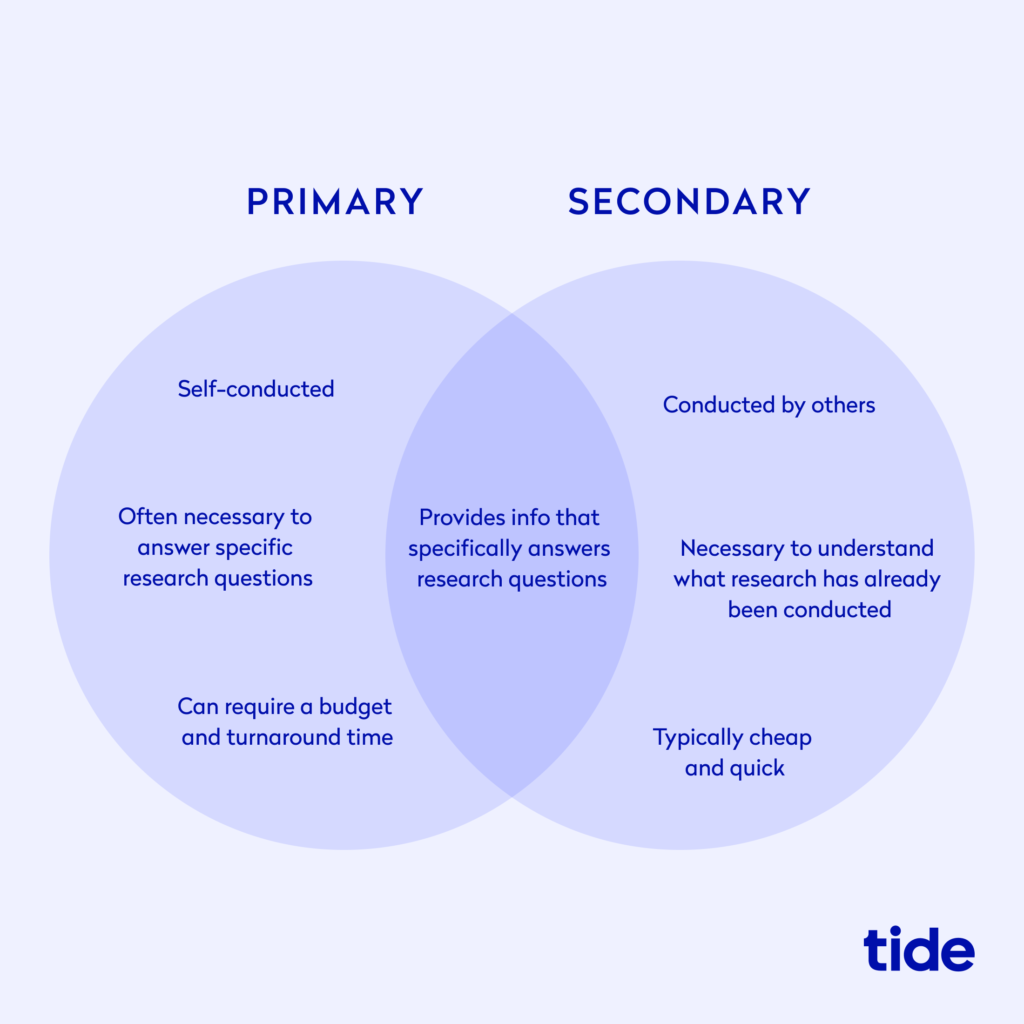
Secondary research is third-party data that gives you a high-level overview of your target market. This data can be found in trend reports, market statistics, industry content, your own sales data if your business is post-launch, studies by government agencies, trade associates or other businesses.
There are two main ways to access secondary research data.
- Public Sources: These include government statistics, academic databases, news sources, published books, published studies, and so on. Publicly sourced information is often free and you can find it online or in libraries. Such sources in the UK include the Office for National Statistics , the British Chambers of Commerce and the Federation of Small Businesses and more.
- Commercial Sources: These sources are often in the form of statistics from private-groups that you have to pay money to gain access to. Such companies include Forrester , Gartner , International Data Corporation (IDC) , Everest Group , Mintel , Euromonitor , YouGov and more. You can also use online sources (both free and paid) that analyse online behaviour and trends like Google Trends , Product Hunt , Social Mention and SimilarWeb .
Primary research is research you conduct yourself in order to gather more detailed information about your specific target audience. You should begin primary research only after you’ve completed secondary research as it’s meant to fill any missed gaps from third-party sources.
There are three main ways to do primary research.
- Exploratory research: This involves talking directly with people. You should have an initial sense of your target audience from your secondary research, so this is the first time you’ll be communicating directly with them. Start with broad, open-ended interviews in an attempt to narrow down this group into a more niche audience.
- Specific Research: Once you’ve generated this smaller, more niche group, use the same methods that you applied to your exploratory research. But this time, ask more specific questions to get more valuable and intent-driven answers.
- Internal Sources: If you’ve already launched your business and are conducting market research to see if the industry has changed since launch, collaborate in-house to see what your existing customers are saying. What were their challenges and pain points at launch and how have they changed? What are your customer’s biggest needs now? What do they say you can be doing better? The idea is to learn from and improve upon your original research by combining historical with updated customer-driven insights.

How to conduct market research
There’s no one specific way to do market research. Generally, you want to start broad and narrow your research as you learn more.
Once complete, you should be able to define your buyer persona, know their specific needs and pain points, understand how your competitors are positioning themselves in the market and identify your opportunity to gain a competitive advantage.
Here are five steps you can follow to organise and optimise your market research process.
1. Define your buyer persona
The key to driving brand engagement and purchasing behaviour is the ability to connect with your target audience. Otherwise, you’ll be promoting your product or service to a wide array of potentially uninterested parties, wasting valuable time and money.
Defining your target audience is the first step of your primary research efforts. Once you understand who you are selling to and what their interests are, you can and subsequently reach out directly via your secondary research initiative (we will explain how to do this in step 2 below).
From there, you can begin to create a buyer persona. Use your target audience research to create buyer personas that answer the following questions:
- Who are your customers and why are they interested in buying your product or service?
- What characteristics, interests, desires, pain points and needs do they share?
- Where do they live?
- How old are they?
- What is their education level?
- What is their income range?
- Which types of websites do they frequently visit?
- Where do they currently buy similar products?
- Which languages do they speak?
- What industry do they work in?
Use the aforementioned public and commercial resources to gather and compile this data. Once complete, you can build your customer persona. This step is important because you can distribute a detailed, shareable document amongst your team or potential investors to guarantee everybody clearly understands your target audience.
You can use online tools like HubSpot’s customer persona creator , Xtensio , Userforge or Smaply to build basic buyer personas quickly.
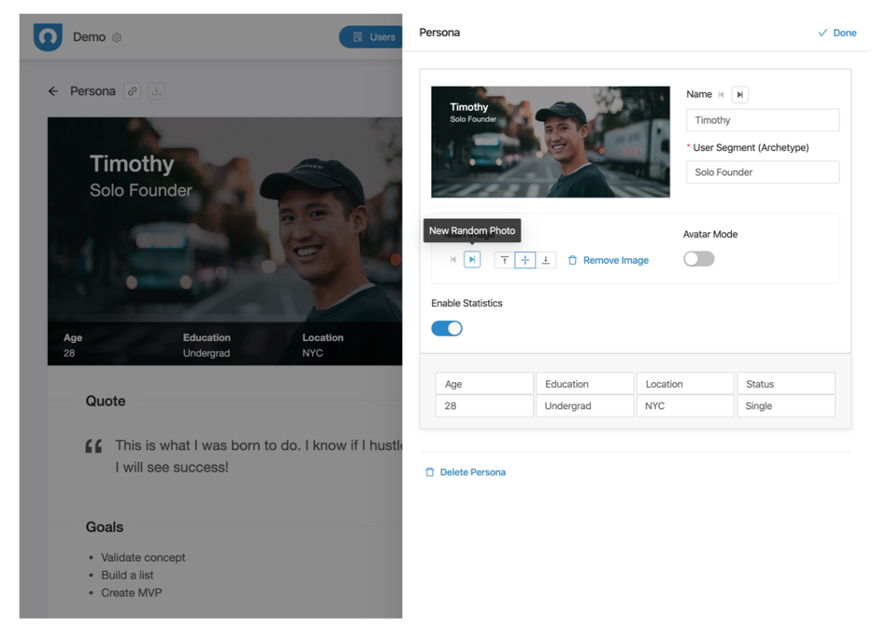
Top Tip: This is the first step in building a marketing strategy that will help you gain traction and boost brand awareness. To learn more about how to attract your ideal audience, read our guide on how to build a go-to-market strategy .
2. Engage with a small target sample
Now that you’ve completed your initial customer personas and market research, it’s time to dive deeper into your audience’s behaviours. This is where your secondary research efforts come into play.
You can reach out to your target audience in several ways across many mediums. Remember to begin with exploratory research by asking open-ended questions and follow up with specific research that unveils invaluable insights.
- Surveys: Use online surveys to ask a group of people a set of questions. Often, an online survey is delivered via email, but it can also be posted on social media platforms or online forums. Surveys are easy and cheap to conduct, the results come in quickly and the data is straightforward to analyse. You can use platforms like Survey Monkey , JotForm , Google Forms , LimeSurvey and more.
- Emails: Send a cold email asking if they will be open to answering some of your questions. You can attach your survey to this email and/or use it as a platform to schedule a more in-depth phone interview.
- Phone calls: Phone interviews allow you to speak directly with your potential customers. Use their answers to formulate your follow up questions to dive deeper into intent and expose insightful trends.
- Face-to-face: This will be exactly the same as the phone interview, but one-on-one in person. In-person or interviews via video conferencing can be more valuable than phone calls as they give you the opportunity to see body language. Sometimes, you can learn more about what a person is feeling based on their body language rather than their words. Observation is key in face-to-face meetings.
- Focus groups: Focus groups bring together a group of selected participants to answer questions in real-time. Usually, a trained moderator will lead the discussion and ask questions about your product or service, user experience, user expectations, competitor products or services, marketing and branding messaging and more.
- Call for participants via social media: Post on social media platforms to generate interest about participating in any of the above methods. Make sure you are posting your questions in the places that your target audience hangs out online, such as LinkedIn , Facebook groups, Twitter , Reddit , and so on, so that you attract people that align with your unique customer personas.
- Leverage your network to get participants: Apply the same methodology as your social media call for participants when leveraging your own network. Reach out to friends, former coworkers, family members and more to see who among them fits into your customer persona and is willing to participate.
3. Identify competitors
Gathering information about your competitors helps you figure out who their audience is, how they communicate with them and how they position themselves in the marketplace. This will help you to learn from their successes and failures so that you can replicate the fruitful tactics and avoid messaging or branding that received negative feedback.
There are two types of competitors to identify.
- Industry competitors: Industry competitors are those that saturate your target marketplace. For example, if you are selling a SaaS video conferencing tool, your competitors will be businesses like Zoom or GoToMeeting.
- Content competitors: Content competitors may not be competing in terms of the products or services they sell, but they are competing in terms of content creation. For example, if you run a leadership training business, a content competitor will be a business that creates content about how to be a great leader. This content competitor could run a finance business, a retreat business, a SaaS business or so on, but because they create content that targets similar keywords, they are a competitor in that specific space.
It’s important to understand as much as you can about your competitors so that you can make better decisions. Learn everything about your competitor’s audience and apply those insights to your branding and marketing strategy.
4. Analyse data
You will amass a ton of information throughout this process. Make sure that you are using a system that helps you organise it so that it doesn’t become overwhelming.
Here are some ideas on how to do this:
- Sort your data into groups to better understand the big picture
- Create several distinct customer personas if you learn that you have more than one audience type
- Build a matrix chart to see how often pain points, desires, needs and attributes overlap
- Generate a customer journey map to outline the journey from awareness to purchase, using free or paid tools like LucidChart , HubSpot or Visual Paradigm .
Once organised, you can draw meaningful insights from your data collection. This will help you to further shape your offering and messaging.
5. Summarise findings
Summarise your findings in a simple and shareable format. Draw inspiration from the common themes you discovered to help tell a story about your target audience.
This will guide future marketing and branding efforts and help your team and potential investors develop a clear picture of who your ideal audience is in their minds.
Add in quotes, diagrams, call clips, video clips and more to amplify the audience’s voice. Outline who you talked to, common themes and if you will stay on course or pivot based on any common feedback threads. End the summary with immediate next steps and action items.
It’s FREE to register your new limited company with Tide and we’ll also open a FREE business bank account for you. If you need to, you can opt for a virtual office address to keep your home address private. And as your business grows, you can choose to upgrade to Plus or Premium membership, for enhanced service and perks. Register with Tide – find out more .
The most effective questions get to the heart of the matter and help you obtain invaluable insights. These insights will affect who you target, where you position your brand, what your messaging will be, what voice and tone you will use and much more.
Here are some common market research questions.
1. What do you look for in a brand?
This will help you figure out what matters the most, at a high-level. For example, does your audience care about engaging with brands that support a good cause, or do they prioritise quality above all?
From this answer, you’ll have a better idea of what to include in your messaging. If your audience prefers brands that support a good cause, you can forge partnerships with nonprofits or charities and commit to donating a portion of your proceeds to them. Then, add this messaging on your website or in your content to make sure your audience is aware of your stance.
2. What are the reasons or actions that drive you to make a purchase?
Based on that answer, you can ask more specific follow up questions such as:
- Do you prefer testing products with free trials, or are explainer videos sufficient to pique your interest?
- Do you prefer when a company is active on social media or do you not care so much?
- How much does a business’s customer service response influence your brand loyalty?
Use these answers to uncover desires, expectations and experiences that influence your focus in these areas.
3. What problem were you trying to solve or what goal were you trying to achieve when you purchased from [COMPETITOR]?
This answer will help you understand your competitor’s audience to see what their intent was before making a purchase. You can use these insights to position your business as a better solution to their problems.
4. What challenge(s) at work has [COMPETITOR’S] solution failed to solve?
From this answer, you can identify pain points that your competitors have yet to build a solution to. Ideally, you can get to market before them and present your product or services as the solution that will fix their ongoing problem.
5. What does your day look like?
While broad and open-ended, this question will help you learn more about your target audience in general. You need to not only understand what drives their buying behaviour, but who they are in a larger sense.
This will help you build empathy for your audience, which will only serve to help you when speaking directly to them and personalising messaging. Plus, you may uncover something you didn’t previously know about their buying habits from this answer.
Market research is crucial in order to identify, understand and segment your target audience. Further, it allows you to gain a high-level understanding of your target industry as a whole, giving you the data you need to competitively price your products and forecast revenue.
Without market research, you will be selling blind. The most successful companies not only understand their place in the market and exactly who they are selling to, but how and where to target them.
Plus, they know why their target audience makes certain purchasing decisions, helping them to skew their messaging in a way that captivates, engages and produces results.

Photo by Startup Stock Photos, published on Pexels

Valentine Hutchings
Head of Community and small business enthusiast
Join our community of entrepreneurs, freelancers and small business owners
Tide is here to help small business owners and sole traders save time and money. Take a look at our Business Bank Account and get time back to focus on your business.
Subscribe to our FREE business tips newsletter
I am a: Sole Trader Registered Business
By subscribing you agree to receive marketing communications from Tide. You can unsubscribe anytime using the link in the footer of any of our emails. See our privacy policy .
Thanks for signing up.
Related Articles

An in-depth guide to starting an online business

How to create a business plan: A complete guide to writing your company roadmap

How much does it cost to start a business in the UK?
A business bank account that's free, easy to open, and helps you start doing what you love..
Tide is about doing what you love. That’s why we’re trusted by 575,000+ sole traders, freelancers and limited companies throughout the UK.
Get useful stuff in your inbox
Be the first to hear about our webinars, new features and business tips to help you save time and money.
Welcome to the Tide community!
Contact our Support team now on phone 01277 284499 . They are on hand to answer any questions you may have about opening a Tide account or any of our products, 9am - 6pm daily.
Join thousands of product people at Insight Out Conf on April 11. Register free.
Insights hub solutions
Analyze data
Uncover deep customer insights with fast, powerful features, store insights, curate and manage insights in one searchable platform, scale research, unlock the potential of customer insights at enterprise scale.
Featured reads

Product updates
Dovetail retro: our biggest releases from the past year
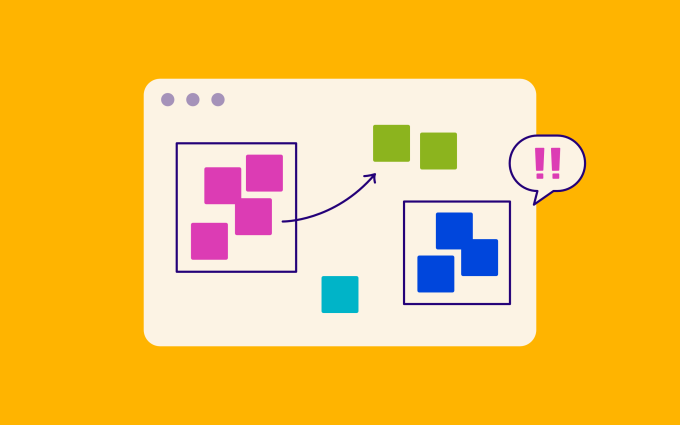
Tips and tricks
How to affinity map using the canvas

Dovetail in the Details: 21 improvements to influence, transcribe, and store
Events and videos
© Dovetail Research Pty. Ltd.
How to use market surveys to gather actionable insights
Last updated
Reviewed by
New to market surveys? Follow this guide to take the guesswork out of your next product or service launch with easy-to-build market surveys that will get you the data you need.
As one of the most effective research methods , many businesses use market surveys as their primary data collection tool. Whether your team is looking to improve existing client offerings or wants to redesign your current products or services, collecting market research will be an essential part of your project’s success.
Your team must facilitate regular market research to understand your target market. Covering everything you need to know, use this guide to get you started down the path of high-quality market research and insight collection.
Let’s get into it!
- What are market surveys?
A market survey is a tool used to collect information and data from a set group of people. Often sent to existing customers, surveys for market research can help your team learn valuable information about your target audience and chosen market.
When used correctly, a market survey will provide your team with data and insights, including:
Demographic information of your top customers
The needs and wants of your target audience
Any pain points or issues with your current product or service
Competitor brands that your customers also use
Trends and information about your target market
Market research vs. marketing research
Despite sounding quite similar, market research and marketing research are two different terms:
Market research
As the primary subject of this article, market research is the practice of collecting and analyzing information from a specific target audience or customer base. It’s commonly done as part of UX research and gives the company better insights into the needs and wants of its customers. Market surveys are some of the most widely used tools to conduct this type of research.
Marketing research
Alternatively, marketing research focuses more on reporting on information specifically related to marketing efforts. This type of research is often focused on gaining insights about new or upcoming marketing messaging, campaign launches, and more. A/B testing packaging, surveying customers, and price trialing are examples of marketing research.
- The benefits of surveys for market research
Market surveys are popular across all industries due to their ease of use and efficient data collection capabilities. As your team begins to develop your market research strategy, here are a few reasons why you should consider using market surveys as part of your plan:
Gain insights for potential future products
Instead of blindly creating a new product or service that you think your customers will like, use market research surveys to create exactly what they’re looking for from the start.
Brand loyalty is built through trust and collaboration with your customers. By inviting them into the process (by getting them to share their experiences and preferences), your team not only gains direct feedback about how to move forward but also creates a sense of community and appreciation.
Using open-ended questions as part of your market research surveys allows your customers to talk about their preferences, experiences, and desires for your brand. This allows their needs and concerns to be heard while providing you with a road map for future success. Talk about a win-win!
Analyze your competitors
Do you know where your brand measures up compared to other competitors in your industry? Learn why your customers choose you (and why others opt for your competitors) with well-crafted surveys for market research.
No matter the industry your company works within, there is always competition between different brands. Help your business stand out from the others by conducting regular market research about your target audience’s experiences—giving you great insights about where your offerings currently stand and what you can do to improve and better serve your customers.
Test your marketing efforts before the big launch
Don’t blow your marketing budget on a campaign that isn’t going to land with your target audience. Instead, top-performing teams use market research surveys to A/B test ideas and storylines within their marketing materials before the big launch—and the results are worth the extra effort!
Focus groups , customer interviews , and small-batch surveys are great ways to learn more about the effectiveness of your current marketing materials. When done currently, your market surveys will give you direct insights into the wording and phrasing used to convey their primary concerns (something that will go a long way for relatability while boosting your conversion rates).
Everyone wants to be heard and understood—so use your market surveys to connect and listen to your target audience to enhance your next marketing campaign.
Create fresh content that connects
Creating high-quality content is hard—especially if you operate within a narrow niche. If your company uses content marketing to connect with its target audience, marketing surveys can be incredibly valuable.
Instead of racking your brain to find content ideas that you think will resonate with your target audience, your team can use market surveys to get ideas, perspectives, and stories that can be turned into earnest and compelling content for your brand.
Sending out a market survey asking for opinions or ideas for content is a surprisingly easy (and effective) way to build a winning content strategy—and we highly recommend adding it to your current marketing strategy!
Understand customer sentiment
How do your customer base and the general public feel about your brand? If you don’t have a clear answer to this question, you need to use well-crafted market surveys to find out.
The way your customers perceive your brand, products, and services has a dramatic impact on the success of your business. Customer sentiment analysis (which can be part of your market research strategy) is a great way to explore this topic—giving you direct insights into the experiences and sentiments about your offerings. Often sent after a purchase or speaking with a customer service representative, this type of market survey helps your team stay on top of your public image.
If you start noticing an influx of negative reviews, you know it’s time to change. If your brand is well-loved, you need to focus on initiatives supporting and fostering this sentiment further.
But, without market research surveys, your team will be unaware of customer sentiment, making all decisions reactionary and late rather than as part of your day-to-day decision-making process and strategy.
- Types of market surveys (with examples)
Now that we have explored the incredible value that market research surveys can bring to your team, let’s jump into some of the most common types of surveys used by businesses looking to learn more about their chosen market:
Market description surveys
Market description surveys determine the size and interests of a particular niche segment. When done correctly, market description surveys will give your team insights into the following:
Potential market growth
Existing competitors within the space
The core issues and problems this market is looking to address
Market description surveys are often sent out to a large number of participants to collect data from a wide range of sources. This type of survey is great to implement during the early stages of a new project, as you can use any of the feedback quickly to improve your business.
Market segmentation surveys
Market segmentation surveys are created to learn more about the specifics of your target audience. Who are they, and who is not a part of this group, and why? What do they like, and what do they need now and into the future?
By sending market segmentation surveys to your customers and target audience, your team will gain information about:
The different types of people within your chosen market
Market demographic, including age, geographic location, income and gender
Your customer’s primary wants and preferences
Your customer’s pain points and concerns
To create better quality products and services that resonate with your target audience, you first need to understand who they are. Using a market segmentation survey template from SurveyMonkey, your team will be able to segment your market into groups based on shared interests and preferences—allowing you to create more personalized and detailed offerings and marketing campaigns that will convert.
Purchase tracking surveys
Market research surveys can understand and track your customer’s purchase experience and habits. They can highlight each customer’s journey , from learning about your product to paying for your product or service. Purchase tracking surveys provide insights into:
How your customers became aware of your brand
The impact of marketing campaigns
Customer purchase behavior (including the likelihood of repurchase)
Pain points or barriers that prevent customers from buying
Understanding your customer’s path to purchase and experience with your brand is essential for long-term brand success. We recommend using the SurveyMonkey purchase tracking survey template to get started with effective customer purchase tracking research.
Just adapt the questions to your specific customer base and set the survey to be sent a few days after a purchase—you will be blown away by the amount of information you can collect!
- Common market survey mistakes to avoid
Using the information and templates provided throughout this article, your team can now create and distribute market surveys to your customers and chosen market. To get the most out of your efforts (and to avoid mistakes that can diminish the value of your surveys), here are a few of our top market research survey mistakes you should avoid:
Choosing the wrong audience
No matter how well you write your market survey questions, if you send the content to the wrong group of people, you will not collect helpful information.
To avoid this fate, spending extra time identifying your target audience can be helpful. Whether you do this through team brainstorming sessions, smaller custom research projects, or by segmenting your already existing target audience, these efforts will be tremendously helpful for getting accurate and nuanced insights from your surveys down the line.
Using the wrong sample size
The number of people you survey will significantly impact the quality and accuracy of the results you receive—and should be something your team is aware of before you even send out your first market research survey!
To determine what size of sample size will be best suited for your project, you first need to think about the type of information you are looking to collect:
Generalized market analysis
Broad-scoped research projects need a large number of participants to provide an accurate portrayal of your target audience. If your team wants to learn more about a new market, making sure you send and receive surveys from a large sample size will be essential.
Collecting customer demographics and exploring purchasing behaviors are two examples of market research categories that require a larger sample size to give reliable results.
User experience
Alternatively, anecdotal and personalized information is often more beneficial when provided by a smaller (but high-quality) group of participants. Instead of collecting large amounts of vague information from a bigger group, interviewing or surveying a smaller group of qualified people can provide specific and detailed insights into the experiences of your top customers.
Learning more about product or service pain points or exploring the reception to a new feature are examples of market research projects that can benefit from a smaller sample size.
Not optimizing survey send times
How (and when) you send your market research surveys to your target audience matters.
Demographic surveys can be sent to new subscribers, ideally during the workday, to prevent notification during the evening or at night. Ensure that your surveys get seen and completed by factoring in send time into your strategy. If you collect post-purchase data, send your survey after a recent purchase.
Whenever you ask your customers to complete a survey, you’re asking for a favor. So, do your best to be appreciative and polite—and always avoid sending too much email spam!
Writing unclear survey questions
Possibly one of the most commonly made mistakes when beginning market research is writing confusing and non-specific questions for surveys.
The questions you choose to add to your survey should be intentional—meaning that they have gone through rounds of editing and prioritization to be clear and compelling to your audience while providing your team with insightful and specific data.
We highly recommend hosting a brainstorming session for potential survey questions with your team. After you have written out as many ideas and iterations for questions as you can, spend the time to rewrite, reorganize, and rate the strength of each question you want to include in your survey. Only the best of the best should make the cut—making your survey short, sweet, and impactful.
- Maximize your market research insights
Using this guide, we hope your team now understands the importance of market research on the success of your upcoming lunch or brand redesign. No matter the size of your company, taking the time to learn more about your chosen market will always improve your offerings—so we encourage you to get started as soon as possible!
But, once you get started, the fun has only just begun. Market surveys are an excellent tool for gathering information about your target audience—but how can you get the most out of the data you have collected?
A customer insights hub can give your team access to customer insights, no matter the type of data you want to collect and analyze. Made to store your market research data in an accessible and flexible way, use it to infuse customer insights seamlessly into your existing workflow.
We hope you found this guide helpful—now get out there and create high-quality market surveys!
Get started today
Go from raw data to valuable insights with a flexible research platform
Editor’s picks
Last updated: 20 December 2023
Last updated: 5 February 2024
Last updated: 26 February 2024
Last updated: 5 March 2024
Last updated: 26 May 2023
Last updated: 11 April 2023
Last updated: 22 July 2023
Last updated: 7 February 2024
Last updated: 30 January 2024
Last updated: 23 January 2024
Last updated: 26 September 2023
Last updated: 1 June 2023
Last updated: 16 November 2023
Last updated: 31 January 2024
Last updated: 22 February 2024
Latest articles
Related topics, log in or sign up.
Get started with a free trial
Market Research Surveys Guide with Examples
Market research surveys are a method of collecting data from a group of individuals to gain insights into their behaviors, attitudes, and preferences towards products or services. They are typically used by businesses to inform their marketing strategies and make informed decisions about their products or services.
Table of contents
What are Market Research Surveys?
Benefits of market research surveys, drawbacks of market research surveys, types of market research surveys.
- When to use Market Research Surveys
- Tips for writing good Market Research Surveys
Market research surveys are valuable for any business to understand its customers, competitors, and market trends. Collecting data directly from your target audience can gain valuable insights that inform your marketing strategy, product development, and overall business decisions.
However, creating and conducting effective market research surveys can be complex. From designing questions that accurately capture the information you need to analyzing and interpreting the data you collect, there are many factors to consider.
Market research surveys are surveys that businesses and organizations use to gather information about their target market, industry trends, and consumer behavior. These surveys can be conducted through various methods, such as phone surveys, online surveys, or in-person interviews. Here are some key features and uses of these surveys:
- Survey Design – These research surveys capture a range of information about the target market, such as demographic information, purchasing habits, product preferences, and opinions on marketing messages.
- Competitive Analysis – Market research surveys provide valuable insights into competitors’ strengths and weaknesses. Businesses can identify areas where they can differentiate themselves in the market by asking questions about competitors’ products, services, and marketing strategies.
- Product Development – These surveys inform product development by gathering feedback on product features, pricing, and packaging. By understanding the needs and preferences of their target market, businesses can develop products that meet customer needs and are more likely to succeed in the market.
- Branding and Marketing – Surveys help businesses refine their branding and marketing strategies. By gathering information on how customers perceive their brand and messaging, businesses can identify areas for improvement and develop more effective marketing campaigns.
Market research surveys are important for businesses and organizations looking to gather information about their target market and make data-driven decisions. By designing effective surveys and gathering accurate data, businesses can gain insights that can help them stay ahead of the competition, develop successful products, and refine their branding and marketing strategies.
Market research surveys offer a range of benefits for businesses and organizations looking to understand their target market and make data-driven decisions. Here are some of the key benefits of market research surveys:
- Insight into Customer Behavior Market surveys can give businesses valuable insights into customer behavior, such as purchasing habits, product usage, and opinions on marketing messages. This information can inform product development, pricing strategies, and marketing campaigns.
- Competitive Analysis This survey type can help businesses understand their competitors’ strengths and weaknesses. By gathering information on competitors’ products, services, and marketing strategies, businesses can identify areas where they can differentiate themselves in the market.
- Risk Reduction These research surveys can help businesses reduce the risk of launching new products or entering new markets. By conducting surveys before launching a product or expanding into a new market, businesses can gain insights into customer needs and preferences and make data-driven decisions that reduce the risk of failure.
- Improved Decision-Making Market research surveys can help businesses make more informed decisions by providing data-driven insights. Businesses can make better product development, pricing, marketing, and more decisions by gathering accurate information about customer behavior, market trends, and competitive landscapes.
- Increased Customer Satisfaction Surveys can help businesses improve customer satisfaction by gathering feedback on products and services. By addressing customer concerns and suggestions, businesses can improve their products and services and increase customer loyalty.
These surveys are important for businesses and organizations looking to understand their target market and make data-driven decisions. Businesses can reduce risk, improve decision-making, and increase customer satisfaction by gathering accurate information about customer behavior, market trends, and competitors.
Here are some of the key drawbacks of market research surveys:
- Cost Conducting surveys can be expensive, particularly if large sample sizes or specialized research methods are required.
- Sampling Bias These surveys are only as accurate as their sample. If the sample is not representative of the target market, the results may be biased and not reflect the true attitudes and behaviors of the target market.
- Respondent Bias Respondent bias can occur if survey respondents provide inaccurate or incomplete information, intentionally or unintentionally.
- Limited Scope Surveys may not capture the full range of consumer behavior factors. For example, surveys may not capture the influence of cultural or social factors on purchasing decisions.
- Timing The timing of these research surveys can also be a drawback. Conducting surveys at the wrong time may yield inaccurate results, as consumer attitudes and behaviors can change over time.
Market research surveys can provide valuable insights for businesses and organizations looking to understand their target market and make data-driven decisions. However, it is important to know potential drawbacks such as sampling and respondent bias, cost, and limited scope and to carefully design surveys to minimize these issues.
Market research surveys are important for businesses and organizations looking to gather information about their target market and make data-driven decisions. Here are some of the different types of research surveys that businesses may use:
- Online Surveys Online surveys are common market research surveys used today. These surveys can be delivered via email, social media, or a website. Online surveys are typically easy to distribute and can reach many people quickly. They are also cost-effective and can be designed to capture a wide range of information, including demographic data, product preferences, and opinions on marketing messages.
- Phone Surveys Phone surveys involve calling a sample of the target market and conducting a survey over the phone. Phone surveys can be used to gather detailed information and can be particularly effective for reaching older demographics who may not be as comfortable with online surveys. However, phone surveys can be more expensive than online surveys and time-consuming to administer.
- In-Person Surveys In-person surveys involve interviewing people face-to-face . These surveys can be conducted in various locations, such as at a retail store, in a public space, or at an event. In-person surveys can be particularly effective for capturing nuanced information and can be tailored to the target market’s specific needs. However, in-person surveys can be more expensive and time-consuming than other surveys.
- Mail Surveys Mail surveys involve sending a survey to a sample of the target market. These surveys can be particularly effective for reaching older demographics that may not be as comfortable with online surveys. Mail surveys can also be designed to capture detailed information and tailored to the target market’s specific needs. However, mail surveys can be more expensive than other types of surveys and can take longer to complete.
- Focus Groups Focus groups bring together a small group to discuss a specific topic. Focus groups can gather detailed information and effectively understand consumer attitudes and behaviors. However, focus groups can be more expensive than other surveys and may not represent the wider target market.
- Panel Studies Panel studies involve following people over time and gathering data regularly. Panel studies can be used to track changes in consumer behavior and can be particularly effective for understanding long-term trends. However, panel studies can be expensive and time-consuming to administer.
In conclusion, market research surveys are an important tool for businesses and organizations looking to gather information about their target market and make data-driven decisions. By understanding the research surveys available, businesses can select the most appropriate method to meet their research needs and capture accurate, valuable insights.
When to Use Market Research Surveys
Market research surveys can be a valuable tool for businesses and organizations looking to make data-driven decisions. Here are some situations where these surveys can be particularly useful:
- Launching a New Product or Service Before launching a new product or service, businesses may use market research surveys to gather feedback from their target market. It can help identify potential issues and areas for improvement before the product or service is launched.
- Testing Marketing Messages Market research surveys can be used to test marketing messages before they are launched, and they can help businesses identify the most effective messages and adjust their marketing strategy accordingly.
- Identifying Customer Needs and Preferences This survey type can gather information about customer needs and preferences. It can help businesses design products and services that meet the needs of their target market, improving customer satisfaction and loyalty.
- Assessing Customer Satisfaction Surveys can be used to assess customer satisfaction and identify areas for improvement. It can help businesses address customer concerns and improve the customer experience.
- Evaluating Brand Perception The surveys can be used to evaluate how customers perceive a brand. It can help businesses identify areas where their brand image may be weak and develop strategies to improve brand perception.
Quick Tips for Writing Good Market Research Surveys
Writing good market research surveys is crucial to obtaining accurate and valuable insights. Here are quick tips to help you write effective market surveys:
- Writing good market research surveys is crucial to obtaining accurate and valuable insights. Here are quick tips to help you write effective market research surveys:
- Use simple and easy-to-understand language in your survey. Avoid using technical jargon or complex language that may confuse respondents.
- Closed-ended questions, such as multiple-choice questions , are easier for respondents to answer and can help reduce survey fatigue.
- Organize your survey questions logically so that they make sense to the respondent.
- A double-barreled question asks two questions in one. Avoid these questions as they can confuse respondents and lead to inaccurate results.
- Provide clear and concise instructions on how to complete the survey. It can help reduce confusion and improve the accuracy of responses.
- Put yourself in the respondent’s shoes when writing the survey questions. Consider how the respondents perceive the questions and ensure they are relevant and easy to answer.
- Mix up the types of questions you use in your survey, including multiple-choice, rating scales, and open-ended questions . It can help keep respondents engaged and provide a variety of insights.
- Avoid asking questions that may lead respondents to a particular answer. It can bias the results of the survey.
- Before launching your survey, pilot-test it with a small group of respondents to identify any issues or areas for improvement.
By following these tips, you can increase the effectiveness of your market research surveys and obtain more accurate and valuable insights.
Market research surveys are essential for businesses and organizations looking to make data-driven decisions. By understanding the different types of surveys, their benefits and drawbacks, and best practices for writing effective surveys, businesses can gather valuable insights to inform their strategic decisions and improve performance.
What is the ideal sample size for a market research survey?
The ideal sample size for a market research survey depends on several factors, including the size of the target population, the margin of error, and the level of confidence desired. Generally, a larger sample size will result in more accurate data but may also be more expensive and time-consuming. It's important to consider the specific goals and budget of the research project when determining the appropriate sample size.
Can market research surveys be conducted online?
Yes, market research surveys can be conducted online through various survey platforms and tools. Online surveys offer several advantages, including faster response times, lower costs, and the ability to reach a larger and more diverse audience. However, online surveys also have limitations, such as potential bias due to self-selection and a lack of personal interaction with respondents. It's important to consider the pros and cons of online surveys when deciding on the best approach for a specific research project.
Related pages
All about polls.
Master the art of polling with our guide to writing effective poll questions. Learn best practices and get insights to create good polls.
Political Surveys
Political surveys can inform policymaking, campaigns, and media coverage by providing insights into public opinion on political issues.
Event Surveys
Learn to create effective event surveys with tips, examples, and best practices for gathering feedback from attendees.
Employee Feedback Surveys
Employee feedback surveys are a powerful tool for improving workplace culture. Learn the basics of creating a productive working environment.
- Customer Satisfaction Surveys
Discover why customer satisfaction surveys are important, how to design and distribute them, and how to analyze and act on the results.
Academic Research Surveys
Design effective academic surveys: where to start & how to proceed ✚ benefits & drawbacks ► Discover the world of academic research surveys
- Privacy Overview
- Strictly Necessary Cookies
- Additional Cookies
This website uses cookies to provide you with the best user experience possible. Cookies are small text files that are cached when you visit a website to make the user experience more efficient. We are allowed to store cookies on your device if they are absolutely necessary for the operation of the site. For all other cookies we need your consent.
You can at any time change or withdraw your consent from the Cookie Declaration on our website. Find the link to your settings in our footer.
Find out more in our privacy policy about our use of cookies and how we process personal data.
Necessary cookies help make a website usable by enabling basic functions like page navigation and access to secure areas of the website. The website cannot properly without these cookies.
If you disable this cookie, we will not be able to save your preferences. This means that every time you visit this website you will need to enable or disable cookies again.
Any cookies that may not be particularly necessary for the website to function and is used specifically to collect user personal data via analytics, ads, other embedded contents are termed as additional cookies.
Please enable Strictly Necessary Cookies first so that we can save your preferences!
- Form Builder
- Survey Maker
- AI Form Generator
- AI Survey Tool
- AI Quiz Maker
- Store Builder
- WordPress Plugin
- Integrations
- Popular Forms
- Job Application Form Template
- Rental Application Form Template
- Hotel Accommodation Form Template
- Online Registration Form Template
- Employment Application Form Template
- Application Forms
- Booking Forms
- Consent Forms
- Contact Forms
- Donation Forms
- Employee Satisfaction Surveys
- Evaluation Surveys
- Feedback Surveys
- Market Research Surveys
- Personality Quiz Template
- Geography Quiz Template
- Math Quiz Template
- Science Quiz Template
- Vocabulary Quiz Template
Try without registration Quick Start
HubSpot CRM
Google Sheets
Google Analytics
Microsoft Excel
Read engaging stories, how-to guides, learn about forms.app features.
Inspirational ready-to-use templates for getting started fast and powerful.
Spot-on guides on how to use forms.app and make the most out of it.
See the technical measures we take and learn how we keep your data safe and secure.
- Help Center
- Sign In Sign Up Free
- 50+ Must-ask questions for your market research surveys

Şeyma Beyazçiçek
Market research is an essential part of finding answers to your questions. For this reason, market research surveys have a big importance. So, market study survey questions, too . These types of questions help you get essential data about the target audience, conduct competitive analysis, get new ones, or protect existing customers .
We have gathered the most essential data to help you gather information on the target market or target customer. In this article, you will find 50+ market research survey questions and examples about customers, products, social media, etc. You need to seriously consider these business survey questions for market research and learn more!
A market research survey is a document that asks demographic questions or any type of market research questions that aim to collect vital customer feedback to make you better in marketing . The critical point of a market research survey is to learn customer experience and make marketing plans according to it.
A report by Statista shows that since 2008 , the market research sector’s global revenue has increased by more than twice, surpassing $81 billion in 2022 . So, the importance of market research is getting more realized, and you need market analysis survey questions. Good survey questions for market research collect data to help you create definite strategies for a better marketing plan.
- 50+ Market research survey questions you must ask in your surveys
Each company has its own unique priorities and needs. For this reason, companies should choose questions carefully for their survey. 50+ market research survey questions might differ according to the needs and requirements of a company. Nevertheless, we have gathered the most essential and basic ones to make you grow faster.
If you want to access all these privileges we have discussed so far, you need to have a look at these 50+ must-ask questions for your market research surveys:
Customer survey questions for market research questions
The primary reason for selling a product or service is for customers . Finding the target audience for your company is one of the most important parts of your market research survey. For that reason, you need to have a look at these customer survey questions for market research questions:
1. How often do you shop from us?
- Once a week
- Twice a week
- Once a month
- Twice a month
- Once every two months
- Once every three months
- Once every six months
- Once a year
2. What is your favorite product/service?
3. What is your least favorite product/service?
4. Why do you choose us?
- Your reputation for quality products and services
- Your competitive pricing
- Your commitment to customer service
- Your convenient location
- Your wide selection of products and services
- Your knowledgeable staff
- Your experience in the industry
- Your commitment to innovation
- Your commitment to sustainability
5. Would you recommend us to your friends/family?
6. Since when do you choose us?
- Two Years Ago
- Three Years Ago
7. Overall, from 1-10, how do you rate us?
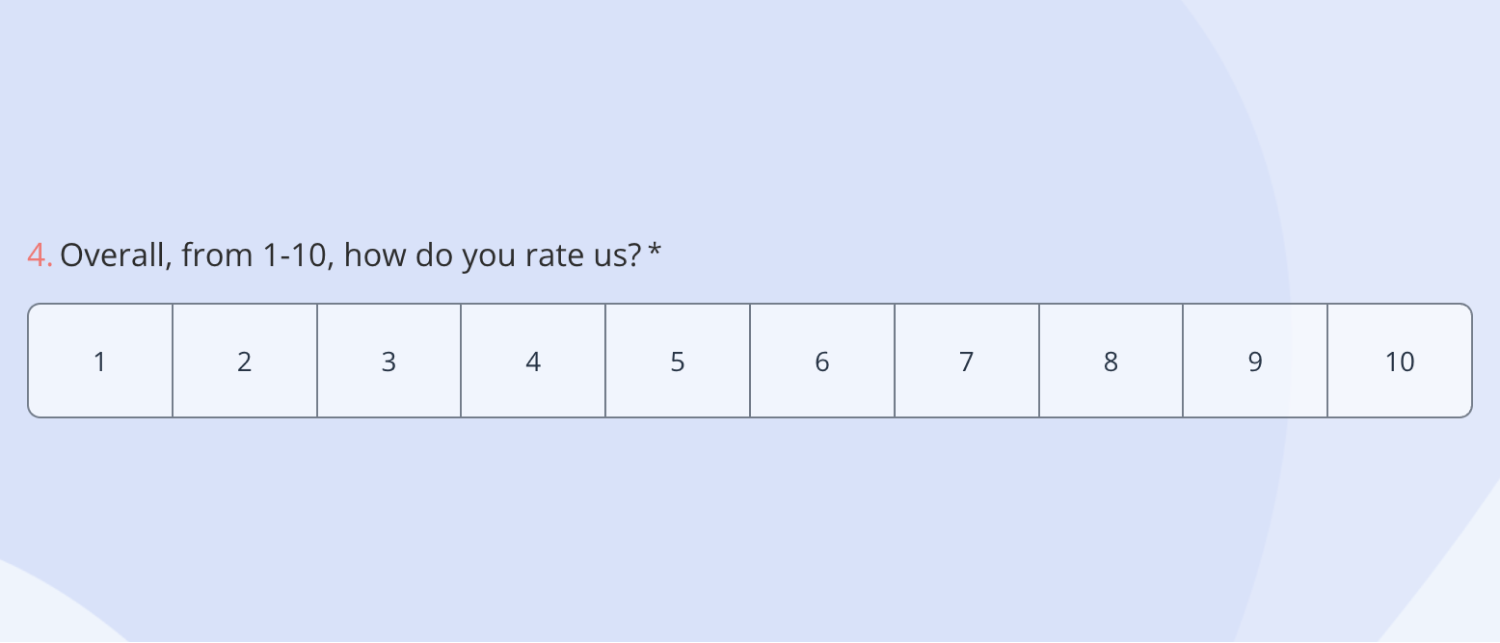
An opinion scale question example about satisfaction
Market research questions for a product
A market research question for a product is an excellent helper for companies to understand and collect data about existing. If you want to learn how your customers are satisfied with your exciting product, you only need to ask them these questions. Here are your market research questions for a product:
8. Have you ever heard of this product before?
9. From 1-10, how would you rate this product?
10. Do you believe this product is useful/helpful for you?
11. What is the likelihood of buying this product again?
- Very Likely
- Very Unlikely
12. What do you like about this product?
- It is easy to use
- It is cost-effective
- It is reliable
- It has great customer service
- It has a wide range of features
13. What do you dislike about this product?
- Functionality
14. Would you recommend this product to your friends or family?
You can replace the word “ product” with the name of your own product.
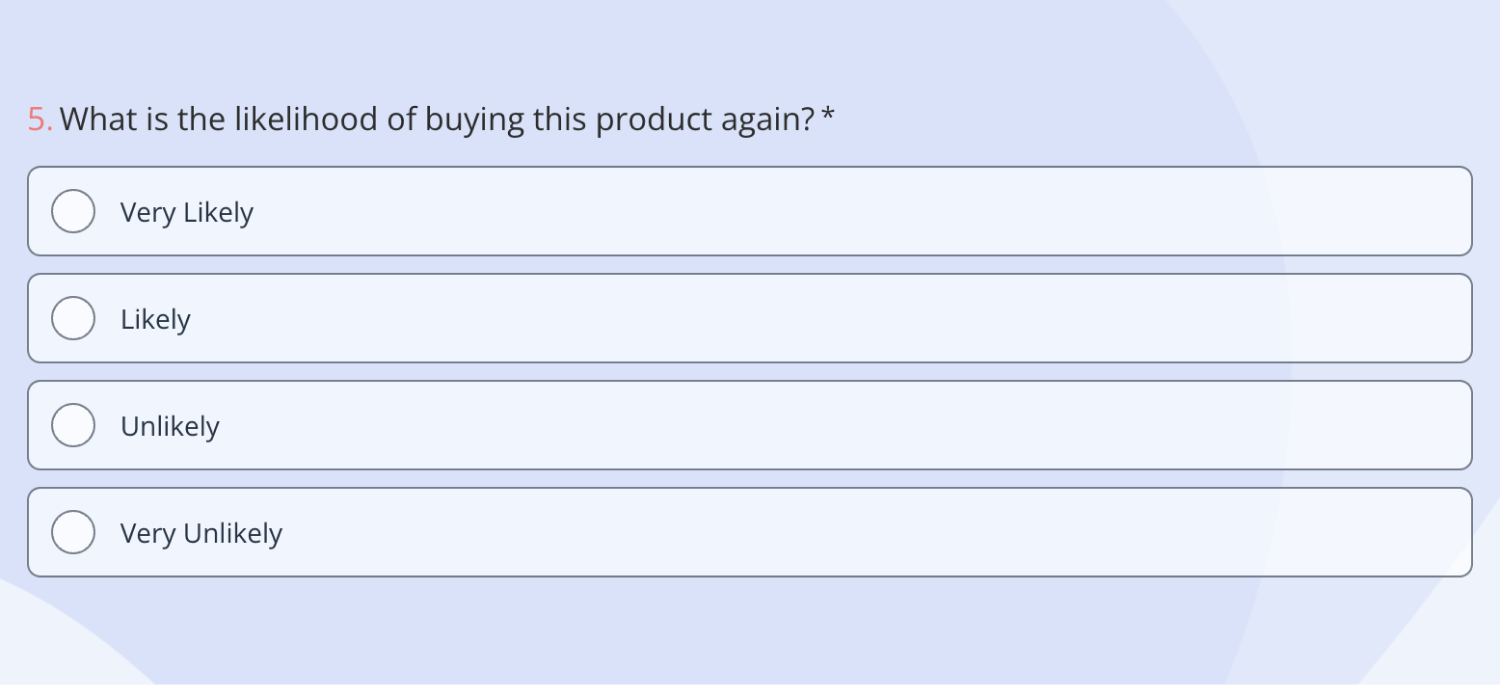
A question example about purchasing behavior
New product market research survey questions
New product market research survey questions are perfect for your company if you plan for a new product. Imagine that you are about to launch a new product. You can take fewer risks if you ask questions about the new product before launching it. So you might need these market research questionnaire questions for your new product:
15. Have you seen a similar product?
16. How likely are you to use this product for your business activities?
17. What do you think is the best feature of this new product?
18. What do you think is the least favorite feature of this new product?
19. Do you find the price reasonable?
20. Are you excited about this product?
21. Overall, from 1-10, how do you rate this new product?
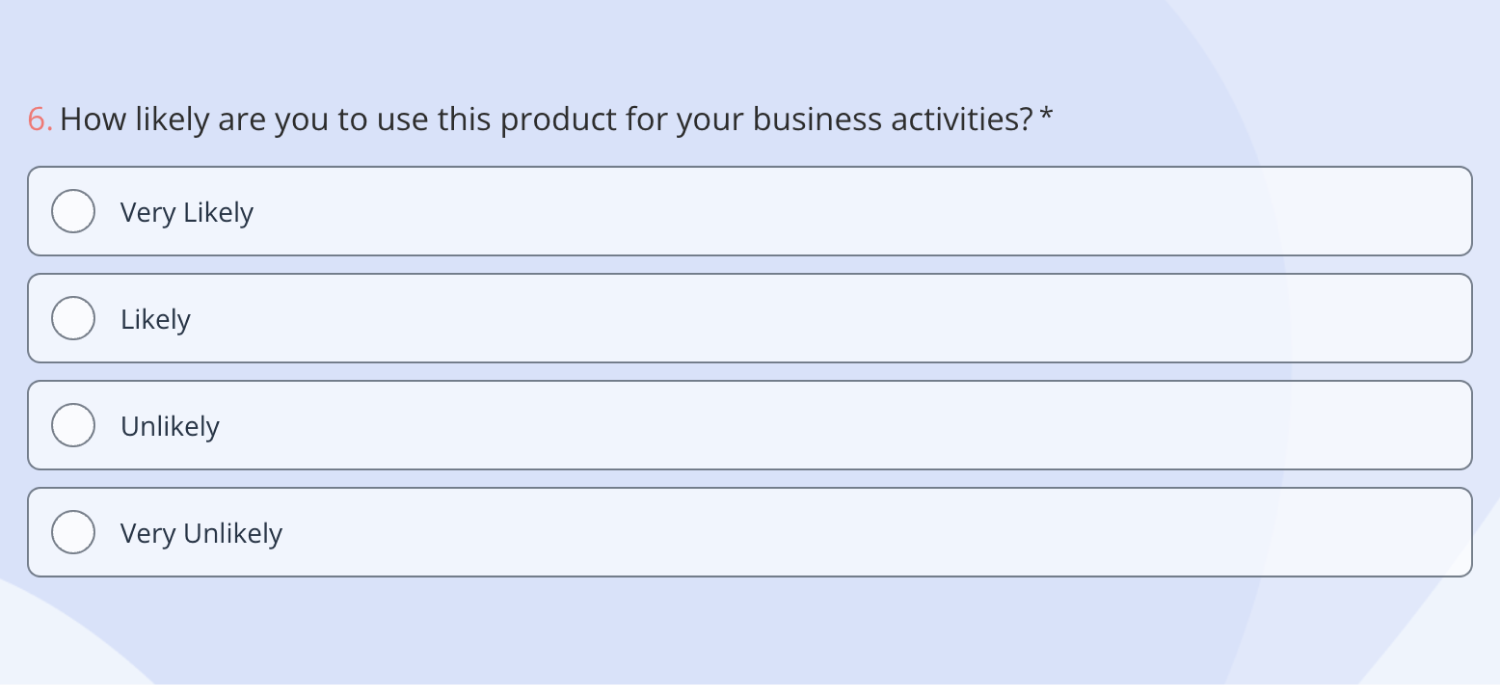
A question example about later use
Social media survey questions for market research
Social media is an excellent way of collecting helpful data from your customers because, today, nearly everybody has a social media account. You can have insightful data as long as you know which platform to use and how to use it. So, here are your social media survey questions for market research:
22. Which social media platforms do you use? ( you can choose more than 1 )
23. In which social media platforms do you spend time the most?
24. Do you follow us on your social media accounts?
25. What do you think about our company’s social media account?
- It's great!
- It could use some improvement.
- I haven't seen it
26. Do you believe we can use social media effectively?
27. What can we do to improve our social media accounts?
- Post regularly
- Run contests and giveaways
- Use relevant hashtags
- Optimize profile information
- Respond to comments
- Collaborate with influencers
28. Which influencers do you relate to us the most?
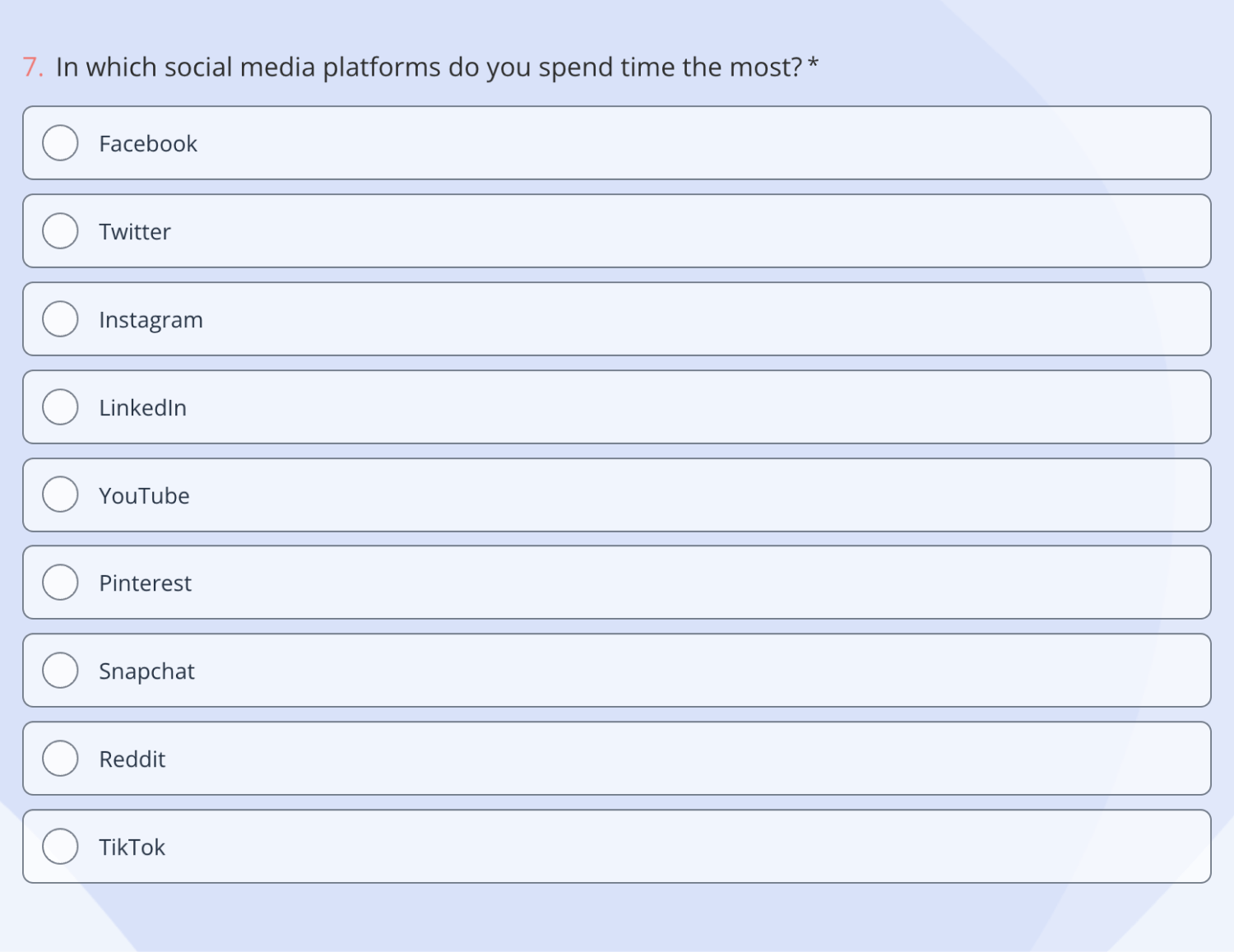
A market research survey question example about social media
Market research questions to ask potential customers
As much as trying to hold your existing customers, you should also try to find potential customers and expand your network. Because only in this way you can grow your business. When you have good market research questions to ask potential customers, as given below, you can easily get what you need:
29. Have you ever heard us before?
30. When you think of our brand, what comes to your mind first?
31. Who is our rival for you?
32. What is your minimum budget?
33. What is your maximum budget?
34. Would you consider choosing our product/service?
35. What are your best aspects, you think?
Market research questions for B2B companies
Just like any sector, B2B companies need to do their best to run market research. As for their market research survey, the questions will be different because they need to aim at businesses directly. If you need them, here are your market research questions for B2B companies:
36 . Who is your ideal customer?
37. What really matters to your ideal customer?
38. Do you think you know your customers?
39. How can you know your customers better?
40. What is your customers’ annual income?
41. What do your customers do in their free time?
42. What attracts your customer?
Demographic questions for your market research survey
Demographic questions allow your company to understand your customer’s background better. Also, if you want to understand the certain characteristics of your target audience, demographic questions are the best option for you. Have a look at these demographic questions for your market research survey:
43. What gender do you identify as?
- Genderfluid
44. How old are you?
- 65 or Above
45. What is your marital status?
46. Can you please specify your ethnicity?
- African American
- Asian American
- Hispanic/Latino
- Native American
- Pacific Islander
- White/Caucasian
47. Where are you located?
- United States
- United Kingdom
48. What is your education level?
- High School
- Associate's Degree
- Bachelor's Degree
- Master's Degree
- Doctorate Degree
49. What is your annual income?
- $0 - $25,000
- $25,001 - $50,000
- $50,001 - $75,000
- $75,001 - $100,000
- $100,001 - $150,000
- $150,001 - $200,000
- $200,001 and above
50. What is your current employment situation?
- Employed full-time
- Employed part-time
- Self-employed
- Not looking for work
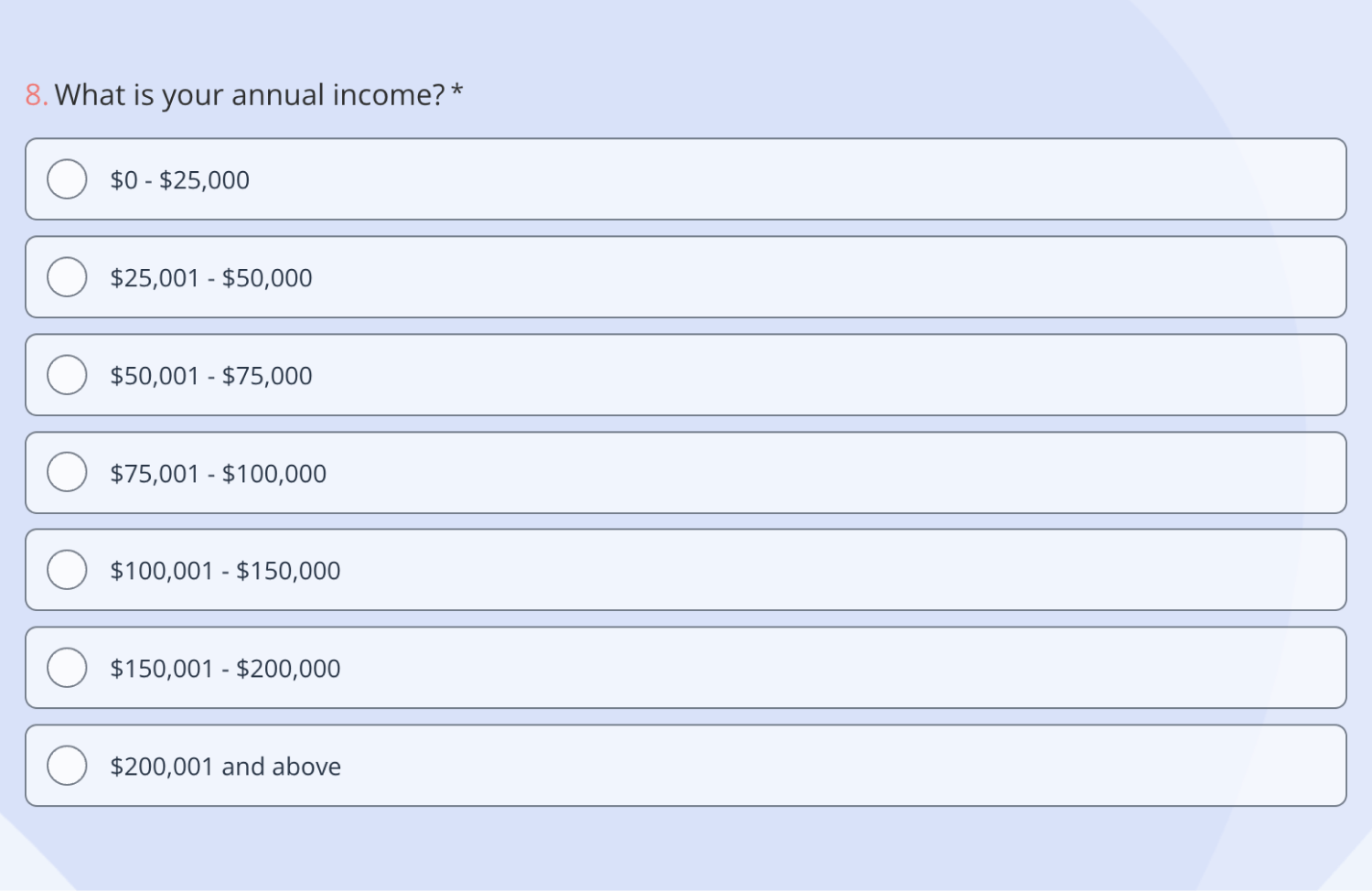
A market research survey question example about income
- How can I create a market research survey?
In order to collect essential data for your market research, if you want to handle it the fastest way, you will need an online form builder. Also, if you want to build your form with lots of options and create just like you wish and want to do all of them for free, there is only one option left: forms.app .
As long as you follow some basic steps, you can easily create your market research survey and here are the steps:
1. Login or create an account
Firstly, you should log in to your existing account if you do not have one; no worries, you can easily and quickly create an account . Also, do not forget that you have the opportunity to log in via Google, Facebook, and Apple accounts.
2. Start from scratch, choose a temple, or generate with AI
You have access to a wide range of options thanks to forms.app . You must begin from scratch if you wish to pick every aspect of your survey. The site offers pre-made market research survey templates if you do not want to spend too much time on it. However, if you stay current with the latest technology, artificial intelligence can create your survey in seconds!
3. Add your market research survey questions
Based on your company’s primary needs and essential requirements, you should choose your market research survey questions very carefully. Each company’s priorities can differ. For that reason, you need to pay attention while adding them.
4. Customize your survey form
In this step, you can easily change and personalize your online survey . To give an example, you can change the size and type of the font, colors, and order of questions, add your brand’s logo, etc.
5. Share your market research survey
In the final step, you can share your survey with your target via many platforms . You can choose the link to be public, limited, or private while sharing. Additionally, you can preview the link to see whether it has any meta titles, descriptions, or images.
- How can I write good market research questions?
One can randomly create market research questions for the survey; however, if you want to be one step ahead of your rivals and be good at writing market research questions, you need to follow the points given below:
- Consider your company’s needs : You need to have a moment and consider what your company needs the most. What are your priorities or urgent needs? Or what are your urgent deficiencies to be covered? After answering these questions, you can create better questions.
- Think like the customer: The key point is listening to your customers and trying to think like them. When you think like them, you can come up with better market research questions and collect more valuable data for your survey.
- Be direct: Questions asked directly are definitely better , instead of asking too many indirect questions or long and complex sentences that might be confusing. So, you need to pay attention at this point.
- Key points to take away
As we have discussed so far, the importance of market research is undeniable. If you want to increase your market share and be more successful in your sector, there are some key points for your company to take away. You should not ignore these points:
- Design of the survey: Do not forget that the more you pay attention to your market research survey design, the more you will seem professional.
- Pay attention to the context: Design is an important factor, but context is the exact reason you run a survey. So, you need to be careful with your questions.
- Check the result: At the end of the survey, checking and analyzing the results is a key point. If you will not do that, there is no need to share the survey, isn’t it?
Now that you have read so far, you know all the critical points about the issue and where to start. Take action now and start finding your own effective data collection methods for market research !
Şeyma is a content writer at forms.app. She loves art and traveling. She is passionate about reading and writing. Şeyma has expertise in surveys, survey questions, giveaways, statistics, and online forms.
- Form Features
- Data Collection
Related posts.
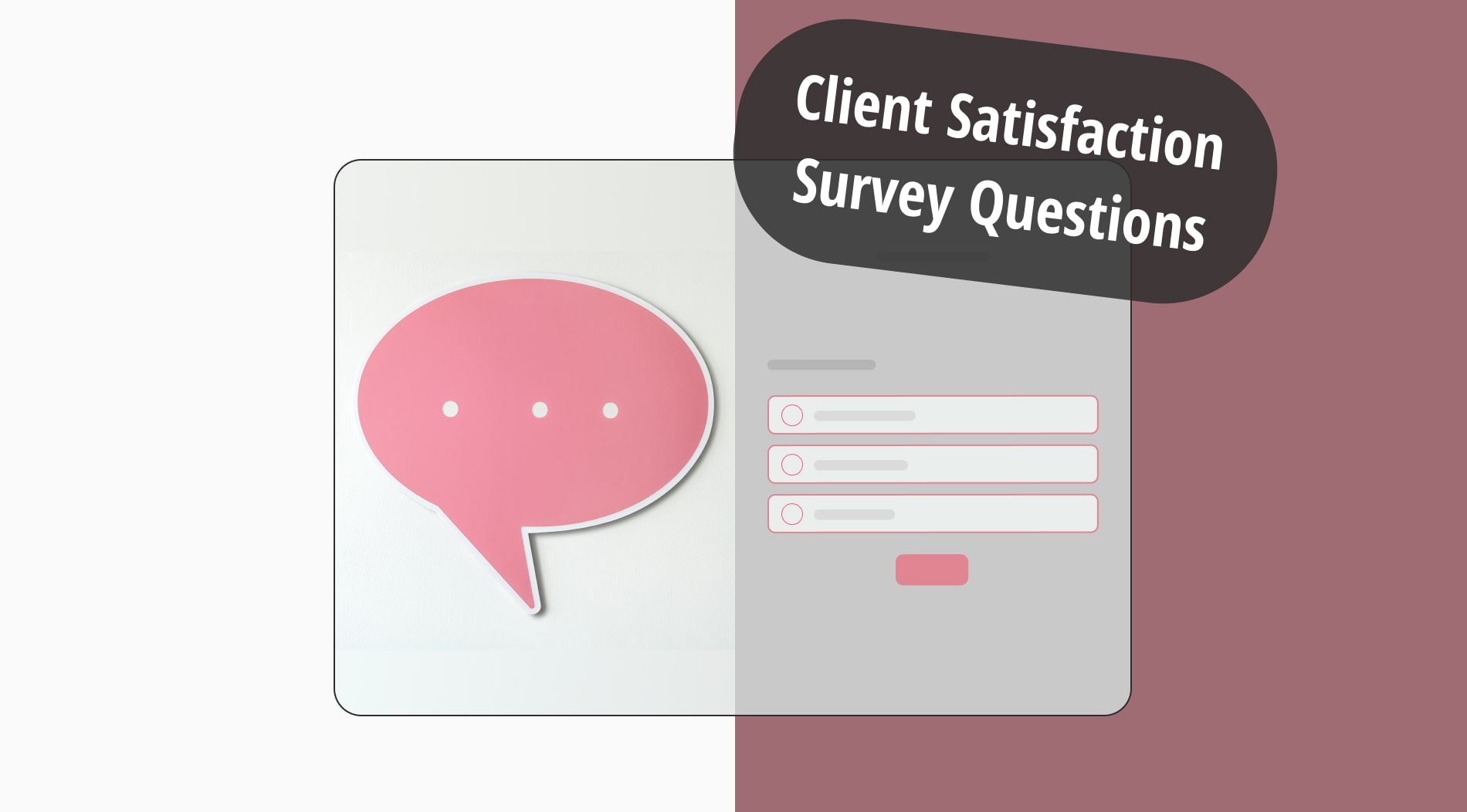
15+ Must-ask client satisfaction survey questions to ask
Defne Çobanoğlu
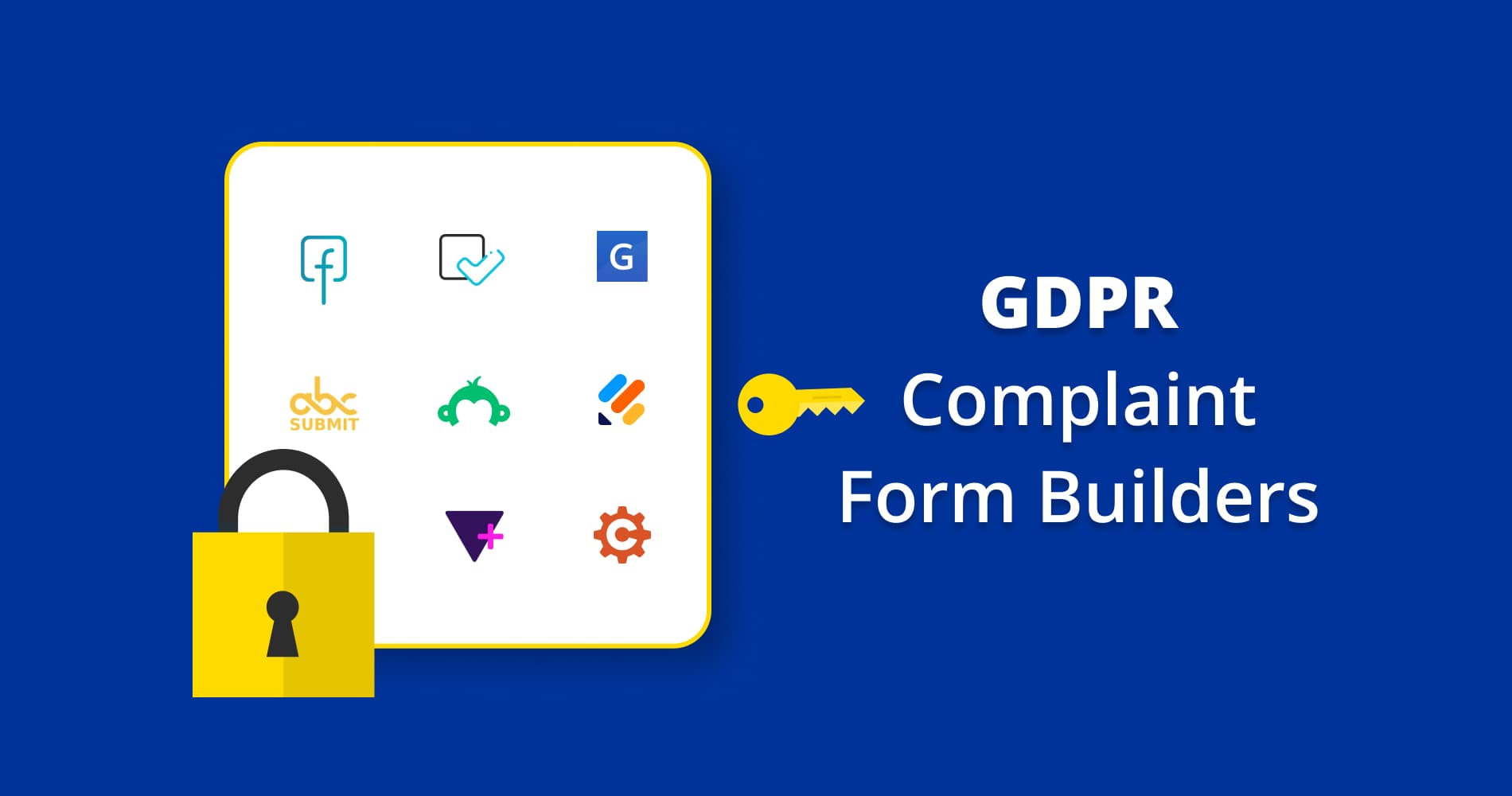
Top 10 GDPR-compliant form builders in 2022
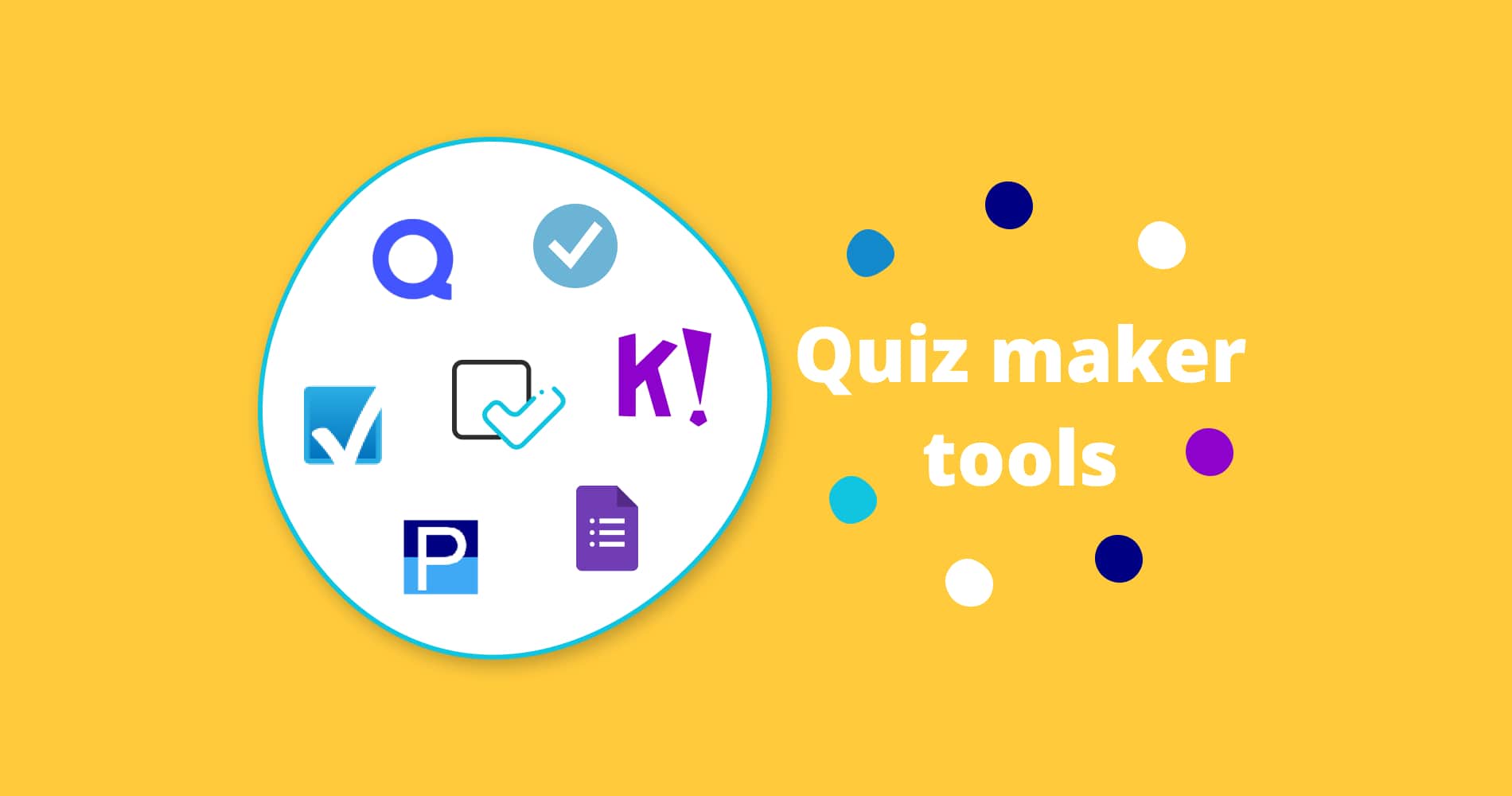
10 best online quiz maker tools
- Skip to main content
- Skip to primary sidebar
- Skip to footer
- QuestionPro

- Solutions Industries Gaming Automotive Sports and events Education Government Travel & Hospitality Financial Services Healthcare Cannabis Technology Use Case NPS+ Communities Audience Contactless surveys Mobile LivePolls Member Experience GDPR Positive People Science 360 Feedback Surveys
- Resources Blog eBooks Survey Templates Case Studies Training Help center
Home Market Research
Market Survey: Definition, Types and Examples

Market Survey Definition
Market survey is the survey research and unit of analysis of the market for a particular product/service which includes the investigation into customer inclinations. A study of various customer capabilities such as investment attributes and buying potential. Market surveys are tools to directly collect feedback from the target audience to understand their characteristics, expectations, and requirements.
LEARN ABOUT: Level of Analysis
Marketers develop new and exciting strategies for upcoming products/services but there can be no assurance about the success of these strategies. For these to be successful, marketers should determine the category and features of products/services that the target audiences will readily accept. By doing so, the success of a new avenue can be assured.
LEARN ABOUT: Market research vs marketing research
Most marketing managers depend on market surveys to collect information that would catalyze the market research process. Also, the feedback received from these surveys can be contributory in product marketing and feature enhancement.
LEARN ABOUT: Marketing Insight
Market surveys collect data about a target market such as pricing trend analysis , customer requirements, competitor analysis, and other such details.
Purpose of Market Survey
- Gain critical customer feedback: The main purpose of the market survey is to offer marketing and business managers a platform to obtain critical information about their consumers so that existing customers can be retained and new ones can be got onboard.
- Understand customer inclination towards purchasing products: Details such as whether the customers will spend a certain amount of money for their products/services, inclination levels among customers about upcoming features or products, what are their thoughts about the competitor products etc.
- Enhance existing products and services: A market survey can also be implemented with the purpose of improving existing products, analyze customer satisfaction levels along with getting data about their perception of the market and build a buyer persona using information from existing clientele database.
- Make well-informed business decisions: Data gathered using market surveys is instrumental in making major changes in the business which reduces the degree of risks involved in taking important business decisions.
LEARN ABOUT: Pricing Research
Market Survey Templates
Product Surveys : New products/concept testing survey templates offer questions to obtain insights about products and concepts. These survey questions are curated by market research experts and can help in analyzing which kind of products or features will work in a market.
Conference Feedback Surveys : Conference feedback survey templates provide questions that can be asked to participants of a conference. An organization can organize better conferences by implementing feedback received from these surveys such as enhancing overall conference management, improved IT infrastructure, better content coverage or other such factors.
Focus Group Surveys : Focus group survey templates can be implemented during and after the recruitment of the focus group. Gaining insights from a dedicated group of 8-10 people can be done easily with this existent survey template.
Hardware And Software Surveys : Hardware and software survey templates offer editable questions about software product evaluation, hardware product evaluation, pre-installation procedure, technical documentation quality and other such factors.
Website Surveys : Website survey templates are customizable as per application and consist of questions pertaining to website customer feedback, visitor profile information, online retail audit information etc.
Learn more: Market Survey Templates
Importance of Market Survey
There are 5 factors that depict the importance of a market survey.
1. Understanding the demand and supply chain of the target market: A product is most likely to be successful if it is developed by keeping in mind the demand and supply of the target market. This way, marketers can obtain insights about market capabilities to absorb new products and concepts to develop customer-centric products and features.
LEARN ABOUT: Test Market Demand
2. Developing well-thought marketing plans: The World is a target market for an organization, especially a well-established one. Getting data from the target market through thorough market research using market surveys and segmentation can be a source of creating concrete and long-term marketing plans.
3. Figure out customer expectations and needs: All marketing activities revolve around customer acquisition. All small and large organizations require market surveys to gather feedback from their target audience regularly, using customer satisfaction tools such as Net Promoter Score , Customer Effort Score , Customer Satisfaction Score (CSAT) etc. Organizations can analyze customer feedback to measure customer experience, satisfaction, expectations etc.
4. Accurate launch of new products: Market surveys are influential in understanding where to test new products or services. Market surveys provide marketers a platform to analyze the scope of success of upcoming products and make changes in strategizing the product according to the feedback they receive.
5. Obtain information about customer demographics: Customer demographics form the core of any business and market surveys can be used to obtain intricate and sensitive details about customer demographics such as race, ethnicity or family income.
Types of Market Survey with Examples
Multiple types of market surveys are used by enterprises to collect data depending on the objective of their market research . The information collected can be used to study various aspects of the market to address topics such as the right time to launch the product/service, to understand the trends in the market, to measure customer loyalty, to study their competitors and many more.
There are various types of market surveys out of which we will talk about the top 10 to get information from customers about their demands, expectations and what they opine about the competitors. Each one of these market surveys has a different approach and has a marking impact on the various aspects of a business.
LEARN ABOUT: Performance Appraisal Survey
In order to conduct various types of market surveys, successful enterprises in today’s world, use powerful market research survey software to get actionable market insights through real-time data collection and robust analytics. Following are the top 10 types of market surveys that are conducted by successful enterprises.
1. Market Surveys for segmentation: An organization can spot existing and prospective customers and understand why the customers have chosen their products/services and the prospects have not yet made a purchase. This can lead to a structured market segmentation and analysis.
2. Market Surveys for exploring various aspects of the target market: Get information about factors such as market size, demographic information such as age, gender, family income etc. to lay out a roadmap by considering growth rate of the market, positioning, and average market share.
3. Market Surveys to probe into purchase procedure: How does a customer deciding on making a purchase? What are the factors that convert product awareness into sales? This type of market survey will unveil awareness, information, free trial, purchase, and repeat.
4. Market Surveys to establish buyer persona: These surveys are to build a buyer persona by knowing about customer preferences, inclination, and capabilities of purchasing a product.
5. Market Surveys to measure customer loyalty: What is the degree of loyalty that the customers have towards and organization? The answer to this question can be obtained by conducting a market survey.
6. Market Surveys to analyze a new feature or concept: It is essential for an organization to include market-compliant features and concepts. By carrying out a market survey to understand which features to launch, will help all the teams involved in the feature development process to do that with proper research.
7. Market Surveys for competitor analysis: Healthy competition is always good for an organization’s progress. Market surveys done with the motive of competitor analysis will produce results about how does the target market weigh the organization’s products/services in comparison to the others in the market.
8. Market Surveys to understand the impact of sales activities: Sales activities are the backbone of an organization and it becomes crucial to keep track of these activities. Market surveys for sales activities will produce a report of the impact of sales activities, whether their frequency needs to increase or any changes the audiences think should be inculcated in the sales process.
9. Market Surveys to assess prices for new products/services: Affordability of products also is an aspect that drives the market for organizations. Price ranges, product variants to cater multiple price ranges, target customers for each of the products etc.
10. Market Surveys for evaluation of customer service: Good customer service can lead to enhanced satisfaction levels among customers. Factors such as time taken to resolve issues, the scope of improvement, best practices of customer service etc.
LEARN ABOUT: Average Order Value
Learn more: Gym Survey Questions + Sample Questionnaire Template
MORE LIKE THIS

Exploring Top 15 Data Analysis Tools to Elevate Your Insights
Mar 13, 2024
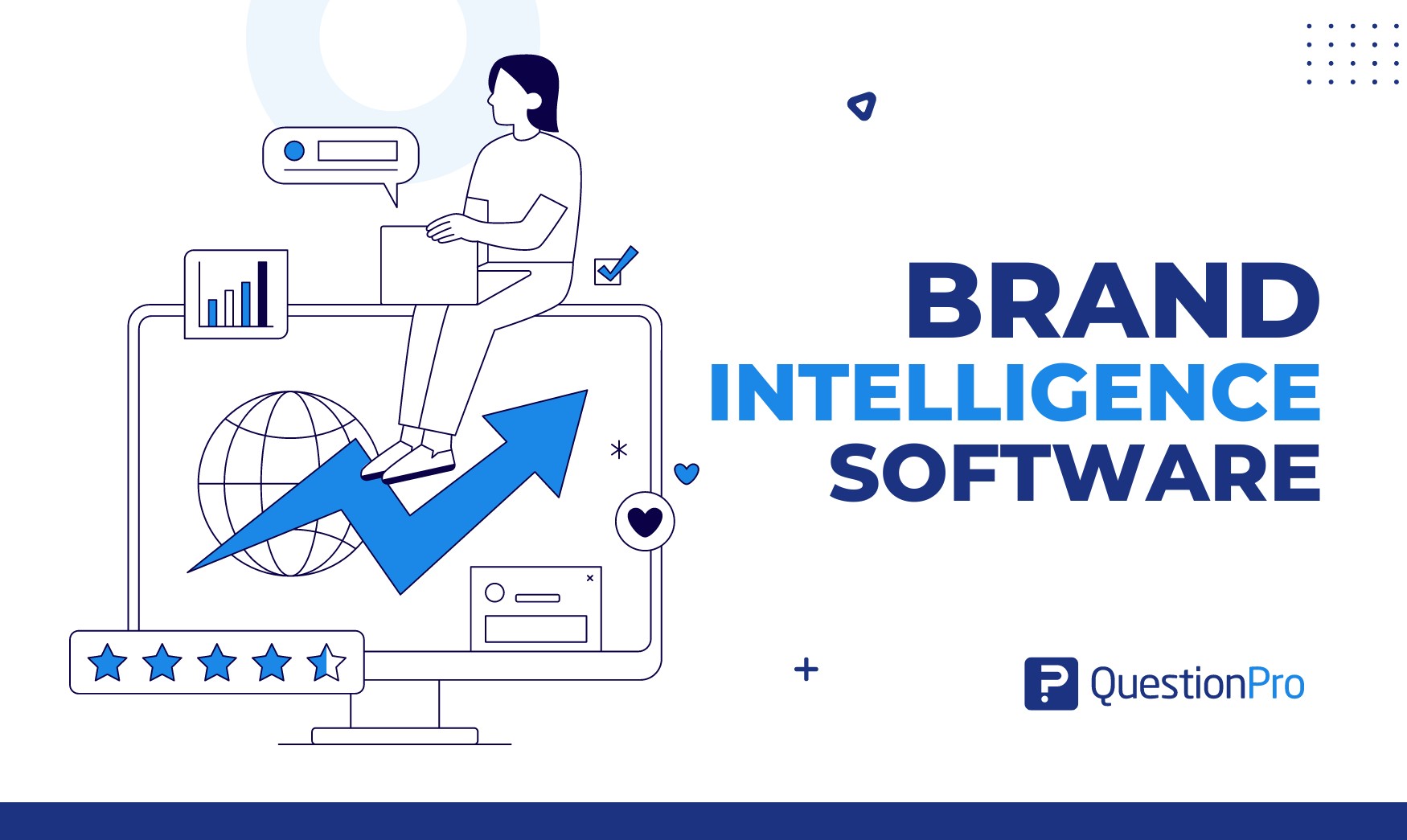
Top 10 Best Brand Intelligence Software in 2024
Mar 12, 2024
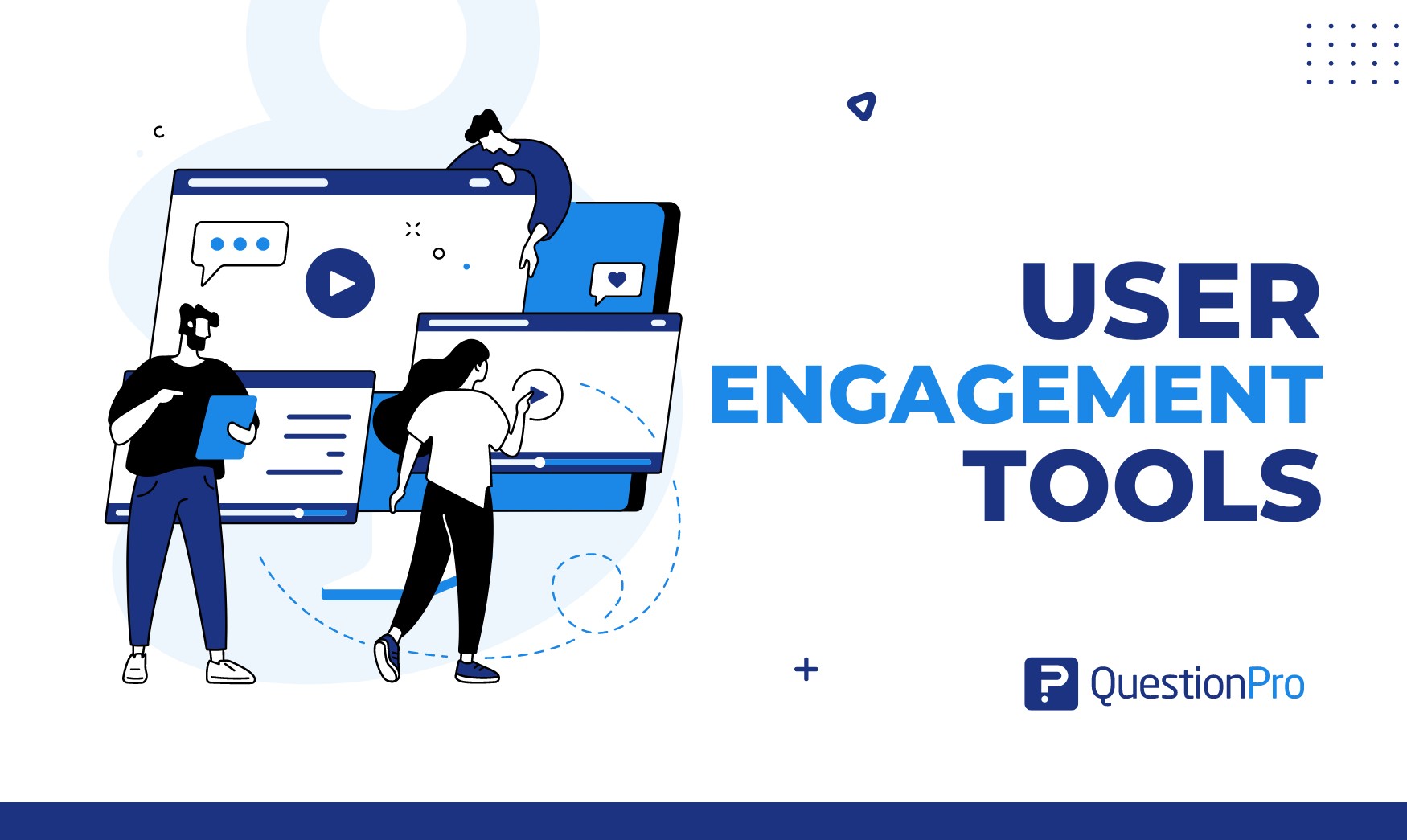
Top 11 Best User Engagement Tools in 2024
Mar 11, 2024

AI in Healthcare: Exploring ClinicAI + FREE eBook
Mar 6, 2024
Other categories
- Academic Research
- Assessments
- Brand Awareness
- Case Studies
- Communities
- Consumer Insights
- Customer effort score
- Customer Engagement
- Customer Loyalty
- Customer Research
- Customer Satisfaction
- Employee Benefits
- Employee Engagement
- Employee Retention
- Friday Five
- General Data Protection Regulation
- Insights Hub
- Life@QuestionPro
- Mobile diaries
- Mobile Surveys
- New Features
- Online Communities
- Question Types
- Questionnaire
- QuestionPro Products
- Release Notes
- Research Tools and Apps
- Revenue at Risk
- Survey Templates
- Training Tips
- Uncategorized
- Video Learning Series
- What’s Coming Up
- Workforce Intelligence
- SUGGESTED TOPICS
- The Magazine
- Newsletters
- Managing Yourself
- Managing Teams
- Work-life Balance
- The Big Idea
- Data & Visuals
- Reading Lists
- Case Selections
- HBR Learning
- Topic Feeds
- Account Settings
- Email Preferences
Put Marketing at the Core of Your Growth Strategy
- Marc Brodherson,
- Jennifer Ellinas,

Three ways to use marketing as a lever for growth, according to McKinsey research.
Companies that make the decision to put marketing at the core of their growth strategy outperform the competition, according to McKinsey research. Specifically, both B2C and B2B companies who view branding and advertising as a top two growth strategy are twice as likely to see revenue growth of 5% or more than those that don’t (67% to 33%). Yet their research also showed that few CEOs recognize the potential for marketing as a growth accelerator. They recommend three actions for CEOs to hit the reset button. The first is to define what you need from marketing. While it sounds obvious, their research found that more than half the time CEOs and CMOs in the same company were misaligned on marketing’s primary role. Second, nominate one person to serve as the chief voice of the customer. In two many organizations this is fragmented, and when everyone owns the customer, then no one does. Third, the CEO should function as a growth coach. They should have a handle on the challenges and opportunities of modern marketing, but their job is to draw up the strategy, not toss the ball down the field.
Growth is a perpetual business priority. So it’s imperative that CEOs understand how their marketing function and chief marketing officers (CMOs) can contribute to that goal. Few do — and that misalignment can be costly.
- Marc Brodherson is a senior partner in McKinsey & Company’s New York office.
- Jennifer Ellinas is an associate partner in McKinsey & Company’s Toronto office.
- Ed See is a partner in McKinsey & Company’s Stamford, Connecticut office.
- Robert Tas is a partner in McKinsey & Company’s Stamford, Connecticut office.
Partner Center
Survey monitor march/april 2024.
A collection of recent employee research, small business and education research surveys.
••• employee research
Education vs. experience
Employees feel unprepared to enter the workforce.
When it comes to transitioning into the workforce, e-learning provider Go1 found that 46% of employees believe university failed to prepare them for their current jobs, with 61% saying previous work experience best prepared them for their current positions. This was followed by formal on-the-job training (41%) and life experience (37%).
When asked what they wish they had known before entering the workforce, 50% of employees said they would have liked to know how to approach career progression, the fundamentals of the role (32%) and how to collaborate with people in other departments (31%).
When deciding where to work or whether to stay at a job, 66% of employees say learning and development opportunities are essential and valuable. While increasing their salary potential is the top motivator to acquire new skills for Gen Z employees (45%), general personal development is the top motivator for Baby Boomer (62%), Gen X (55%) and Millennial (51%) employees.
Seventy-three percent of employees believe that their current employer offers learning and development programs that adapt to or accommodate their specific needs. In fact, over half (59%) feel empowered to ask for better learning and development programs suited to their specific needs.
However, organizations approaching learning and development as a “box-ticking exercise” is the biggest frustration for employees (30%), followed by learning content that is boring (27%), not personalized (24%) or too long (24%). In addition, employers may not be giving their employees enough growth opportunities, with 44% agreeing that their organization doesn’t make the most of its potential for upskilling and growth.
Organizations are effectively creating opportunities for people to work and learn with different age groups, with 46% agreeing they have opportunities to do so often. Learning from their wealth of experience (60%), having more diverse perspectives (59%) and the opportunity to learn from them (57%) are the top benefits of a generationally diverse team.
When asked about the downsides of working with people from different age groups, people stuck in their own ways (45%) and different work ethics (41%) were considered the top drawbacks. Fifty-three percent also believe they learn differently compared to work in other age groups at the company.
As AI technology continues to permeate businesses and industries, employees are leaning towards optimism when it comes to the impact on their work and ability to learn. Forty-eight percent of employees are open to using AI-generated learning materials or using AI tools to help them learn, while 45% of employees agree or completely agree that AI will help them develop skills needed in the workplace more quickly.
In addition, using generative AI (44%) and finding information more quickly (46%) were named the top skills needed to stay ahead of the AI curve. Younger workers are more likely to see AI as critical to their development, with Gen Z employees (31%) and Millennials (31%) looking to generative AI as the only learning tools they need, compared to 18% of Gen X and 12% of Baby Boomer employees.
The Go1 survey was conducted by Method Research and distributed by PureSpectrum among 3,000 adults aged between 18-75 who work full-time at office/desk-sitting jobs across Australia, the U.S. and the U.K.
••• small business research
Lagging behind
Shoppers need up-to-date technologies.
Small businesses lack the convenience Gen Z and Millennials expect, according to website services company GoDaddy. Ninety-one percent of U.S. small business survey respondents say they offer customers a convenient online experience yet only 21% of consumers – and just 19% of Gen Z – feel that's the case.
While small businesses identified Gen Z and Millennials as top target audiences, their current practices tend to cater more to older generations. Gen Zs (73%) and Millennials (75%) say they would shop more at small businesses if they offered the same convenience as larger chain stores.
Seventy-three percent of Gen Z and 83% of Millennials enjoy a "buy online, pick up in-store" option but only 34% of small businesses offer it. Eighty-five percent of Gen Z and 82% of Millennials want small businesses to accept contactless digital payments, yet 27% of small businesses do not accept them.
Unsurprisingly, 90% of consumers say it's important that small businesses offer free shipping, yet 38% of small businesses do not. Eighty-nine percent say small businesses should have websites, as Gen Z (55%) and Millennials (61%) would make purchases from it. However, many small businesses indicate not having a website (24%) or an online store (28%).
The overwhelming majority of young consumers (80% of Gen Z and 75% of Millennials) say it's crucial for small businesses to have storefronts linked to their social pages for easy shopping. Small businesses say they are primarily using their social accounts for brand awareness over sales. Only 25% use social media to sell physical products and 19% use it to sell digital products. Forty-one percent of Gen Z and 43% of Millennials have followed a brand on social media for a discount but 47% of small businesses don’t offer discount codes when someone follows them.
Although nearly all small businesses (91%) agreed it's important to make sure their business is keeping up with tech innovations, they are not quite meeting the high expectations of an increasingly tech-savvy consumer base. When using a debit or credit card, a greater percentage of younger consumers say they prefer paying via tap-to-pay compared to older generations (50% of Gen Z, 31% of Millennials, 23% of Gen X and 18% of Baby Boomers).
When asked if it's important that small businesses accept contactless digital payments, Gen Z (85%) and Millennials (82%) took the lead. Sixty-seven percent of Gen X and 40% of Baby Boomers believe contactless payments are needed while 33% of Gen X and 60% of Baby Boomers do not think they are important.
This survey was conducted with 1,000 U.S. consumers and 1,000 U.S. small business owners.
••• education research
Looking beyond tuition
Students and parents evaluate higher-ed options .
Despite many media narratives blaming the rising cost of college for the public’s disillusionment with higher education, marketing firm Spark451 found that while money was an influencing factor in the college decision process, it wasn’t the most important one.
The leading deciding factor for parents and students when making their college decision was academic quality with cost/financial aid coming in second. When asked if the college their child selected was the most affordable, 56% of parents said no. Thirty percent said they would have encouraged their child to select a different school if money were not a factor. Fifty-five percent of students applied to schools because they received an application fee waiver and 45% applied to the same number of institutions, even if they weren’t offered waivers. Sixty-five percent of parents said they would not make a college decision based on a state’s political stance while 50% of students said a state’s political leanings would influence their choice.
Students listed e-mails as their preferred method of communication with an institution, with text messaging ranking second. Despite this preference, many students say they don’t open e-mails that are sent to them. Twenty-seven percent of students say they didn’t open e-mails because they look generic and not personalized. Fifty-nine percent believe they would open an e-mail from a school they did not know if the topic or offer presented was of interest to them. When asked which print materials influenced them the most, students said personalized letters were the most effective, followed by personalized brochures. Parents answered the same.
High school students began the college search process during their junior year, giving them considerable time to view a variety of materials and to form strong opinions on the marketing tactics they had seen. When it comes to selecting the right college, high school seniors and their parents conduct different kinds of research. When seeking information about a preferred university or looking for answers to a question about an institution, the most accessed source was the college’s website. Throughout the college selection process, students were more likely to utilize Instagram as their preferred social media outlet and parents were most likely to use Facebook. Eighty-four percent of students said that visiting campus was a part of their college search process.
This survey was conducted in the summer of 2023 among a randomized selection of high school seniors and parents of graduating high school seniors across the U.S.
••• travel research
Bleisure travel takes off
Accurate recordkeeping, not so much.
Despite rocky economic conditions and pressures within organizations to cut down on travel costs, business travel is making an unexpected and robust comeback. According to software and business services company Capterra, 46% of business travelers report going on more trips than before the pandemic. On average, they travel six times a year, with trips lasting about three days.
Seventy-one percent of companies indicated having spent over $10,000 on business travel in 2022. Increased travel expenses underscore the importance of accurate reporting, as manual tracking leads to errors and fraud that can cost thousands or even millions of dollars. Ninety-two percent of travelers encountered issues with expense reporting, with 90% admitting to making mistakes during the process. While technology adoption is evident with over half of travelers using mobile apps (53%) or software (51%), 42% still track receipts manually. Forty-seven percent of respondents use spreadsheets, 35% use third-party services and 30% use automated expense reports.
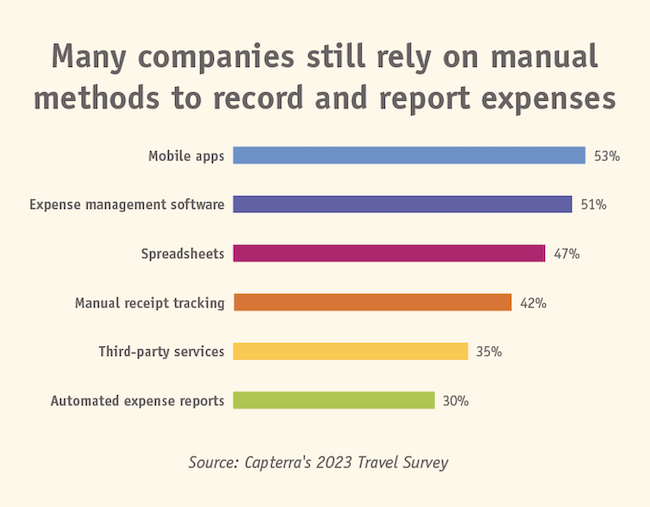
Business travelers report numerous mistakes with manual entry including missing receipts (41%), incomplete information (29%), duplicated expenses (24%) and miscategorized expenses (21%). Twenty percent admit they’ve submitted reports that don’t meet company policies and 18% say they struggle with following and understanding their company expense policies.
Even with the rising costs and potential financial errors, travel is necessary for business growth, especially as businesses move to in-person and hybrid models and therefore want more in-person meetings. In fact, over half of travelers schedule their trips for client meetings (52%), as well as networking conferences (52%), training (50%) and trade shows (31%).
As an added benefit, almost all (93%) business travelers say they merge personal vacation time with work trips, which may help boost morale and decrease burnout from frequent traveling. Travelers are largely driven by the need for work-life balance (52%). Employees say they visit historical sites (31%), catch up with friends and family (30%) and attend cultural events (25%) during their off time.
Capterra’s Travel Survey was conducted in July 2023 among 398 business travelers in the U.S.
••• generational research
Grandpa’s got this
Boomers embracing, advocating for new tech.
Despite Baby Boomers’ affluence and affinity for technology and digital experiences, just 6% of marketers identify the cohort as a part of their marketing initiatives, with most opting to “age down” their brand. According to the findings from marketing agency Razorfish, marketers may be neglecting some of their wealthiest potential customers who have the promise to become loyal and enthusiastic brand advocates.
Most Baby Boomers (70%) are curious about new technology and devices and are eager to learn how to use them either by reading about them in the news or trying them out for themselves. They are most interested in devices like laptops, smartphones, smart doorbells, locks and security cameras.
More notably, Baby Boomers (70%) aren’t intimidated or overwhelmed by new technology. They also serve as the biggest advocates for products with more than 30% stating that they love sharing new technology and apps with people close to them.
Technology enriches the full scope of their lives. Baby Boomers value technology’s assistance in many aspects of their lives, believing that it is most important when managing their money (73%), staying informed on current events (69%), keeping their homes secure (59%), for entertainment purposes (58%) and when shopping for products (57%).

Baby Boomers do not rely on younger generations to evaluate the best products and applications. Most will take the initiative to visit brands’ websites (71%) and read reviews online (56%) when making new purchases.
Online tools and positive digital experiences are a significant part of the shopping journey. Nearly three-in-four Baby Boomers research major purchases like kitchen appliances and other expensive devices online and one-in-four eventually buy these products online. While the majority still make large purchases in person, they are open to moving this experience online.
Despite common misconceptions, gamification is a key consideration in how Baby Boomers evaluate digital experiences. They expect mobile apps to be fun, intuitive and personalized and are likely to abandon apps that don’t meet these criteria or are too complicated and lack guidance. Their favorite brands also align with younger generations, with Baby Boomers more likely to shop on Amazon (80%) than Gen Z (62%) and Millennials (70%).
Razorfish partnered with GWI to conduct this survey with 1,003 U.S.-based Baby Boomer respondents.
••• health care research
For some patients, AI is not OK
Lack of trust leads to tech limitations.

The health care industry benefits greatly from AI but to successfully integrate it into business operations, it must be understood by patients and health care practitioners. Carta Healthcare found that on average, three-in-four Americans do not trust AI in a health care setting. Nearly four-in-five patients in the U.S. report not knowing if their provider is using AI when in reality, 100% of health care providers are using AI and have been for a long time. This discrepancy illustrates the public’s misperception of the use of this technology, which is made evident by the 43% of respondents who admit there are limitations in their understanding of it.
Most Americans are unaware of AI usage and consider disclosure important. While most respondents don’t know whether their health care providers use AI, they are torn about whether they would be comfortable with it – 49% say yes and 51% say no – even if it would help improve diagnostic accuracy (51% say yes, 42% say no). Two-in-five agree that their health care provider can provide better information than AI tools and one-in-three feel that AI tools can provide the same level of information as their health care provider. Twenty-five percent of respondents say that AI tools can provide better information than their health care provider.
Regardless of actual usage, there is still disbelief and concern. Sixty-one percent trust that their provider would be able to use it properly, while 63% are concerned that the increased use of AI puts health care data at risk. Sixty-three percent are also worried that the use of AI may lead to less face-to-face time with their health care provider.

Patients need disclosure; the vast majority (80%) report that their knowledge of AI use within a practice is important for improving their comfort. Trust in AI is low, but Americans are willing to educate themselves.
The survey also indicates low sentiment from health care consumers in terms of trusting and understanding AI. Only 38% of Americans trust AI and 57% feel they have a good understanding of it and how it’s used in health care. However, Americans are open to learning more and indicate that a better understanding of it may improve their level of trust and comfort. Forty-seven percent feel that if they were to learn about it, they would be more likely to trust it. Sixty-five percent reported that if they were to have an explanation of the use in AI from their health care providers, it would make them more comfortable with it.

Forty-six percent say health care visits have gotten longer in the last two years and three-fifths believe that AI could be useful to assist with the shortage of health care workers.
Carta Healthcare, in partnership with Prosper Insights, commissioned an online survey of 1,027 U.S. consumers between August 18-29, 2023.
Quirk's Time Capsule – March/April 2000 Related Categories: Research Industry, Shopper Insights Research Industry, Shopper Insights, Environmental, Internet/Web, Marketing Research-General, Media, Media Research-Radio, Media Research-Television, Online Research
Understanding travel retail and considering consumer preferences Related Categories: Travel, Air Travelers, Shopper Insights Travel, Air Travelers, Shopper Insights, Consumer Research, Consumers, Retailing, Virtual Reality
Machine learning and journey mapping results in 133 customer needs Related Categories: Health Care (Healthcare), Research Industry, Health Care (Healthcare) Research Health Care (Healthcare), Research Industry, Health Care (Healthcare) Research, Artificial Intelligence / AI, Marketing Research-General, Patients
What consumers value most in battery electric vehicles and brand relationships Related Categories: High-Tech, Research Industry, Shopper Insights High-Tech, Research Industry, Shopper Insights, Automotive, Attitude/Usage Studies, Brand Identity, Brand Loyalty Studies, Consumer Research, Consumers, Media
- Main navigation
- Main content
- Employer firms
- Nonemployer firms
- Minority-owned firms
- Women-owned firms
- Rural firms
- Startup firms
- All small business categories
- Fintech lending
- Natural disasters
- All survey years
- SBCS reports
- All research types
- Methodology
- Questionnaires
- Become a partner
- Partner organizations
- About Fed Small Business
- Important dates

2024 Report on Employer Firms : Findings from the 2023 Small Business Credit Survey
While firm revenue and employment growth held mostly steady year-over-year, most firms—more than 9 in 10—experienced either a financial or operational challenge in 2023. With respect to financing, the share of firms that applied for loans, lines of credit, or merchant cash advances declined year over year, though approvals remained little changed.
The 2023 Small Business Credit Survey (SBCS) shows signs of a further waning of the effects of the COVID-19 pandemic on firms, as challenges closely associated with the pandemic—like supply chain issues—eased between 2022 and 2023. Measures of firm performance remained elevated well above pandemic-era lows and remained steady year-over-year but lagged prepandemic levels.
Small businesses continued to face operational and financial headwinds. Firms experienced challenges with rising costs and paying operating expenses in the year leading up to the survey, which was fielded from September to November of 2023. And, while the share of firms reporting challenges with hiring or retaining qualified staff declined between 2022 and 2023, it remained the most common operational challenge.
With respect to financing, the share of firms that applied for loans, lines of credit, or merchant cash advances declined slightly between 2022 and 2023. Approvals remained mostly steady; applicants at small banks, credit unions, and finance companies were more likely to be approved for at least some financing than applicants at other sources. Applicants at small banks and credit unions were most satisfied with their experiences, while online-lender applicants were least satisfied.
Along with details on firm performance and financing, this report includes findings related to a series of special questions on payments, COVID-19 Economic Injury Disaster Loan debt, and businesses’ relationships with financial services providers.
Suggested Citation
“2024 Report on Employer Firms: Findings from the 2023 Small Business Credit Survey.” 2024. Small Business Credit Survey . Federal Reserve Banks. https://doi.org/10.55350/sbcs-20240307
February Jobs Report U.S. Hiring Remains Strong
The labor market showed resiliency in February, adding 275,000 jobs, a sign that economic growth is still solid.
- Share full article
Monthly change in jobs
+275,000 jobs
in February
+300,000 jobs
Feb. ’23
Feb. ’24
Lydia DePillis
U.S. employers added 275,000 jobs last month.
If the economy is slowing down, nobody told the labor market.
Employers added 275,000 jobs in February, the Labor Department reported Friday, in another month that exceeded expectations.
It was the third straight month of gains above 200,000, and the 38th consecutive month of growth — fresh evidence that after surging back from the pandemic shutdowns, America’s jobs engine still has plenty of steam.
“We’ve been expecting a slowdown in the labor market, a more material loosening in conditions, but we’re just not seeing that,” said Rubeela Farooqi, chief economist at High Frequency Economics.
The previous two months, December and January, were revised down by a combined 167,000 jobs, reflecting the higher degree of statistical volatility in the winter months. That does not disrupt a picture of consistent robust increases, which now looks slightly smoother.
At the same time, the unemployment rate, based on a survey of households, increased to a two-year high of 3.9 percent, from 3.7 percent in January. A more expansive measure of slack labor market conditions, which includes people working part time who would rather work full time, has been steadily rising and now stands at 7.3 percent .
The unemployment rate was driven by people losing or leaving jobs as well as those entering the labor force to look for work. The labor force participation rate for people in their prime working years — ages 25 to 54 — jumped back up to 83.5 percent, matching a level from last year that was the highest since the early 2000s.
Average hourly earnings rose by 4.3 percent over the year, although the pace of increases has been fading.
“We’ve recently seen gains in real wages, and that’s encouraged people to re-enter the labor market, and that’s a good development for workers,” said Kory Kantenga, a senior economist at the job search website LinkedIn. As wage growth slows, he said, the likelihood that more people will start looking for work falls.
As late as last fall, economists were predicting much more modest employment increases, with hiring concentrated in a few industries. But while some pandemic-inflated industries have shed jobs, expected downturns in sectors like construction haven’t materialized. Rising wages, attractive benefits and more flexible work schedules have drawn millions of workers off the sidelines.
Elevated levels of immigration have also added to the labor supply. According to an analysis by the Brookings Institution , the influx has approximately doubled the number of jobs that the economy could add per month in 2024 without putting upward pressure on inflation, to between 160,000 and 200,000.
Health care and government again led the payroll gains in February, while construction continued its steady increase. Retail and transportation and warehousing, which have been flat to negative in recent months, picked up.
No major industries lost a substantial number of jobs. Credit intermediation continued its downward slide — that sector, which mostly includes commercial banking, has lost about 123,000 jobs since early 2021.
That doesn’t mean the employment landscape looks rosy to everyone. Employee confidence, as measured by the company rating website Glassdoor , has been falling steadily as layoffs by tech and media companies have grabbed headlines. That’s especially true in white-collar professions like human resources and consulting, while those in professions that require working in person — such as health care, construction and manufacturing — are more upbeat.
“It is a two-track labor market,” said Aaron Terrazas, Glassdoor’s chief economist, noting that job searches are taking longer for people with graduate degrees. “For skilled workers in risk-intensive industries, anyone who’s been laid off is having a hard time finding new jobs, whereas if you’re a blue-collar or frontline service worker, it’s still competitive.”
The last few months have been studded with strong economic data, leading analysts surveyed by the National Association for Business Economics to raise their forecasts for gross domestic product and lower their expectations for the trajectory of unemployment. It’s occurred even as inflation has eased, leading the Federal Reserve to telegraph its plans for interest rate cuts sometime this year, which has raised growth expectations further.
Mervin Jebaraj, director of the Center for Business and Economic Research at the University of Arkansas, helped tabulate the survey responses. He said the mood was buoyed partly by fading trepidation over federal government shutdowns and draconian budget cuts, after several close calls since the fall. And he sees no obvious reason for the recovery to end soon.
“Once it starts going, it keeps going,” Mr. Jebaraj said. “You had this external stimulus with all the trillions of dollars of government spending, Now it’s sort of self-sustaining, even though the money’s gone.”
Talmon Joseph Smith
A look ‘under the hood’ reveals both strength and caution signs in the report.
When the government releases employment data each month, job and wage growth numbers tend to steal the show. But the Bureau of Labor Statistics includes other measures in the report that shed light on the nooks and crannies of the labor market.
In the February jobs report , there was plenty of good news under the hood, along with indications of stress. For instance, one potential reason for the slight pickup in the overall unemployment rate to 3.9 percent since the start of the year could be a tick upward in the number of Black and Hispanic workers seeking and not finding work. The white unemployment rate is hovering near 3.4 percent, while both Black (5.6 percent) and Hispanic (5 percent) unemployment have risen nearly a percentage point from their historical lows this cycle.
In unambiguous good news, though, the long-term unemployed as a share of the total unemployed population dropped significantly — to 18.68 percent from 20.8 percent. (It’s officially measured as being unemployed for 27 weeks or longer). This suggests that even if laid-off workers are not being snapped up by new employers immediately, there are relatively few languishing on the sidelines for months on end.
In the summer of 2011, coming out of the Great Recession, roughly 1 in 2 workers were long-term unemployed.
One key alternative measure of unemployment that the government collects is something called the U-6 rate . In addition to capturing the share of the labor force without work and looking for it, it includes those who would prefer full-time work but could manage to be employed only part time as well as those considered only “marginally attached” to the work force for a variety of reasons. Often referred to as the underemployment rate, economists consider U-6 a broader measure of “labor underutilization” in the U.S. economy. And it has popped up to 7.3 percent from a post-pandemic low of 6.5 percent.
That is still lower than it was during nearly all of the 2010s. (In 2012, for example, long after the Great Recession had ended, the underemployment rate was twice as high as now, above 14 percent.)
Yet some labor market analysts worry that conditions could deteriorate, especially if the Federal Reserve, which controls interest rates, keeps borrowing costs for consumers and small businesses at heightened levels in the coming months. Typically, recessions begin with only modest upticks in joblessness.
Most, however, remain sanguine.
In an effort to zoom out from the monthly job number, many analysts like to look at the government’s report on the share of people with employment from ages 25 to 54 — those in their prime working years. That has been going up since 2020 ( especially for women ) and increased in February, reversing a slight decline that appeared in late 2023.
Describing the innards of the jobs report, Nick Bunker, an economic research director at Indeed Hiring Lab, called it “chock-full of encouraging data” this month.
“Under the surface, there really is a lot to like,” he said.
Advertisement
J. Edward Moreno
President Biden celebrated the jobs numbers Friday morning, pointing to job growth amid cooling inflation. The victory lap comes after he made his case for re-election at the State of the Union address on Thursday evening, where he also promoted a strong economy.
“Three years ago, I inherited an economy on the brink,” he said. “Now, our economy is the envy of the world.”
Gregory Schmidt
The strength in the jobs market is good for the housing market because it supports home buying, said Joel Kan, the deputy chief economist of the Mortgage Bankers Association.
“However, the labor market’s continued resiliency is one of several factors keeping mortgage rates from declining much further in the near term, as it increases the likelihood that the Fed will not rush to cut rates,” he added.
The S&P 500 is up about 0.3 percent and the tech-heavy Nasdaq Composite is up 0.4 percent in early trading. Investors are in part reacting to the fact that January’s hotter-than-expected jobs numbers were revised down.
S&P 500
“This helps reinforce the message that January’s data shouldn’t be viewed as the start of a trend and supports markets increasing their expectations for a June rate cut,” said Michelle Cluver, an analyst at Global X.
Ben Casselman
A handful of industries have been driving much of the recent job gains: education and health care, leisure and hospitality, and state and local governments. Those sectors led the way again in February, but growth was relatively broad-based, with only one big category (manufacturing) losing jobs.
The manufacturing sector lost jobs last month
Change in jobs in February 2024, by sector
+85,000 jobs
Education and health
Leisure and
hospitality
Construction
Manufacturing
–4,000
Leisure and hospitality
Business services
The unemployment rate rose to 3.9 percent in February but it remained under 4 percent for the 25th consecutive month, the longest streak since the late 1960s. (That streak hit 27 months before ending in February 1970.)
Unemployment has been under 4 percent for 25 months
Unemployment rate since 1948
unemployment
Under 4% unemployment
Watch out, though: Historically, even small increases in unemployment have been associated with recessions. So while the rate is still low, the increase is cause for at least mild concern.
Two surveys tell different stories.
How strong is the job market? It depends which data you’re looking at.
The monthly jobs report from the Bureau of Labor Statistics is based on two surveys, one of businesses (and other employers, such as government agencies) and one of households. Over the long term, the two sources tend to tell much the same story, but over shorter periods they can diverge — and this is one of those periods.
According to the business survey, the labor market remains red hot. Employers added 275,000 jobs in February, again beating forecasters’ expectations. Gains were broad-based, cutting across most major industries. Hours and earnings rose.
The household survey, however, shows a job market that has cooled. The unemployment rate edged up to 3.9 percent in February. Labor force participation stagnated. Employment, according to that source, actually fell.
Nor was this a one-month blip. Over the past six months, employment has grown by 1.4 million jobs according to the survey of businesses, but lost more than half-a-million jobs according to the survey of households.
What’s going on? The two surveys measure slightly different things: nonfarm payroll jobs in the case of the business survey, individual people who are working (in any industry and in any legal arrangement) in the household survey. But in this case, that doesn’t seem to explain the divergence: Using an alternative measure, which uses the data from the household survey but applies the definitions used in the business survey, actually leads to a larger gap between the two sources.
That means that the dissonance probably results from sampling error and other statistical anomalies that are inevitable when trying to collect data on a $25 trillion economy in near real time. Most economists put more weight on the business survey, which is larger and relies on employers’ own records. But there is no way to know for sure which source is painting a more accurate picture of the economy.
The surveys do agree on one thing: The labor market remains solid. Even the household survey still shows that unemployment is low and that employment levels have rebounded substantially from pandemic lows.
Seema Shah, a strategist at Principal Asset Management, said the report was a “market positive” because it showed that the economy could continue adding jobs without triggering a resurgence in wage growth. That leaves expectations that the Fed will cut rates by midyear intact, she said.
There is plenty of good news under the hood in this jobs report as well. For instance, the long-term unemployed as a share of the total unemployed population dropped to 18.7 percent from 20.8 percent. (It’s officially measured as being unemployed for 27 weeks or longer).
This suggests that even if laid-off workers are not getting snapped up by new employers immediately, there are still relatively few languishing on the sidelines for months on end. In the summer of 2011, coming out of the Great Recession, roughly 1 in 2 workers were long-term unemployed.
The S&P 500 and Nasdaq Composite jumped around after the numbers were announced but are drifting slightly higher in premarket trading, suggesting investors aren’t too worried the jobs numbers will drastically alter the Fed’s rate-cutting plans.
One of the potential reasons for the slight pick up in the unemployment rate since the start of the year could be a tick upward in the number of Black and Hispanic workers seeking and not finding work. The white unemployment is still hovering near 3.4 percent, while both Black (5.6 percent) and Hispanic (5 percent) unemployment have risen about a percentage point from their historical lows this cycle.
Jeanna Smialek
The jobs report comes as the Fed considers when to cut interest rates.
The Federal Reserve is considering when and how much to cut interest rates, and the employment report on Friday gave policymakers an up-to-date hint at how the economy is evolving ahead of their next policy meeting.
Wage growth slowed slightly in February
Year-over-year percentage change in earnings vs. inflation
AVG. HOURLY
PRICE INDEX
While employers continued to hire at a rapid pace, the unemployment rate ticked up to 3.9 percent from 3.7 percent previously. And while wage growth remained quick, with average hourly earnings up 4.3 percent from a year earlier, it was slightly cooler than in January.
Overall, the report confirmed the Fed’s recent perception: that the labor market remains solid, but it is gradually simmering down after a hot couple of years.
Fed officials meet on March 19-20, and they are widely expected to leave interest rates unchanged at that gathering. But investors think that they could begin to lower interest rates as early as June, a view that Jerome H. Powell , the Fed chair, did little to either strongly confirm or upend during his congressional testimony this week.
“We’re waiting to become more confident that inflation is moving sustainably to 2 percent,” Mr. Powell told lawmakers on Thursday. “When we do get that confidence, and we’re not far from it, it will be appropriate to dial back the level of restriction.”
The Fed is primarily watching progress on inflation as it contemplates its next steps, but it is also keeping an eye on employment. If the labor market remains so robust that wages rise quickly, it could fuel more persistent price increases as companies try to cover their costs. On the other hand, if the job market were to begin to slow sharply, that could nudge Fed officials toward earlier interest rate cuts.
Friday’s report offered little evidence in either direction.
Wage growth is well below the peaks it reached in 2022, and there are notably fewer job openings per unemployed worker. That has given Fed officials comfort that the supply of workers and the demand for new employees is coming back into balance, even without a painful economic slowdown.
“Although the jobs-to-workers gap has narrowed, labor demand still exceeds the supply of available workers,” Mr. Powell said this week.
If the recent progress in restoring balance continues, it could allow the Fed to pull off what is often called a “soft landing”: a situation in which the economy cools and inflation moderates so the Fed can back away from aggressive interest rate policy without a recession.
Jobs gains in December and January were both revised down, by a combined 167,000.
U.S. employers added 275,000 jobs in February. The unemployment rate increased to 3.9 percent.
Jason Karaian
Markets are in wait-and-see mode. Futures for the S&P 500 are down a little, but stocks remain on track — just — for a weekly gain in a remarkable run of 17 of the past 19 weeks. The bullishness is tied partly to predictions of interest rate cuts in the coming months, so stronger-than-expected jobs and wage data today, while good for workers, could temper the enthusiasm of investors.
In the bond market, yields have been drifting lower recently, including this morning, on expectations of Fed cuts. The jobs report could jolt those markets, too, with the yield on the two-year Treasury bond typically the clearest reflection of investors’ thinking about the Fed’s next move.
Ben Casselman and Lydia DePillis
The economy is rebounding, but Americans remain gloomy.
Eight months before the election, Americans feel slightly better about the economy as inflation recedes and the labor market remains stable, but President Biden doesn’t appear to be benefiting .
Among registered voters nationwide, 26 percent believe the economy is good or excellent, according to polling in late February by The New York Times and Siena College. That share is up six percentage points since July.
But the movement occurred disproportionately among older Democrats, a constituency already likely to vote for Mr. Biden. And the share of voters saying they approve of the job Mr. Biden is doing in office has actually fallen, to 36 percent in the latest poll, from 39 percent in July.
Mr. Biden’s team has pointed to an array of indications that the economy has rebounded remarkably well since he assumed office, including an unemployment rate that has been under 4 percent for two years and a stock market that has set record after record.
But in a persistent trend that has confounded pollsters and economists, those fundamentals largely haven’t been reflected in surveys. Among other findings from the Times/Siena poll:
Nearly two-thirds of respondents rated the price of food and consumer goods as poor.
Forty percent said the economy was worse than it was a year earlier, compared with 23 percent who thought it was better.
Thirty percent expect the economy to be better a year from now.
Fifty-three percent see the housing market as poor, especially younger people and those who rent their homes.
More than half of homeowners, 57 percent, rated their own finances as good or excellent, compared with 36 percent of renters.
California’s relatively high unemployment rate stands out.
While California’s economy has long outpaced those of most nations, the unemployment rate has increased sizably over the past year.
The 5.1 percent unemployment rate in December — an entire percentage point higher than a year ago — was well above the national rate of 3.7 percent. The only state faring worse was Nevada at 5.3 percent, according to recently revised figures from the Bureau of Labor Statistics.
California has historically had higher unemployment rates than the U.S. average, because of its young and fast-growing work force. But the state was about on par with the nation in the early part of the pandemic recovery — 4 percent in California in May 2022 versus 3.6 percent nationwide.
Since then, a wave of deep cuts hit workers at several big tech companies, and entertainment-related employers have only slowly begun to rebound after a pair of Hollywood strikes last year. The unemployment rate in Los Angeles County is 5 percent.
In more rural stretches of the state, including Imperial County along the Mexican border, where agriculture is a key economic engine, the unemployment rate is in double digits — about 18 percent, up 3.1 percentage points from a year ago.
The state has seen job growth in education and health care, along with the leisure and hospitality industries.
Kevin Klowden, an executive director at the Milken Institute, an economic think tank in Santa Monica, said Hollywood would take months, if not years, to return to what it looked like before the strikes.
“There are a lot of stories about actors and crews having trouble finding consistent work because of the slow ramp-up of new productions,” he said. And some restaurants and other small businesses that relied on workers in television and film production, he said, will probably never reopen.

A market research survey is a questionnaire designed to collect key information about a company's target market and audience that will help guide business decisions about products and services, ... this one features new product research for a variety of new Hidden Valley Ranch flavors. Though you can't get hands-on feedback on new products when ...
The quick start guide on how to conduct market research. It's easy to conduct market research online using market research surveys. They're an affordable and reliable way to gather information from your target markets. So whether you're a Fortune 500 company or a small startup, use market research surveys to better understand your target ...
Download HubSpot's free, editable market research report template here. 1. Five Forces Analysis Template. Use Porter's Five Forces Model to understand an industry by analyzing five different criteria and how high the power, threat, or rivalry in each area is — here are the five criteria: Competitive rivalry.
Step 1: Find a topic your business needs to learn more about. This is particularly important if it is a topic that has little to no secondary sources. In this case, opting for a survey is the best way to learn more about it firsthand, from the people who matter most: your target market.
Market research is the process of gathering information about customers and the market as a whole to determine a product or service's viability. Market research includes interviews, surveys, focus groups, and industry data analyses. The goal of market research is to better understand potential customers, how well your product or service fits ...
Understand analysis is the answer. 7. Uncover the bigger picture. 1. Set a clear goal. Start by setting a clear objective of what you want from your market research. This will be determined by your marketing goals. If you're launching a new product, for example, you'll want to know what the demand is, how aware people are of your existing ...
Definition: Market research surveys are a tool used to collect information about a target market. These surveys allow businesses to understand market needs and preferences. Your company can offer better products or services by understanding your target market. Often, market research surveys will also include questions about competitors.
What is a market research survey? A market research survey is a qualitative research method used to gather feedback from a person or group. It provides vital insights that support strategic decisions, allowing organizations to analyze and understand consumer behavior or motivations in more detail. Responses are collected in various forms, such as paper, in-person, mailings, or online.
3 tips for better market research questionnaires. 1. Survey outside of your customers. Getting feedback from your current customers is valuable. But to identify new opportunities that ultimately grow your business, you'll want to collect opinions from your entire target market. 2.
This information shows Market Awareness - Knowledge - Intention - Trial - Purchase - Repurchase of the product. 2. Customer experience surveys. This kind of survey helps you put yourself in the customer's shoes and look at your business from their perspective.
Market survey questions can be about a company's products or services, brand awareness, and customer experiences. Why do businesses conduct market research surveys? Navigating a business environment is challenging for businesses of all sizes, especially for those looking to expand into new markets, locations, and verticals.
The following are four ways that you can do market research in order to prepare yourself to properly start a business: LEARN ABOUT: Market Evaluation. Do the research on your own - Before you begin wasting resources on advertising, you'll want to analyze your market and your target audience. One of the easiest ways to begin doing this is by ...
Here's a closer look at four of the most common types of primary market research—interviews, surveys, focus groups, and customer observation. 1. Interviews. Market research interviews involve going directly to your potential customers and asking relevant questions about their needs, concerns, and opinions.
8. Product Market Research. Product market research is a type of market research that focuses on understanding the wants and needs of potential customers for a new product or service. It helps companies make decisions about product design, positioning, pricing, and promotion strategies to maximize its success. 9.
Market research surveys could help you attain the desired customer, market, and competitor's data to save both the cost and efforts that could end up wasted otherwise. 4. Make Products Cost-Effective. Budget often remains a potential concern for businesses while planning to launch a new product in the market.
A market survey is an important data collection tool for new and existing businesses that intend to create customer-centric products while recording increased sales and revenue. In your market research survey, ensure that you list questions that will prompt respondents to provide relevant answers.
Market research is the process of determining the viability of a new service or product through surveys and questionnaires with prospects and/or customers. It involves gathering information about market needs and prospect/customer preferences. Through market research, you can discover and/or refine your target market, get opinions and feedback ...
2. Engage with a small target sample. Now that you've completed your initial customer personas and market research, it's time to dive deeper into your audience's behaviours. This is where your secondary research efforts come into play. You can reach out to your target audience in several ways across many mediums.
Market research surveys can understand and track your customer's purchase experience and habits. They can highlight each customer's journey, from learning about your product to paying for your product or service. Purchase tracking surveys provide insights into: How your customers became aware of your brand.
These research surveys can help businesses reduce the risk of launching new products or entering new markets. By conducting surveys before launching a product or expanding into a new market, businesses can gain insights into customer needs and preferences and make data-driven decisions that reduce the risk of failure.
Market research is an essential part of finding answers to your questions. For this reason, market research surveys have a big importance. So, market study survey questions, too.These types of questions help you get essential data about the target audience, conduct competitive analysis, get new ones, or protect existing customers.. We have gathered the most essential data to help you gather ...
Market survey is the survey research and unit of analysis of the market for a particular product/service which includes the investigation into customer inclinations. A study of various customer capabilities such as investment attributes and buying potential. Market surveys are tools to directly collect feedback from the target audience to ...
March 06, 2024. Indochina Culture/Getty Images. Summary. Companies that make the decision to put marketing at the core of their growth strategy outperform the competition, according to McKinsey ...
The review landscape continues evolving, so we always aim to dig into the latest developments and bring brand-new insights to support your reputation management endeavors, be you a big brand, small brand, marketing consultant, or business owner. Here are just some of the key findings you can expect from the Local Consumer Review Survey 2024.
The Ottawa-based market-research software firm has had plenty of practice navigating turbulence over the past 25 years, changing course more than once when storms emerged. Now, co-founder and CEO Alfred Jay says he's hoping the release of two new products will help Recollective kickstart the momentum it had been gathering before economic ...
MARCH 14, 2024 — The U.S. Census Bureau today released new data products from the Business Trends and Outlook Survey (BTOS), a survey that measures business conditions and projections on an ongoing basis. The BTOS now includes data for multiunit/multilocation businesses. BTOS will continue to collect data complementary to key items found on other Economic surveys, such as revenues, employees ...
The Go1 survey was conducted by Method Research and distributed by PureSpectrum among 3,000 adults aged between 18-75 who work full-time at office/desk-sitting jobs across Australia, the U.S. and the U.K. ••• small business research. Lagging behind Shoppers need up-to-date technologies
See what's happening in the market right now with MarketBeat's real-time news feed. Export data to Excel for your own analysis. Start Your 30-Day Free Trial. Read the latest stock market news on MarketBeat. Get real-time analyst ratings, dividend information, earnings results, financials, headlines, insider trades and options data for any stock.
The 2023 Small Business Credit Survey (SBCS) shows signs of a further waning of the effects of the COVID-19 pandemic on firms, as challenges closely associated with the pandemic—like supply chain issues—eased between 2022 and 2023. Measures of firm performance remained elevated well above pandemic-era lows and remained steady year-over-year ...
The labor market showed resiliency in February, adding 275,000 jobs, a sign that economic growth is still solid. Monthly change in jobs +275,000 jobs in February +300,000 jobs +200,000 +100,000 ...
cal yacht club rowing

California Yacht Club (CYC)
by evandiaz | May 19, 2023 | Yacht Club Members

California Yacht Club (CYC) calyachtclub.com 4469 Admiralty Way Marina del Rey, CA 90292 (310) 823-4567 Fax:(310) 822-3658
Total: 950 members – 33% power, 63% sail, 4% rowers.
Facilities: Bar open Wed. thru Sun 1000 to 2400. Dining room open Wed.- Sun for lunch and dinner (breakfast on Sat. & brunch on Sun.) Snack bar open every day from Memorial Day to Labor Day 1000 to 1630. Heated Pool and Paddle Tennis Courts available to members and their guests. 320 member slips (25’ to 120’), 100+ dry storage slips (up to 25’), two 2-ton hoists and launch ramp. Guest docks are first come, first served, but call for reservations. First night free for reciprocal club members. CYC monitors channel 68.
Junior program: Year round. Junior Sailing and Rowing Program. Open to all youths in the community (ages 8-18). Full time Junior staff.
Comments: Active power, sail and rowing fleets. Family friendly Club with a full schedule of races, cruises, and social activities.
Recent Posts
- CHANGE OF COMMAND
- CHANGE OF COMMAND AWARD
- SCYA Announces the 2024 Club of the Year Criteria
- Opening Day Calendar Posted
- King Harbor Yacht Club (KHYC)
Recent Comments

The 10 Best Rowing Clubs in Los Angeles
Los Angeles is a city with a rich history in rowing. Rowing clubs have been around in Los Angeles since the late 1800s, and many of them are still going strong today. In this blog post, we will take a look at the top 10 rowing clubs in Los Angeles and what makes them so successful. We will also discuss the different types of rowing that these clubs offer and how you can get involved. So if you’re looking for a place to row in Los Angeles , be sure to check out one of these great clubs!

Table of Contents
1: Los Angeles Rowing Club
The Los Angeles Rowing Club was founded in 1994 and is located in Marina del Rey, California. They are a non-profit organization that is open to the public. The LARC was created with the mission to promote the sport of rowing, and they do so by providing quality rowing programs for all levels of experience. They offer both sweep rowing and sculling programs, as well as learn-to-row classes. The LARC is also home to several competitive teams that compete at the local, state, and national level.
Some of their most notable achievements include winning the US Rowing Club National Championship in 2004 and sending two athletes to the Olympic Games in 2008. In addition to their competitive teams, the LARC also has a strong community outreach program that provides free rowing lessons to underserved youth in the Los Angeles area. The LARC is truly a place for everyone, whether you’re a seasoned rower or just looking to try something new.
2: Lions Rowing Club
The Lions Rowing Club in Los Angeles, USA has a beautiful and vastly successful history. The club was established in 1887, making it one of the clubs that paved the way for the newer clubs to arrive in the 1900s. In its early years, the club was based out of a boathouse on the Los Angeles River, but today it is located on Grand Canal in Long Beach. The Lions Rowing Club has produced many national champions and Olympic champions over the years, including Olympic gold medalist John Larissa and world champion rower Sarah Trowbridge.
The club is also linked to several colleges and universities in the area, including UCLA, USC, and Pepperdine. As a result of its successes both on and off the water, the Lions Rowing Club is widely regarded as one of the premier rowing clubs in the United States.
3: Long Beach Rowing Association
The Long Beach Rowing Association Rowing Club in Los Angeles, USA has an extremely interesting history. Founded in 1872, the club started to attract rowers in vast numbers. Throughout its history, the club has been dedicated to promoting the sport of rowing and developing its members into successful athletes. Today, the club is home to a diverse group of rowers of all ages and abilities. The club offers a variety of programs for both beginners and experienced rowers, making it one of the most inclusive rowing clubs in the area.
In addition to its excellent programs, the club is also linked to several colleges and universities, making it a great place for college rowers to train and compete. The Long Beach Rowing Association Rowing Club has a proud tradition of excellence and is committed to continuing to develop world-class rowers.
4: California Yacht Club
The California Yacht Club Rowing Club in Los Angeles is a rowing club with an impressive pedigree. Founded in 1994, the club has been home to many famous and successful rowers over the years. The club is located in Marina del Rey, just a short drive from downtown Los Angeles, and it remains one of the premier rowing clubs in the country.
The club is closely linked to UCLA, which is just down the road, and many of its members are student-athletes who row for the university. In recent years, the club has produced several Olympians and national champions, cementing its place as a top rowing destination in the United States.
The Importance of Hydration When Rowing
5: Metropolitan Rowing Club
The Metropolitan Rowing Club in Los Angeles has an interesting and storied history. The club was originally founded in 1884, making it one of the first rowing clubs to welcome people through their doors. In its early years, the club was based out of a boathouse on the banks of the Los Angeles River. The club quickly gained a reputation for excellence, and in 1886 they won their first National Championship. In the years since, the club has produced numerous national champions and Olympic rowers.
Today, the Metropolitan Rowing Club is based out of a state-of-the-art facility in Marina del Rey. The club is open to rowers of all ages and abilities, and they offer a variety of programs for both recreational and competitive rowers. Whether you’re looking to get fit, compete at the highest level, or just enjoy a day on the water, the Metropolitan Rowing Club is the perfect place for you.
6: Whitehall Spirit
The Whitehall Spirit Club in Los Angeles was founded in 1997. The club has produced many national and international champions, including two Olympic gold medalists. The Whitehall Spirit Club is also linked to several colleges and universities, making it a great place for students to learn and compete. If you’re looking for a top-notch rowing club with a rich history and plenty of success, the Whitehall Spirit Club is the perfect choice.
The Row LA Rowing Club in Los Angeles is a historic rowing club that was founded in 1985. The club is based out of Marina del Rey and is one of the most well-known rowing clubs in Southern California. The club is also linked to several colleges, including the University of Southern California and UCLA. The Row LA Rowing Club is a respected and prestigious rowing club that has a rich history and tradition of success.
8: Rivanna Rowing Club
Rivanna Rowing Club is located in Los Angeles, USA. The club has produced several successful rowers, including Olympians and national champions. The club is also linked to a college nearby, which provides access to facilities and equipment. The club has a strong focus on developing young rowers and providing them with opportunities to compete at the highest level.
The club has a rich history and tradition of winning, and this is reflected in the success of its members. Rivanna Rowing Club is a highly respected and well-known club, and it continues to produce champions and contribute to the sport of rowing.
9: Open Water Rowing Center
The Open Water Rowing Center is located in Los Angeles, USA and is a rowing club that is open to the public. The club has produced several famous and successful rowers, such as Olympian rower Sue Enquist and national champion rower George Plimpton. The club is also linked to several colleges nearby, such as the University of Southern California and UCLA.
The club has been very successful in producing Olympic champions and national champions. In addition, the club has also been successful in developing young athletes into professional rowers. The Open Water Rowing Center is an excellent place for anyone interested in learning how to row or for anyone looking to improve their rowing skills.
10: Duluth Rowing Club
Founded in 1966, the Duluth Rowing Club is a popular club in LA. Located in Los Angeles, the club has produced several national and international champions, including two Olympic gold medalists. The Duluth Rowing Club is also affiliated with the University of California, Los Angeles, one of the top rowing programs in the country. As a result, the Duluth Rowing Club is considered one of the premier rowing clubs in the United States.
The Duluth club has produced numerous national champions and Olympic medalists. In addition to its competitive success, the Duluth Rowing Club is also known for its beautiful rowing facility, which overlooks downtown Los Angeles. The club is open to rowers of all levels of experience, from beginners to experienced athletes. Whether you’re looking to compete at the highest level or simply enjoy a leisurely row on a beautiful day, the Duluth Rowing Club is the perfect place for you.

Application
Cyc jr. rowing inquiry form.
We are looking forward to hearing from you
CYC Rowing Participant Information
California Yacht Club is located at: 4469 Admiralty Way, Marina del Rey, CA 90292 .
- If driving, please park in the CYC visitor’s lot adjacent to Admiralty Way and accessed from the driveway which is between Café del Rey and the Warehouse Restaurant.
- Once parked, proceed by foot and enter the member’s parking lot by passing by the main entry gate.
- After passing the main entry gate, continue walking, bearing hard left along the chain link fence at the north end of the large parking lot until it ends at a dark green shade cloth covered rowing shed.
- We meet, at the rowing sheds which are opposite the tall bamboo plants separating the Warehouse Restaurant and CYC.
If you will be late or unable to attend, PLEASE text (and identify yourself) as soon as possible: Craig Leeds 310.948.1456 and/or Anna Wilczek 818.523.2987.
If the main entry gate is locked when you arrive, please text us.
Participants should bring: athletic shoes (running shoes), socks, shorts, shirts, sunscreen, water, a change of clothes,
towel and personal items (hats, sunglasses, orthotics, inhalers, etc).
To keep all the gear organized, a small duffel bag or back pack is recommended.
Clothes should fit reasonably tightly so while rowing, hands won’t get caught in shirts and shorts won’t get caught in the sliding seats.
Dressing in layers and using wicking type fabrics is recommended.
Here are some links that will be helpful (you may need to copy and paste into a browser):
- This is a video from Concept2 regarding technique on the rowing machine which is where we begin. Please watch the video before the first session.
- World Rowing
- This is a great pictorial representation of the rowing stroke as taught at CYC:
- This is a great video showing Australian world champion scullers and sweep rowers in a beautiful setting.
- Here’s a link to the US Women winning the quad at the 2015 World Championship:
Please don’t hesitate to ask for more information.
California Yacht Club-Junior Rowing

2021 J/70 WORLDS : CHAMPION
Peter duncan and relative obscurity return to the podium as j/70 world champion at cal yacht club.

2021 J/70 WORLDS : CORINTHIAN CHAMPIONS
The ducasse sailing team of santiago, chile, triumphed in the corinthian division..

2021 J/70 WORLDS : ONE PRO CHAMPIONS
Threatening minors wins one pro..

PETER DUNCAN AND RELATIVE OBSCURITY WIN THE 2021 J/70 WORLDS
Peter Duncan and Relative Obscurity Return to the Podium as J/70 World Champion at California Yacht Club
Peter Duncan’s Relative Obscurity has prevailed over 60 other teams and challenging wind conditions to capture the 2021 J/70 World Championship title at California Yacht Club, today. In a five-day series that tested the skill and patience of top-notch competitors from 11 nations, Duncan – sailing with Willem van Waay, Morgan Trubovich and Victor Diaz de Leon – secured a top five position in the beginning of the regatta and never let go.
“I’m elated!” said Duncan as he returned to the dock, bustling with activity. “That was a tough day out there. We didn’t start very well but had a bit of a break with a header on the first run of the second race that let us get close to everybody and sail through some folks we need to sail through,” he explained. “We have a lot of fun onboard – joke and laugh and keep it light – and that worked in our favor when we had to grind through. Everybody knows what their job is, and these guys do them exceptionally well.”
WELCOME TO THE J/70 WORLDS 2021
Cal Yacht Club is proud to host the 2021 racing of the J/70 Worlds.

RECAP / NEWS
Peter Duncan’s Relative Obscurity has prevailed over 60 other teams and challenging wind conditions to capture the 2021 J/70 World Championship title at California Yacht Club, today.

DAILY PHOTO / VIDEO
Threatening Minors sailed by Jordan Janov, Grant Janov, Ryan Janov, Reddin Kherli and Willie Mcbride, took honors.

SOCIAL MEDIA
The J/70 is 22.75 feet with an 11 foot long cockpit and deck-stepped carbon mast for easy rigging and stepping.
The crew shall consist of 3 or more persons. The number of crew shall not be changed during an event.
The J/70 Class has been created as a strict one-design Class where the true test when racing is between crews and not boats and equipment.
Well, chances are it will not be like Day 1 of the Pre-Worlds. Maybe more like Day 2. But then again, this is MdR—anything can happen.
SANTA MONICA BAY
The Santa Monica Bay is dominated by an onshore breeze that typically doesn't kick in until around noon. Watch out for the oscillations!
CAL YACHT CLUB
CYC has a long history of excellence in race management. We host everything from Championship-level regattas to more casual weekend random leg races.
SAY WHAT? : THE J/70 WORLDS 2021
"Cal Yacht Club did an awesome job."
Peter Duncan | Relative Obscurity
“It was very cool that there were four boats who could have won this thing in the last race...”
CALIFORNIA YACHT CLUB
Founded originally in 1922 by yachtsmen including Charles Hathaway and Frank Garbutt, the California Yacht Club's first clubhouse was built in Wilmington, CA in Los Angeles' inner harbor (berths nos. 192 & 193), just opposite Terminal Island. Close by were the yards of renowned yacht builders Wilmington Boat Works and Fellows & Stewart (second location). In the club's inaugural year, member yachtsmen formed the first Star class fleet on the Pacific coast. Involved in all aspect of the sport, the club has encouraged a variety of pleasure boating, first in Los Angeles Harbor, and now in Santa Monica Bay.
Over the years CYC has been the club for numerous prominent yachtsmen including Merritt Adamson, Pierpont Davis, Roy E. Disney, J. Paul Getty, Samuel K. Rindge, William Stewart, James Kilroy and navigator extraodinaire, Ben Mitchell. Movie mogul Cecil B. DeMille once served as a trustee of the club and donated a gold cup for powerboat racing. Comedy film producers Al Christie and Hal Roach were both deeply involved in club activities in the twenties and thirties.
Power boating has always been a part of the club's mission along with sailing and rowing. The first CYC powerboat regatta was run in 1922 and the winner was none less than the famous Gar Wood in his Harmsworth Trophy winner Miss America. CYC's Catalina Challenge race for powerboats has been run annually since 1922.
A fire on Thanksgiving Day, 1930 severely damaged the original clubhouse although the heroic efforts of some members saved all of the trophies.
In 1932, several CYC members figured prominently in the sailing events at the Los Angeles Olympic Games. Owen Churchill, inventor of the SwimFin, won the gold medal in the Eight-Metre Class with Angelita.
Unfortunately, the club was forced to relinquish its key location in the East Basin to the Coast Guard for the war effort in 1941. A dormant period followed.
With the development of the long-awaited Marina Del Rey in the early 1960s, the club reformed in '63 and elected Fritz Overton, Commodore in 1923, as head of the "new" club. In 1966, they opened the modern clubhouse and marina facility that is their home today. The radial design of the building allows sweeping panoramic views of the marina.
The California Yacht Club is owned by the Hathaway family, owners of the Los Angeles Athletic Club. The annual "Great Catalina to Marina del Rey Rowing and Paddling Event" pays tribute to Charles Hathaway's row in 1976 from Catalina Island to the club on his 50th birthday.
The unique combination of private ownership and annually elected flag officers has worked well to establish California Yacht Club as one of the outstanding clubs in the nation.
‘Nothing left’: After California Yacht Club fire, residents mourn loss of a beloved spot

- Show more sharing options
- Copy Link URL Copied!
In an instant, an overnight seaside blaze engulfed decades’ worth of boating trophies, historical artifacts and cherished memorabilia at the California Yacht Club in Marina del Rey on Monday.
Fire crews attempted to control the blaze as heavy smoke and flames consumed the two-story building. By the time they had subdued the fire two hours later, only the skeletal remnants of the clubhouse were left standing.
John Myers, senior vice president of the club, said the blaze had been reported by an employee working late in the clubhouse Monday night. The fire spared the remainder of the facilities on the ground, including the docks and the yachts moored there. But the clubhouse, and particularly its second floor, was all but wiped out.
“We are working closely with the Los Angeles County Fire Department in their investigation of the cause of the incident and will share those findings when they become available to us,” Myers said.

Members are left mourning, comparing the loss to the death of a loved one.
Jennifer Dakoske Koslu awoke in Rancho Mirage at 5:30 a.m. Tuesday, before the sun had risen, to find her phone inundated with text messages from club members.
The first message she read simply stated, “The CYC is gone.”
“As soon as I opened my phone, it went to a link on the Citizen app and saw a video of the club burning. I was shocked,” Dakoske Koslu said.
For the last 24 years, Dakoske Koslu and her family have been dedicated members of the CYC, whose clubhouse is a few miles away from their home in Playa del Rey. She said it is where her children have grown up, familiarizing themselves with every inch.
“I remember taking my son there on the Fourth of July when he was just 3 weeks old. It was the first place we went with him as a newborn,” Dakoske Koslu said.
She and her husband biked to the club in the aftermath of the fire, greeted by the charred remains of the building on Wednesday afternoon.
“The destruction is unbelievable. It’s clear that the fire was burning intensely on the second floor,” Dakoske Koslu said. “There’s nothing left.”
The second floor once housed a collection of the club’s prestigious racing trophies, kept on display for members and visitors. The fire melted all but a single salvageable California Cup. Most notably, the priceless King of Spain Trophy, acquired in 1929 from King Alfonso XIII, was lost.
Additionally, the club lost cherished photographs of every past commodore, a significant position within a yacht club. Members said they didn’t know if anyone had digitized the images of the commodores or of the club’s founders.
“We would tell yachting stories at the bar around lots of memorabilia, and the yachting artifacts behind the bar are all gone now,” Tom Materna said. “The yacht club provided us a facility for the off-the-water celebrations after hard-fought competition on the water.”

The CYC dates to the early 1920s, started by boat owners from the Los Angeles Athletic Club and other yacht clubs. The Board of Harbor Commissioners approved the first clubhouse in 1922, designed by famed architect Edwin Bergstrom, co-designer of the Pentagon.
In 1965, the yacht club submitted a proposal for an all-encompassing $1-million, two-story, 10,000-square-foot clubhouse on four acres off Admiralty Way. Members envisioned a state-of-the-art facility with 170 boat slips, a guest dock, a small boat hoist and a dry land storage facility for boats. The clubhouse that resulted was dedicated on June 10, 1967.
Then-Commodore William A. DeGroot Jr. told The Times that the triangular parcel of land on which the clubhouse still sits is a “perfectly logical place for a club facility, and a commanding view down the main channel of the marina.”
Though the building has historical significance to its members, it does not have a historic designation, according to Linda Dishman, president of the Los Angeles Conservancy.
“We are deeply saddened by this tragedy and so grateful for the outpouring of support from the community and our members,” Myers said. “CYC has been a beacon for the nautical community for the past 101 years.”
Materna, 68, first found out about the fire through Facebook as friends posted videos and photos of the damage Tuesday morning. Then he began receiving calls and text messages from friends.
“Everybody woke up in the morning and realized we’d lost a significant part of the sailing community,” Materna said.
His connection to the club dates back nearly 52 years, to when he was just 16 years old. After spending 30 years sailing professionally with Hobie Cats, mainly racing catamarans — a watercraft with two parallel hulls of equal size — he recently served as a crew member on other club members’ racing yachts.
The CYC is pivotal in the boat racing community, organizing and hosting events such as the Optimist National Championship and Junior Olympic trials, Materna said. He fondly remembers the hundreds of people from across the globe converging on the marina for similar events.
The main topic among members now is what’s next for the club. Dakoske Koslu noted that the club’s ownership changed over the last few years, and many are unsure and concerned about the club’s continuation after the fire.
The club relocated to the marina in 1967, leasing the land it sits on from the county.
“I don’t think the county has really valued the contributions of the California Yacht Club as an important part of the Marina. They value Trader Joe’s because it’s more money for them,” Dakoske Koslu said.
Dakoske Koslu said she’s seen numerous small marine-oriented businesses displaced from the marina, making way for more commercialized developments such as Trader Joe’s and Recreational Equipment Inc.

More to Read

Monterey Park shooting survivors dance again in sadness, solidarity: ‘Nothing can kill our spirit’
Jan. 22, 2024

Fire guts historic California Yacht Club in Marina del Rey
Dec. 12, 2023

After 24 days, officials declare Tustin hangar fire ‘fully extinguished’
Dec. 2, 2023
Start your day right
Sign up for Essential California for news, features and recommendations from the L.A. Times and beyond in your inbox six days a week.
You may occasionally receive promotional content from the Los Angeles Times.

Anthony De Leon is a 2023-24 reporting fellow at the Los Angeles Times. Born in Fresno to a Chicano family, he pursued his higher education in his hometown, earning an associate‘s degree in journalism from Fresno City College and then completing a bachelor’s in media, communications and journalism at Fresno State. He went on to complete his master’s in media innovation at the University of Nevada, Reno.
More From the Los Angeles Times

Migrant arrests are up along the border in California and dropping in Texas. Why?

The informant next door: A quiet L.A. life masked Kremlin ties for FBI source accused of lying about Bidens

Opinion: Should California schools stick to phonics-based reading ‘science’? It’s not so simple

She poured her heart into Arcadia’s Book Rack. Now the small bookstore is closing
Rowing club los angeles: everything you need to know.
If you’re interested in rowing and live in Los Angeles, you’re in luck. Los Angeles has a long history of rowing, and there are many rowing clubs to choose from. Rowing is an excellent way to stay in shape, meet new people, and enjoy the beautiful outdoors. In this article, we’ll take a closer look at rowing clubs in Los Angeles, their history, benefits, and how to join them.
History of Rowing Club in Los Angeles
Rowing has been a popular sport in Los Angeles for over a century, with the first rowing club, the Los Angeles Rowing Club, established in 1908. The club was founded by a group of rowing enthusiasts who wanted to promote the sport in Southern California. The first boathouse was located in the Venice Canals, and the club quickly gained popularity.
Over the years, many other rowing clubs have been established in Los Angeles, including the California Yacht Club, the Long Beach Rowing Association, and the Marina Aquatic Center. These clubs have played a significant role in promoting rowing in Los Angeles, and their members have achieved many successes in local and national competitions. Despite many challenges, including funding, maintenance, and environmental issues, rowing clubs in Los Angeles continue to thrive and attract new members.
Rowing is a low-impact, full-body workout that is suitable for people of all ages and fitness levels. Joining a rowing club in Los Angeles offers many benefits, including improving your physical and mental health, socializing with like-minded people, and competing in rowing events.
Health Benefits
Rowing is an excellent way to improve your cardiovascular health, build muscle strength, and burn calories. According to a study by Harvard Health Publishing, rowing burns more calories than running or cycling, making it an effective way to lose weight and get in shape. Rowing also helps to reduce stress, improve sleep quality, and boost your mood.
Social Benefits
Joining a rowing club in Los Angeles provides an opportunity to meet new people, make friends, and socialize. Rowing clubs often organize social events such as barbecues, parties, and team-building exercises, allowing you to connect with other members outside of the boat. Rowing also promotes teamwork, communication, and leadership skills, which can be applied to other areas of your life.
Next, we will discuss how to join a rowing club in LA and popular rowing clubs in the area.
The Benefits of Joining a Rowing Club in Los Angeles
Rowing is an excellent way to stay active and healthy, but joining a rowing club in Los Angeles offers many additional benefits beyond physical fitness.
Rowing is a low-impact, full-body workout that improves cardiovascular health, builds muscle strength, and burns calories. Regular rowing can help reduce the risk of chronic diseases such as diabetes, heart disease, and obesity. Additionally, rowing is an excellent way to improve flexibility and balance, which is essential for maintaining mobility as you age.
Joining a rowing club in Los Angeles provides an opportunity to meet new people, make friends, and develop a sense of community. Rowing clubs often organize social events such as barbecues, parties, and team-building exercises, allowing you to connect with other members outside of the boat. Rowing also promotes teamwork, communication, and leadership skills, which can be applied to other areas of your life.
Competitive Benefits
For those who enjoy competition, joining a rowing club in Los Angeles provides opportunities to participate in local and national rowing events. Rowing clubs often have teams that compete in regattas, races, and other events, giving members a chance to test their skills against other rowers. Participating in rowing competitions can be a fun and rewarding experience, and it can help you set and achieve personal goals.
How to Join a Rowing Club in Los Angeles
Joining a rowing club in Los Angeles is relatively easy, but there are some requirements you need to meet before you can become a member. Here’s what you need to know:
Requirements for Joining
Most rowing clubs in Los Angeles require that you be at least 18 years old and have a basic level of fitness. Some clubs may also require that you have previous rowing experience or complete a rowing class before you can join. Additionally, you may need to pass a swim test to ensure that you can safely navigate the water.
Application Process
To join a rowing club in Los Angeles, you will need to fill out an application form and pay a membership fee. The application form will typically ask for your contact information, rowing experience (if any), and emergency contact information. Once your application is approved, you will be given access to the club’s facilities and equipment. Some clubs may also require that you attend an orientation session to learn about the club’s rules and safety procedures.
Popular Rowing Clubs in LA
There are many rowing clubs to choose from in Los Angeles, each with its unique features, facilities, and programs. Here are some of the most popular rowing clubs in the area:
1. Los Angeles Rowing Club
The Los Angeles Rowing Club is the oldest rowing club in the city, founded in 1908. The club is located in a historic boathouse in the Marina del Rey harbor and offers programs for rowers of all levels, from beginners to advanced. The club has a competitive racing team, a recreational rowing program, and hosts many social events throughout the year.
2. California Yacht Club
The California Yacht Club is located in Marina del Rey and has a dedicated rowing program with a focus on competitive racing. The club has a state-of-the-art boathouse and equipment and offers programs for juniors and adults.
3. Long Beach Rowing Association
The Long Beach Rowing Association is located in Long Beach and offers programs for all levels, including recreational, competitive, and adaptive rowing. The club has a large boathouse and a fleet of boats, including singles, doubles, quads, and eights.
4. Marina Aquatic Center
The Marina Aquatic Center is located in Marina del Rey and is affiliated with the University of Southern California. The center offers rowing programs for USC students and the general public, including recreational and competitive rowing. The center has a large boathouse, a fleet of boats, and a team of experienced coaches.
In conclusion, joining a rowing club in Los Angeles is an excellent way to stay in shape, make new friends, and enjoy the beautiful outdoors. Rowing offers many health benefits, including improving cardiovascular health, building muscle strength, and reducing stress. By joining a rowing club, you can also develop teamwork, communication, and leadership skills, which can be applied to other areas of your life.
If you’re interested in joining a rowing club in Los Angeles, there are many options to choose from, each with its unique features and programs. We encourage you to check out the clubs we’ve listed and find one that suits your needs and interests. Remember, rowing is a lifelong sport that can be enjoyed at any age and fitness level, so why not give it a try and see what it can do for you? Join a rowing club in Los Angeles today and experience the benefits of this fantastic sport!

- CLASSIFIEDS
- NEWSLETTERS
- SUBMIT NEWS
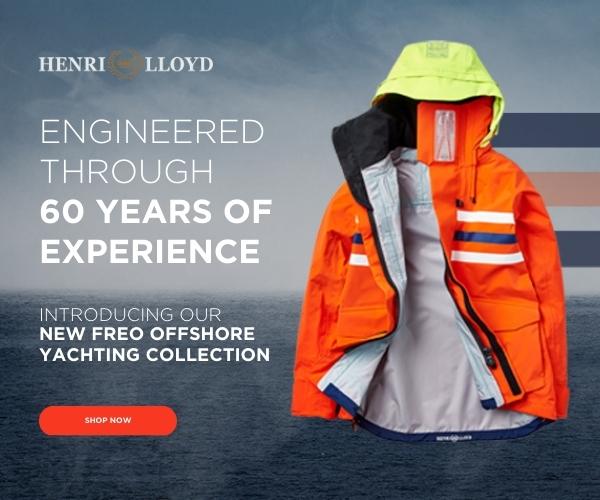
2024 Puerto Vallarta Race at San Diego Yacht Club - Day 1

Related Articles

News from non-English countries
"They fell to the ground with screams": Russian Guards fired at children single near Moscow - there is a casualty
2023-08-20T20:58:57.477Z
Highlights: In Russia, in the city of Elektrostal (Moscow region), during demonstrations, Rosgvardia soldiers began shooting at spectators with children from machine guns with blank cartridges. One child received serious damage from a rebounded cartridge case. In the video, a child can be heard crying and screaming violently. It is also interesting that Russia recently arranged a solemn farewell to Vladimir Shestakov, convicted for the murder of a child, who became a mercenary of PMC "Wagner" and was liquidated in the war in Ukraine.

In Russia, in the city of Elektrostal (Moscow region), during demonstrations, Rosgvardia soldiers began shooting at spectators with children from machine guns with blank cartridges.
So far, one injured child is known.
This was reported by the local Telegram channel of the Cheka-OGPU.
"Small children were clutching their heads screaming and falling to the ground. Not without injuries. The child received serious damage from a rebounded cartridge case," the report said.
One of the witnesses to the incident posted a video. It was her child who was shot by the Russian Guards. In the video, a child can be heard crying and screaming violently.
After the woman realized that her child had been wounded, she called her husband and doctor.
Meanwhile, Russian occupier Ivan Alekseev in the war in Ukraine after a drunken quarrel killed his colleague and tried to cover up the crime, saying it was the work of "Ukrainian saboteurs."
It is also interesting that Russia recently arranged a solemn farewell to Vladimir Shestakov, convicted for the murder of a child, who became a mercenary of PMC "Wagner" and was liquidated in the war in Ukraine.
- The suspect in the murder of a military volunteer was released from custody
- They will teach "patriotism": Russians in the occupied territories launch cadet classes
- Russia has created another training ground near Mariupol: how many soldiers are in the city
Source: tsn
All news articles on 2023-08-20
Lebanese economist: More than $5 billion in economic losses as a result of the Israeli bombing in the south 2024-02-22T19:51:47.940Z
Alexey Navalny died of natural causes, according to a medical report shown to his mother 2024-02-22T19:51:40.552Z
Ukraine deters powerful Russian aviation, but missiles are running out - Western analysts 2024-02-22T19:51:34.062Z
Rumen Petkov: Why is there no commission for Alexei Petrov, is he less murdered? - Politics 2024-02-22T19:41:54.985Z
Indexation of pensions: who is waiting for an increase and what is the maximum amount 2024-02-22T19:41:47.569Z
El presidente de Ecuador explica por qué cambió de idea y no va a triangular armamento con Estados Unidos 2024-02-22T19:41:40.057Z
The US announced sanctions against Russian oligarchs - US 2024-02-22T19:41:33.285Z
The threat is real: Zhorin on the "accession" of Transnistria to the Russian Federation and ways to solve the problem 2024-02-22T19:31:41.099Z
In pictures: Israel destroys Yasser Arafat's house in Gaza 2024-02-22T19:31:33.225Z
Yavor Bozhankov: Through the memorandum, we offer non-politicized figures - Politics 2024-02-22T19:22:34.868Z
Russia poses a threat to Western countries underwater — Bloomberg 2024-02-22T19:22:28.686Z
Resumption of flights from Ukraine: how long will it take and will anyone be able to fly 2024-02-22T19:22:20.429Z
Russia: Israel is deliberately working to expel the Palestinians from Gaza 2024-02-22T19:21:47.736Z
Kuleba is in Warsaw to ensure the smooth passage of military aid to Kiev - EU 2024-02-22T19:21:40.328Z
"Project": Putin repressed more people than Brezhnev over the past 6 years 2024-02-22T19:11:40.960Z
Peter Stano: Medvedev should take care of his psyche - US 2024-02-22T19:11:33.489Z
USA: Houthi missiles hit British ship in Red Sea - Middle East 2024-02-22T19:01:40.890Z
A second summit in Paris to exchange prisoners.. Will it succeed in stopping the Israeli war on Gaza? 2024-02-22T18:51:55.880Z
"The military should feel needed": how well-known activists offer to help the defenders of Ukraine 2024-02-22T18:51:46.860Z
The EP calls for an investigation into the spyware found on the phone of an MEP - EU 2024-02-22T18:51:39.323Z
The Armed Forces of Ukraine were hit by motorized riflemen from Transbaikalia near Volnovakha: at least 60 Russian occupiers were killed - mass media News/Politics 2024-02-21T01:01:05.199Z
Russia faces the biggest drone assault on its own territory since the start of the invasion of Ukraine News/Politics 2023-08-30T19:20:25.125Z
Mayor: Houses in Kharkiv survive Russian missile attack News/Politics 2024-01-08T04:35:43.208Z
Volleys from Grady, DRG hunting and drones: how do the residents of Semenivka live, who see Russia from the windows News/Politics 2024-01-25T17:38:35.096Z
Jiuba MMA. There is a piece | Two women beat each other, kicked their stomachs and screamed, and one person roared: The shirt was rotten Life/Entertain 2023-08-29T12:21:13.624Z
Friendly fire: in Russia, a soldier shot his friend while hunting News/Politics 2023-09-19T18:06:18.501Z
Massive UAV raid on Russia: there were reports of "arrivals" on military facilities News/Politics 2023-11-26T20:07:15.992Z
Ukrainian army: Russia launches large-scale attack on Ukraine News/Politics 2024-01-08T09:35:57.571Z
Change of tactics, dangerous drones and where a "major offensive" of the Russian Federation is expected: what is known about the situation at the front News/Politics 2024-01-08T11:06:34.048Z
AT&T customers report massive service outage. Verizon and T-Mobile also report failures News/Politics 2024-02-22T12:51:36.220Z
E-cigarette explodes in man's pocket - EU News/Politics 2024-02-22T10:32:47.254Z
Jordan airdrops medical aid into Gaza in cooperation with Britain News/Politics 2024-02-22T00:31:35.733Z
4 thousand victims in 2023. Africa hosts half of the global “terrorism” activities News/Politics 2024-02-22T00:41:24.515Z
Explainer: Battle of constitutional recognition and identity crisis! 'Don't want Rajasthani language' trending on Twitter News/Politics 2024-02-22T05:31:39.885Z
The State Department stated that the Russian Federation could not gain an advantage in the war against Ukraine News/Politics 2024-02-21T23:41:18.927Z
300,000 tons of sugar are coming - Bashe News/Politics 2024-02-22T12:32:38.087Z
Canada is going to help finance massive shipments of ammunition to Ukraine - CBC News News/Politics 2024-02-21T21:51:18.263Z
Air alert in the Israeli city of Eilat on the Red Sea - Middle East News/Politics 2024-02-22T05:01:49.555Z
Putin at the inauguration of the Future Games: “Sport should unite people” News/Politics 2024-02-22T04:42:06.063Z
© Communities 2021 - Privacy
- Sport Betting
- Yearly calendar
- Latest results
- English Español French Italiano Nederlands
TheSports.org
All sports Site

Field hockey - Dinamo Elektrostal Moscow

Hockey Club Dinamo Elektrostal is a field hockey team from Russia, based in Moscow. The club was founded in 1994.
Dinamo Elektrostal Moscow - Results
2021/2022 2018/2019 2017/2018 2017 2015/2016 2013/2014 2011/2012 2007/2008
Men's Euro Hockey League - Final Round - 2021/2022
Dinamo elektrostal moscow - identity.
- Official name : Hockey Club Dinamo Elektrostal
- Country : Russia
- Location : Moscow
- Founded : 1994
- Wikipedia link : http://nl.wikipedia.org/wiki/Dinamo_Elektrostal
Dinamo Elektrostal Moscow - Titles, trophies and places of honor
- Best result : First Round in 2021/2022
- Best result : 1st
- 1 times first in 2010
- 1 times second in 2009
- 1 times third in 2017
Postal Address
- © Info Média Conseil : 419 Rue Lemelin, St-François QC G0A3S0, Canada
- Vacation Rentals
- Restaurants
- Things to do
- Moscow Tourism
- Moscow Hotels
- Moscow Bed and Breakfast
- Moscow Vacation Rentals
- Flights to Moscow
- Moscow Restaurants
- Moscow Attractions
- Moscow Travel Forum
- Moscow Photos
- All Moscow Hotels
- Moscow Hotel Deals
- Moscow Motels
- Moscow Campsites
- Moscow Hostels
- Business Hotels Moscow
- Moscow Family Hotels
- Spa Resorts Moscow
- Moscow Luxury Hotels
- Romantic Hotels Moscow
- Moscow Green Hotels
- Moscow Ski-In / Ski-Out Hotels
- Moscow Resorts
- 5-stars Hotels in Moscow
- 4-stars Hotels in Moscow
- 3-stars Hotels in Moscow
- Radisson Blu Hotels in Moscow
- Hampton by Hilton Hotels in Moscow
- AZIMUT Hotels in Moscow
- Marriott Hotels in Moscow
- Novotel Hotels in Moscow
- Holiday Inns in Moscow
- ibis Hotels in Moscow
- Crowne Plaza Hotels in Moscow
- Rotana Hotels in Moscow
- Accor Hotels in Moscow
- InterContinental (IHG) Hotels in Moscow
- Radisson Hotels in Moscow
- Moscow Hotels with a Pool
- Pet Friendly Hotels in Moscow
- Moscow Hotels with Parking
- 3rd Transport Ring (TTK) Hotels
- District Central (TsAO) Hotels
- Garden Ring Hotels
- Tverskoy Hotels
- Boulevard Ring Hotels
- Zamoskvorechye Hotels
- Arbat Hotels
- Meshchanskiy Hotels
- District Eastern (VAO) Hotels
- Red Square & Kitay-gorod Hotels
- Moscow Affordable Hotels
- Boutique Hotels Moscow
- Moscow Heritage Hotels
- Downtown Moscow Hotels
- Hotels with Hot Tubs in Moscow
- Moscow Horseback Riding Hotels
- Moscow Hiking Hotels
- Moscow Hotels with Game Room
- Moscow Hotels with Lounge
- Moscow Hotels with Bridal Suite
- Hotels near Red Square
- Hotels near Moscow Metro
- Hotels near Saint Basil's Cathedral
- Hotels near Moscow Kremlin
- Hotels near High-Speed Train Sapsan
- Hotels near GUM
- Hotels near State Tretyakov Gallery
- Hotels near Tsaritsyno Museum-Reserve
- Hotels near Armoury Chamber
- Hotels near Bolshoi Theatre
- Hotels near (ZIA) Zhukovsky International Airport
- Hotels near (VKO) Vnukovo Airport
- Hotels near (DME) Domodedovo Airport
- Grand Bavaro Princess
- Grand Sirenis Riviera Maya Resort
- Hotel Playa Vista Azul
- Iberostar Selection Varadero
- Bahia Principe Luxury Akumal
- Barcelo Maya Palace
- Sanctuary At Grand Memories Varadero
- Grand Memories Varadero
- Paradisus Princesa Del Mar Resort & Spa
- Melia Internacional Varadero
- Serenade Punta Cana Beach & Spa Resort
- Grand Muthu Cayo Guillermo Hotel
- Royalton Cayo Santa Maria
- BlueBay Grand Esmeralda
- Barcelo Bavaro Palace All Inclusive Resort
- Popular All-Inclusive Resorts
- Popular Beach Resorts
- Popular Family Resorts
- Popular All-Inclusive Hotels
- Popular Hotels With Waterparks
- Popular Honeymoon Resorts
- Popular Luxury Resorts
- Popular All-Inclusive Family Resorts
- Popular Golf Resorts
- Popular Spa Resorts
- Popular Cheap Resorts
- All Moscow Restaurants
- American Restaurants with Buffet in Moscow
- Cafés in Moscow
- Eastern European Restaurants with Outdoor Seating in Moscow
- Fast Food Restaurants in Moscow
- Italian Restaurants in Moscow
- Japanese Restaurants in Moscow
- Mediterranean Restaurants in Moscow
- Pizza in Moscow
- Russian Restaurants in Moscow
- Seafood Restaurants in Moscow
- Sushi Restaurants with Private Dining in Moscow
- Vegan Restaurants in Moscow
- Vegetarian Restaurants in Moscow
- Best Hummus in Moscow
- Best Green Curry in Moscow
- Best Sandwiches in Moscow
- Best Tempura in Moscow
- Best Pad Thai in Moscow
- Best Hot Dogs in Moscow
- Best Burritos in Moscow
- Best Salad in Moscow
- Best Lobster in Moscow
- Best Pancakes in Moscow
- Best Noodle in Moscow
- Best Salmon in Moscow
- Best Tortellini in Moscow
- Best Focaccia in Moscow
- Best Juice & Smoothies in Moscow
- Breakfast Restaurants in Moscow
- Lunch Restaurants in Moscow
- Dinner Restaurants in Moscow
- Bakeries in Moscow
- Buffet Restaurants in Moscow
- Coffee & Tea in Moscow
- Desserts in Moscow
- Food Delivery Restaurants in Moscow
- Kid Friendly Restaurants in Moscow
- Late Night Restaurants in Moscow
- Restaurants for Special Occasions in Moscow
- Restaurants with Outdoor Seating in Moscow
- Romantic Restaurants in Moscow
- Arbat Restaurants
- Basmanny Restaurants
- Buffet Restaurants in Khamovniki
- Desserts in Presnensky
- Hamburgers in Presnensky
- International Restaurants in Basmanny
- Khamovniki Restaurants
- Late Night Mediterranean Restaurants in Tverskaya
- Maryina Roshcha (Jewish Quarter) Restaurants
- Patriarch Ponds Restaurants
- Presnensky Restaurants
- Red Square & Kitay-gorod Restaurants
- Tverskaya Restaurants
- Yakimanka Restaurants
- Zamoskvorechye Restaurants
- GreenLeaders
- Things to Do
- Travel Stories
- Rental Cars
- Add a Place
- Travel Forum
- Travellers' Choice
- Help Centre
- Europe
- Russia
- Central Russia
- Moscow
- Moscow Restaurants
Club Risovalshchikov
Ratings and reviews, food and ambience, location and contact.

CLUB RISOVALSHCHIKOV, Moscow - Butovo South - Restaurant Reviews, Photos & Phone Number - Tripadvisor
- Service: 4.5
Every item on this page was chosen by an ELLE editor. We may earn commission on some of the items you choose to buy.
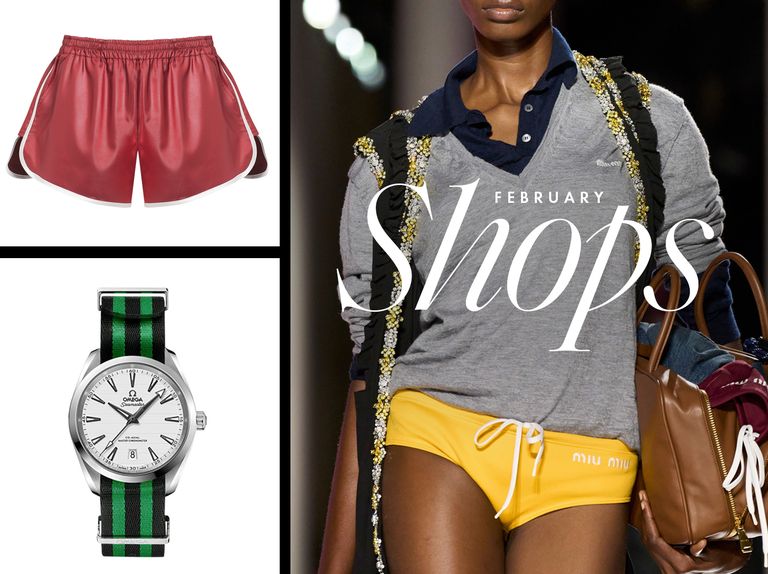
Yacht Rock: ELLE’s February 2024 Shopping Guide
From the rowing club to the runway, preppy classics are making a splash.
It’s time to recruit your own team of sporty staples. Go all in on the throwback aesthetic by pairing collegiate standbys with rope bracelets and loafers.
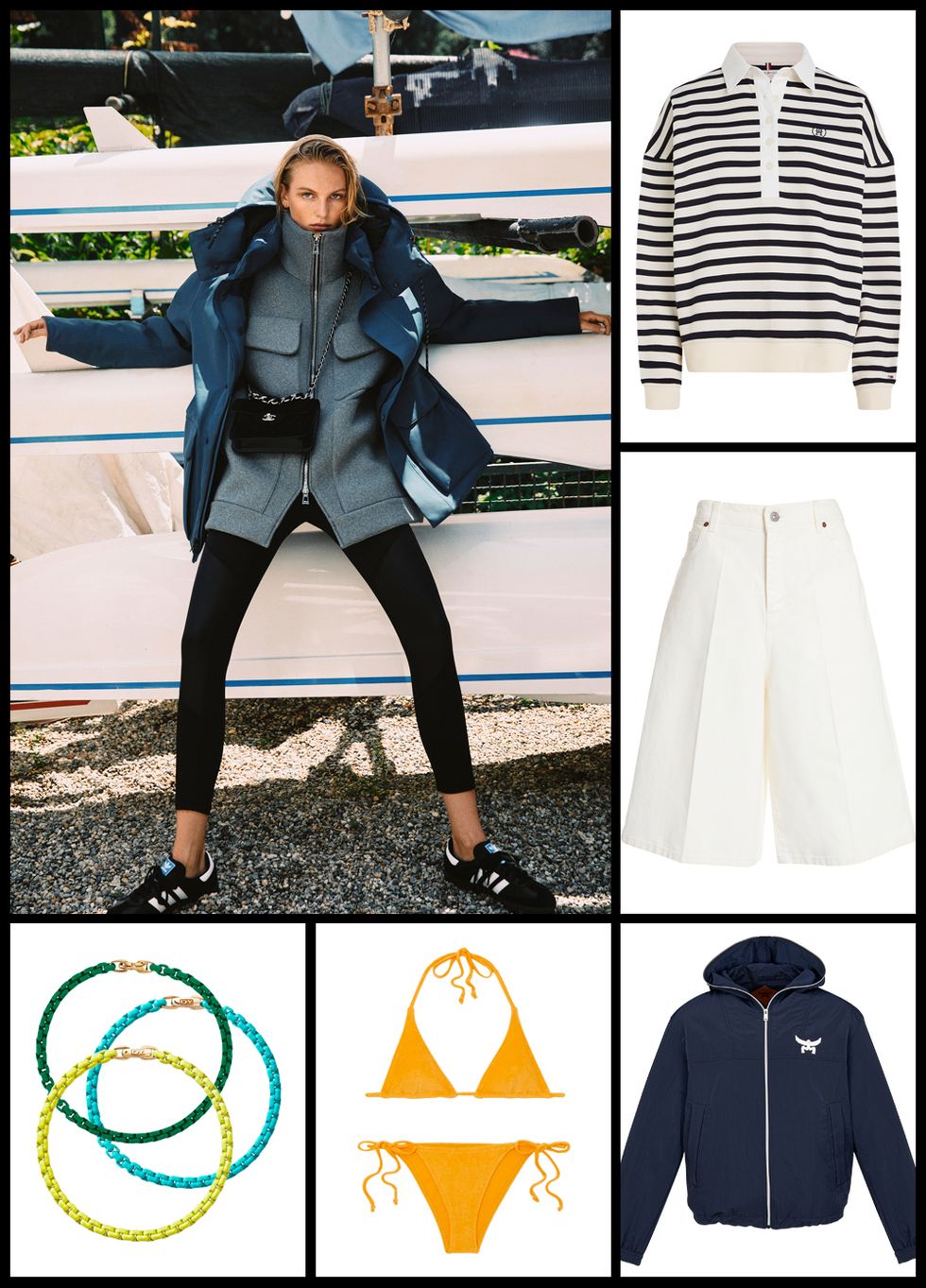
Dries Van Noten Retro Runner Sneakers
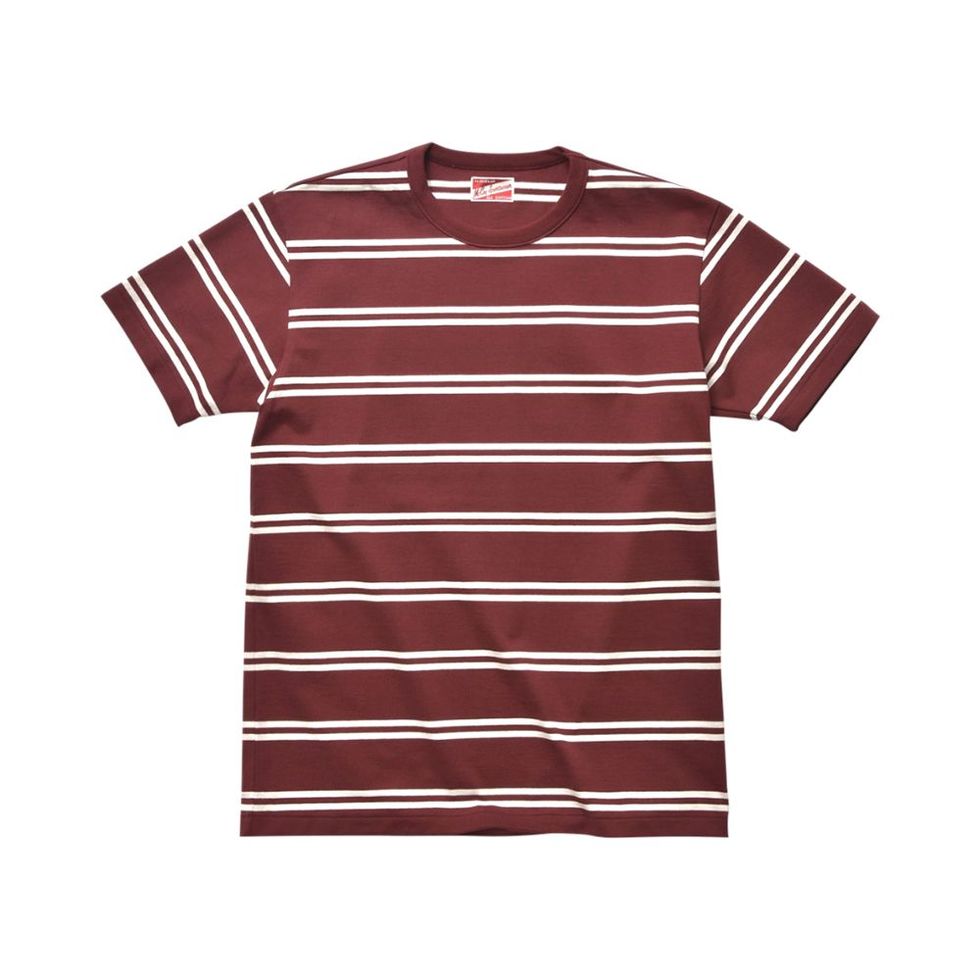
Joe McCoy Double Stripe Tee
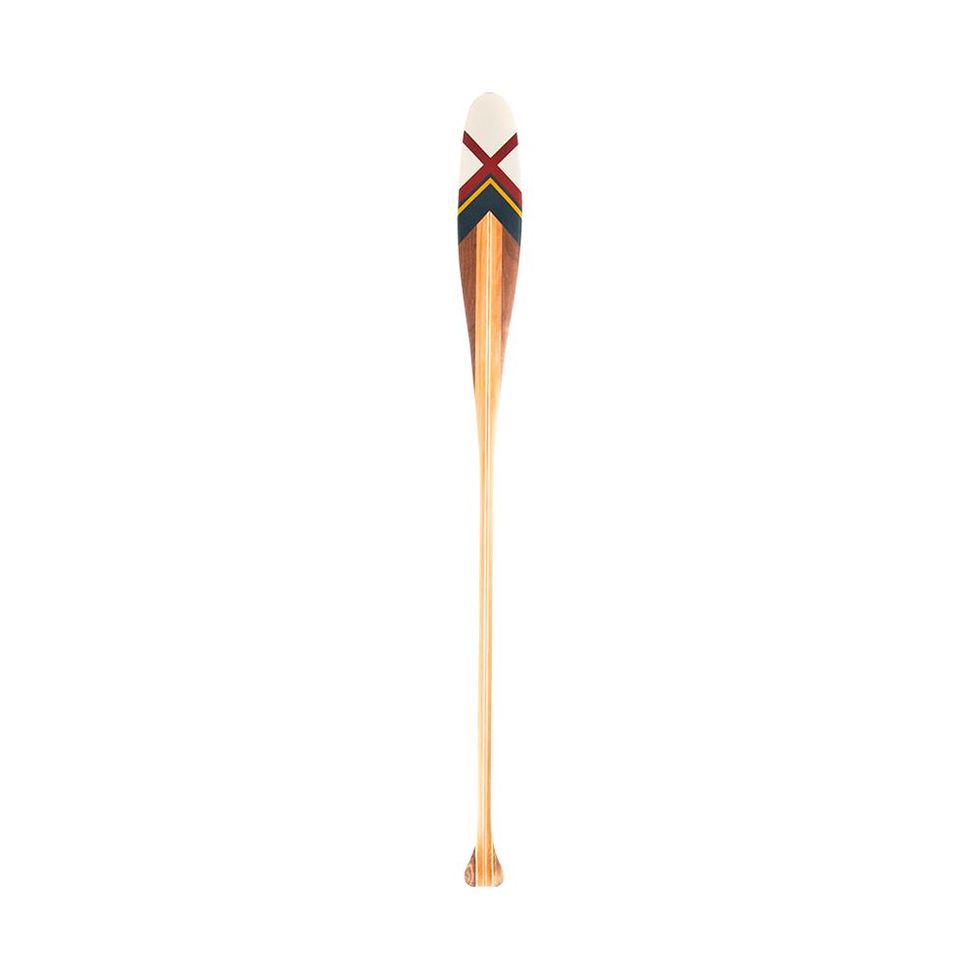
Sanborn Canoe Maquoketa Canoe Paddle
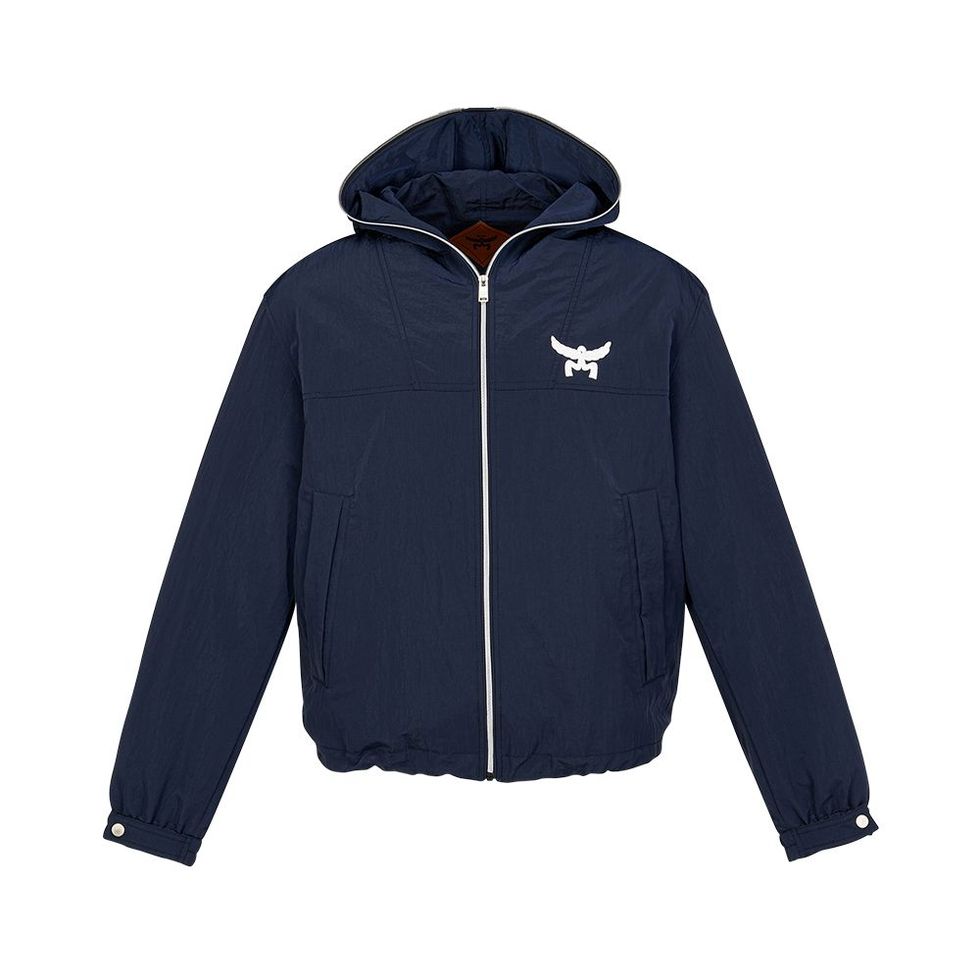
MCM Laurel Logo Windbreaker
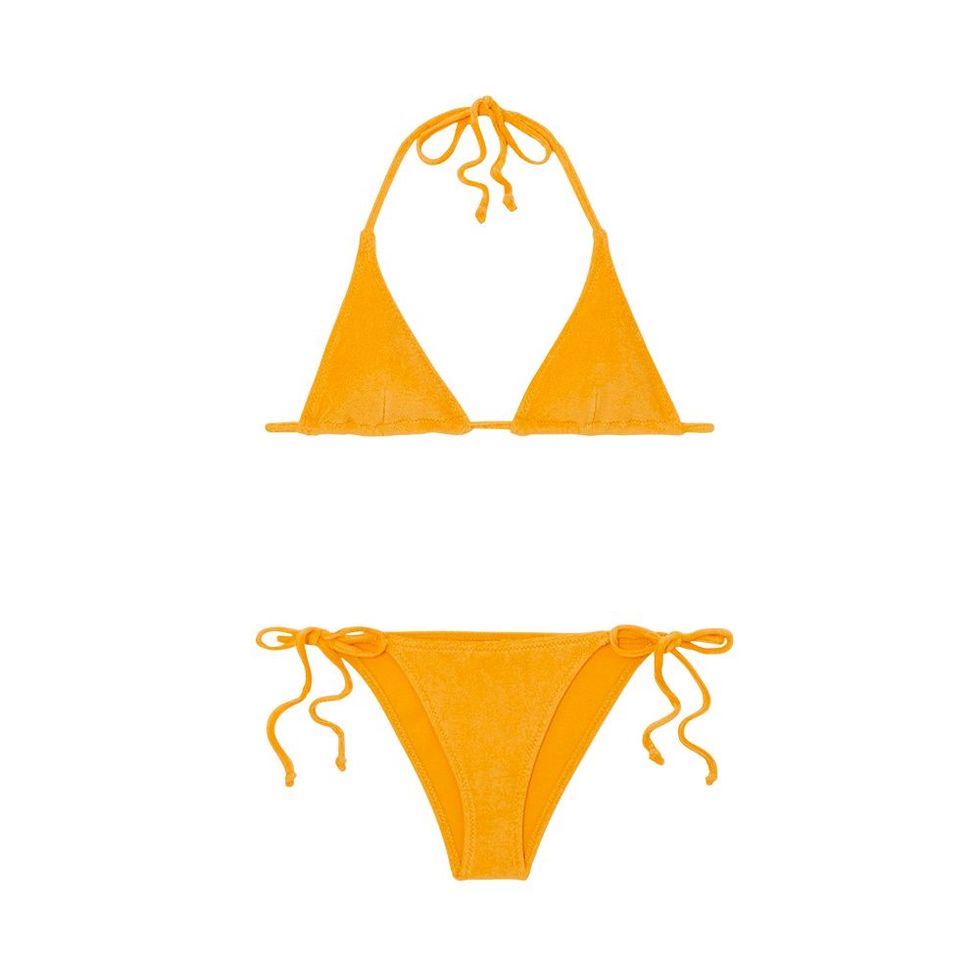
Lisa Marie Fernandez Pamela Terry Bikini
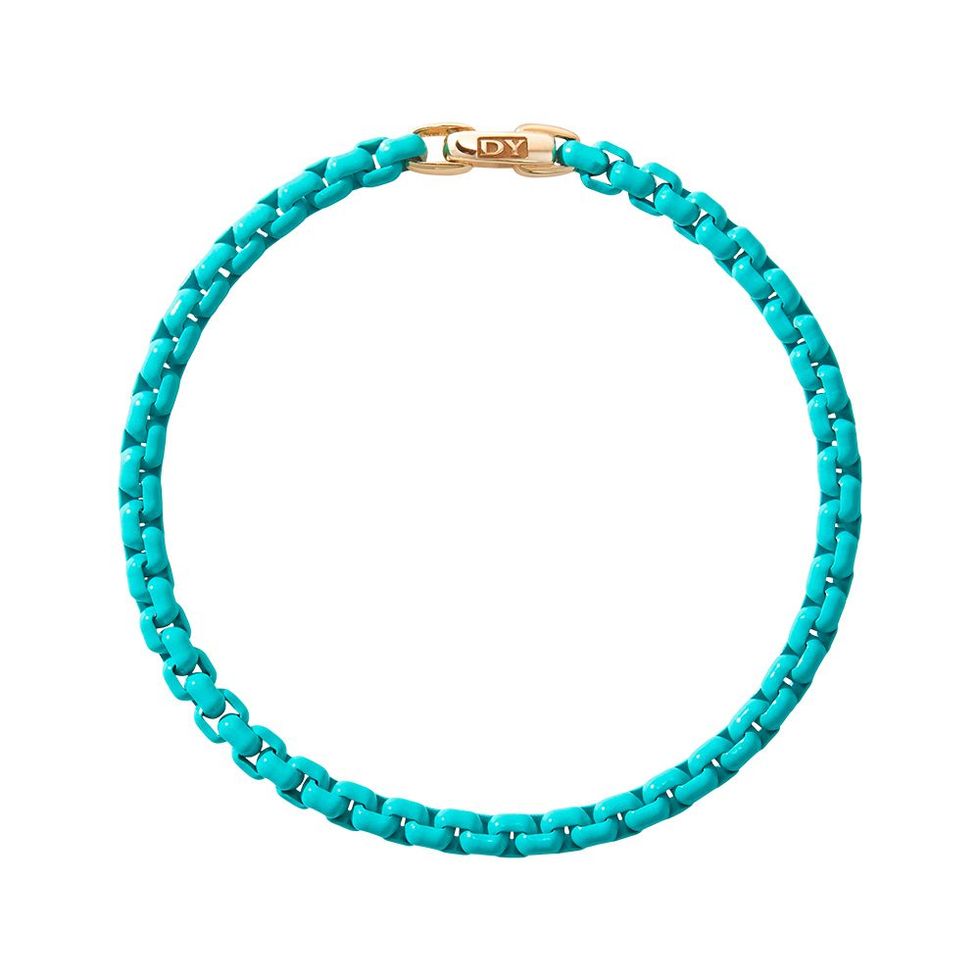
David Yurman DY Bel Aire Color Box Chain Bracelet

Port Tanger Gambia Sunglasses
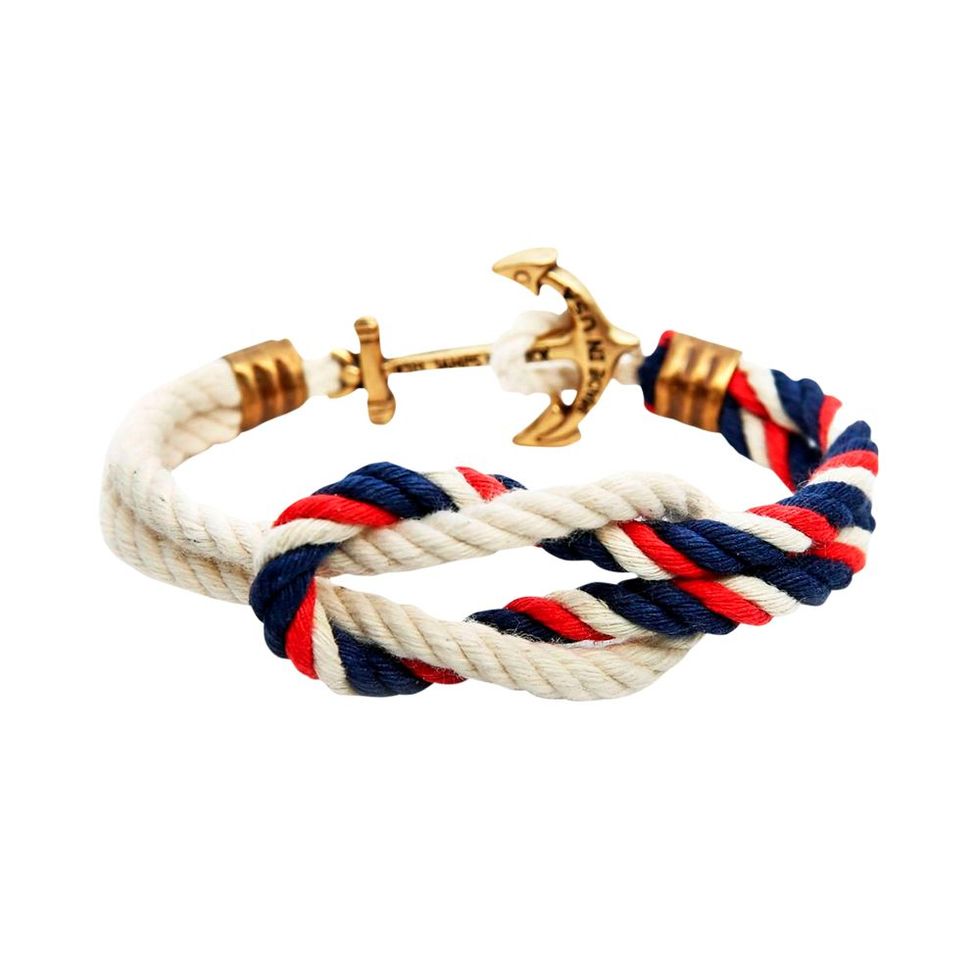
Kiel James Patrick American Classic

Marant Étoile Alec Open-Knit Sweater
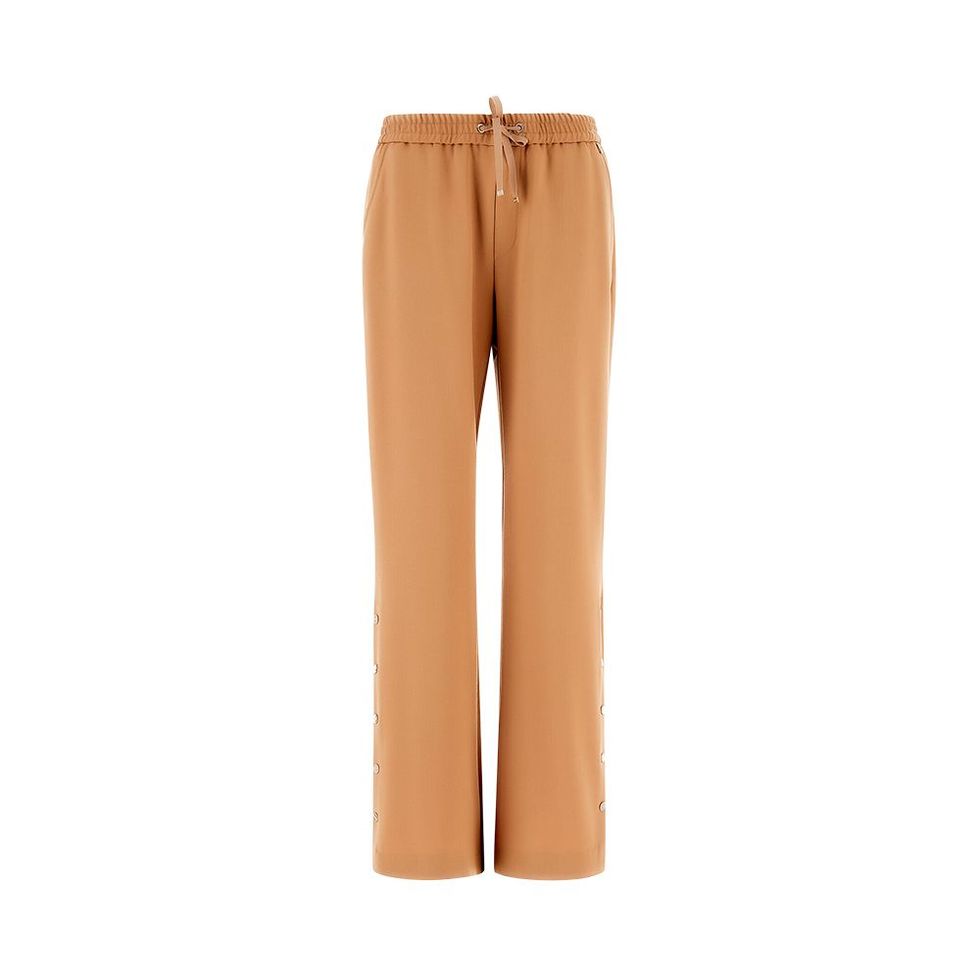
Herno Stretch Trousers
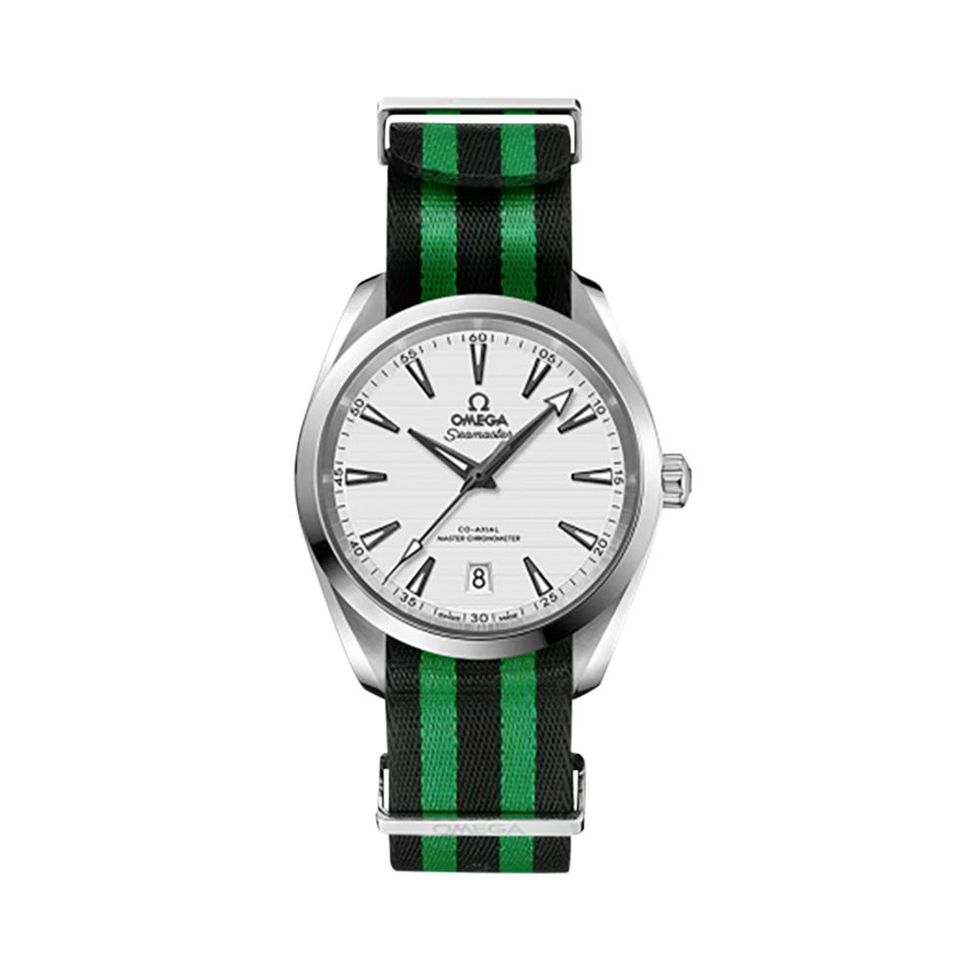
Omega Seamaster Aqua Terra 150m
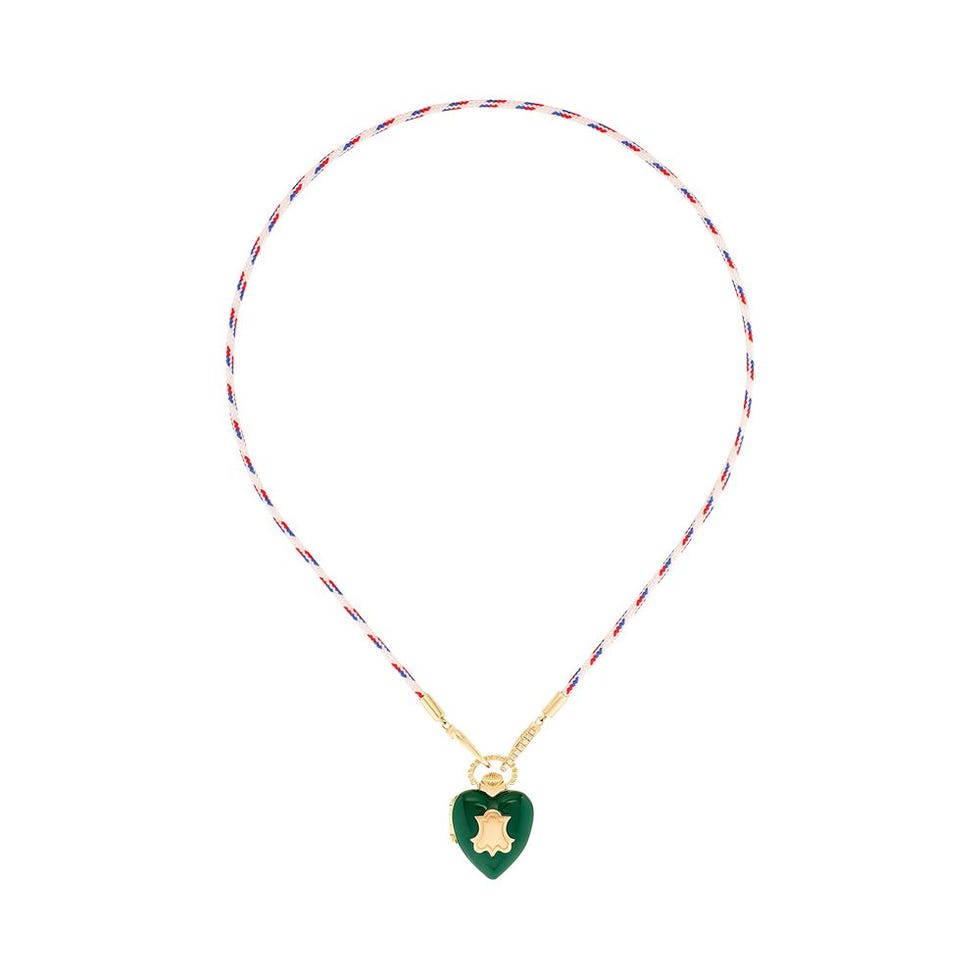
Ben The You Vault Pendant Necklace
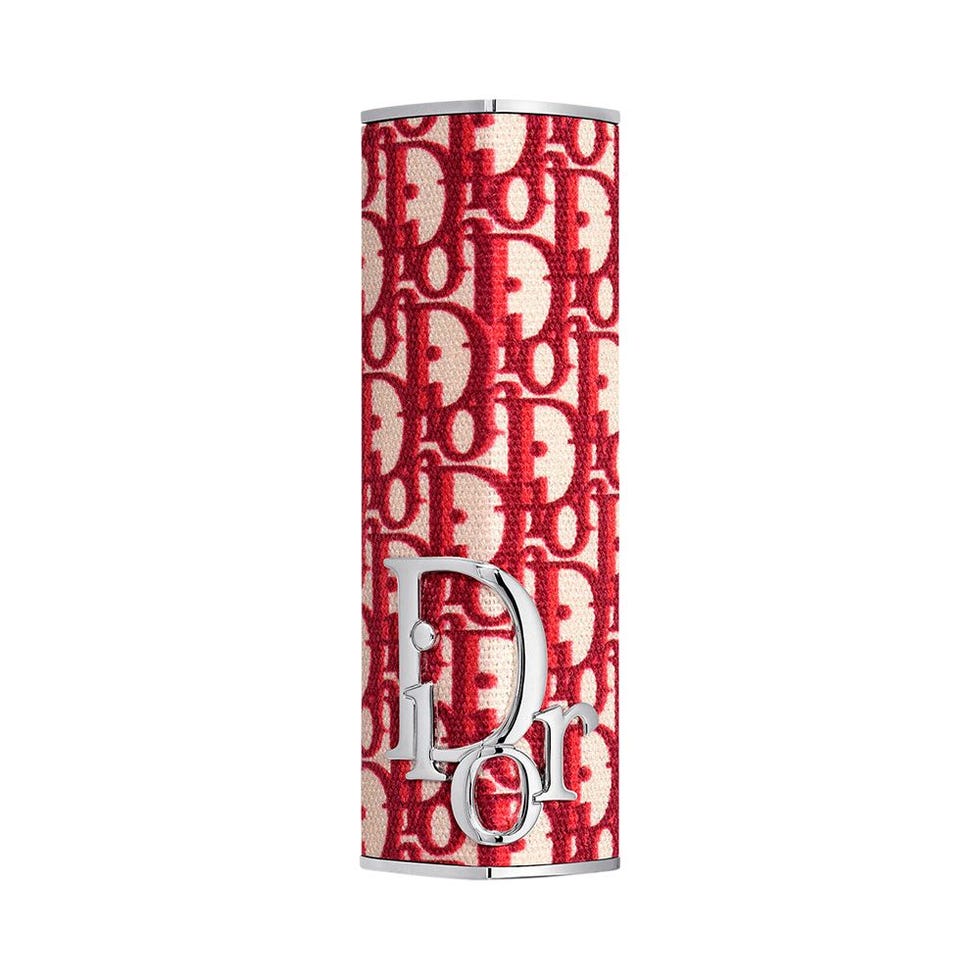
Dior Dior Addict Case
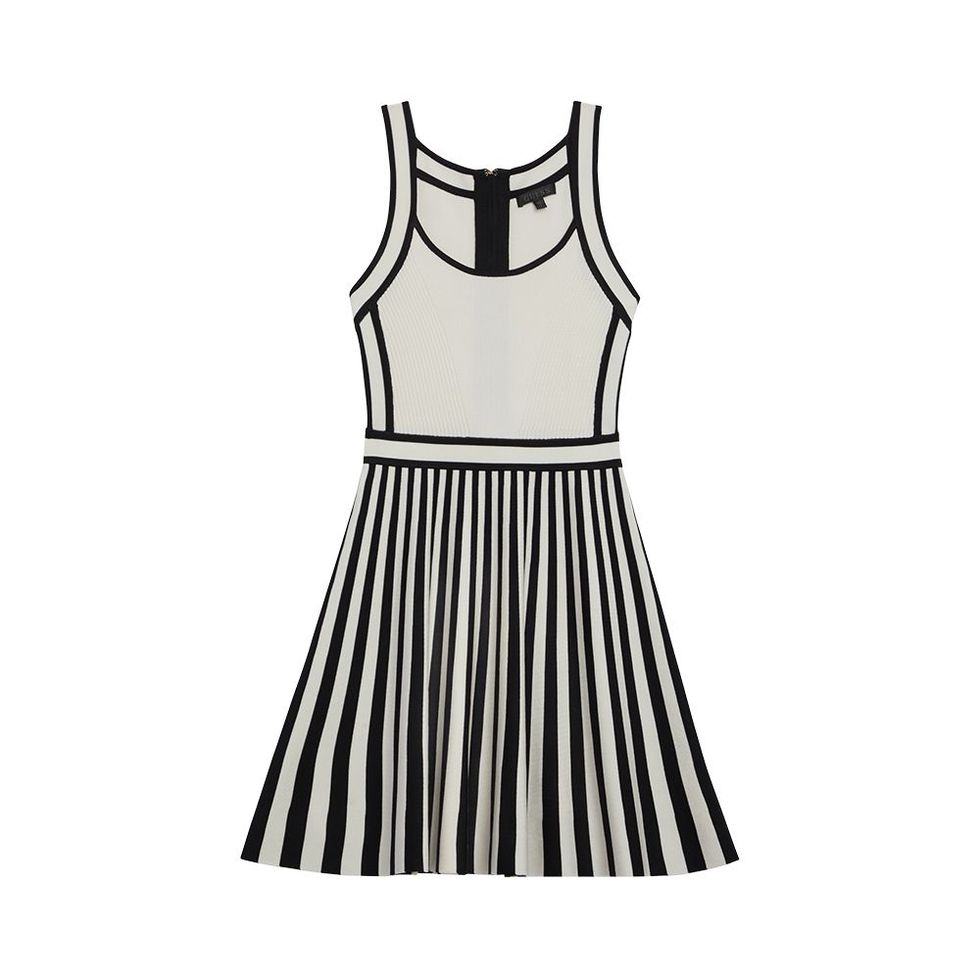
Guess Mirage Nautical Sweater Dress
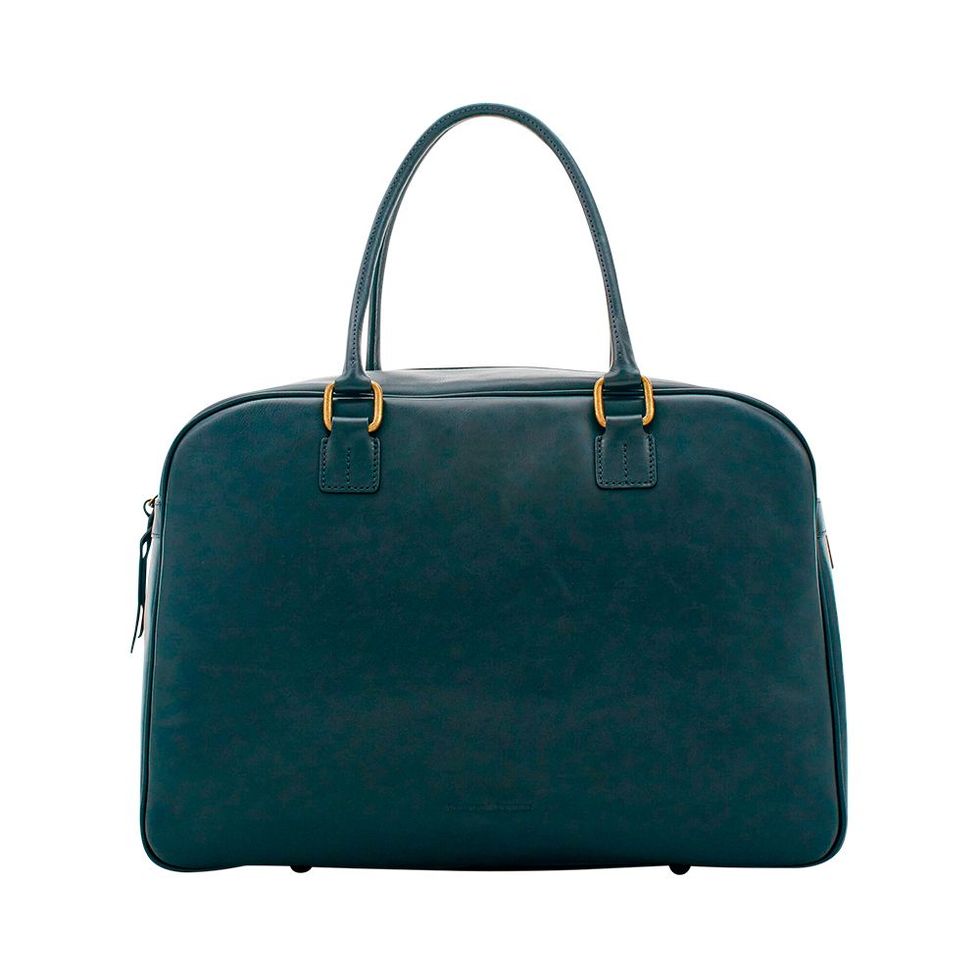
Dooney & Bourke Florentine Bowler Duffle
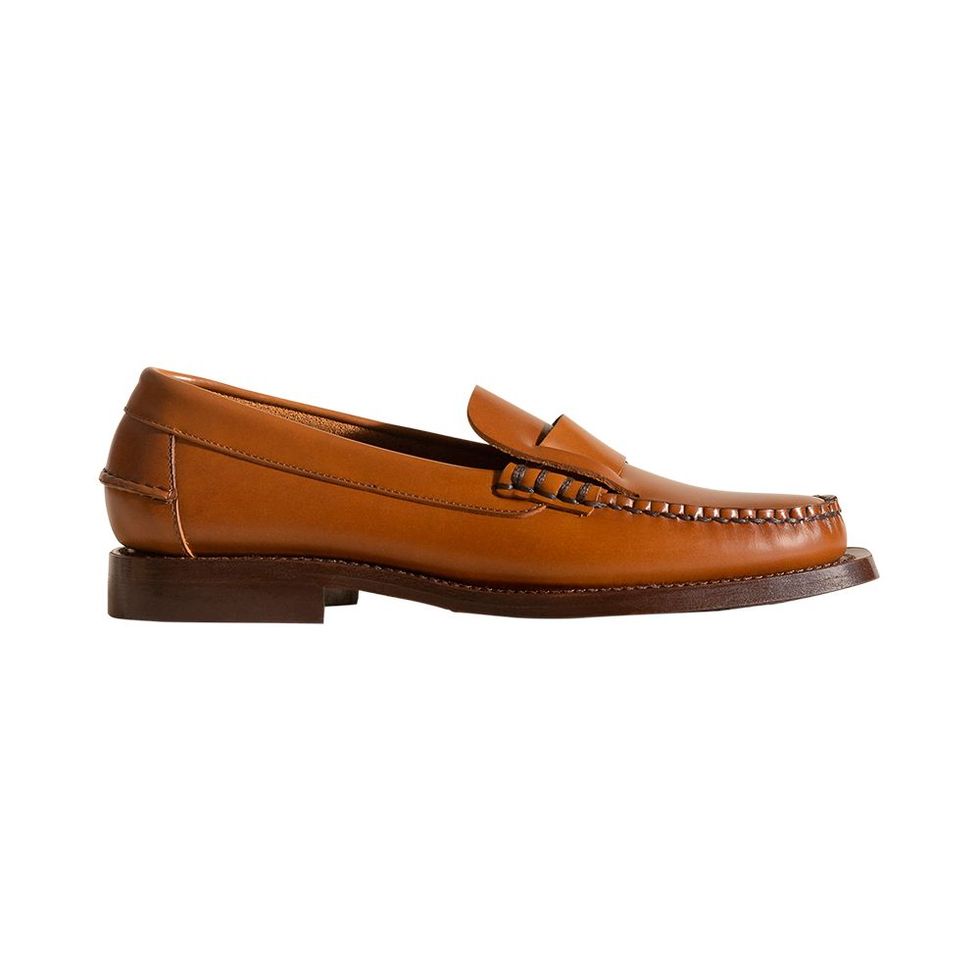
Hereu Sineu Slip-on Loafers
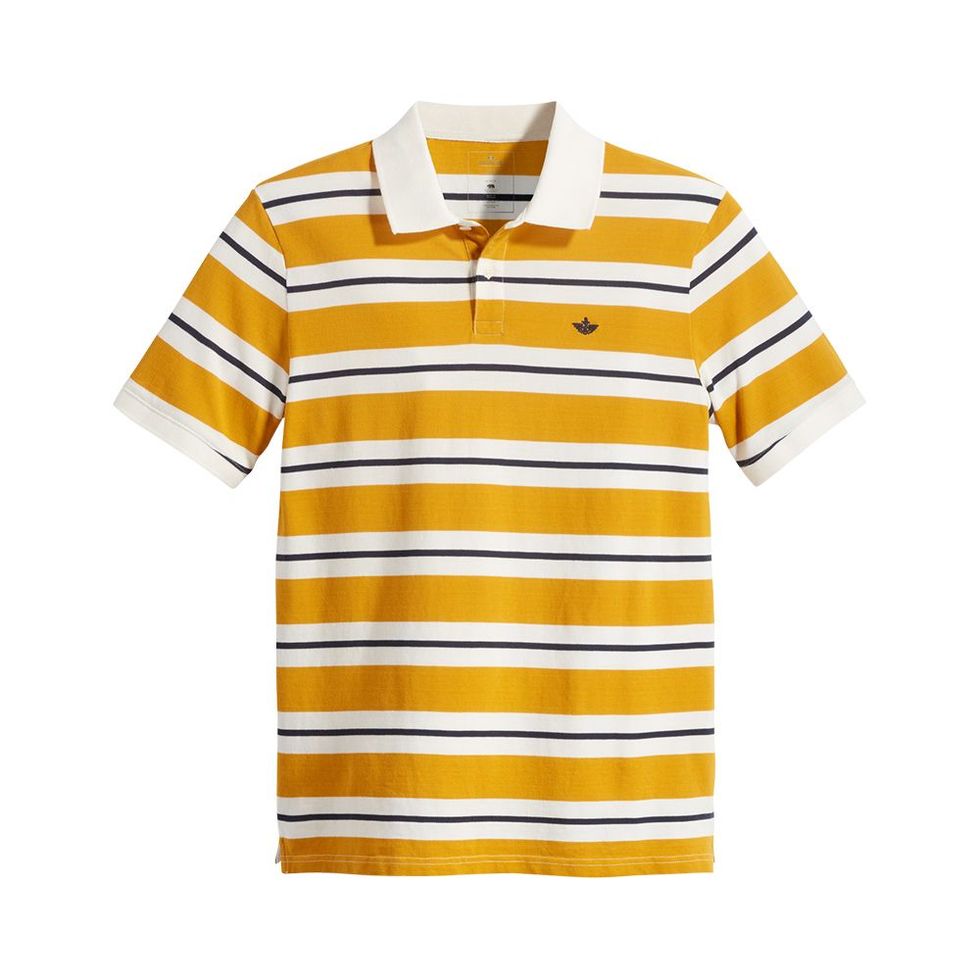
Dockers Rib Collar Polo
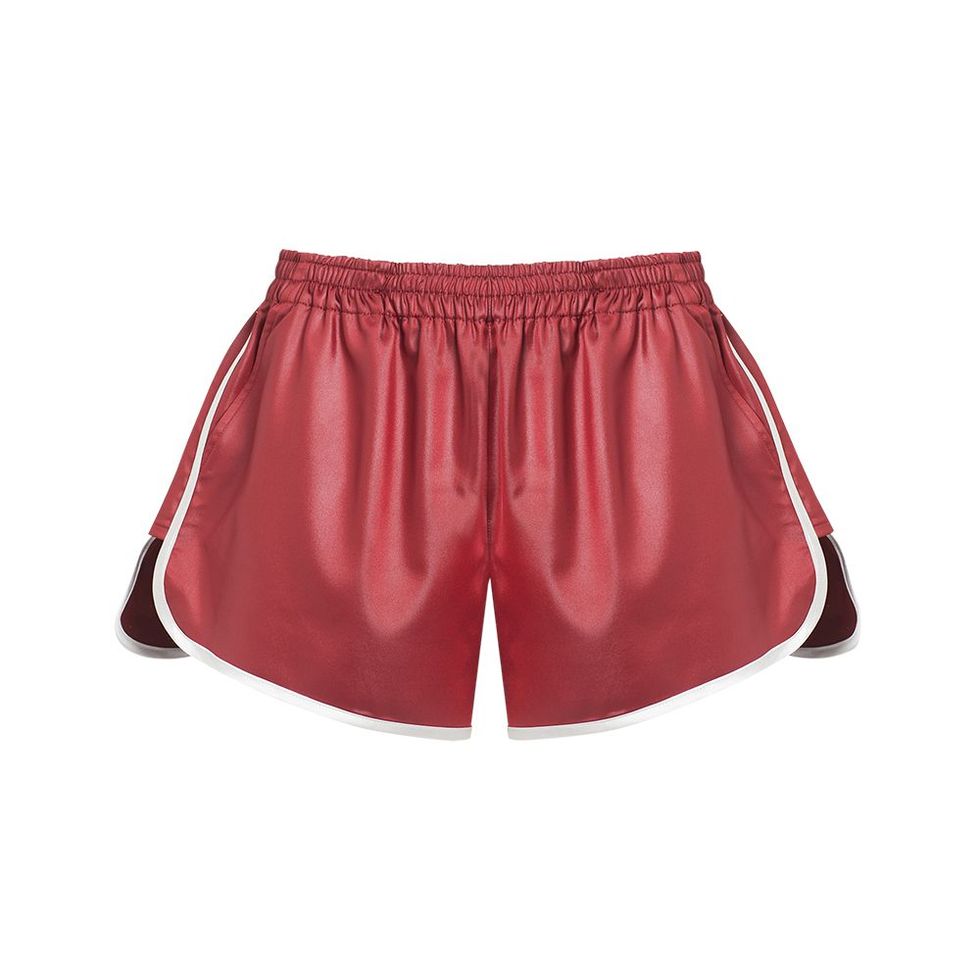
Mango Satin Shorts

The Best-Dressed Celebrities at the 2024 SAGs

17 Area Rugs

A First Look at Jhoan Sebastian Grey for HSN

The Best Street Style From Milan Fashion Week

The Launch: Fashion News to Know This February

Shop the 16 Best Hobo Bags for Effortless Style

Willy Chavarria Reacts to His First ELLE Cover

This Spring, Fashion Gets Bold and Bright

Spring Is for the Shape Shifters

Spring’s Must-Have Striped Accessories

Vittoria Ceretti Is the Ultimate Supermodel
- Tomilino Tourism
- Tomilino Hotels
- Tomilino Bed and Breakfast
- Tomilino Vacation Rentals
- Flights to Tomilino
- Tomilino Restaurants
- Things to Do in Tomilino
- Tomilino Travel Forum
- Tomilino Photos
- Tomilino Map
- All Tomilino Hotels
- Tomilino Hotel Deals
- Hotels near Museum of Moscow Helicopter Plant of Mil
- Hotels near Museum Zvezda
- Hotel Xcaret Mexico
- The LINQ Hotel + Experience
- Flamingo Las Vegas
- Mandalay Bay Resort & Casino
- Hyatt Ziva Cancun
- Dreams Macao Beach Punta Cana
- Hotel Riu Montego Bay
- Moon Palace Cancun
- Excellence Oyster Bay
- Secrets Cap Cana Resort & Spa
- Beaches Turks & Caicos
- Secrets Moxche Playa del Carmen
- Hotel Riu Republica
- Secrets Maroma Beach Riviera Cancun
- Hotel Riu Palace Kukulkan
- All Tomilino Restaurants
- Arabic Restaurants in Tomilino
- Chinese Restaurants in Tomilino
- Japanese Restaurants in Tomilino
- Korean Restaurants in Tomilino
- Middle Eastern Restaurants in Tomilino
- Russian Restaurants in Tomilino
- Travelers' Choice
- Help Center
- Moscow Oblast
- Tomilino
- Tomilino Restaurants
Ratings and reviews
Location and contact, california, tomilino - restaurant reviews - tripadvisor.

California Yacht Club was established in 1922 and boated its' first competitive rowing team back in the 1930's. In 1977, after a long hiatus, Stan Mullin, Ken Jacobs and Charles Hathaway reactivated rowing at the Club. CYC rowers now number about 60, and represent all abilities, ages and motivations.
Adult Rowing - California Yacht Club CYC is a great place for adults of all ages and skills to row out of Marina Del Rey. We have more than 60 active adult rowers with a wide range of interests and motivations varying from recreational, fitness, social, open water, and racing.
CYC Rowing - California Yacht Club - Rowing About us CYC Junior Rowing CYC offers a range of rowing programs suitable for girls and boys ages 12 - 18. CYC membership is not required to participate. Our junior rowing programs include: a highly successful competitive rowing team, a recreational program and private lessons.
Everyone at the California Yacht Club is devastated by the fire that took place at the structure of our historic club on Monday, December 11, 2023. We want to extend our sincere thanks to the Los Angeles County Fire Department for their rapid response and intensive efforts to extinguish the fire. We are committed to working with the fire ...
Junior Sailing and Rowing Program. Open to all youths in the community (ages 8-18). Full time Junior staff. Comments: Active power, sail and rowing fleets. Family friendly Club with a full schedule of races, cruises, and social activities.
California Yacht Club's Junior Rowing Program runs seasonally from September through June, and extends into Summer with several two week "Learn to Row" camps. The core instruction of the program is sculling. Singles, doubles and quads are the on the water tools for quality learning, and our inventory of ergometers are used for land training.
California Yacht Club, Marina del Rey, California. 4,778 likes · 133 talking about this · 24,313 were here. The California Yacht Club mission is to...
California Yacht Club was established in 1922 and boated its first competitive rowing team back in the 1930's. In 1977, after a long hiatus, Stan Mullin, Ken Jacobs and Charles Hathaway reactivated rowing at the Club and it has grown since then.
The California Yacht Club has a wonderful community of members who enjoy a packed social calendar of over 400 events throughout the year that features water activities, wine tastings, movies...
California Yacht Club is located at: 4469 Admiralty Way, Marina del Rey, CA 90292. ... California Yacht Club-Junior Rowing. Craig Leeds [email protected] 310.948.1456. and. Anna Wilczek [email protected] 818.523.2987. CYC offers a variety of summer programs for junior age (13 - 18) boys and girls. CYC membership is not required to enroll.
J/70 Worlds 2021 : Peter Duncan's Relative Obscurity has prevailed over 60 other teams and challenging wind conditions to capture the 2021 J/70 World Championship title at California Yacht Club, today. In a five-day series that tested the skill and patience of top-notch competitors from 11 nations, Duncan - sailing with Willem van Waay, Morgan Trubovich and Victor Diaz de Leon - secured ...
Congratulations to the California Yacht Club Rowing Team on an impressive showing at the Long Beach Christmas regatta! 27 medals is an incredible achievement, and we are so proud of all of your hard...
The California Yacht Club is owned by the Hathaway family, owners of the Los Angeles Athletic Club. The annual "Great Catalina to Marina del Rey Rowing and Paddling Event" pays tribute to Charles Hathaway's row in 1976 from Catalina Island to the club on his 50th birthday.
3,429 Followers, 1,052 Following, 637 Posts - See Instagram photos and videos from California Yacht Club (@calyachtclub) 3,429 Followers, 1,052 Following, 637 Posts - See Instagram photos and videos from California Yacht Club (@calyachtclub) Something went wrong. There's an issue and the page could not be loaded. ...
515 Followers, 265 Following, 67 Posts - See Instagram photos and videos from California Yacht Club Rowing (@calyachtclubrowing)
• 1st US Rowing Coach to win back-to-back Gold medals in the Mens Eight (97,98,99) (04,05). ... RC and California Rowing Club • Advisory coach at Cambridge University in England for their annual Boat Race since 1993 • U.S. Men's Olympic Head Coach from 2009-2012 London Olympic Games (Bronze - M4-)
When the California Yacht Club burned in Marina del Rey, prestigious awards, a priceless trophy and cherished photos were lost. Members mourn the club's loss.
The Los Angeles Rowing Club is the oldest rowing club in the city, founded in 1908. The club is located in a historic boathouse in the Marina del Rey harbor and offers programs for rowers of all levels, from beginners to advanced. The club has a competitive racing team, a recreational rowing program, and hosts many social events throughout the ...
Related Articles J/Teams Silver in Southern California Islands Race J/130 1st, J/111 2nd, & J/125 2nd The annual Southern California offshore and coastal racing season kicked off with the 2024 Islands Race, a coastal race co-hosted by Newport Harbor Yacht Club and San Diego Yacht Club since 2010. Posted on 19 Feb BadPak wins 2024 Islands Race Rio100 sets course record The annual Southern ...
The moment of the explosion in Moscow was broadcast on the rowing championship: video. News/Politics 2023-08-11T12:06:55.387Z. 8-Year-Old Boy Killed in Russian Strike on Western Ukraine. News/Politics 2023-08-11T14:26:57.994Z. They were going to reconnaissance the territory: border guards "landed" the occupiers' UAVs near Avdiivka.
Dinamo Elektrostal Moscow - Titles, trophies and places of honor. Men's Euro Hockey League since 2007/2008 (7 participations) . Best result : First Round in 2021/2022; EuroHockey Men's Club Trophy since 2008 . Best result : 1st
Club Risovalshchikov, Moscow: See 7 unbiased reviews of Club Risovalshchikov, rated 4.5 of 5 on Tripadvisor and ranked #4,585 of 15,890 restaurants in Moscow.
Yacht Rock: ELLE's February 2024 Shopping Guide From the rowing club to the runway, preppy classics are making a splash. By Rosie Jarman Published: Feb 21, 2024
California, Tomilino: See unbiased reviews of California, one of 16 Tomilino restaurants listed on Tripadvisor.

IMAGES
VIDEO
COMMENTS
The inflatable race mark buoys are used for nautical events, yachts, stand up paddle board, dragon boat races, triathlons, swimming competitions, and more. ETP Race Marks is a custom fabricator and offers an array of shapes, sizes, colors, and even custom printing. All ETP Race Mark's inflatable buoys are constructed using a heavy duty 18 oz ...
YRA Description of Marks. Below are the descriptions of marks used in YRA races. Also included are the GPS coordinates for the permanent marks. These GPS coordinates are provided as a reference; the YRA makes no guarantee as to the accuracy of these GPS coordinates. We encourage you to sail by each mark and enter in your GPS to ensure accuracy.
Racing marks are turning points where all the boats in your fleet try to squeeze into one small spot. For this reason, mark roundings often produce large traffic jams, and the potential for gain or loss is great. With a bit of tactical knowledge, you can sail smarter than the others and, hopefully, turn most potential losses into gains.
kinds of racing, and rules that affect only a small number of competitors or officials. Terminology A term used in the sense stated in the Definitions is printed in italics or, in preambles, in bold italics (for example, racing and racing). Each of the terms in the table below is used in The Racing Rules of Sailing with the meaning given.
Rule 18.2 - Giving Mark Room. " (a) When boats are overlapped the outside boat shall give the inside boat mark-room, unless rule 18.2 (b) applies. (b) If boats are overlapped when the first of them reaches the zone, the outside boat at that moment shall thereafter give the inside boat mark-room. If a boat is clear ahead when she reaches the ...
Sailboat Racing Tips: Rules at the Mark. Mike Ingham explains the subtle nuances of the Racing Rules of Sailing and how they apply at rounding marks. By Dave Reed. April 26, 2022. Racing editor ...
Scoring systems are applied to determine winners based on elapsed time, corrected time, or handicap ratings. 10. Anti-doping regulations are enforced to maintain the integrity of yacht racing as a clean sport. These rules and regulations provide a framework that allows for fair competition and keeps participants safe.
ROUND IRELAND YACHT RACE EQUIPMENT; Select Currency: EUR. EURO; British Pound US Dollar Japanese Yen ... Robust construction and ideal for swimmers channels, demarcation and racing marks Features Rigid UV-treated plastic Ring reinforced with brass eyelet. Yellow None... P43404 €284.95. Add to Cart. Add to Cart. Plastimo Regatta Training Buoy ...
RACE MARKS. Below is a map of all the marks that Sloop Tavern Yacht Club uses in races. Some are temporary inflatable marks, like S. Most marks are permanent, like the tiny and elusive Spring Beach mark (R) shown at right. Click on a mark in the map for a basic description of it.
An extract from a case study in the application of Mark Room (Rule 18). The Racing Rules of Sailing (often abbreviated to RRS) govern the conduct of yacht racing, windsurfing, kitesurfing, model boat racing, dinghy racing and virtually any other form of racing around a course with more than one vessel while powered by the wind. A new revision is published every four years (after the Olympic ...
If flag Z has been displayed, no part of a boat's hull shall be in the triangle formed by the ends of the starting line and the first mark during the last minute before her starting signal. If a boat breaks this rule and is identified, she shall receive, without a hearing, a 20% Scoring Penalty calculated as stated in rule 44.3(c). She shall be penalized even if the race is restarted or re ...
Imray Harbour Race Marks Chart: Harbour Marks Diagrammatic Chart: Harbour Mark Details: Harbour Race Mark positions (Lat/Long) Harbour Race Mark Bearings: ... Chris Somner Yacht and Dinghy Services. Insurance repairs, Rebuilds, Rigging, Chandlery, Grit Blasting and spares. www.cserve.co.uk 01202 659810 / 07941301742
Chart of SYC Racing Marks NOTE: Only marks A through H, T and J are maintained by SYC. SYC NOYC USCG LAKEFRONT AIRPORT pub. launch pub. launch pub. launch fuel dock fuel dock INNER HARBOR NAV. CANAL (to ICW) 5 THIS CHART SHOULD NOT BE USED FOR NAVIGATION 4 NAUTICAL MILES 3 2 1 0 LAKE PONTCHARTRAIN CAUSEWAY 'SD1' Causeway South Draw #1
The future of race management is here. MarkSetBot offers robotic buoys and integrated course-setting technology for sailboat racing that makes race management simple, accurate and sustainable. Our patented robotic buoys are self-propelled and use GPS technology to hold position without anchors. With a user-friendly mobile app, easy assembly ...
Racing Marker Buoys. This photograph shows a special racing marker buoy for permanent installation based on the MB350 rigid hull, these are rotationally moulded from M.D. polyethylene and pressure filled with P.U. foam. The hull of this buoy is1m in diameter and has a buoyancy rating of 350kg. They can be lettered or numbered during ...
MarkSetBot is a clever robotic race buoy that can be fully controlled by a smartphone or tablet. The self-propelled inflatable race marks use an electric on-board engine and employ GPS technology to zero in on a specific location and stay put until told to move. MarkSetBot has several advantages. It allows for a fast course setup with simple ...
View our large variety of Navigation Buoys >. View our large variety of Mooring Buoys >. View our large variety of Beach Markings >. View our large variety of Racing Marks >.
A close evaluation of the current expense of running races, and how that would compare with robotic marks, is an important step in this process. Three-time Olympian Chris Rast, who represents ...
The Stunning Ritz Carlton EVRIMA Yacht. Gliding Across Tokyo's Sumida River: The Mesmerizing Zipper Boat. CROCUS Yacht: An 48 Meter Beauty by Admiral. PHI Yacht - Royal Huisma
Gunboat 68 (+35Kts) Gunboat 68 is a cruising catamaran designed to reach the highest speeds possible. Made by Gunboat, the ship uses Grand-Prix racing boats' designs to develop the speediest cruising catamaran on the market. Gunboat 68 is made entirely from carbon composites, which keeps the ship lightweight and fast.... Aquila 42 Yacht. 2024.
Impressions; At 91 meters in length, Lady Lara is an ultramodern superyacht with sweeping curves and an elegantly balanced profile. Dynamic, sculpted features carry through her ex
California Yacht Club was established in 1922 and boated its' first competitive rowing team back in the 1930's. In 1977, after a long hiatus, Stan Mullin, Ken Jacobs and Charles Hathaway reactivated rowing at the Club. CYC rowers now number about 60, and represent all abilities, ages and motivations.... Adult Rowing - California Yacht Club CYC is a great place for adults of all ages and skills ...